

Canadian Rockies Road Trip Loop: Detailed 9 to 12 Day Itineraries + Map
Want to explore both sides of the Canadian Rockies (Alberta and British Columbia) and drive a circular road trip route? This Canadian Rockies road trip loop may be the perfect choice for you!

Road trippers can easily ‘join’ the loop from either Calgary or Vancouver, Western Canada’s two biggest cities. Car rentals are usually much cheaper when picking up and dropping off at the same location.
This Canadian Rockies loop route is easy to combine with other BC road trip destinations, such as the Okanagan Valley , Slocan Valley ( hot springs ) and the Columbia Valley (Radium, Invermere).
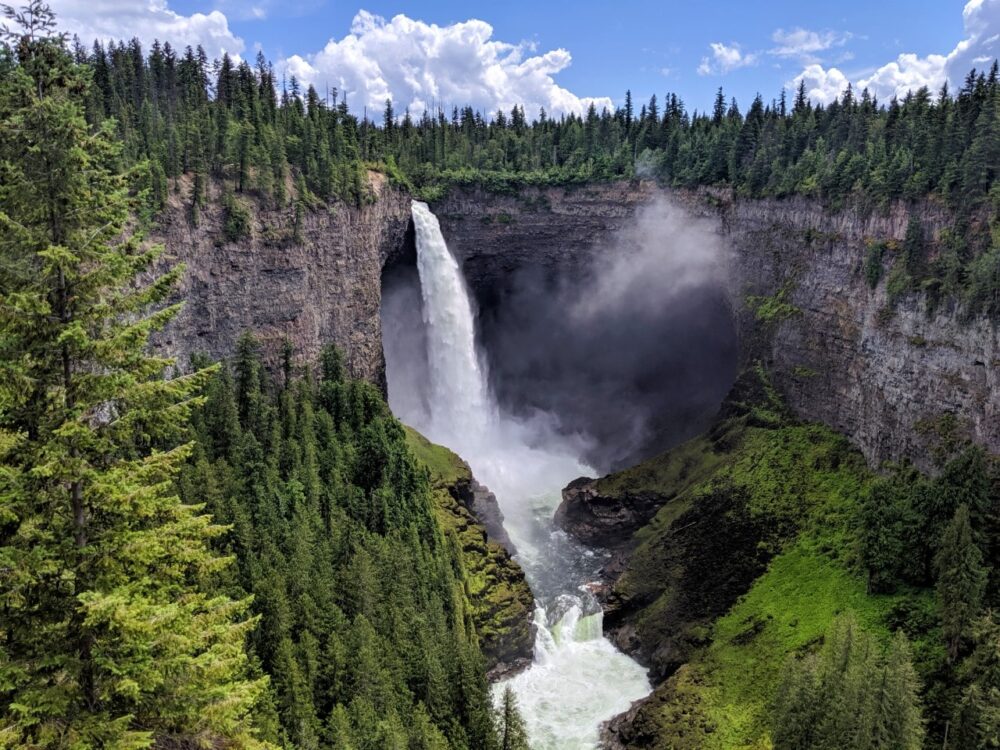
JR and I have been exploring the Canadian Rockies (and surrounding mountain ranges) for more than a decade.
This road trip route is very similar to one I recently organised for my parents, who were visiting from the UK. I wanted them to see the most iconic sights in the Canadian Rockies and also some quieter, off-the-beaten-track locations as well.
This detailed guide includes a day-by-day overview of the entire Canadian Rockies loop road trip itinerary, as well as planning tips to help save you money (and stress!) along the way.
Here’s what to expect:
Road trip itinerary at a glance
Need to know info.
- Exploring Banff
- Banff National Park
- Banff to Jasper
- Jasper National Park
- Jasper to Valemount
- Valemount to Kamloops
- Kamloops to Revelstoke
- Revelstoke to Golden
- Golden to Banff
Camping details
- Alternative itineraries
More planning resources
Published December 2023. This post includes affiliate links. If you make a purchase or booking through one of these links, we may receive a small percentage of the sale. All prices in this post are Canadian dollars.

Canadian Rockies Loop road trip overview
Time to start planning a Canadian Rockies loop road trip! This section of the guide provides an overview of the itinerary with a map and some important need-to-know information
Before we go any further, here is a look at the entire 9 road trip itinerary from start to finish (there is a 12 day version later in the guide):
Day 1 : Banff* Day 2: Banff Day 3: Banff to Jasper Day 4: Jasper Day 5: Jasper to Valemount
Day 6: Valemount to Kamloops Day 7: Kamloops to Revelstoke Day 8: Revelstoke to Golden Day 9: Golden to Banff**
*If beginning in Calgary, add 126km (90 minutes) drive from city. From Vancouver, drive directly to Revelstoke and start the itinerary mid-way through day 7 . **If finishing in Calgary, add 126km (90 minutes) drive back to the city
If one glance at this routing makes you think ‘way too fast!’ then I suggest looking at the alternative itineraries noted at the bottom of the page.
Travelling to Canada from Europe? While it is easier and faster to drive long distances in Canada compared to Europe, you may find that this itinerary includes way too much driving for your preferences. Again, I would suggest checking out the alternative itineraries section.
Canadian Rockies loop road trip map

- This Canadian Rockies road trip route can be explored in either direction, though I would recommend counter-clockwise (and the itinerary below is written in that direction) to ensure you can visit certain places early in the day
- The best time to drive this road trip is July to September . June can also be a good time, though some activities and trails will have limited accessibility at this time
- This itinerary is relatively fast-paced . If you choose to do most of the activities listed, you will likely be busy all day
- Need more downtime? Stretch this itinerary over a longer period or skip some of the activities/stops
- The route and suggested activities are aimed at people who enjoy exploring nature and being active while on vacation
- Please keep in mind that this Canadian Rockies road trip route offers just a taste of the activities and hiking trails on offer in these locations. It is impossible to do everything in such a relatively short road trip
- Before you leave home , learn how to avoid negative bear encounters and basic outdoor safety . If you see a bear while driving, stay in your vehicle!
- When exploring , be sure to always Leave No Trace (dispose of trash properly, stay on established trails, don’t feed wildlife)
- More tips and advice in our BC trip planning guide

Day-by-day Canadian Rockies loop road trip guide
Read on to discover a detailed breakdown of this Canadian Rockies loop road trip itinerary, including where to stay and what to do each day.
Day 1: Banff
Calgary to Banff driving distance: 127km Driving time without activities : 1 hour 30 minutes
*If beginning in Calgary, add 126km (90 minutes) drive from the city. If beginning in Vancouver, drive directly to Revelstoke and read the itinerary from day 7
There are so many different things to do in the picture-perfect mountain town of Banff and surrounding Banff National Park .

For many people, visiting spectacular Moraine Lake and Lake Louise is a priority. I’ve put them on the schedule for day 2.
My top picks for things to do in and around Banff Townsite:
- Explore the shores of Two Jack Lake and then cruise the Lake Minnewanka Scenic Drive (24km). Keep your eyes peeled for wildlife. Walk the shoreline trail or consider renting a canoe ($85/hour)
- The best free vehicle-accessible viewpoint is the Mt Norquay Lookout . It’s completely free and offers amazing vistas of Banff and surrounding peaks
- Thrill seekers will love the Via Ferrata course at Mt Norquay! The experience offers a safer way to experience climbing in the Rockies (and the views are AMAZING)
- Feel like a hike? The 2km uphill trail to the top of Tunnel Mountain is well worth the effort (300m elevation gain) as it ascends the slopes of this prominent landmark

- If that sounds like too much, reserve a spot on the Banff Gondola that ascends to the top of Sulphur Mountain . The views are simply spectacular. I’d recommend taking the bus (route 1) to avoid having to find parking at the gondola base
- Explore downtown Banff and enjoy the views of the surrounding mountains while browsing the wide range of shops
- If the shopping area doesn’t appeal, take a walk along the Bow River to see the falls . If you have the time, continue to the Surprise Lookout , which features views of the iconic Fairmont hotel
Side note here regarding accommodation. It’s no secret that Banff is not a cheap place to stay.
If your budget doesn’t stretch to it, consider the nearby town of Canmore instead (still touristy but more of a local vibe, slightly lower prices).
Where to stay
Budget Our preferred Banff campground for tent camping is Tunnel Mountain Village 1 . The sites are relatively private and the campground is just a short bus ride away from downtown
Mid-range Our favourite downtown hotel is Moose Hotel & Suites (walking distance to everywhere, rooftop hot tub). In Canmore , the Pocaterra Inn offers one of the best value stays in town
Luxury For a once-in-a-lifetime visit to Banff, consider the Fairmont Banff Springs or the Rimrock Resort . The latter has truly incredible views across Banff and the surrounding mountains
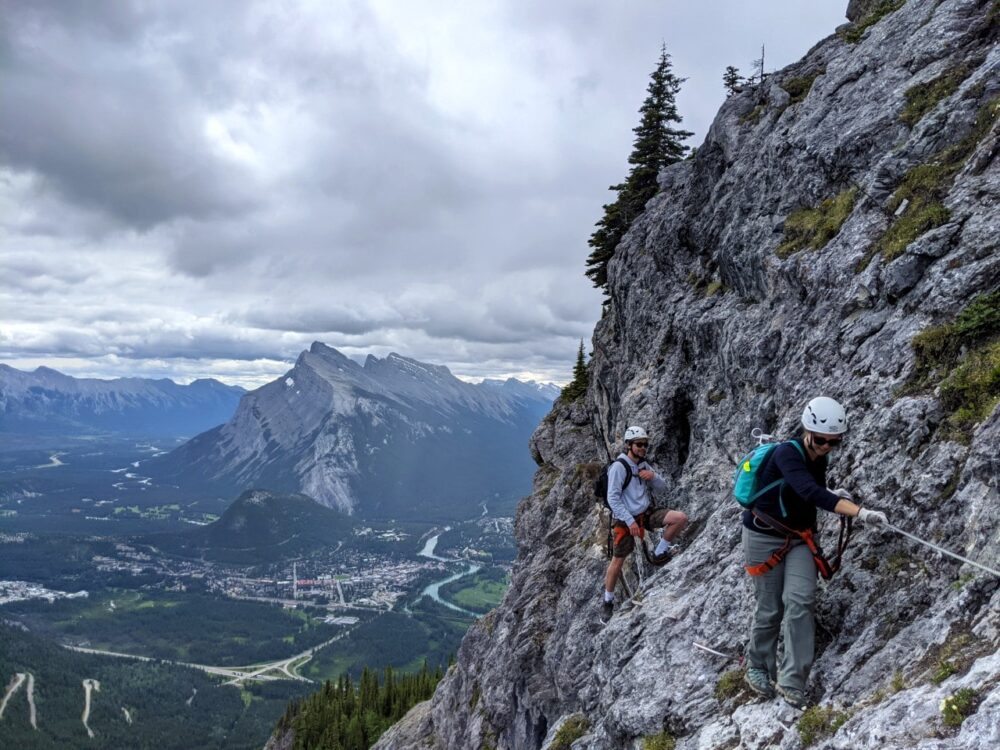
Day 2: Explore Banff National Park
Driving distance: 133km Driving time without activities : 1 hour 30 minutes
Start your day with a visit to Banff National Park’s most famous lakes – Lake Louise and Moraine Lake . Please note that Moraine Lake is usually open from late May to early October only.
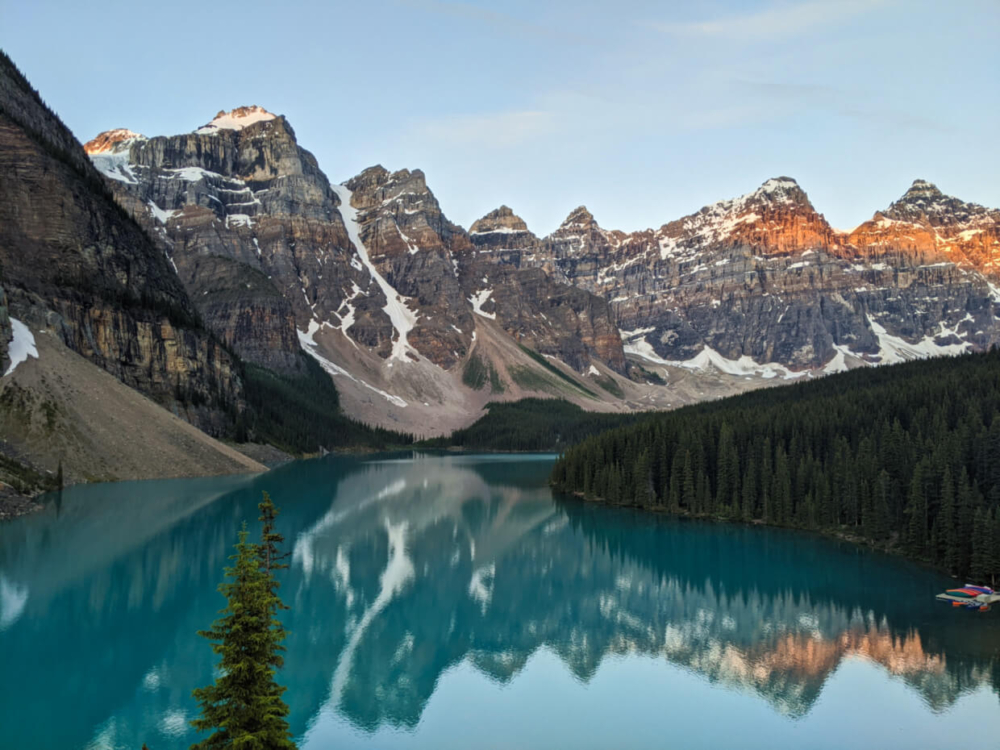
Since Moraine Lake is only accessible by bus and Lake Louise parking is very limited (and also $21/day!), there are two main options:
- Use the Parks Canada park-and-ride shuttle ($8) located at Lake Louise Ski Resort, 45 minutes drive from Banff. There are regular reservable buses to Lake Louise and Moraine Lake, with a Connector Shuttle.
- 8X Roam Transit bus from Banff to Lake Louise Lakeshore. This reservable express bus takes 55 minutes. The $25 Roam System Wide Pass includes access to the Parks Canada Lake Connector Shuttle to Moraine Lake
In addition to spectacular lakeshore views, both lakes have great hiking opportunities.
Lake Agnes is a very popular destination from Lake Louise, 7.4km return with 390m elevation gain (allow 2 to 2.5 hours, note that it is uphill almost the entire way).
Back in Banff, fill your afternoon with any activities you may have missed yesterday. If you already purchased the $25 Roam bus pass, use it to take the bus to the base of the Banff Gondola (avoiding the need to walk or find parking!)

Day 3: Banff to Jasper via Icefields Parkway
Banff to Jasper driving distance: 290km Driving time without activities : 3 hours 40 minutes
Depart Banff early to visit Johnston Canyon (32km, 35 minutes drive). Suspended metal walkways provide secure passage through the deep gorge to a series of waterfalls.
The 2.4km return hike to the Lower Falls takes less than 1 hour. The Upper Falls are 5km return. Johnston Canyon is usually very busy from 10am onwards, so I would recommend getting here by 9am at the latest.

Make a stop in Lake Louise for gas and supplies before hitting the road to drive Icefields Parkway (Highway 93) along the Continental Divide.
Often cited as one of the best road trips in the world, the Icefields Parkway is lined with towering mountains and immense glaciers, providing jaw-dropping vistas no matter where you look.
Driving the 230km Icefields Parkway without stopping takes around three hours. To visit most of the mentioned stops, allow five to six hours. Plan to arrive into Jasper early in the evening.

My favourite roadside viewpoints are Crowfoot Glacier , Bow Lake, Waterfowl Lake , Weeping Wall , the Big Bend , Tangle Creek Falls and the Goats and Glacier Lookout (all are featured on our road trip map ).
My recommendations for must-see places are:
- Bow Lake – Take a walk along the lakeshore of this beautiful vibrant blue lake surrounded by dramatic mountains
- Peyto Lake – Uphill 1km return trail (mostly paved) to an elevated viewpoint over a gorgeous turquoise lake
- Wilcox Pass Trail to Viewpoint – 3.4km return uphill hike to lower viewpoint (red chairs) over Athabasca Glacier, 9.5km return for upper viewpoint
- Sunwapta Falls – 200m walk to Upper Falls, featuring a bridge viewpoint of a dramatic waterfall cascading into a deep limestone gorge
- Athabasca Falls – Powerful waterfall accessible within a very short walk of the parking area, optional side trail into the canyon (well worth the stairs!)
Jasper is half the size of Banff. With two nights here, you’ll be able to see some of the park’s most impressive sights and also enjoy the charm of the compact townsite.
Budget Campers have a choice of campgrounds in Jasper – we usually stay at Whistlers Campground , which was completely renovated a few years ago
Mid-range The Mount Robson Inn is a solid downtown accommodation pick, with free breakfast and a range of room configurations (great for families/larger groups)
Luxury Treat yourself with a stay at the Fairmont Jasper Park Lodge . The upscale resort is located on a 700-acre lakeside property with spa, heated pool, golf course and restaurants

Day 4: Explore Jasper National Park
Driving distance: 103km Driving time without activities : 2 hours 30 minutes
Jasper National Park is Canada’s largest, with the small town of Jasper at the centre of it all.
- Start your day early with a drive on the scenic Pyramid Lake Road (15km return, 30 minutes)
- Elk are very commonly seen on this narrow and winding road that first passes Patricia Lake before skirting the edge of Pyramid Lake itself
- Take a short walk on Pyramid Island and enjoy the views of Pyramid Mountain before returning to Jasper and heading to magnificent Maligne Lake (50km one-way)
- Pre-book a cruise to Spirit Island , one of Canada’s most iconic and spectacular sights
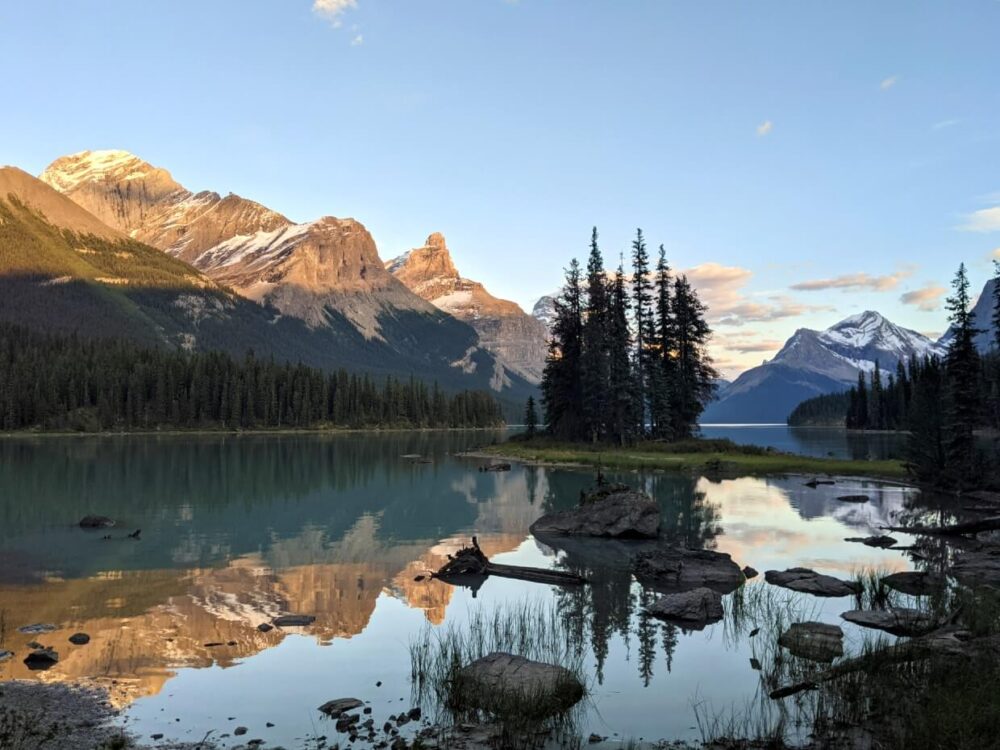
Yes, the cruise is super touristy but there’s no other way to see the true beauty of Maligne Lake in such a short amount of time ( paddling to Spirit Island takes around 6-8 hours return).
- On your way back to Jasper, stop at the Medicine Lake Viewpoint. This glacier-fed lake is famous for its ‘disappearing’ water.
- The second to last destination of the day is Maligne Canyon . There is a choice of loop and out-and-back routes here. The easiest is a very short 600m loop to Bridge #2 featuring impressive views of the rushing water and deep canyon
- For a longer experience, consider the hilly 5km out-and-back route to Bridge #5 . It includes numerous impressive viewpoints and even several waterfalls. There is a loop alternative but it’s less scenic as the path veers away from the canyon
- Before leaving the Maligne Lake Road area, check out the gorgeous views from the Maligne Lookout. The parking lot is the next right-hand turn after leaving Maligne Canyon

Day 5: Jasper to Valemount
Jasper to Valemount driving distance (via Mount Edith Cavell): 183km Driving time without activities : 3 hours 10 minutes
The drive between Jasper and Valemount is scenic and straightforward, though there are not many easily accessible roadside activities. For that reason, I would recommend spending your morning in Jasper National Park.
There are so many options for what you could do this morning but my top pick would be seeing Mount Edith Cavell and the Angel Glacier that flows down its north face.

The narrow and winding 27km Edith Cavell Road takes around 45 minutes to drive from Jasper. If you had more time to spare, I would suggest exploring the Edith Cavell Meadows Trail as well.
- Leaving Jasper, prepare to gain an hour at the British Columbia border (hooray!)
- Make a stop at beautiful Overlander Falls . Allow 30 minutes to walk to the main viewpoint and back
- Just around the next corner is Mount Robson , the highest peak in the Canadian Rockies (3954m). The best views are found right in the parking lot
- The Mount Robson Visitor Centre has some great indoor exhibits (and it is free!) and there’s a good café here as well
- Less than 10 minutes drive further on from Mount Robson is Rearguard Falls Provincial Park . A steep and short trail leads down to several viewing platforms of this thundering waterfall
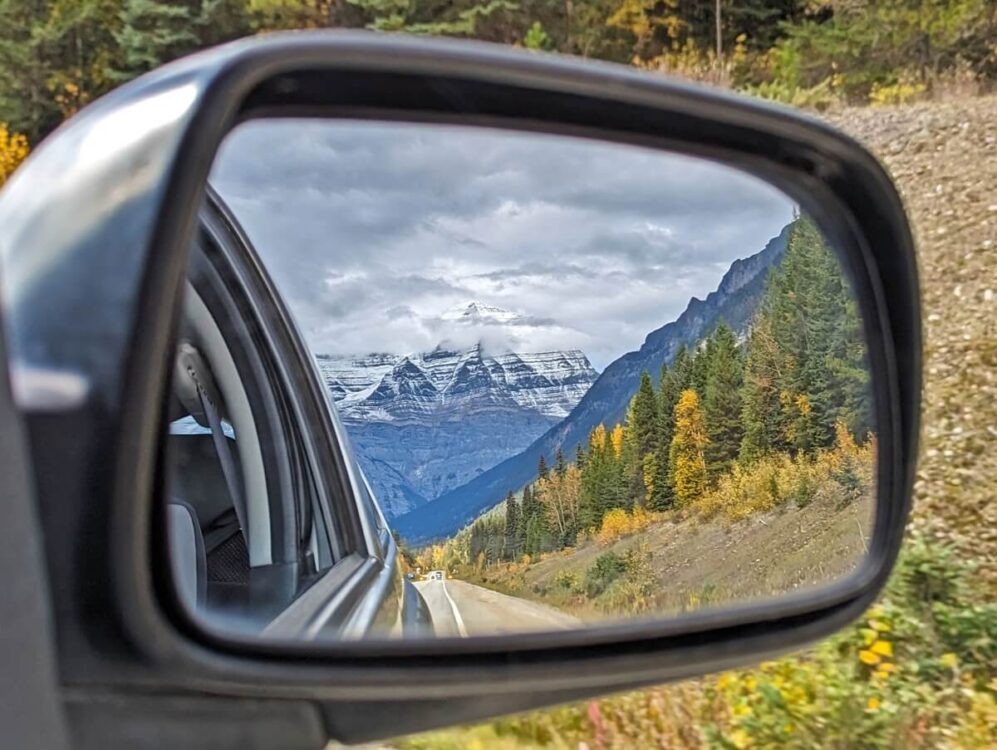
Turning onto Highway 5 towards Valemount reveals views of the ‘other’ side of the Canadian Rockies.
Valemount is a small village (pop 1052) with a surprisingly good choice of accommodation. There’s an excellent local brewery, a very popular Swiss-German bakery and an entry-by-donation museum.
Budget Valemount has several private RV parks . An alternative idea is to stay at one of Mount Robson’s provincial park campgrounds . I prefer Robson River over Robson Meadows, but both are good
Mid-range Canadas Best Value Inn Valemount is a no-frills option while the Comfort Inn & Suites offers more amenities and complimentary breakfast
Luxury The most upscale place in Valemount is the Best Western Plus . If you’re looking for something a little more unique and local, try Valemount Mountain Retreat Guesthouse

Day 6: Valemount to Kamloops
Valemount to Kamloops driving distance (via Wells Gray): 412km Driving time without activities : 5 hours
Start your morning with a couple of hours of driving through the lush North Thompson Valley.
The star attraction of this day is Wells Gray Provincial Park , one of BC’s most spectacular protected areas. It is a little more rustic (and much quieter!) than the national parks.
Part of a volcanic field that started forming approximately 3.5 million years ago, Wells Gray is host to 40+ spectacular waterfalls as well as glacier lakes, snow-capped mountains and more.
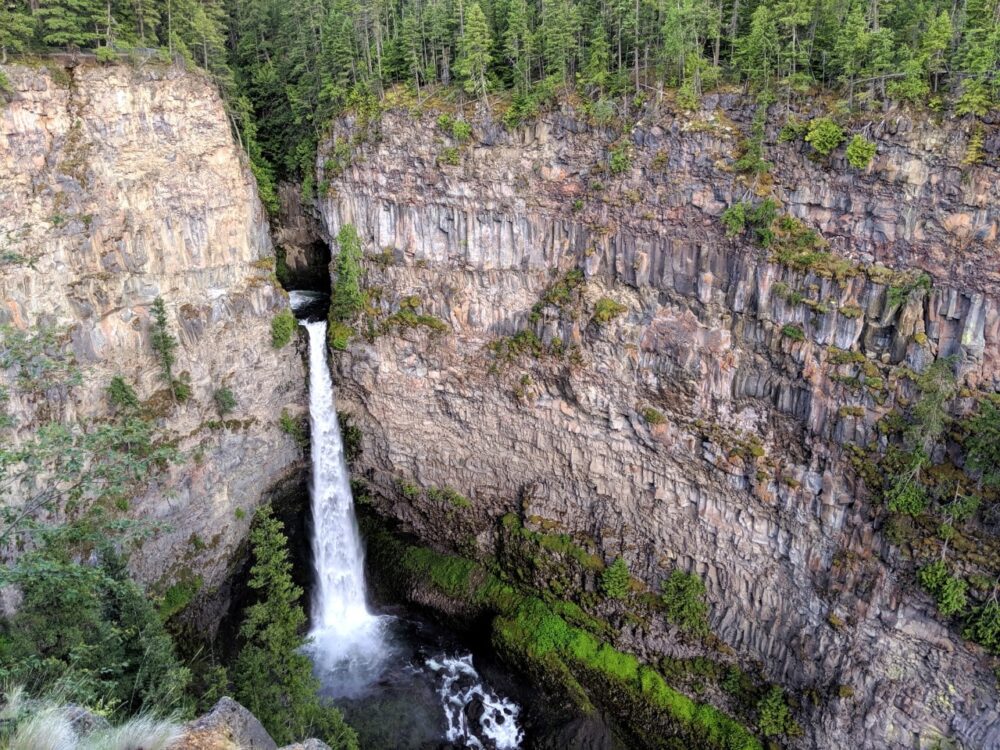
Once in Clearwater, turn onto Clearwater Valley Road and prepare for 2-3 hours of waterfall chasing!
- Spahats Creek Falls – 60m high narrow waterfall cascading into deep, wide canyon. It’s just a short walk from the parking lot
- Moul Falls . Optional stop since it is only accessible via a 6km return hike (half easy, half moderate). Short waterfall in rocky bowl
- Dawson Falls. Reminiscent of a small-scale Niagara Falls, this waterfall stretches wide across the river. 900m return
- The Mushbowl – Fast, frothy and rocky waterfall by roadside, just after Dawson Falls parking lot
- Helmcken Falls – Magnificent 141m high waterfall plunging into a rugged canyon. Short walk from the large parking lot
Beyond Helmcken Falls, the road is unpaved. For travellers with more time, the Ray Farm Trail is a pleasant 3km return (homesteading history, interesting mineral springs). The 1.6km return trip to Bailey’s Chute Trail combines both waterfalls and rapids.

Leaving Wells Gray Provincial Park, the drive to Kamloops is pretty straightforward. Watch for the Canadian Mountaineer train on the parallel tracks!
Kamloops has a wide choice of accommodation and eateries. An alternative overnight destination would be Salmon Arm. The drive would take around an hour longer.
Budget Pauls Lake Provincial Park has a charming forested campground within walking distance of sandy beaches. The park is 25km from Kamloops
Mid-range Kamloops’ best value accommodation is found at… Canadas Best Value Inn (seriously!) Another good option is the downtown Plaza Hotel
Luxury For upscale lodgings in the downtown area, book a stay at the Delta Hotel . The location is convenient for restaurants and also when arriving from Highway 5
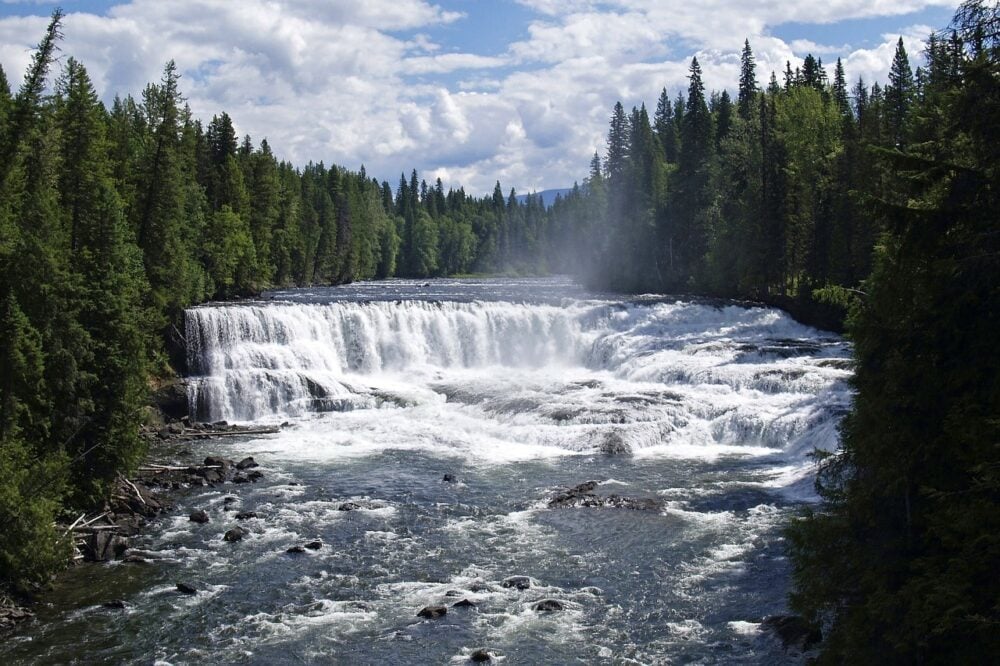
Day 7: Kamloops to Revelstoke
K amloops to Revelstoke driving distance: 212km Driving time without activities : 2 hours 30 minutes
Kamloops is situated in British Columbia’s dry grasslands region and consequently, the landscape looks very different to anything else on this Canadian Rockies loop road trip.
I don’t have that many recommendations for must-see stops between Kamloops and Revelstoke – plan to spend most of your time in Revelstoke itself.
- Monte Creek Winery is worth a look if you reach it after 11am
- On a hot day, the Blind Bay beaches on Shuswap Lake can be great for a refreshing dip
- Salmon Arm makes for an excellent lunch stop. The DeMille’s Farm Market sells fresh produce from the Shuwap region throughout the summer months
- Just past Sicamous is D Dutchmen Dairy , a family farm selling homemade ice cream, cheese and milk. Note that it does get very busy around lunchtime
- The drive along Highway 1 from Sicamous to Revelstoke has plenty of pretty sections but not many places to stop. One of our favourite rest areas is the Last Spike , a historical site celebrating the completion of the railway connecting eastern and western Canada
Arriving in Revelstoke sometime in the early afternoon, I’d suggest making the most of the day with a scenic drive on the 26km long Meadows in the Sky Parkway into the subalpine of Mount Revelstoke National Park (park pass required).

At the end of the road, there is an uphill 1km long trail to the summit area (1947m). If you’ve never visited the top of a mountain, this is a great way to do it. There is a choice of short trails, all with interpretive signage.
If you’re travelling with kids, you may want to prioritise visiting Revelstoke Mountain Resort instead, home of the 42km/h Pipe Mountain Coaster .

Whatever you do, make sure you spend some time in downtown Revelstoke. It’s one of my favourite mountain towns in BC (friendly vibes, great range of shops and restaurants, plenty of history).
For travellers who have another night to spend in Revelstoke, I would recommend white water rafting with Apex or a hike on the wonderful Eva Lake Trail (14km return) which starts at the summit of Mount Revelstoke.
Budget Snowforest Campground in Mount Revelstoke Park is convenient for the Meadows in the Sky Parkway. Alternatively, try Martha Creek Provincial Park
Mid-range The Swiss Chalet Motel offers excellent value for families and larger groups. Basic breakfast included and the property is only 10-15 minute walk to downtown
Luxury The stylish rooms at the historical Regent Hotel are surprisingly spacious. The complimentary breakfast buffet is the best I’ve had anywhere in Canada

Day 8: Revelstoke to Golden
Revelstoke to Golden driving distance: 148km Driving time without activities : 2 hours
Time to head further into the mountains! Begin the day with a short 500m stroll on the Highway 1 adjacent Giant Cedars Boardwalk in Mount Revelstoke National Park (closed in 2023 but hopefully open in 2024).
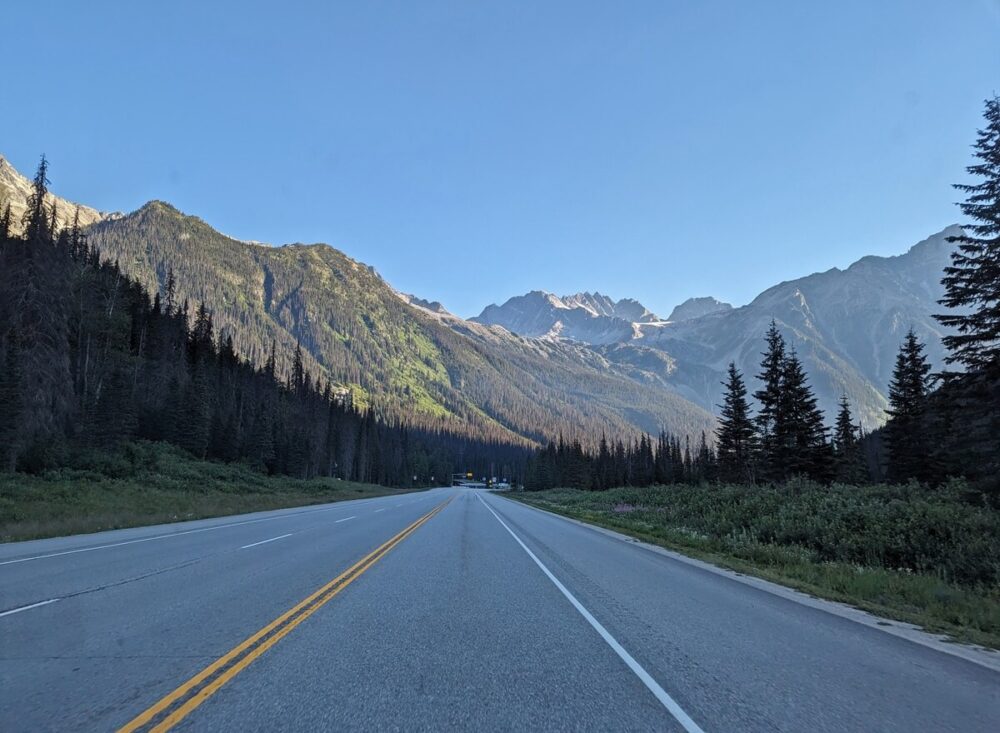
The surrounding valley slopes get steeper and steeper as the highway heads into Glacier National Park. Multiple snowsheds and tunnels provide avalanche protection for the road in winter.
- Two short hiking trails provide a taste of the surrounding national park – Hemlock Grove Boardwalk (350m) and the Rockgarden Trail (430m)
- For a longer hike, head to the Meeting of the Waters Trail (3.3km loop, starts from the Illecillewaet Trailhead).
- Most of the other hikes in this area of the park are very steep and require most of the day to explore (such as the Glacier Crest Trail ).
- The highest section of Highway 1 is at Roger’s Pass, with an elevation of 1327m. The Discovery Centre here is well worth the stop (free)
- Before leaving Glacier Park, consider the very short but steep hike to beautiful Bear Creek Falls (1km).
The time zone change , from Pacific Time to Mountain Time is just beyond the park’s border. Unfortunately, you’ll lose an hour when driving east. There are usually construction delays in this area too.

If you do get into Golden early, consider heading east through town towards Wapta Falls in Yoho National Park.
The 3.2km return hike (mostly flat, with some steep sections near the end) takes just over an hour with the destination an impressively wide waterfall surrounded by mountains.
Families and thrill seekers may prefer to check out the Golden Skybridge , host to Canada’s highest suspension bridges, or the Via Ferrata course at Kicking Horse Mountain Resort.
Budget For camping, consider the municipal campground , which backs onto the Kicking Horse River. An alternative is the Kicking Horse Campground in Yoho National Park
Mid-range Golden has a plethora of motels and chain hotels to choose from, with popular options being the Holiday Inn and Ramada (we’ve stayed at the latter twice)
Luxury Moberly Lodge ‘s quiet, spotlessly clean rooms are a welcome sight after a day exploring Glacier National Park. Outside, there are stunning views and a hot tub, ideal for a post-hike soak
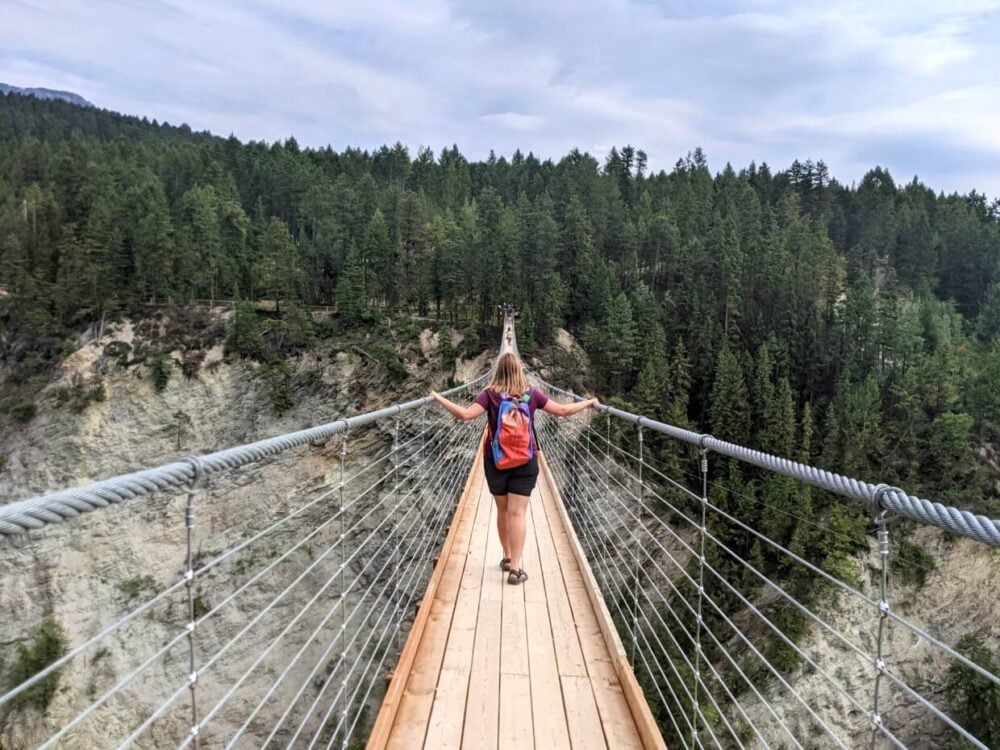
Day 9: Golden to Banff*
Golden to Banff driving distance (via Emerald Lake, Yoho Valley Road): 187km Driving time without activities : 2 hours 45 minutes
This day is all about Yoho National Park . In my opinion, Yoho is the most underrated park in the Canadian Rockies.

- The first stop today is Emerald Lake , which is as beautiful (or even more so!) as the name implies
- Enjoy the views, rent a canoe ($90/hour) or walk the family-friendly 5.2km loop trail around the lakeshore. Allow around 2 hours for the latter
- On the way back to Highway 1, make a stop at the Natural Bridge , where the mighty (and very cold!) Kicking Horse River has carved out a natural limestone bridge through erosion
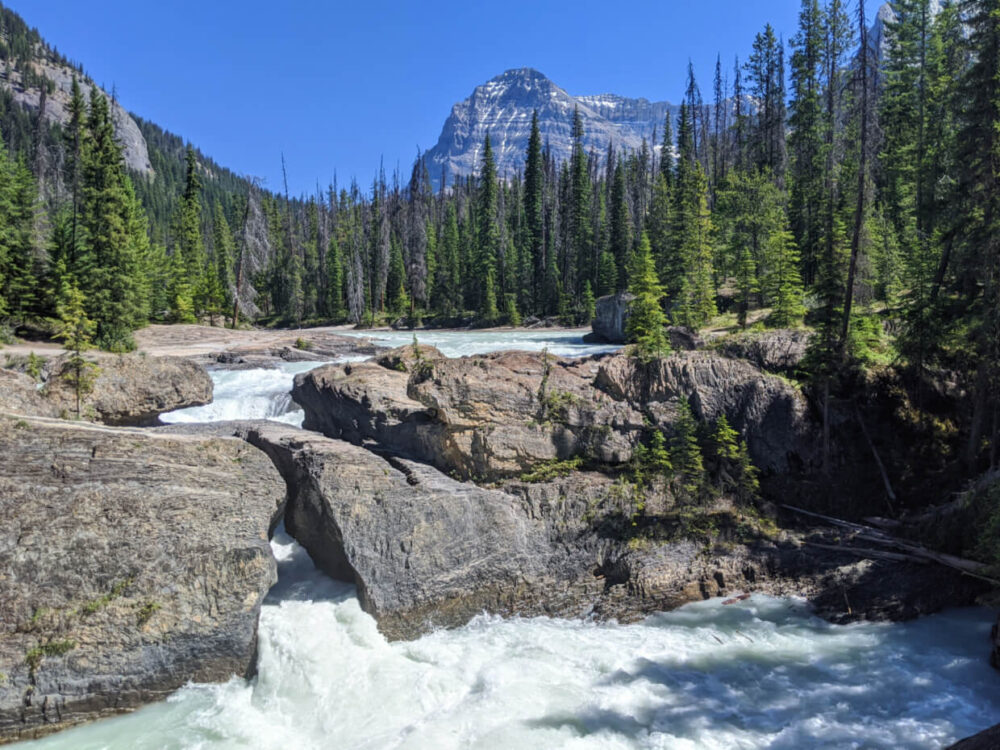
- The tiny community of Field hosts an excellent restaurant (Truffle Pigs) and Visitor Centre as well as impressive mountain views
- Next up is a scenic drive on Yoho Valley Road . Please note, this road is open from late June until Mid October only and has no services or phone signal. There are several tight switchbacks – trailers and large RVs are not permitted
- Takakkaw Falls , British Columbia’s second-tallest waterfall, is located at the end of Yoho Valley Road
- If you have an additional day to spend in Yoho, I would highly recommend a full-day hike on the Iceline Trail or a Burgess Shale guided tour
- The Spiral Tunnel Viewpoint is the last stop in Yoho. Depending on timing, you may be lucky and see a train pass through this impressive structure.
The remaining distance to Banff is impossibly scenic, with snow-capped mountains surrounding the highway.
If you have any spare time, Kootenay National Park’s Marble Canyon (15 minutes drive) is well worth the detour.
*If starting in Vancouver, plan to stay in Banff for the night and continue to ‘Day 1’ description next. If finishing in Calgary, add 126km (90 minutes) drive back to the city
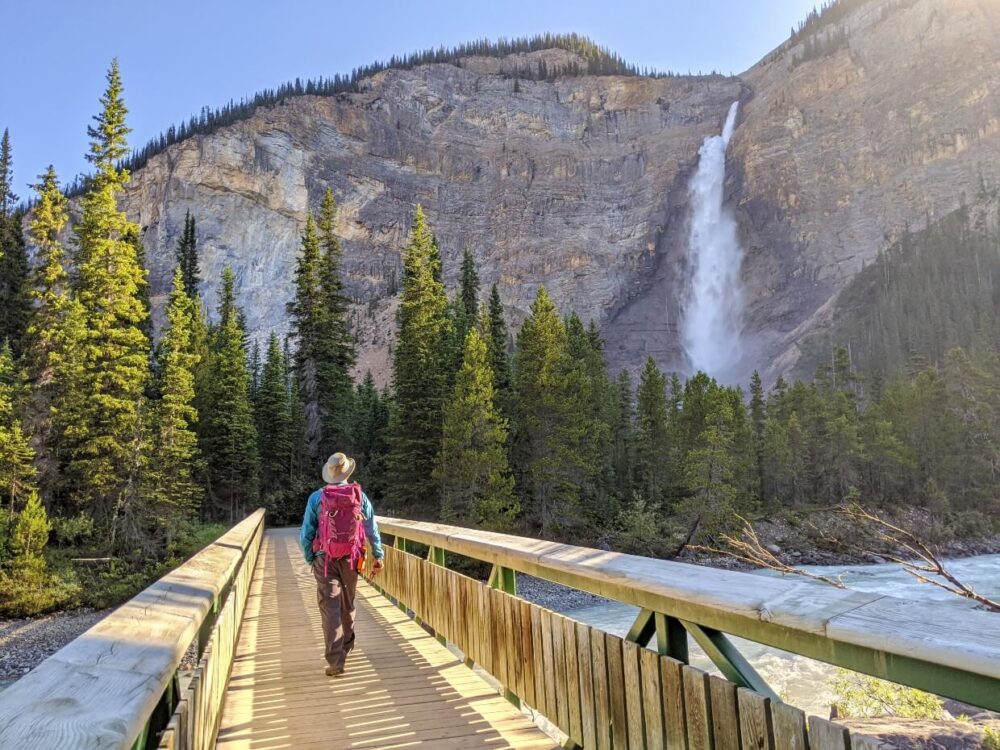
Canadian Rockies loop road trip: top tips
In this section, I will share some final thoughts about planning a Canadian Rockies loop road trip.
Money saving advice
- Gas is significantly cheaper in Alberta than in British Columbia , even in resort towns like Banff, Jasper and Lake Louise. Be mindful of where you gas up!
- Most of the overnight stops are in small towns. During the summer months, accommodation and dining availability and choice can be limited. Book early!
- This itinerary focuses on free activities over paid ones. I have, however, mentioned half a dozen paid attractions which I think offer one-of-a-kind experiences
- A national park pass is required to visit Jasper, Banff, Yoho, Glacier and Revelstoke national parks. All five parks are covered by the same day pass ($10.50/adult). If you plan to spend seven or more days in the parks (as you would with this itinerary), a Discovery pass provides better value
- Wells Gray Provincial Park and Mount Robson Provincial Park are completely free to visit
- The choice of restaurants and cafes is pretty limited on this Canadian Rockies road trip loop route. To save time and money, make your own lunch each day and buy plenty of snacks
The best way to save money while touring the Canadian Rockies is to camp.
- National park campgrounds (Parks Canada) average $30-50/night plus $11.50 reservation fee
- Provincial park campgrounds (BC Parks) average $20-40/night plus $6/night reservation fee
- Private campgrounds average $30-70/night
The downside is that you’ll need camping equipment. An alternative option is to rent an RV, so you can sleep in your vehicle.
It is possible to buy relatively cheap camping gear and accessories at Canadian stores like Walmart. A full set-up with an entry-level tent (4 person), sleeping bags (2), sleeping mats (2), stove and other essential supplies would cost around $500CAD.

The campgrounds mentioned in this Canadian Rockies loop itinerary are very popular and, as such, travellers should reserve in advance.
- Reservations for vehicle-accessible national park campgrounds usually open in January for the following summer. The exact launch dates are usually revealed during the preceding December. Parks Canada reservation website
- Reservations for vehicle-accessible provincial park campgrounds in British Columbia operate with a four-month rolling window . So if you want to book for 7th August, the date will be available to book on 7th April. BC Parks reservation website
Not mentioned in this post is the collection of excellent first-come, first-serve campgrounds along the Icefields Parkway. Consider staying at least one of these during your road trip (instead of Banff and/or Jasper).

Alternative road trip itineraries
While we think the above Canadian Rockies loop road trip itinerary provides a great overview of BC and Alberta, we know that may not be perfect for everyone.
The great news is that it is easy to adapt the route to create your perfect itinerary.
- Starting and finishing in Vancouver? Check out our 2 week Western Canada road trip itinerary
- Want to visit the Canadian Rockies AND Vancouver Island? We have a 2 week BC Coast and Mountains route for that too!

12 day Canadian Rockies extended road trip loop
If you have extra time and budget (up to 12 days), I would extend the original loop road trip itinerary like so:
Day 1 : Banff National Park Day 2 : Banff National Park Day 3 : Banff National Park Day 4 : Banff to Jasper Day 5: Jasper National Park Day 6: Jasper National Park
Day 7: Jasper to Valemoun Day 8: Valemount to Kamloops Day 9: Kamloops to Revelstoke Day 10: Revelstoke to Golden Day 11: Golden Day 12: Golden to Banff
This lengthened trip includes one additional night in both Jasper and Banff national parks and a second night in Golden. This would provide a much more relaxed pace and the chance to visit more attractions.
During the full day in Golden, explore the optional activities mentioned in this post such as Wapta Falls , Golden Skybridge or Kicking Horse Resort .
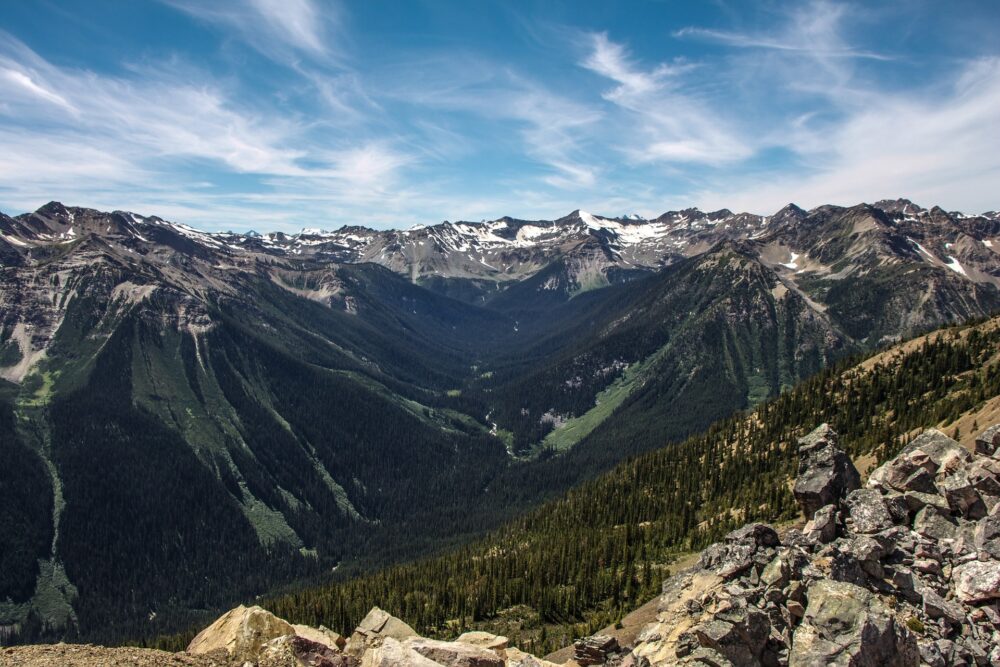
Okanagan Valley detour, 2 additional days
For an interesting contrast to the Canadian Rockies, consider a detour to the Okanagan Valley on your road trip.
The southern interior of British Columbia is host to a spectacular landscape of dry valleys, huge lakes and grasslands. Besides being beautiful, the Okanagan Valley is also Canada’s second-largest wine region. It’s also where we live!
If starting your Canadian Rockies road trip from Vancouver , I would detour via the Okanagan Valley on the way to/from the main loop described in this post. Plan to spend one night in Penticton, Peachland, Kelowna or Vernon.
Highway 97 travels through the centre of the Okanagan and then connects with Highway 1 near Sicamous (west of Revelstoke).
Read our suggestions for things to do between Vancouver and the Okanagan Valley before starting your planning.
Road trippers starting in Calgary could detour to the Okanagan Valley from Kamloops and return to the main loop route at Sicamous. Plan to spend the night in Kelowna, Peachland or Penticton.

8 day Canadian Rockies itinerary without a loop
If the concept of the loop doesn’t interest you, consider this alternate 8 day Canadian Rockies road trip itinerary which starts and finishes in Calgary:
Day 1 : Calgary to Banff Day 2 : Banff National Park Day 3 : Banff to Jasper Day 4 : Jasper National Park
Day 5: Jasper National Park Day 6: Jasper to Golden Day 7: Golden Day 8: Golden to Calgary
The first four days would follow the same itinerary as guided in this post.
On day 5, take a day trip to the Mount Robson area from Jasper OR explore more of Jasper National Park. Day 6 involves driving the Icefields Parkway again (never a bad thing!)
I have suggested two nights in Golden as the drive from Jasper is reasonably long, especially with sightseeing stops.
During the full day in Golden, explore the optional activities mentioned in this post OR take a day trip to Glacier National Park.

15 of the Best Day Hikes in British Columbia Ultimate 2 Week Western Canada Road Trip from Vancouver: Itinerary, Tips & Map What To Do in Wells Gray Provincial Park, British Columbia Toronto to Vancouver Road Trip: 24+ Great Places to Stop 5 Awesome Alternatives to Banff, Alberta The Best Hot Springs in BC: Complete Guide + Map
Adventure in your inbox
Subscribe to our monthly email newsletter and receive a round-up of our latest outdoor adventures plus other exciting beyond the beaten path destinations
We never share your information with third parties and will protect it in accordance with our Privacy Policy
Check out these recently published posts:
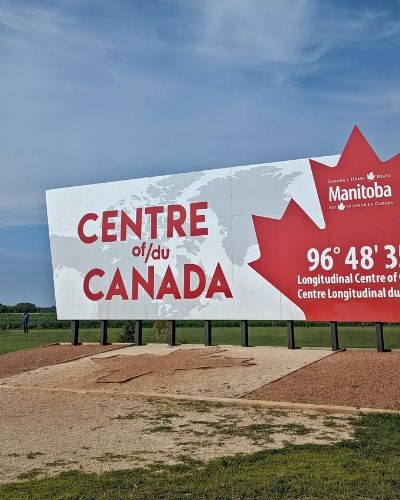
Toronto to Vancouver Road Trip: 24+ Great Places to Stop
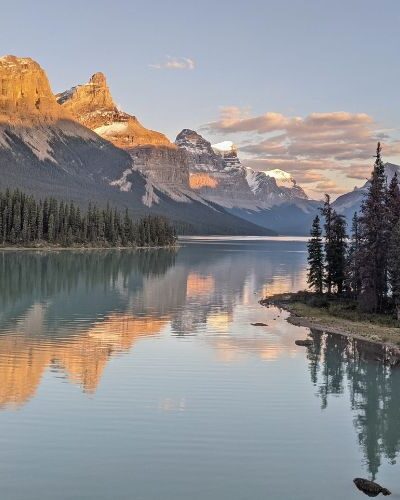
Spirit Island: Complete Guide with Map, Paddling Details, Boat Tour + More
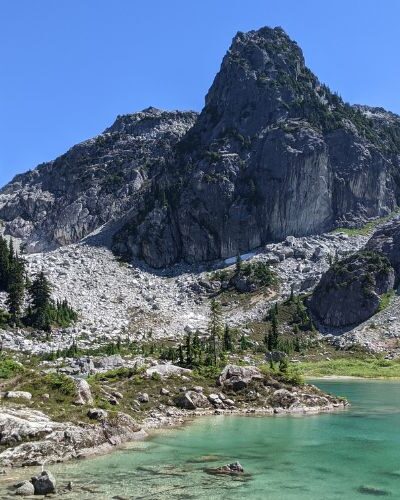
IEC Working Holiday Canada Extension Guide
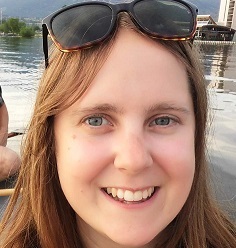
One half of the Canadian/British couple behind Off Track Travel, Gemma is happiest when hiking on the trail or planning the next big travel adventure. JR and Gemma are currently based in the beautiful Okanagan Valley, British Columbia, Canada
Andy & Linda Nette
Thursday 7th of December 2023
Thank you for this Canadian Rockies tours suggestions. For our 50th wedding anniversary, my wife and I have booked and paid a deposit on a 14 day river cruise in April ‘24 on the Danube, but have been unable to generate any excitement about it. After looking at your site, we have decided to forego our deposit, stay in Canada, and book as per your suggestions above. We appreciate the thoroughness of your research.
Hi Andy and Linda,
Wow, what a compliment! I'm sorry that your planned trip failed to inspire you but I'm so glad you've found an alternative! Happy to help :) Make sure you check out our 2 week Western Canada road trip itinerary as well.

Road Tripping from Vancouver to the Rockies
- October 8, 2017
R oad tripping from Vancouver to the Rockies is something we've been wanting to do since we arrived in Canada. The Rockies have some of the most beautiful, iconic and dramatic landscapes in the whole of Canada, not to mention the gorgeous turquoise blue lakes and wildlife. Matt and I love road tripping, so this September we partnered up with Jeep who loaned us a gorgeous White Grand Cherokee Trailhawk and spent 7 days adventuring around the amazing Yoho, Banff, and Jasper National Park.
The trip consisted of road tripping, camping, canoeing, walking on glaciers, hiking, and of course taking tons of photos, and it was honestly one of the best trips we’ve ever done. I’m usually happy to come home to Vancouver after travelling but for the first time ever I really did not want to come back!
We decided to go in September to try avoid the summer crowds but also enjoy it before winter kicked in. It was still fairly busy (more so in Banff than Jasper), so we were at the lakes by 6:30am most mornings to enjoy it in peace as the coaches of people would begin to arrive by 9am.
We experienced all seasons when we were in Yoho & Banf and it went from scorching sunshine to -5°C & snow in the space of 3 days. However, the weather in Jasper was amazing which meant we got to experience the famous night skies and we even caught the Northern Lights (!!!) unexpectedly, for the first time ever, which was incredible.
Our Jeep, which we decided to name JuJubes, was the perfect travel companion and I’ve definitely found my new dream car (scroll down to read about it). I’ve fallen in love with camping and in hindsight, I would have happily camped for the whole week as I didn’t realize the campsite facilities would be so good, and since the car had a plug socket we basically had everything we needed.
Road tripping from Vancouver to the Rockies was unbelievable and the trip was everything I dreamed it to be. It was a bucket list experience and we're already planning to go back, especially to Jasper as it's such a magical place. So, if you’re thinking of embarking on this trip yourself, I’ve compiled a 7-day itinerary to help you plan your trip and figure out where to stay & where to go on your road trip in one of the most beautiful places in the world!
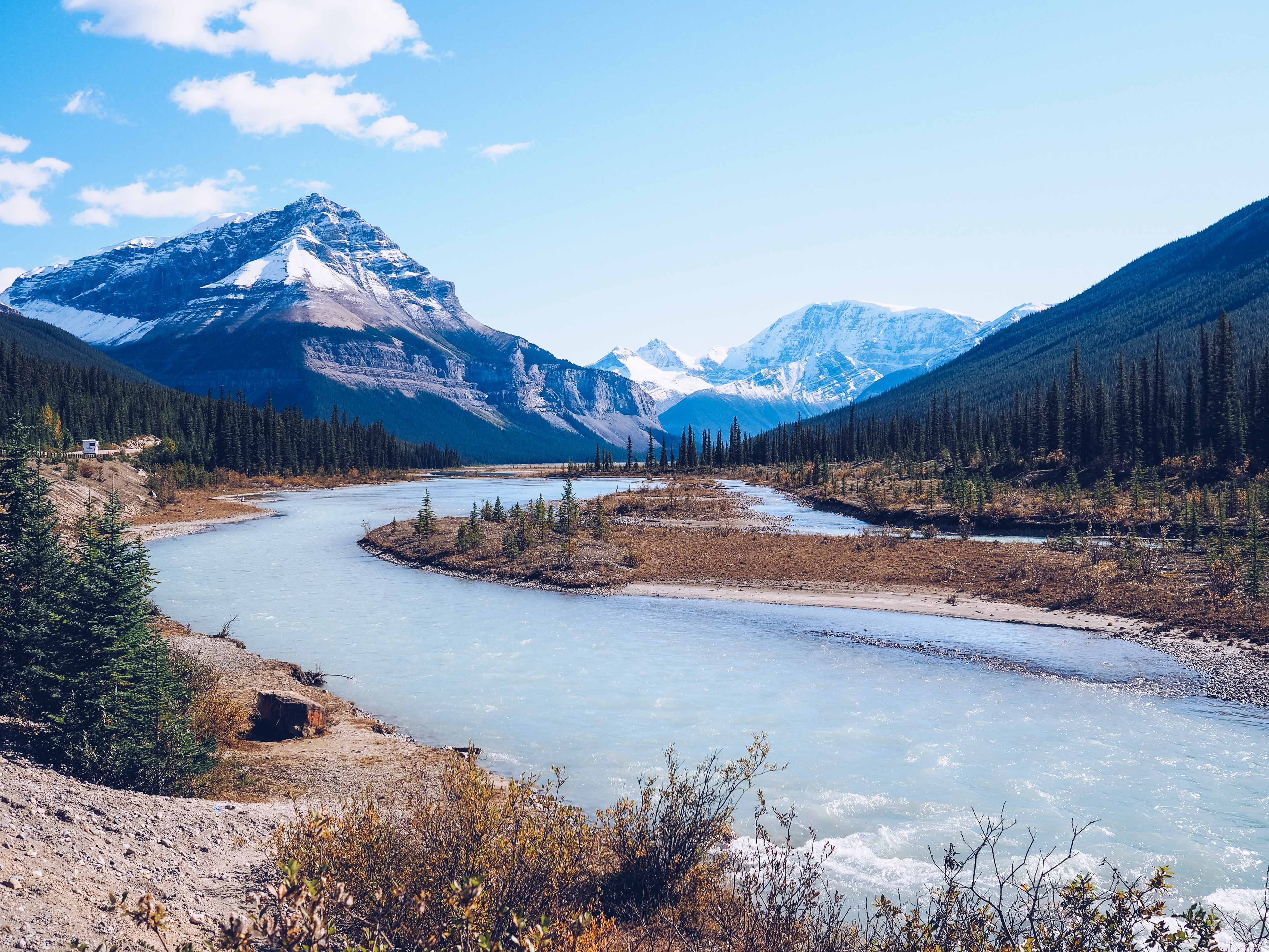
Road tripping from Vancouver to Yoho
The first leg of our journey was driving from Vancouver to Yoho. The distance is 740km if you go via Kamloops, the route is pretty straightforward, and the landscapes on the way are lovely. We stayed in Kamloops on Sunday night to break up the journey so that on Monday we’d be halfway there already. We stopped in Sicamous for breakfast and found a cute little café called Blondies (their Acai bowls are delish), Revelstoke is beautiful and there are some great hikes there plus a ski resort, and the drive through Glacier National Park is stunning. The final destination was Yoho National Park – the main town is Field – and one of the most notable places in Yoho is the famous Emerald Lake. You can hike around the lake and there are many small & big hikes that start from here too, such as Emerald Basin (9km), Hamilton Lake (11km) & Yoho Pass (12.8km).

Yoho to Lake Louise
We headed to Emerald Lake for sunrise and were met with one of the calmest, most peaceful views I’ve ever seen. It was really special to experience it with only a few other people around, and while I spent an hour or so taking photos and enjoying the quiet, Matt whipped us up some brekkie on the stove. It was definitely one of the most picturesque places I’ve ever had breakfast, that’s for sure. The name “Yoho” comes from the Cree word for awe and wonder, and you can see why as it’s absolutely breathtaking.
After we packed up our campsite (we stayed at the Kicking Horse site) we headed to Takakkaw Falls, a majestic waterfall about 30 minutes (13km) from Emerald Lake. It’s a pretty steep and windy drive but it’s worth it as the waterfall is ginormous and the gushing water and dramatic landscape are really mesmerising. It’s only a 10-minute walk from the car park too which is nice, but there are hikes to do from there such as Twin Falls (16.5km), Laughing Falls (9km) and Yoho Pass (13km). Find more on Yoho’s hikes here .
The next stop was Lake Louise town, where we were staying that night. We attempted to visit Moraine & Lake Louise in the day but it was crazy busy and very rainy, so we decided just to road trip around and head down the Bow Valley Parkway and take in the scenic views.
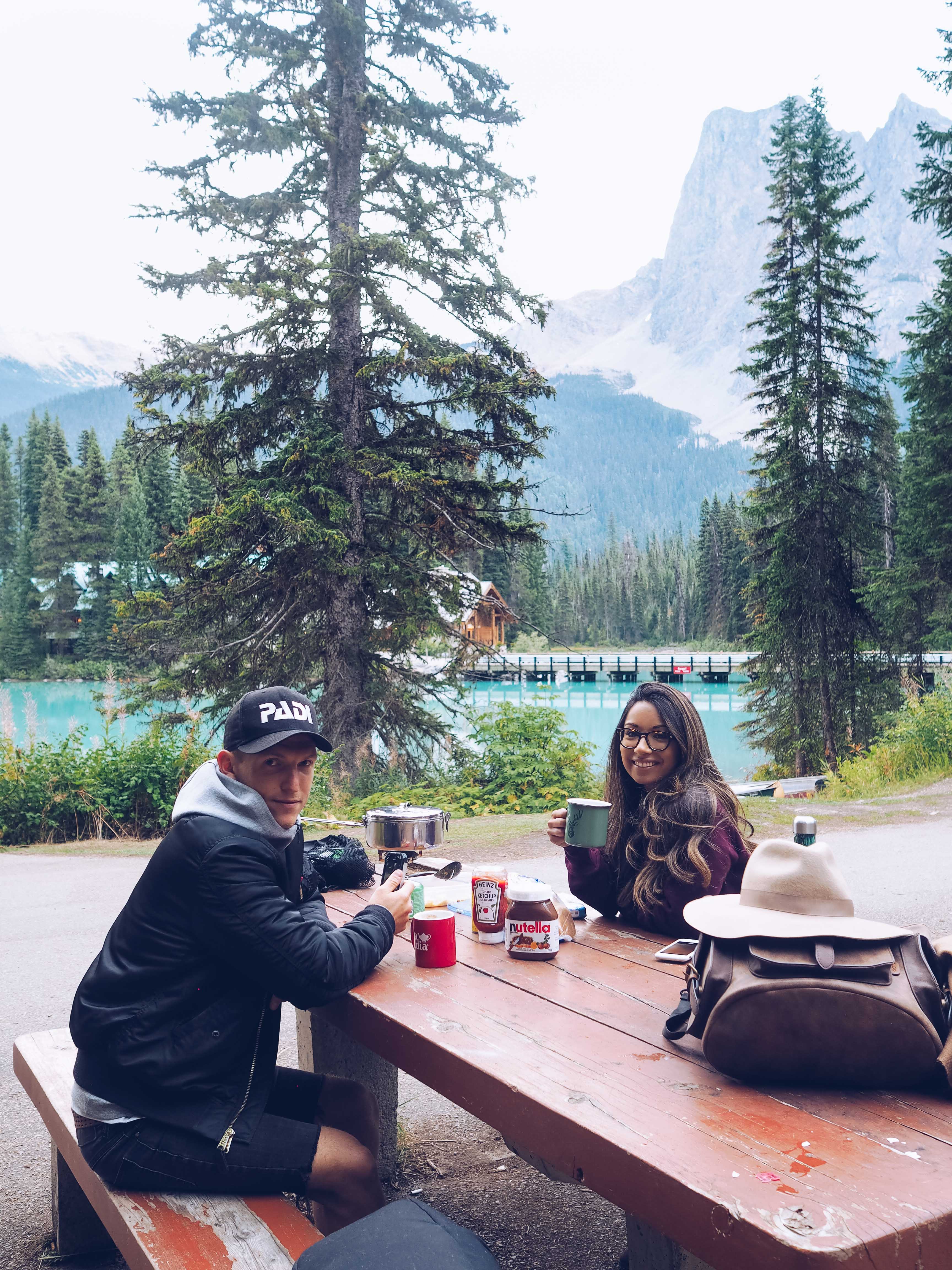
Exploring Banff's Lakes!
On day #3, we road tripped to around some of Banff's most iconic turquoise lakes and they really are as stunning as they look in photos! We actually visited Banff in Spring a couple of years ago, but it was a winter wonderland and everything was frozen over so we didn't get to see the lakes in all their glory. We started off at Moraine and Lake Louise, then headed up to Peyto and Bow Lake, and camped out at Mosquito Creek on the Icefields Parkway which was a really lovely campsite.
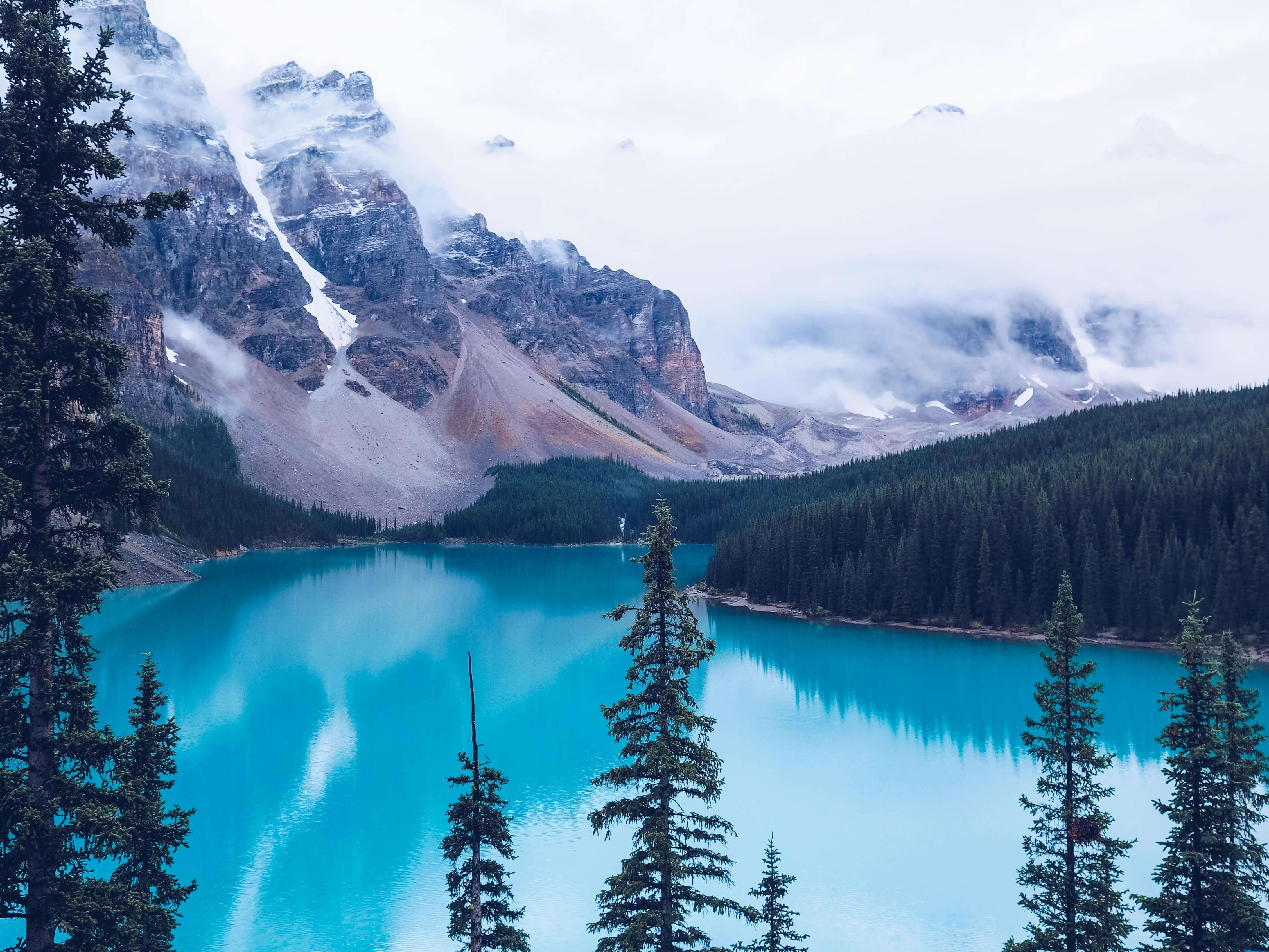
Lake Moraine
Moraine Lake is so gorgeous and the view is insane. The parking lot is right next to the lake, and you can admire the view either from the foot of the lake or at the top of the big rockpile to the left of the viewing point. Keep in mind that Moraine Lake Road is closed from October to early June as the road becomes inaccessible. You can rent canoes here in summer & follow the trail around the lake.
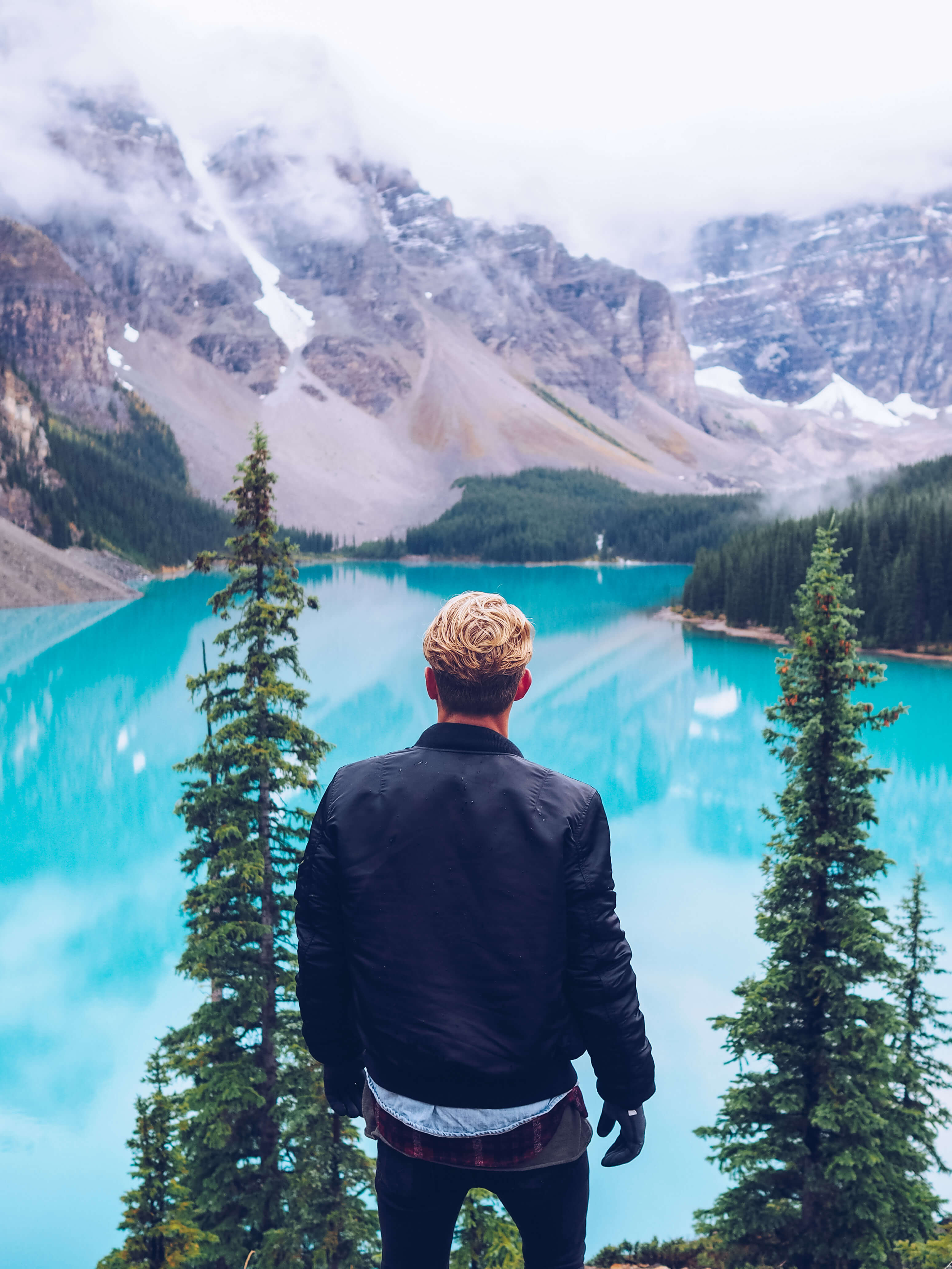
Lake Louise
Lake Louise is one of Canada’s most famous lakes, and it’s known for its vibrant blue colour and beautiful mountain backdrop. If I’m honest, Lake Louise wasn't my favourite place – there were thousands of people which did kill the experience a little. However, it’s an iconic spot so we didn’t want to miss it, but if you do plan to visit I recommend going very early (before 9am). After 10/11am, the parking lot fills up so you have to get a shuttle from Lake Louise village up to the lake. There are many hikes you can do from the lake, and I've heard great things about the Plain of Six Glaciers trail.
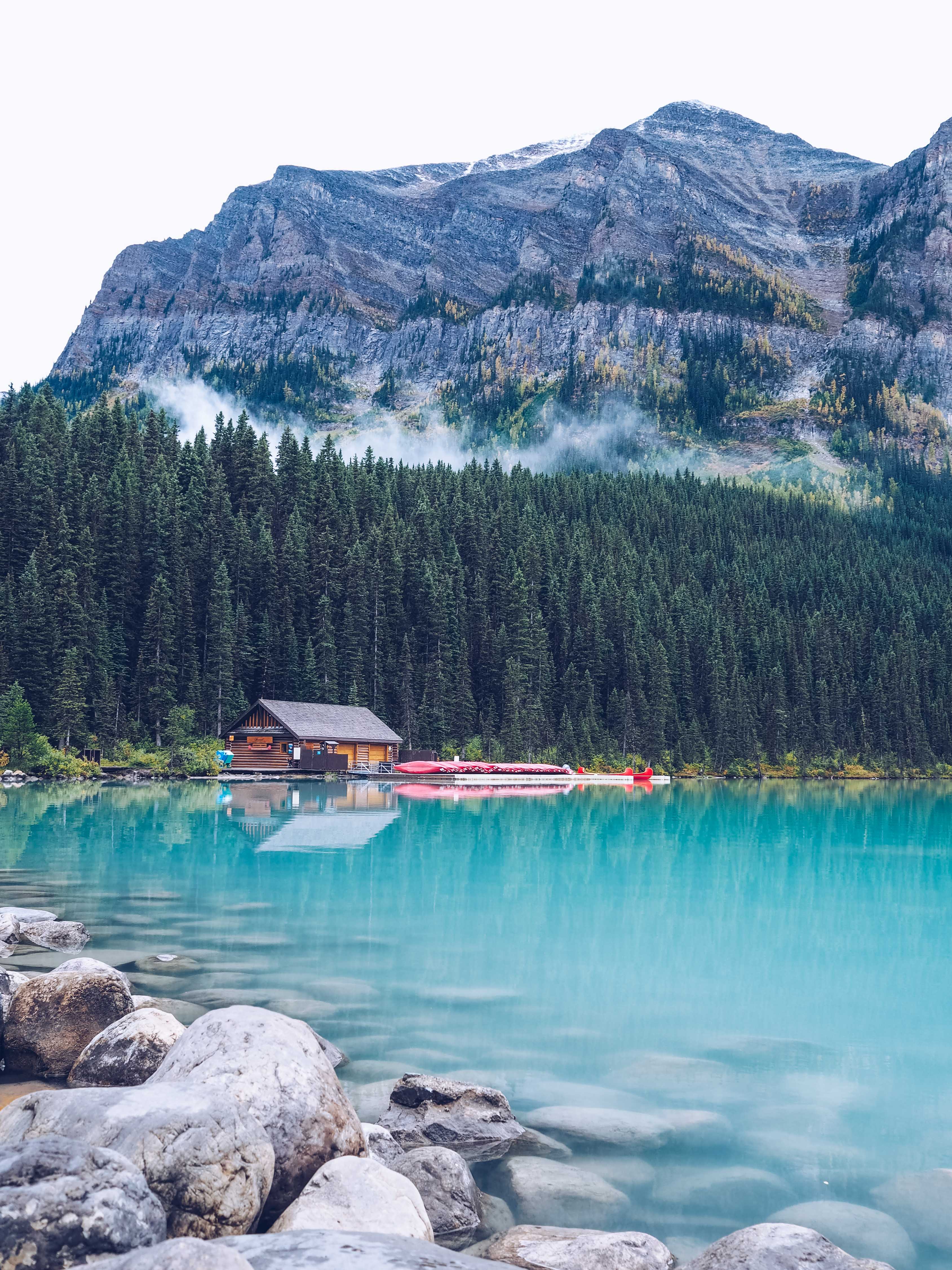
Peyto Lake can be found just off the Icefields Parkway, about 1 hour from Banff. This is one of my favourite places as the view is phenomenal and the lake shines a beautiful turquoise blue. The lookout point is about a 10/15 minute walk from the parking lot but you can hike from here too. It actually snowed when we were here in September which was crazy!
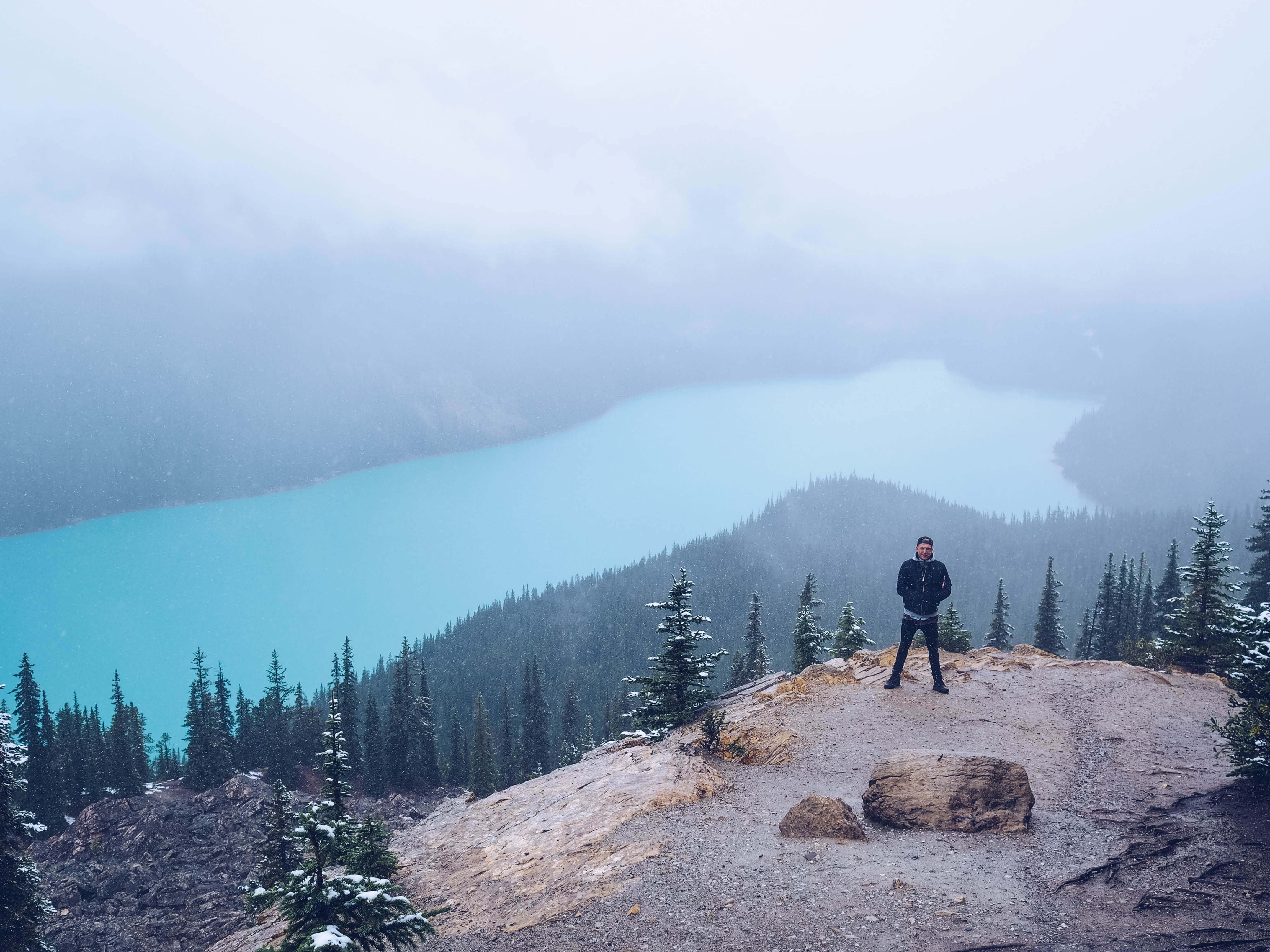
Another great spot on the Icefields Parkway, about 30 minutes from Lake Louise / 1 hour from Banff, is Bow Lake. The views of the lake and the glacier are stunning and it's actually one of my favourite spots to visit in winter/spring when the lake is frozen over . The Bow Glacier Falls hike is supposedly lovely & the Num-Ti-Jah Lodge is a great place to grab a coffee & warm up, and you can stay here too (it's closed in winter though).
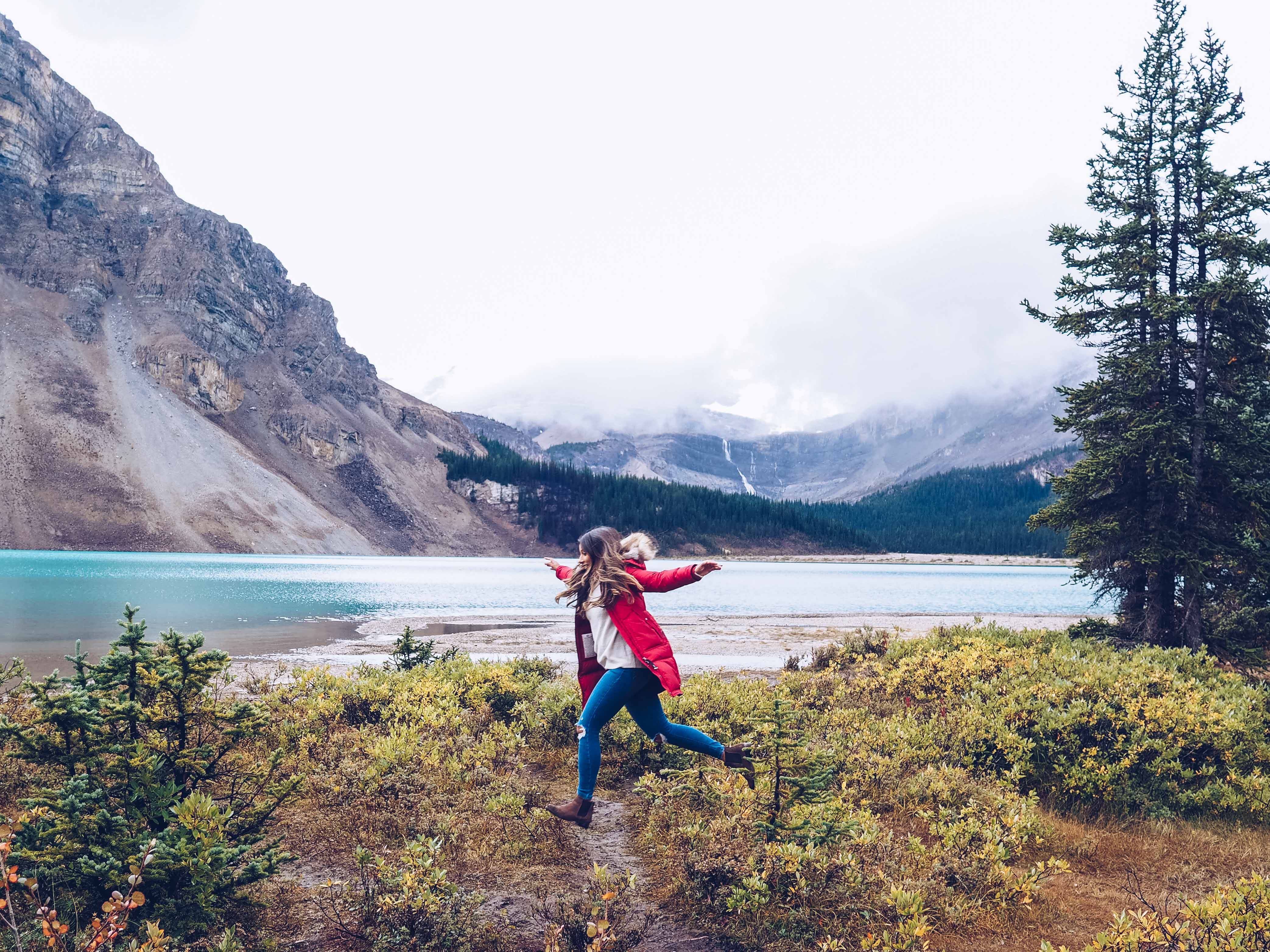
Johnston Canyon & Banff Town
We started day #4 with a sunrise walk around our campsite and then made our way down the Bow Valley Parkway and then on to Banff. The Bow Valley Parkway is one of my favourite roads as it's so picturesque and it's the perfect place to spot wildlife. Bears, elk, moose, deer, and even wolves are often seen along here, so it's a really exciting drive as you don't know what you'll find.
We then headed to Johnston Canyon, where we found some beautiful waterfalls and canyons. It's very well maintained and it was pretty busy, but it's a nice walk and it takes only 45 minutes to get to the Upper Falls. We managed to find the secret rock & cave that i'd seen in a few photos - we had to clamber down some rocks to get to it - but it was gorgeous and very impressive.
The next stop was Banff town and on the way, we made a quick stop off at Lake Minnewanka and Two Jack Lake, which are both really close to the town. We were both absolutely shattered so we grabbed a bit of food at Toque , a really cool Canadian bar/pub, and then settled into the Elk + Avenue Hotel which was in the best location and just a few steps away from all the shops & restaurants in town.
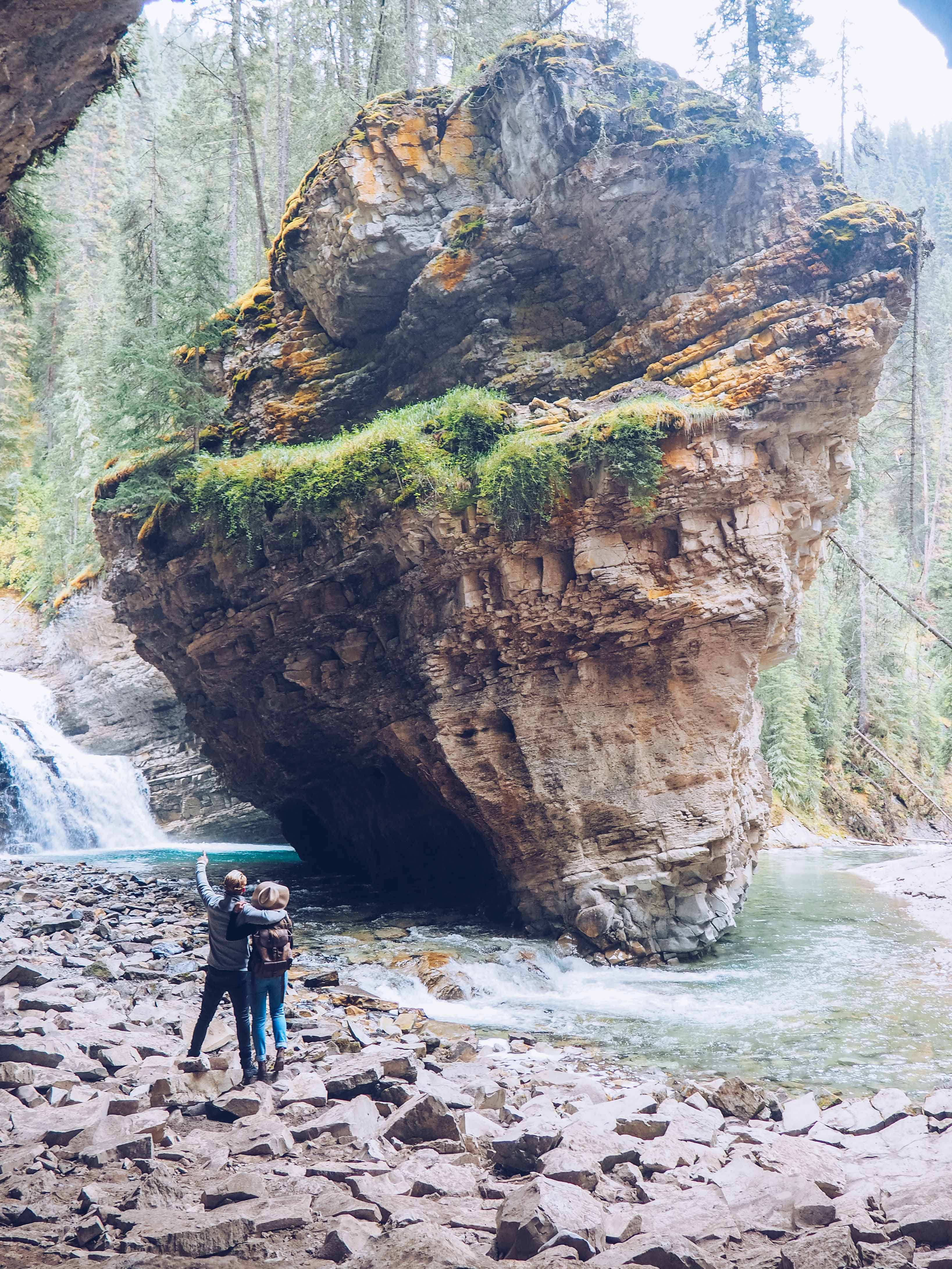
Banff to Jasper & The Icefields Parkway
The road that takes you from Banff to Jasper is one of the most breathtaking drives in the world. The Icefields Parkway stretches 232km and winds along the Continental Divide, taking you past over 100 ancient glaciers and through some of the most stunning valleys you'll ever see. You'll drive by cascading waterfalls, turquoise lakes, forests, and dramatic rock formations, as well as the famous Athabasca Glacier and Columbia Icefield.
This was one of my favourite days, and we were so excited to discover Jasper as it was completely new to us. Jasper town is lovely - it's fairly small, but it's very charming and the vibe is so laid back & relaxed. We stayed at the Wapiti campsite, which I highly recommend. That night we also happened to catch the Northern Lights putting on a show, which was phenomenal and it was the first time we've ever seen the Aurora! It was completely unexpected and lit up the whole sky, and we could see it from the campsite which was even more amazing!!
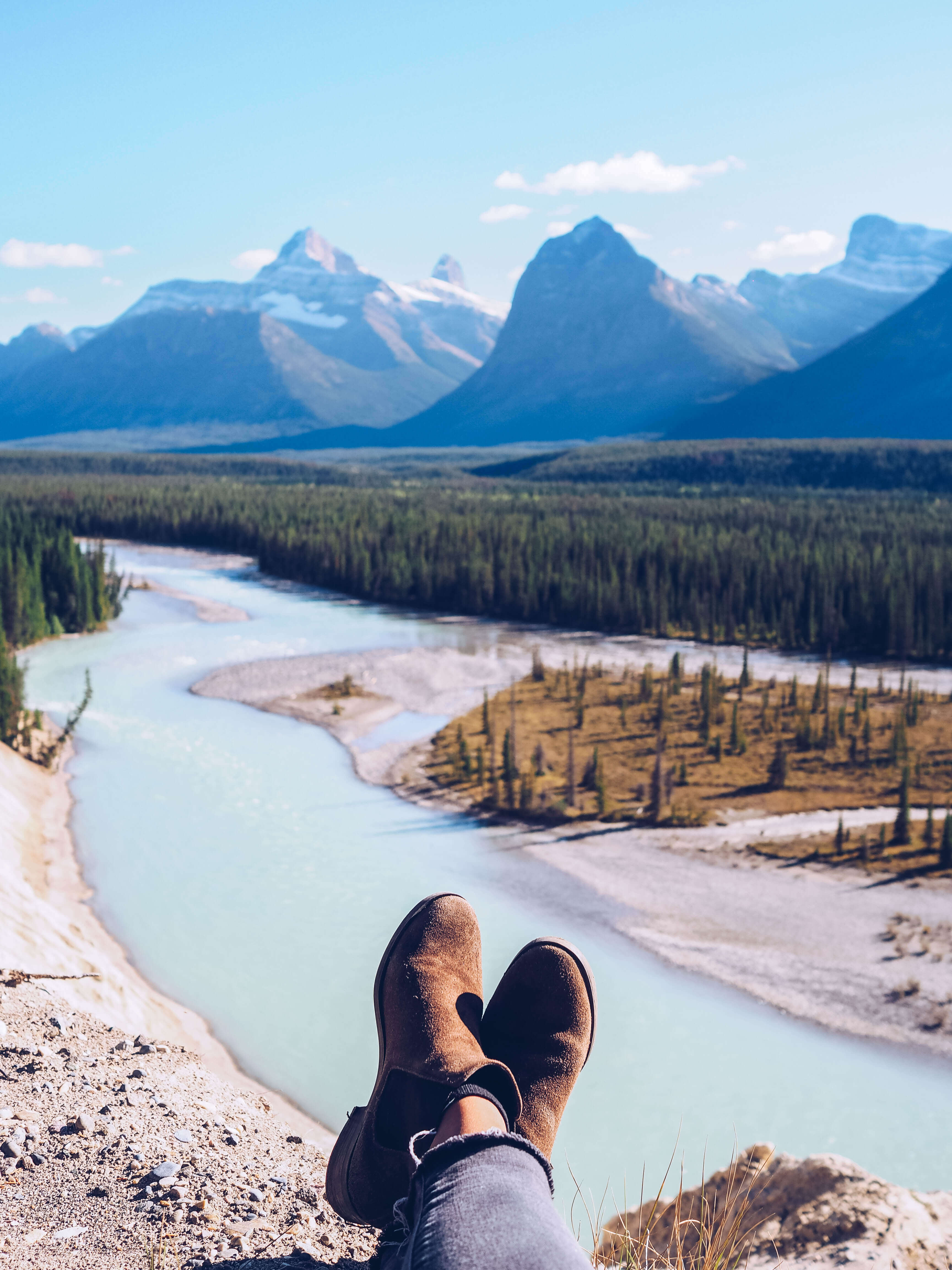
The Athabasca Glacier
If you're travelling up the Icefields Parkway, a visit to the Athabasca Glacier is a must. The Athabasca Glacier is one of the most accessible glaciers in the world and it's one of the toes of the Columbia Icefield. Like many other glaciers, it is retreating by roughly 10-15m per year, and it's thought that in 100 years time it will unfortunately no longer exist. The Glacier Adventure tour with Brewster Travel is awesome as you get to walk on the glacier and you head up in one of the huge Ice Explorers which isn't something you get to do every day! The tour is about 3-hours long and it includes the Glacier Skywalk, and tours run from May to October.
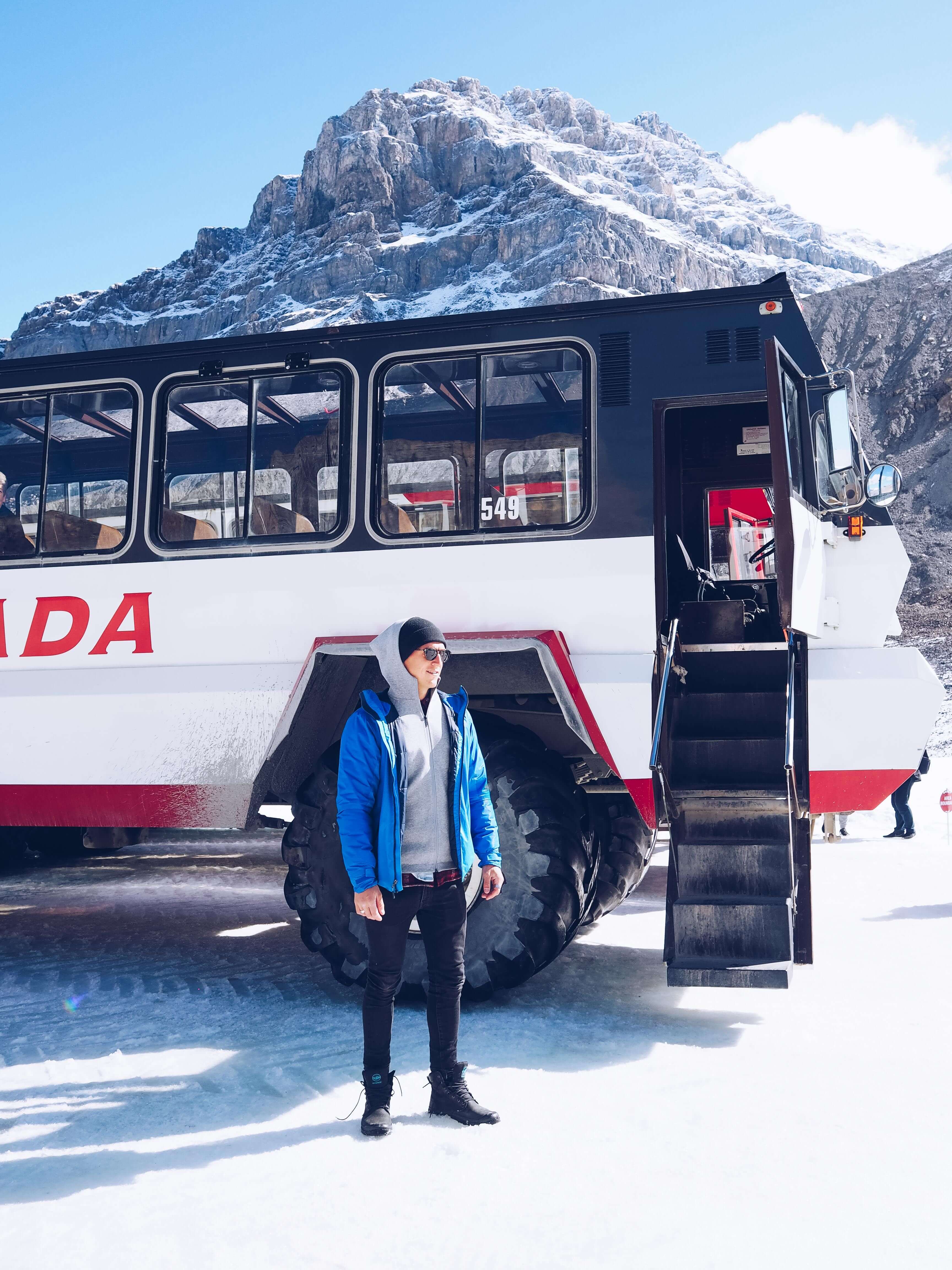
Exploring Jasper & Maligne Lake
We set off early and made our way up to Maligne Lake, which is about 1 hour from Jasper. On the way, we stumbled across a herd of Elk at the side of the road and amazingly managed to catch two young bucks practising rutting. Elk can be pretty dangerous, especially around fall time, so if you come across Elk on your journey make sure to stay in your car & don't get too close!
We grabbed a canoe from the boathouse at Maligne Lake and headed out on the water for a couple of hours. A beautiful mist was rising up from the lake creating the most stunning setting, and as we paddled out further we discovered two Moose grazing on the shoreline which was the coolest experience ever!
The views of the lake are wonderful especially with the surrounding snow-capped mountains, and if we had more time we would have done the Maligne Lake Cruise which takes you to Spirit Island, and everyone we spoke to recommended it. We spent the rest of the day checking out other spots around Jasper, such as Lake Edith and Lake Annette, as well as the Athabasca River which is a great place for spotting Elk.
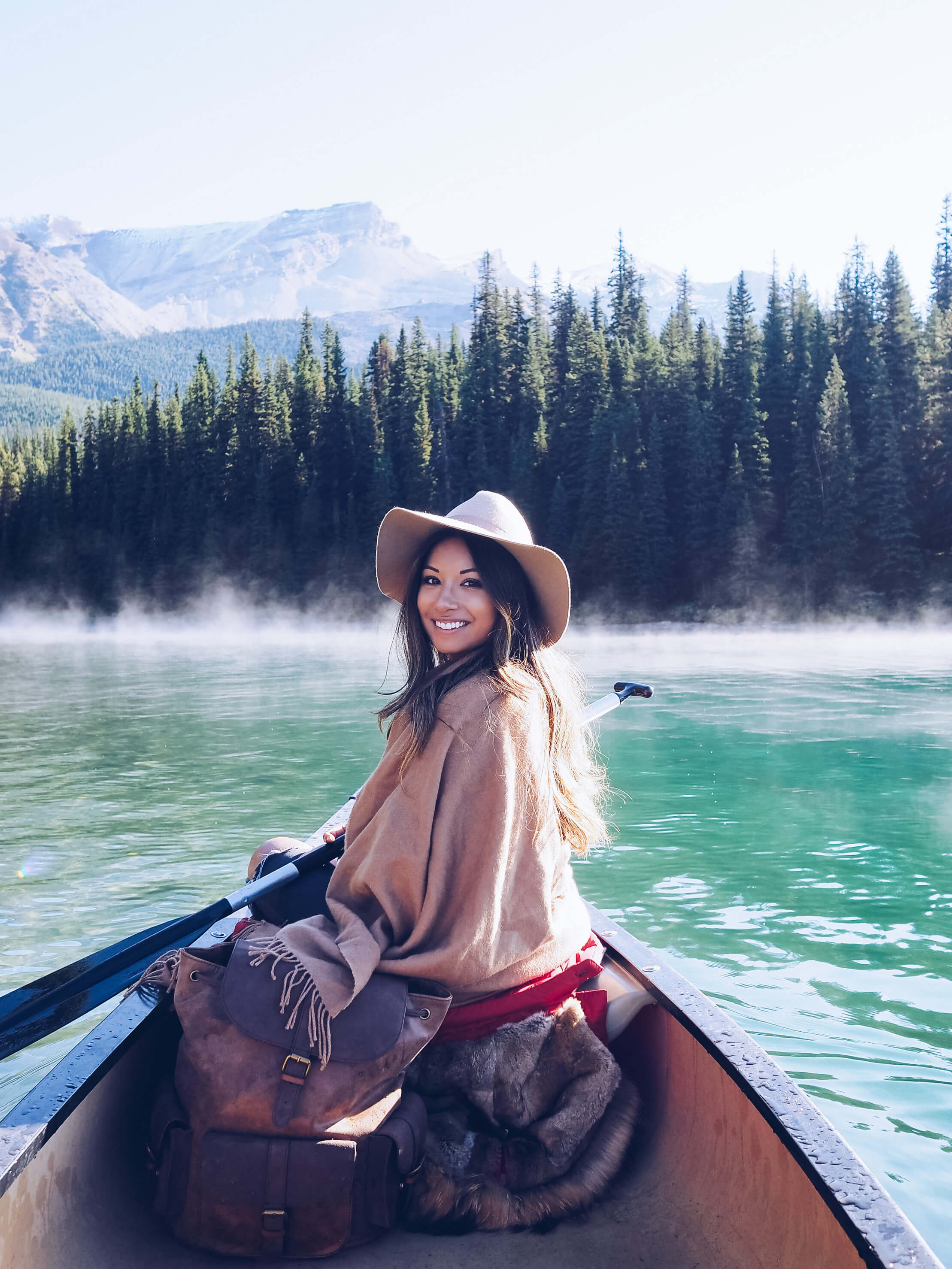
Mount Robson, Wells Gray & the Journey Home
We spent the final day of our road trip making our way back to Vancouver. There aren't tons of places to stop on the way, but Mount Robson is a nice place to check out and grab breakfast (there are some amazing hikes from here, many are quite long), and the view of the mountain peak is stunning. Wells Gray Provincial Park near Clearwater is another awesome stop off, and here you'll find 38 waterfalls to discover. The most well-known are Helmcken Falls, Dawson Falls, and Spahats Falls (which is the closest to the highway). The journey home took 12 hours overall, but with quite a few stops on the way.
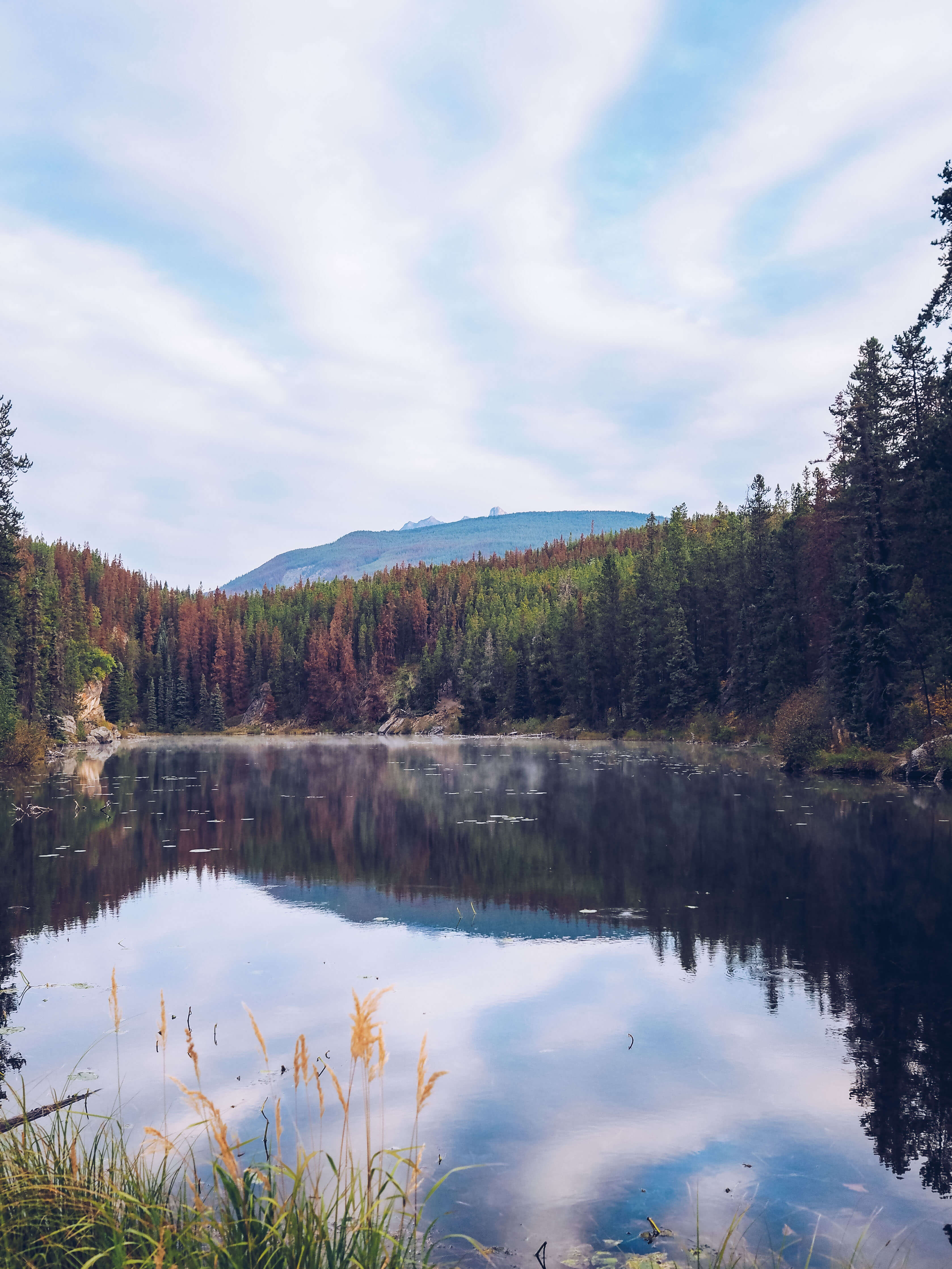
On the road with our Jeep Grand Cherokee Trailhawk
When you're spending hours on the road, you want to travel in something that's both practical and stylish. Our Jeep Grand Cherokee Trailhawk (aka Jujubes!) was the perfect car for this trip and honestly everything I could ask for in a vehicle. It was gorgeous to look at with the white finish and matte black vinyl on the hood, and Ruby Red tow hooks on the front (iconic of the Trailhawk model). The interior felt luxurious, with black Napa leather & suede seats and red stitching around the steering wheel, and the panoramic sunroof was wonderful and ideal for wildlife watching! It also had a plug socket in the back which was such a lifesaver when we were camping and the camera needed charging.
The car was a dream to drive and it's the perfect combination of rugged & tough, and sleek & stylish. The Trailhawk model is designed for comfort in the city as well as serious off-road adventures, and it comes with the Quadra-Drive II four-wheel-drive system so it can handle all terrains (snow, mud, rock, sand, etc) with ease. The car was unbelievably spacious which meant we were able to bring everything we needed - and a little bit more - and features like the Lane Assist (my fave), Blind Spot Detection, Park Assist & the Back-Up Camera made it so easy to drive despite its size.
We got around 700km out of a full tank, and it averaged around 20/mpg, which meant we didn't have to fill up too much during the trip. It was amazingly powerful which was most noticeable when accelerating at higher speeds, it has a very tight turning radius considering its size and I was very impressed by how well it handled. Safe to say we loved every minute of it & I can't recommend it enough!
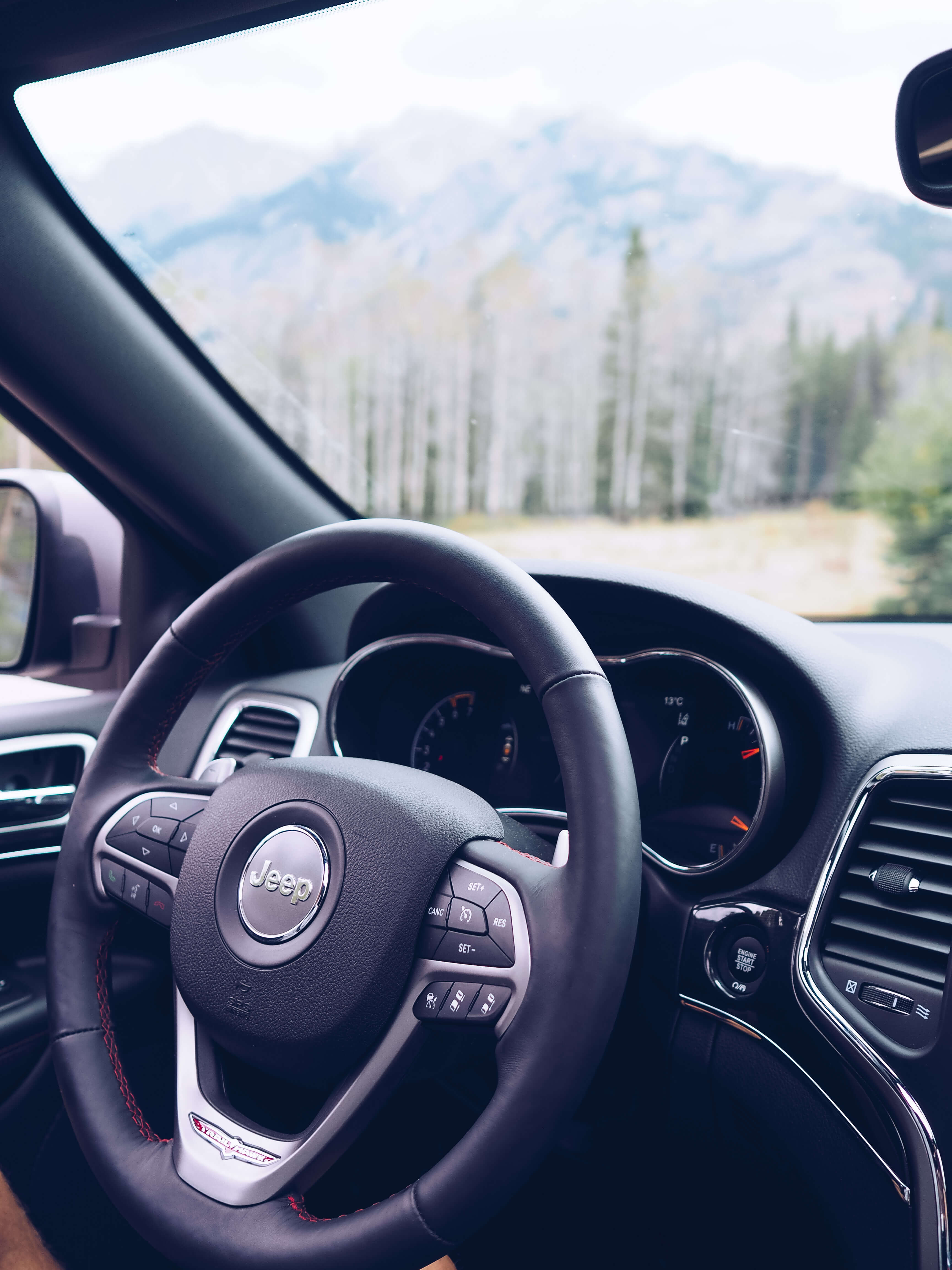
How to get from Vancouver to the Rockies
Road tripping from Vancouver to the Rockies is very straight-forward and there are only a few roads to follow. Remember to check road conditions especially if you're travelling between October and April, and make sure your car is prepared for the weather.
From Vancouver, take Highway 1 (East), and follow the highway to Hope. Then, take Highway 5 (Coquihalla) up to Kamloops, then rejoin Highway 1 (East) & follow all the way to Banff, passing through Revelstoke, Golden, Field on the way. This is the quickest route, but keep in mind that Highway 5 goes over the mountains so is very exposed. In summer it's usually fine, but in winter the conditions can be extreme & very snowy & icy.
If the Coquihalla is closed or really snowy, the alternative is to follow Highway 1 all the way from Hope up to Kamloops. This is the scenic route and it takes a bit longer, but the elevation is lower so the weather doesn't get as extreme. From Kamloops, follow Highway 1 (East) all the way to Banff.
From Banff to Jasper, there's only one road you can take which is the Icefields Parkway, and the journey takes 3.5 hours (288km). The drive from Jasper to Vancouver took us around 12 hours (with stop offs), but it can be done in as little as 9 hours if you go straight. From Jasper, follow Highway 16 West (Yellowhead Highway), and then continue onto Highway 5 towards Kamloops. From there, take either Highway 5 and then Highway 1 (West) to Vancouver, or Highway 1 all the way to Vancouver, depending on weather and time of year.

O verall , our trip was amazing and I'm already planning our next trip back. If you're thinking about road tripping from Vancouver to the Rockies, I really hope you found this useful & if you have any questions about the trip or if you have any recommendations, drop me a comment in the box below as i'd love to hear from you!
11 Comments
Hello! Do you have a packing list anywhere for camping? I’m planning the trip but coming from Los Angeles! Would love to know what you packed for camping, as I am not that experienced in it..
I did a really similar road trip in mid September, I’m moving to Whistler from London in October and would love to re-create your route.
Your photos are stunning, what camera(s) do you use?
Hey Hannah, Ahhh that’s so exciting!! Did you love your road trip last year? And thanks so much – the pics in the post were shot with an Olympus Pen, but now I use the Panasonic Lumix G85 (which is a bit better). Hope the move goes well! xx
Beautiful and helpful post! My boyfriend and I will be road tripping from Portland, OR to Banff in early September this year and I’m beyond excited! How was the weather when you went? Any tips on what to wear?
Hey Brenda, Thank you so much!! 🙂
That’s suuuuper exciting! It’ll probably still be warm, but definitely prepare for all weather. When we went, it was 24 degrees C and sunny on day 1, and -5 degrees and snowy by day 5…and we went in early September. I’d recommend taking layers, that way you can strip down if it’s hot but layer up if the weather changes. Definitely take a winter jacket as the weather can change really quickly and mornings + nights can be cold. Great that you’re driving though then you can take as much stuff as you need. Have the most amazing time, September is the perfect time to visit! XX
Thank you for this post. It was very helpful in planning my own 7 day trip to Banff. Your photos are amazing!
Thanks so much Melanie, glad you like the pics and have found it useful. Have fun planning your trip!!! 🙂
Your pictures are amazing! The colours, especially the turquoise of the water, are so vivid. Thanks for this itinerary and for mentioning the places you stayed and stopped at. I’m in Ontario, but you’ve inspired a desire to check out western Canada! Thanks so much!
This trip looks stunning! Lake Louise has been on my bucketlist for years, and now I’m definitely planning a road trip out there. Thanks for the handy tips!
Oh my goodness, my love. This is quite possibly the most beautiful – and practical – blog post I’ve ever read. The photos are simply stunning. I absolutely love your travel tips – and will definitely be sharing with others! Great job! You’ve made me lust after Alberta lakes again… will definitely need to make a trip out again soon!
http://www.thevancouveriteblog.com
Beautiful photos, Alicia. I’m getting serious wanderlust; I think I’m beginning to sound like a broken record now 😛 I would definitely add that if you’re planning long drives, you have a day spare / spare few hours in case there’s a road closure. On our trip in June, we planned to drive from Golden to Whistler in one day but there was a closure due to a mudslide so we couldn’t go that way at all. Thankfully, we had wiggle room to stay in Hope (though we had more closures on the way there) and then drive to Vancouver early the next morning to catch our ferry.
Leave a Reply Cancel reply
Your email address will not be published. Required fields are marked *
Sign me up for the newsletter!
Notify me of follow-up comments by email.
Notify me of new posts by email.

7 Day road trip to Banff and Jasper from Vancouver
Since we moved to Vancouver last summer I’ve been desperate to take a road trip to Banff and Jasper in the Rocky Mountains. How could you not be when you see how beautiful they are?
We’ve been to Banff several times over the years and have always had fun!
If you live in Vancouver or are visiting Canada and are planning a road trip to Banff and Jasper starting and/or ending in Vancouver then here is an itinerary for a 7-day road trip to the Canadian Rockies.
This Vancouver to Banff and Jasper road trip itinerary is exactly what we did in a week, so you can trust it’s totally doable.
See my road trip packing list essentials!
7 Day road trip to Banff & Jasper from Vancouver
This Banff and Jasper itinerary for a road trip from Vancouver to the Rocky Mountains can be done as a one-way trip or two ways. One of the more popular routes is to go from Vancouver to Banff to Jasper and then Jasper National Park to Vancouver, only we went from Vancouver to Jasper National Park and then on to Banff and Lake Louise.
Our trip from Vancouver to Banff, Jasper & Yoho and back in 8 days. However, if you’re just visiting Canada and are road-tripping from Vancouver to Calgary or Calgary to Vancouver.
This would also work as a 7-day road trip Calgary to Vancouver.
You can definitely make this road trip longer, but I wouldn’t recommend making it shorter. There are some suggestions towards the end of this post on ways to make the road trip longer to 2 or 3 weeks.
Canadian Rockies road trip map to Banff, Jasper and Yoho National Park from Vancouver
Below is a map with the places, hikes and attractions I recommend on this 7-day road trip from Vancouver to the Rocky Mountains. This is far from everything there is to do, but it’s what we did on our road trip to Banff, Jasper and Yoho from Vancouver.
You can skip Jasper and just make it a Vancouver to Banff road trip itinerary instead, but I loved Jasper so I recommend trying to make time for it!

Jasper vs Banff
The great thing about this Canada Rockies road trip itinerary is that you don’t have to make the choice between Banff or Jasper. But, if you’re wondering which one I’d pick then it’d be Jasper hands down.
To be fair to Banff I didn’t get to see it at its best since the whole town was shrouded in forest fire smoke. I mean, I’m sure there are mountains around Banff I just couldn’t see them.
But even without the smoke, Jasper wins as it felt a lot wild and remote and there were fewer people there.
We didn’t have to wake up at 5 am to find a parking spot as we did in Banff and we saw more bears, elk and mountain goats too.
But explore both and decide for yourself!
Best time to visit Canadian Rockies?
This mostly depends on your interests and reasons for visiting the Canadian Rockies in the first place. If you’re there to ski then you’ll want to visit between December – March.
However, if you’re there for hiking and seeing the gorgeous colours of the lakes in the area then you’ll want to plan your Canadian Rockies trip for the summer months (June-August) when the snow is pretty much all gone.
However, summer is often very, very busy. During our trip in August Banff and Lake Louise were pretty much swarming with people.
This makes parking difficult and can take away from the beauty of the top attractions in the Rockies when you’re sharing it with hundreds of people at the same time.
Whilst September is a bit quieter, it snows early in the Rockies sometimes. Some of our friends experienced a lot of snow during their trip in the middle of September so that’s something to bear in mind. Your driving conditions might be more tricky and the weather a lot colder.
Best way to see the Canadian Rockies

The easiest way to travel the Canadian Rockies is by camper van. Not only does this mean you can save a tonne of your accommodation (since you can camp in this and not have to stay in hotels), but it’s just a fun way to travel. I love being able to pull up anywhere in our van, Elvis, and make a cup of tea or enjoy lunch with a view.
If you’re looking to rent a campervan for your Canadian Rockies itinerary then take a look at Escape Campervans . People list their campervans on here and you can rent them for your trip. You can find everything from self-converted homes like our Elvis, to much bigger RVs too!
If you’d prefer to go from Vancouver to Banff by car and stay in hotels or are happy to tent camp then you can hire a smaller car.
I use comparison sites like DiscoverCars and RentalCars to book my car rentals as it’s easy to check prices and compare the best deals!
You can usually pick up and drop off your rental car in different cities. So, if you’re only doing this Canadian Rockies vacation in one direction then make sure to look for that option.
Alternatively, you can get the Via Rail Vancouver to Jasper . This scenic train ride takes you past beautiful scenery and into the Rocky Mountains.
The train from Vancouver to Jasper is not the cheapest and doesn’t always run on time, but it’s a great option if you don’t want to drive.
You can also get the Jasper to Vancouver train if you’ve flown to Calgary and then travelled on to Jasper.
National Park entrance fee
You need to pay for every day you spend in a National Park. You’ll pass a booth upon entering Jasper if you follow this itinerary. If you enter from a different way you can purchase a pass at a visitors’ centre. You must display this on your dashboard at all times.
If you’re spending 7 days in the National Parks and there are 2 or more of you then the best deal is to get the Group Parks Pass for $136.40.
Where to stay in Banff and Jasper
Hotels in Banff and Jasper are EXPENSIVE. Especially during the summer months when let’s face it, is probably when you’re going to want to go since the beautiful aqua lakes are covered under snow in winter and it’s bloody freezing.
I’ve listed a few suggestions for each stage of the journey below for camping, budget, mid-range and luxury options.
Hotels & Hostels in Banff & Jasper
Hostels are your best bet if you’re planning a trip to the Canadian Rockies on a budget.
Even then they’re not the cheapest and I don’t know about you but I don’t really fancy staying in a 28-person dormitory… I guess you’re not going to be spending too much time inside though!
If you do want to stay in hotels while you’re road-tripping through Banff and Jasper then check out Booking.com . They’re my go-to site whenever I’m beginning my hotel search for an upcoming trip.
To find cheaper hostels or hotels in Jasper and Banff, I’d recommend widening your search to include towns outside of the National Parks. This will mean you’re driving more in the morning and evenings but it might help you cut costs a little!
Some suggestions are Golden in BC and Canmore just outside of Banff.
Read more: Banff vs Canmore? Should you stay in Banff or Canmore ?
Camping in Banff and Jasper
Campsites in Banff and Jasper fill up super, super quick. Canadians love to camp and so do many people visiting these National Parks.
If you’re visiting in the summer months (June – August) then make sure you plan your trip about 3 months in advance to secure a camping spot.
You may get lucky and find a camping place at some campsites but usually, everything will be booked already, especially over weekends.
- To book a campsite in BC use the BC Parks Reservation site
- For campsite bookings in National Parks use the Parks Canada Reservation Website
- All bookings in Alberta (outside of national parks boundaries) can be made on the Alberta Parks Reservation Website
Overflow camping in Banff and Jasper
Fortunately, there are other camping options in Banff and Jasper when the campsites are fully booked.
Banff, Jasper and the Ice Fields Parkway have overflow campsites.
They open only when the other campsites are full. At these, you are permitted to sleep inside your vehicle.
These are usually just car parks and so tents are not allowed with the exception of the Snaring Overflow in Jasper.
Take a look at this post for all the camping options in Banff and Jasper National Parks.
Please note: It is illegal to sleep overnight in your vehicle or camp outside of a designated camping spot. You will be asked to move and/or fined if found doing this.
This is for your own safety, the safety of the wildlife and the protection of the parks. You might be responsible and follow Leave No Trace Principles but that doesn’t mean everyone does.
Itinerary for a 7-day road trip to Banff & Jasper from Vancouver
Use this itinerary for your Vancouver to Jasper, Banff to Vancouver road trip. It’s full of the best hikes and things to see so use it to put together your own Vancouver to Banff itinerary. There are posts about each place we visited which include more detail too.
This road trip from Vancouver to Banff and Jasper is a Canadian bucket list item and I’d highly recommend it!
Vancouver to Wells Gray Provincial Park

Whilst you could just go straight from Vancouver to Jasper (or Jasper to Vancouver if you’re coming from Calgary), it’s well worth making a stop at Wells Gray Provincial Park.
Wells Gray Provincial Park has been on my radar for quite a while. It’s known for its waterfalls or which there are 39 named (and plenty that aren’t!). It’s 5,250 square kilometres of alpine wilderness created by volcanoes and carved by glaciers.
We stopped by for just a few hours to check out two of the most well-known waterfalls; Helmecken and Spahats. These are both easy to drive to and require just a short walk from the parking lots.
Directions: From Vancouver take Hwy 1/Trans Canada to Hope and then switch to Route 5 North to Clearwater via Kamloops.
If you’re looking for a Vancouver and Banff itinerary scroll on down!
Where to stay in Wells Gray Provincial Park
- Mid-range; Highly recommended B&B inside Wells Gray
Wells Gray to Jasper

It wouldn’t be a Vancouver to Jasper road trip without this next stop. It’s time to hit your first National Park of the trip: Jasper!
On the journey from Wells Gray to Jasper, you’ll pass the border BC and Alberta and you’ll also need to remember to put your clocks one hour forward.
On the way to Jasper, you’ll also pass through Mt Robson Provincial Park.
We ended up driving through here in the dark so missed out on seeing Mt Robson (BC’s highest peak) but if you’re spending a little longer doing your road trip you might want to spend a day or two here.
Jasper Highlights
There are plenty of hikes and things to see and do in Jasper. I have a full post about everything we did in Jasper National Park and a few more additional suggestions here.
However, these are my top three suggestions for things to do on a road trip to Jasper.
Read about more of the best things to do in Jasper National Park
Pyramid Lake

We loved Pyramid Lake and the backdrop of Pyramid Mountain. Go here early in the morning and take a stroll, hire a canoe or kayak if you plan to stay longer.
The Miette Hot Springs
The Miette Hot Springs are a little bit more like a swimming pool than these hot springs in BC but they’re a great place to relax after a busy day of exploring.
I’d recommend getting there mid-afternoon as by late afternoon/early evening there was a queue outside to get in.
There are two hot pools and then a couple of cold pools too. Towels and swimsuits can be rented there.
Canoeing/Kayaking on Maligne Lake

Maligne Lake is pretty famous. There’s plenty of hiking to be done around the lake or you can hire a canoe or kayak and explore from the water.
If you’re really keen then plan a multi-day kayaking trip down to Spirit Island and back. Just bear in mind you’ll have to book this campsite about 3 months in advance.
Where to stay in Jasper
Check out my full guide to the best places to stay in Jasper.
- Best budget accommodation in Jasper: HI Hostel Downtown Jasper
- Best hotel in Jasper: Whistler’s Inn
- Best luxury accommodations in Jasper National Park: Pyramid Lake Resort
- Best place for camping in Jasper: Snaring Campground, Jasper
- Best cabins in Jasper: Miette Mountain Cabin
Jasper to Icefields Parkway

Getting from Jasper to Banff means driving the incredible Icefields Parkway. The Jasper to Banff drive along the Icefields Parkway has to be one of the most scenic drives in the world.
Honestly, it’s so, so beautiful. You’re flanked by mountains on either side, lakes, glaciers and forests. Take your time and don’t rush this drive.
The distance from Banff to Jasper is 288km. The Jasper to Banff driving time is around 3.5 hours if you do it in one go, but you’ll want to stop and take in the sights so I recommend taking at least two days to explore the Icefields Parkway.
It’s slightly shorter from Jasper to Lake Louise (232km) which is the next town you’ll come to. Take your time and enjoy the stretch of road between Jasper and Lake Louise.
There are a lot of places to stop along the way but here are my three highlights for your Icefields Parkway road trip.
Top things to do on the Icefields Parkway
There’s more to do than you first realise along the Icefields Parkway. From hiking to beautiful sites and learning about the glaciers, below are a few highlights!
Get the low-down on the best places to stop on the Icefields Parkway
The Athabasca Glacier
The Athabasca Glacier is probably something you’ve heard about before your road trip to Banff and Jasper . This massive glacier is still easy to see although it’s receded a lot over the years. Thom visited around 10 years ago and says there’s a noticeable difference.
Book a trip to get up close with the glacier here.

Chances are you’ve seen plenty of photos of this lake. And yes, it really is that blue! The car park is always super busy here but you should be able to find a space somewhere.
From there is just a quick 10-minute walk on a gentle incline until you get to the viewing point for the lake.
Athabasca Falls
There are many waterfalls in Banff, Jasper and Yoho National Parks but the Athabasca Falls are up there with the most impressive.
Where to stay along the Icefields Parkway
There isn’t a whole lot of accommodation choice along the Icefields Parkway which is why camping, or hiring a camper van is such a good idea. However, I’ve picked out some of the best hotels between Banff and Jasper below that should help if you’re looking for where to stay between Banff and Jasper.
- Camping: The overflow car park at the Icefields Centre. It’s just a car park but you’re allowed to overnight here in your vehicle and there are incredible views!
- Hotels: Sunwapta Falls Rocky Mountain Lodge | Glacier View Inn | The Crossing Resort
Lake Louise

The Icefields Parkway finishes up in Lake Louise which was incredibly busy when we visited in early August. As the woman at the tourism office said it’s the place that’s on all the brochures for The Rockies and it’s a popular entrance point to Banff. It’s also an easy, though long, drive from both Vancouver to Lake Louise, and Calgary to Lake Louise.
If you’re visiting in the summer there are a few things you’ll need to know to make sure you have an enjoyable experience despite the insane amount of people and traffic. Take a look at this post to find out.
Despite how busy it is, the surrounding areas and the lake of Lake Louise can’t be missed.
Lake Louise to Banff then Yoho or Lake Louise and Yoho to Banff?
You’ll notice that Yoho National Park and Lake Louise are super close to each other (about 10-minute drive). Yoho National Park is in British Columbia and Lake Louise forms part of Banff in Alberta.
It’s up to you whether you decide to spend longer in Lake Louise and combine the below suggestions with those later on in this post with Yoho.
We crossed the border during our first day in Lake Louise to do a hike in Yoho. Then we spent a day exploring Yoho on our way back to Vancouver after we’d been to Banff. The choice is yours!
Best things to do in Lake Louise
I’ve picked out the top few things you absolutely can’t miss in Lake Louise.
For more things to do in Lake Louise & Banff take a look here.
Visit Moraine Lake

Despite the fact we had to wake up at 5.30am in order to get a parking space at Moraine Lake (and before they close the road to all traffic other than the shuttle bus), Moraine Lake was totally worth it. These days, you’ll have to get there even earlier!
The light at sunrise catches the top of the mountains and reflects in the water which is very pretty.
But perhaps the best thing about this was watching some guy try and cross the log pile too fast and fall splat on his face several times. He was fine but it was funny.
Take your time and realise that the reason there is a queue to cross over is that there are definitely easier logs to cross than others!
As of 2023, you can no longer drive to Moraine Lake . The only way to get to Moraine Lake for sunrise is to either take an expensive taxi, cycle the 25km round trip OR ride with the Moraine Lake Bus Company .
The Moraine Lake Bus Company is the only company offering sunrise shuttles to Moraine Lake. Prices start at $35 per adult and $25 per child and the shuttles run from 4 am (arriving at Moraine Lake at 4.35 am) to 6.20 pm.
If you want to see Moraine Lake at sunrise, this is definitely the most affordable way!
Book your tickets to Moraine Lake here.
Parks Canada also offer shuttle buses to Moraine Lake, but these don’t start until 6.30 am and so miss the sunrise.
See Lake Louise
Lake Louise is another gorgeous Lake that is flanked by the Fairmont Hotel and mountains. You can take a canoe out on the lake or just admire it from the shorelines.
If you’re visiting in summer be aware that the parking lot is usually full by 8 am.
Do some hikes around Lake Louise
Personally, I think the best way to see Lake Louise is to get up high! There are many popular hikes in this area with the busiest being the hike to the Agnes Lake Tea House.
If you do this hike then do it early! Not only will you avoid all the crowds on the trail but you’re also more likely to get a seat at the Tea House.
From here there are ways to extend your hike. You could take the Plain of the 6 Glaciers, climb up to Little and Big Beehive, or do a scramble to the top of Devil’s Thumb which is what we opted for.
Here are 14 of the best hikes to do in and around Lake Louise
Where to stay in Lake Louise
- Camping: There’s an overflow car park where you can camp in your vehicle just outside of Lake Louise. It’s also the overflow car park for during the day when the lakes and town are full. If you’re organised, then book in advance here.
Lake Louise to Banff

Continue your Canadian Rockies tour from Vancouver by making the shortish drive from Lake Louise to Banff. There are two drives you can take down to Banff, there’s the TransCanada highway, or the more picturesque Bow Valley Parkway.
I’d recommend doing the Bow Valley Parkway at least one way. Even though it was super smokey in Banff when we visited and we pretty much couldn’t see anything, it’s just a nicer, calmer road to drive.
The Bow Valley Parkway is closed from March 1st to June 25th between 8 p.m. and 8 a.m . This is to ensure the area remains a safe and good environment for the wildlife there.
Top 3 for your Banff itinerary
Here are the top three things to do in Banff during your Banff and Vancouver trip. We didn’t end up doing the cable car ride due to the smoke, but the lakes and Johnston Canyon were beautiful despite the smoke and crowds!
You’ll see you’ll have a great holiday even if only doing the road trip from Vancouver to Banff and back.
Read this post for more things to do in Banff National Park!
Visit Johnston Canyon
This canyon was absolutely packed when we visited. I’ve never had to queue up for 20 minutes to get a glimpse of a waterfall (and I hope I never have to again).
If you want to visit the canyon then be prepared for it to be super busy, or go early or late to get fewer crowds.
Having said that the canyon is a pretty area and the lower Banff falls , in particular, were a great colour.
Visit the lakes

There are plenty of lakes in Banff. They might not be the same aqua blue as Lake Louise or Peyto Lake, but they’re pretty nonetheless. We spent a relaxing few hours on the shores of Lake Minnewanka and took the kayaks out on Two Jack Lake.
Take the Banff Gondola

This is something we didn’t do on our first visit to Banff since the mountains were covered in smoke and there wouldn’t have been a view.
However, when we did return, we rode up the gondola and got to enjoy the beautiful views up on Sulphur Mountain. I highly recommend adding the gondola, and these Banff activities , to your list of things to do in Banff!
You can book Banff sightseeing tickets incl. the gondola here.
Where to stay in Banff
- Camping: Banff has some massive campsites. We got lucky and got a spot at Tunnel Mountain Village I just a week before our trip. I’m assuming this was because someone else had cancelled. The campsite is huge but your spot will still feel relatively private which is nice. Book all Banff campsites here .
Banff National Park to Yoho National Park

While you could go straight back from Banff to Vancouver, doing so means you miss out on the beautiful Yoho National Park.
For me, Yoho National Park was up there with Jasper for my favourite part of our week road trip in the Canadian Rockies. It’s definitely somewhere I’m planning to visit again.
It’s not a huge park but it’s full of peaks to tackle (we managed to tick off one!); 28 of them are over 3,000 metres in height!
Best things to do in Yoho National Park
Check out this longer list of the best things to do in Yoho National Park.
Takakkaw Falls

Takakkaw Falls is about 15km off the main road in Yoho National Park. Its highest point is 380 metres which makes it the 2nd tallest waterfall in Canada. You can follow the path near the base of the waterfall and enjoy a cooling spray too.
Climb Paget Peak
This was the hike we did after we arrived in Lake Louise and found out there wasn’t hope in hell of getting a parking spot for the rest of the day.
So off we drove to Yoho (about 15 minutes) and took on Paget Peak!
There’s a fire lookout about 1 hour into this hike but the real fun comes from when you tackle scramble to the peak. Don’t be fooled by the false peak, you’ll be climbing for at least 1.5 hours more from the fire outlook!
Emerald Lake

Another insta-famous spot in the Canadian Rockies is Emerald Lake. Again, this is a super busy spot but if you go for a walk around the lake then you’ll escape most of the crowds.
Where to stay in Yoho
Accommodation in Yoho is pretty scarce. Given that it’s so close to Lake Louise you might want to base yourself there or in Golden.
Yoho National Park to Vancouver
Upon leaving Yoho National Park it’s a pretty long drive back to Vancouver (about 8 hours). You just take the BC-5 S and Trans-Canada Hwy/BC-1 W all the way back!
If you’re looking for a way to break up the journey take a look below. This also works if you’re doing a Vancouver to Banff drive, or Banff to Vancouver and skipping Yoho (which I don’t think you should do!).
Where to stop between Yoho National Park and Vancouver

Golden is one of my favourite BC Mountain Towns . It’s got such a chilled-out vibe, great places to eat and it’s surrounded by such beautiful scenery.
It’s a great place to stay too if you’re looking for somewhere cheaper to stay near Banff or Yoho.
Glacier National Park
You’ll pass through Glacier National Park on the drive home. Again, we couldn’t see much on our first visit due to smoke but having returned, I can confirm it’s beautiful!
It has deep valleys, ancient forests and alpine meadows to explore.
Check out the Giant Cedars Boardwalk and Rogers Pass!
Mt. Revelstoke National Park
We’ve been through Revelstoke many a time now both in the winter and the summer. Nearby is Mt Revelstoke National Park which is incredible!
Mount Revelstoke is the only mountain in the national park system that you can summit just a short walk from your car! That’s an easy peak to bag!
Kamloops is great for outdoor lovers. There are trails for every level and the same goes for mountain biking.
If you fancy some lake time then head to one of the lakes nearby and enjoy swimming, kayaking, SUP boarding, waterskiing, or wakeboarding and some of the pretty Kamloops waterfalls.
For more details on the Vancouver to Kamloops drive, I’ve got a full road trip itinerary.
Hope, Chilliwack & The Fraser Valley
The Fraser Valley is a great place to stop either on the way to the Canadian Rockies or the way back. I’ve visited various places there over the year and a bit we’ve lived in Vancouver. I’d recommend checking out Chilliwack Lake and some of the breweries in Chilliwack, Jones Lake if you have a 4×4, and Bridal Veil Falls just east of Chilliwack.
Final thoughts on the drive from Vancouver to Banff
This Banff Vancouver road trip guide includes everything you need to know to plan a road trip Vancouver to Banff or the other way around.
This is one of the quintessential BC road trips with others being BC Hot Springs Circle Route in the east of the province, the Vancouver to Whistler drive on the Sea to Sky, and the Kamloops to Whistler stops via hwy 99.
Last Updated on June 21, 2023 by Hannah
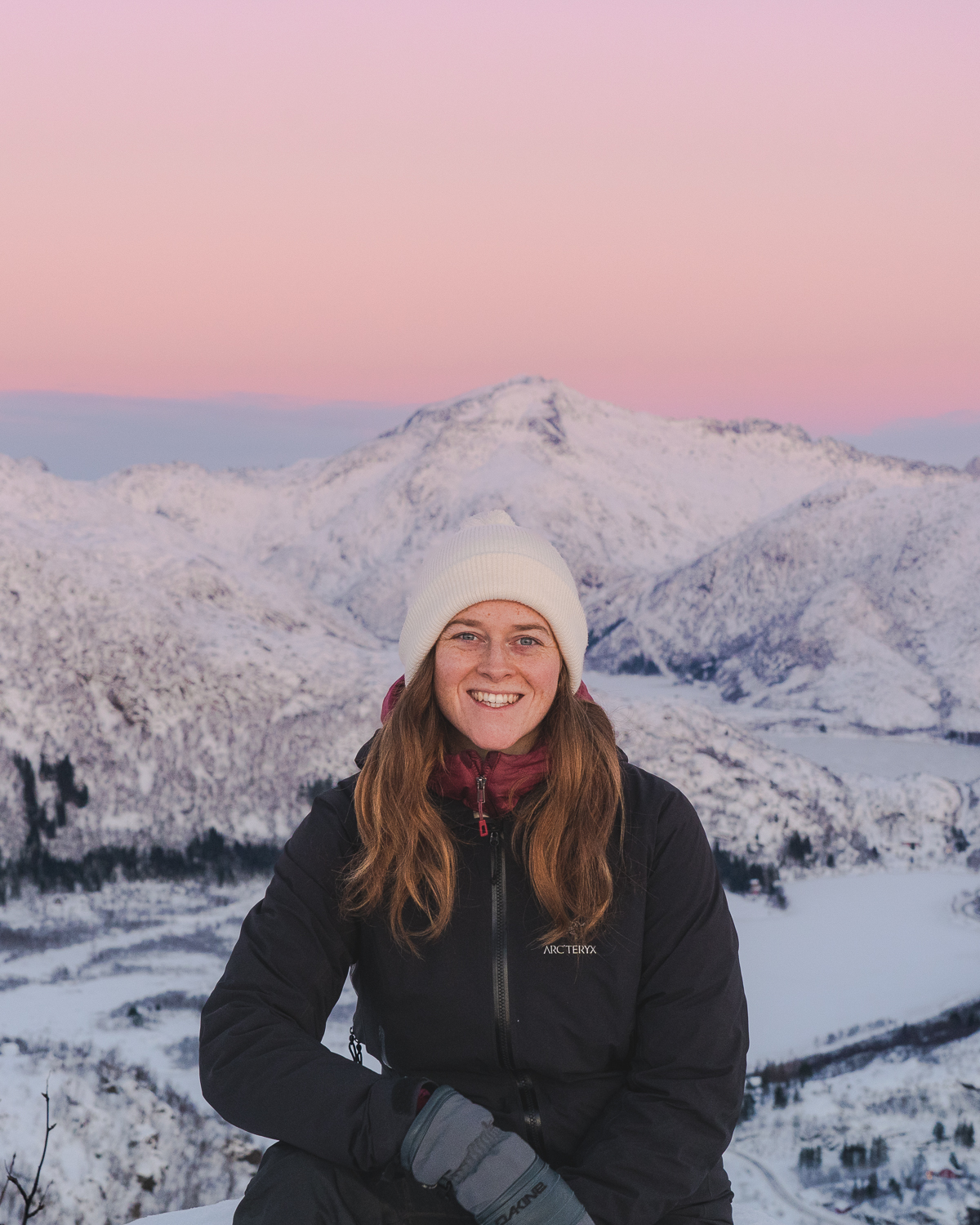
Hannah started That Adventurer after graduating back in 2013 and has documented all of her adventures since then. From backpacking South America to city breaks in Europe , a 3 month road trip across the USA in a self-converted van and 6 years living in Canada , you’ll find posts on all of this.
Hannah specialises in active travel and on That Adventurer you’ll find hiking, walking, biking, skiing and all sorts of active travel guides to allow you to see a destination in an adventurous way.
Now back in Europe, you’ll find new guides as Hannah and her husband spend the next year ‘digital nomading’ from Norway to Portugal, Switzerland to Scotland and places in between.
Leave a comment Cancel reply
You must be logged in to post a comment.
Want travel inspiration sent straight to your inbox?
By clicking ‘Sign Up,’ I acknowledge that I have read and agree to Hachette Book Group’s Privacy Policy and Terms of Use
Site Preferences
Sign up for our newsletter to get 15% off sitewide!
Vancouver & the Canadian Rockies Road Trip Planner
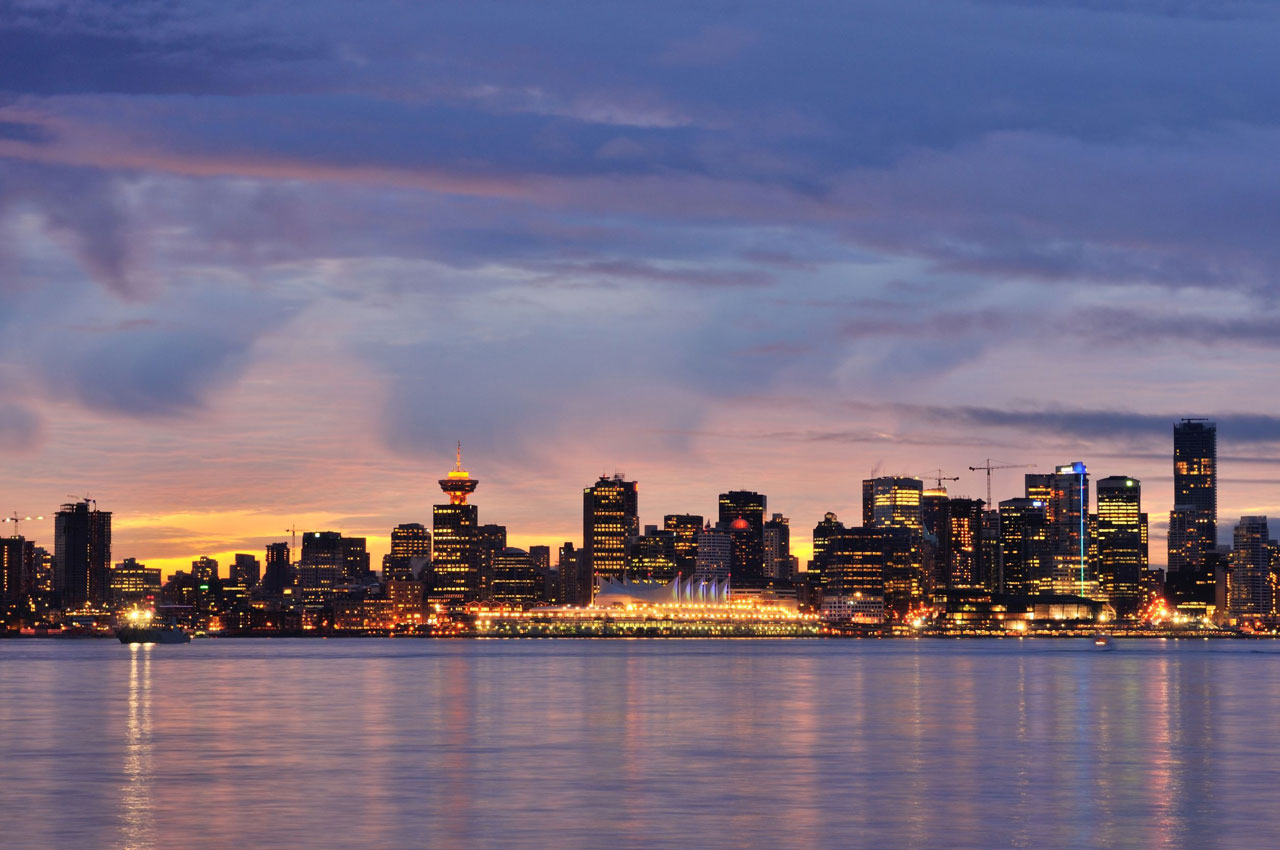
Snowy peaks, rushing rivers, and vineyard-lined valleys. Elaborate totem poles rising from the rainforest. Waterfront cities buzzing with outdoor cafés. Whales breaching and seals sunning just offshore. Clichés? Perhaps. But in Canada’s most naturally spectacular region, these clichés are true. Stretching from Vancouver to the Rockies, western Canada is tailor-made for a road trip.
In Vancouver, an active city bordering the mountains and the sea, begin your trip by strolling or cycling through a 1,000-acre (400-hectare) rainforest park and exploring diverse cultures, from the original aboriginal inhabitants to modern-day communities that reflect the city’s position on the Pacific Rim.
A 90-minute ferry ride across the Strait of Georgia, Victoria retains its British roots even as it has morphed into a contemporary city. It’s now known as much for its locally produced wine, beer, and spirits as for its tradition of afternoon tea. Beyond Victoria, opportunities abound for exploring Vancouver Island’s forests, waterways, and dramatic coastal regions.
Back on the mainland, the Sea-to-Sky Highway is one of Canada’s most beautiful short drives, winding along the coast between Vancouver and Whistler. North America’s largest winter sports mecca, Whistler is nearly as busy in spring, summer, and fall, with hikers, cyclists, and other adventurers exploring the peaks and lakes.
Travel east from Vancouver to the sunny Okanagan Valley, with its string of freshwater lakes, orchards, and Canada’s only desert—and more than 200 wineries lining its back roads.
Newsletter Signup
From the Okanagan, head to the Rocky Mountains. The Trans-Canada Highway passes through several of British Columbia’s mountain national parks, including Mount Revelstoke, Glacier, Yoho, and Kootenay, each more dramatic than the last.
Just across the provincial border in Alberta are the marquee destinations of any western Canada road trip: Banff, Lake Louise, and Jasper. The region’s best scenic drive takes you along the Icefields Parkway, with its incredibly blue lakes and the largest area of glacial ice in the Canadian Rockies.
Once you’ve had your fill of hiking, rafting, and savoring the mountain vistas, continue on to the gateway city of Calgary, which not only hosts Canada’s biggest annual cowboy party but also offers distinctive museums and a pretty riverfront promenade. Or follow the southern route back toward Vancouver, exploring the Kootenays’ funky mountain towns and detouring along B.C.’s Hot Springs Highway.
From the ocean to the mountains, there’s plenty to experience, taste, and enjoy. Let’s hit the road.
High season in Vancouver and the Canadian Rockies runs from May through October, when most attractions and roads are open and the weather is generally warm and sunny. July and August are the region’s peak travel months, with the sunny, temperate conditions balancing out the big crowds and high prices.
Ask the locals about the best time to visit the Canadian Rockies, though, and everyone will say September. The summer crowds begin to abate, the weather is still mild, and the trees take on their fall colors. Temperatures can remain pleasant into October, though the nights get colder, and snow frequently begins in late October or early November.
While the long days and fewer tourists make May and June a reasonable alternative for a Rockies trip, prepare for more rain than in the summer. You might have occasional damp days on the coast, but the Rockies can be hit with a “June monsoon” when the rain turns heavy. These showers bring spring flowers, so pack a raincoat and get outdoors anyway.
Winter is mild in Vancouver and Victoria; rain is common from November through March, but snow is unusual. As soon as you rise above coastal elevations, winter travelers should prepare for heavy snow. It snows a lot in the mountains of B.C. and in the Canadian Rockies, when severe weather can close highway mountain passes. Always check the forecast before you hit the road.
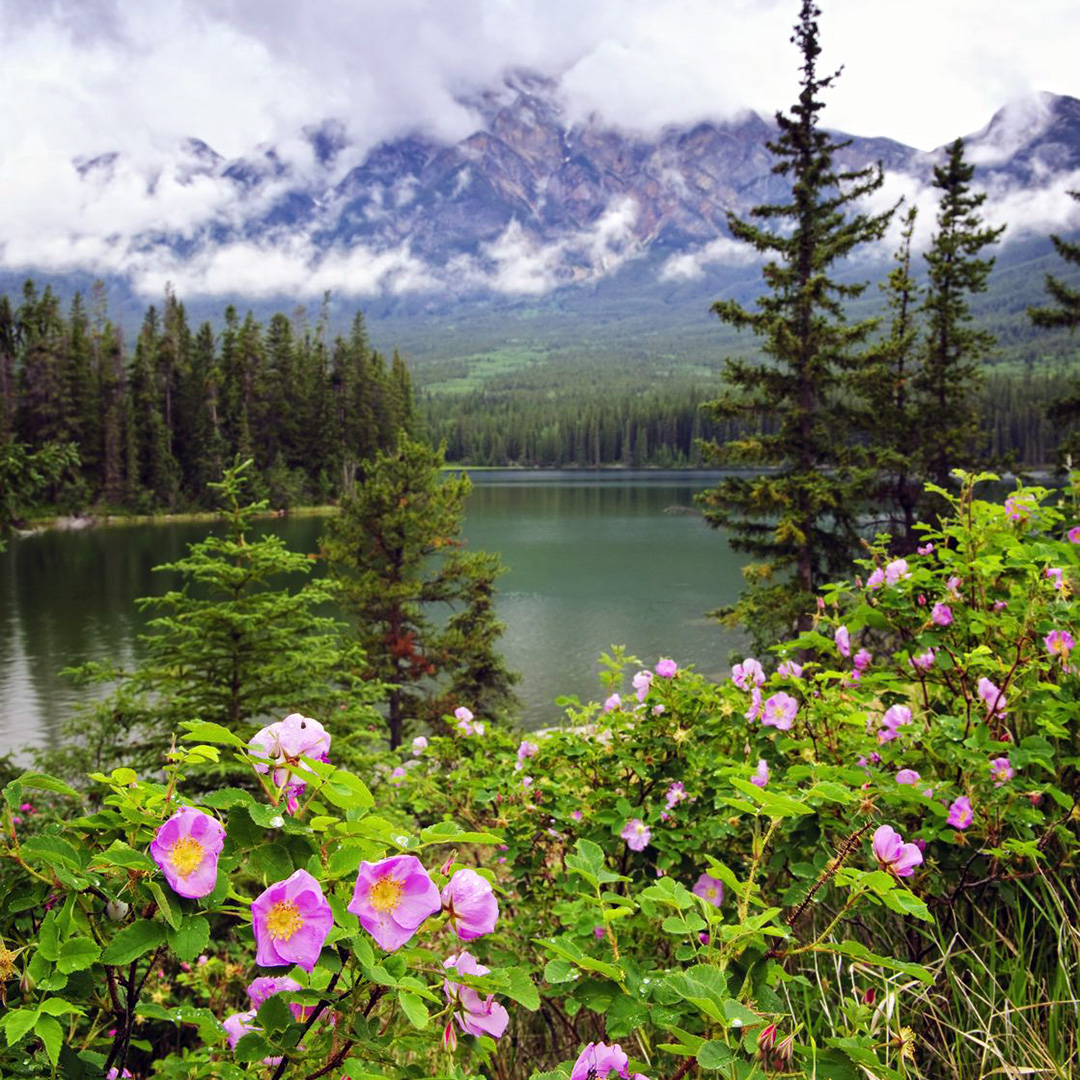
Before You Go
If you’re traveling in the summer, particularly in July and August, consider booking your hotel reservations in advance. Many of the national park campgrounds fill up early, so reserving a campsite for summer or holiday travel is also a smart idea. Car reservations are recommended on B.C. Ferries in the summer as well.
Visitors to Yoho National Park should note that two park activities require advance reservations and careful attention to the reservations procedure and deadlines: visiting Lake O’Hara and touring the Burgess Shale fossil beds. Refer to the Yoho National Park section in Moon Vancouver and Canadian Rockies Road Trip for specifics.
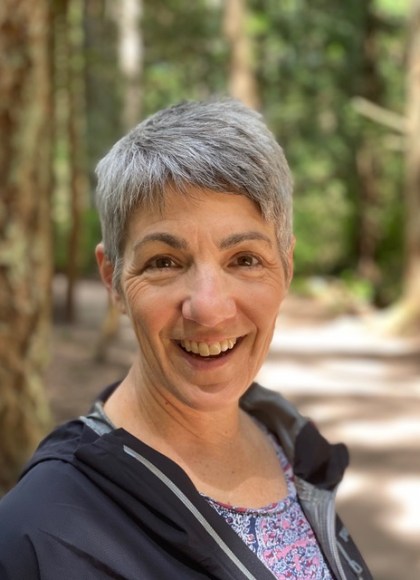
Carolyn B. Heller
About the author.
Learn more about this author
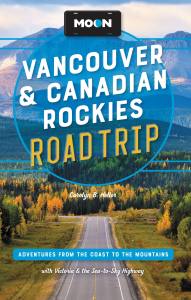
Moon Vancouver & Canadian Rockies Road Trip
by Carolyn B. Heller
- ebook (Revised)
Also available from:
- Barnes & Noble
- Books-A-Million
Pin for Later
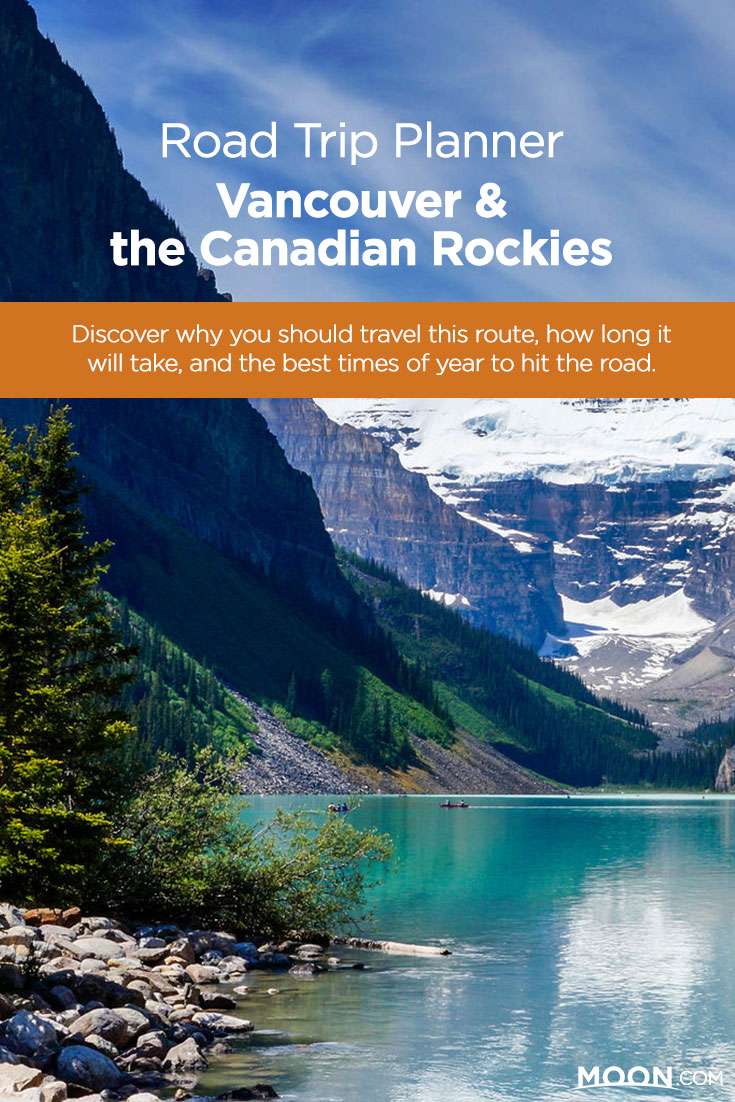
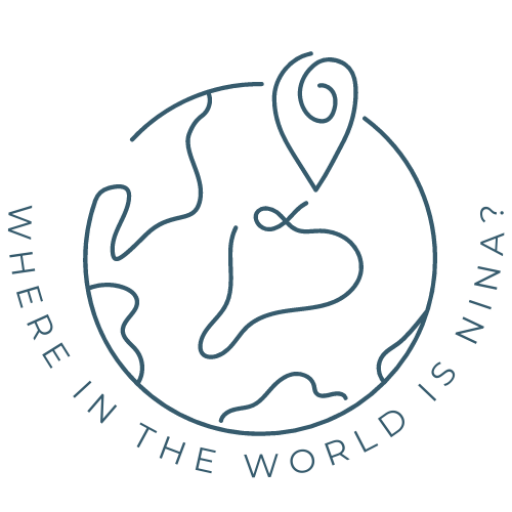
Canadian Rockies Road Trip—An Epic 1-Week Itinerary
Pin this post for later!
This Canadian Rockies itinerary is authored by Maya.
Snow-capped mountain peaks, gorgeous turquoise lakes, valleys filled with glaciers as far as you can see, and an occasional bear or mountain goat sighting.
Does that sound enticing enough?
I’m stoked you’re on board! This guide will show you all the fantastic places you can see during a Canadian Rockies road trip in just one week.
Included are highlights and insider tips from Banff, Jasper, and Yoho National Parks. Of course, you can spend more time in each of these parks, but why not make the most of your trip if you come for a week.
You’ll have your mind blown with the Canadian Rockies’ scenery.
To enjoy the stunning colour of the lakes, I recommend visiting from July to September, September being the less busy time.
Let’s jump right in!
Table of Contents
Canadian Rockies Road Trip Itinerary
Things to do:, what's it like living and working in canada, 15+ best vancouver day trips and adventures (canada).
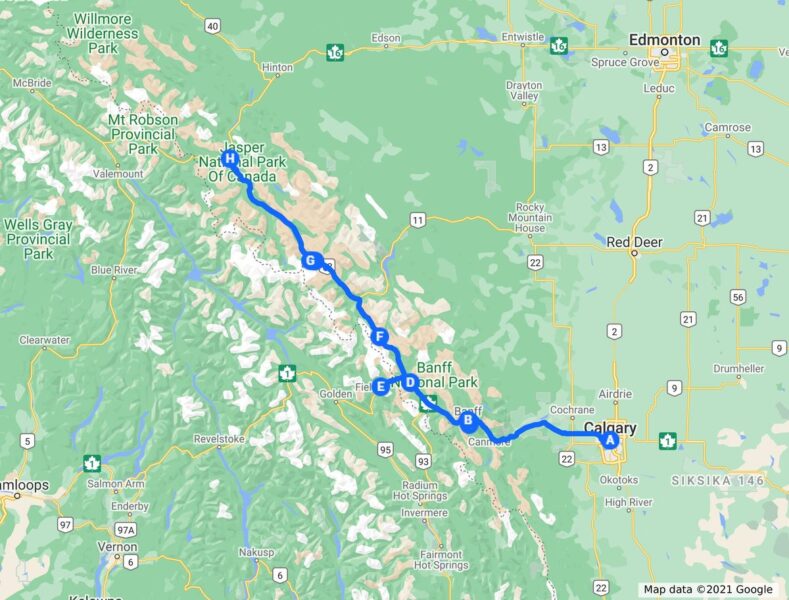
How to Get Around!?
It’s nearly impossible to get around the USA and check out the best adventures without a car! Here are our top recommendations…
Rent a car! I usually find great deals on cars and SUVs here:
Rent a home on wheels! For the more adventurous, rent a van or RV and forgo the hotel room.
Canadian Rockies Itinerary Day 1: Calgary to Banff National Park
Calgary is the closest international airport to the most beautiful national parks in the Rockies. While there are many things you can do in the city, let’s not waste precious time. The mountains are waiting.
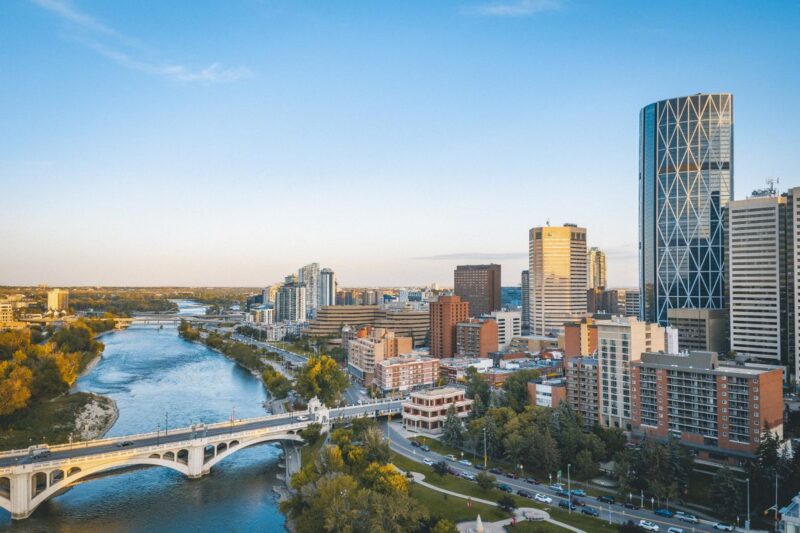
Once you pick up your car or a campervan, the drive to Banff takes about 1.5 hours on a toll-free highway. You can purchase the Park Pass for national parks at the gate or online in advance . In Banff, either stay in one of the lodges in town or a campground.
Camping is a very popular option in the Rockies and Banff, mainly due to the extremely high prices of the lodges. Camping in Banff involves waking up to the sound of the birds, and trees, and fresh mountain air.
Campervans are the best budget-friendly option, but if you don’t want to sleep in a car or a tent, glamping in oTentiks is also an option. oTentiks are pre-built wooden tents with beds, electricity, heating, and showers. Book a campground here .
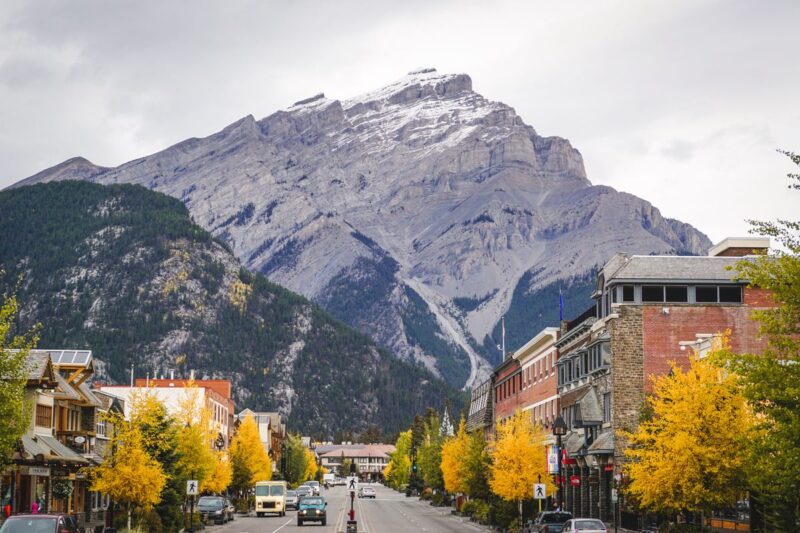
The best first thing you can do in Banff is stroll the main Banff Avenue. It’s filled with souvenir shops, hotels, restaurants, and most importantly, it offers gorgeous views of Cascade Mountain and Mount Rundle.
Start at Banff Avenue and continue along the Bow River through the pedestrian bridge. Walking the path downstream leads to a viewpoint of Bow Falls, a beautiful local spot and my favorite picnic place.
Canadian Rockies Itinerary Day 2: Banff National Park
Explore Banff and let those legs move after sitting on the plane. One of the most popular attractions in Banff is the gondola up the Sulphur Mountain. The panoramic view from the top of the mountain is breathtaking.
Just imagine mountains all around you, views of valleys, mountain peaks, the town of Banff, and even Lake Minnewanka in the distance.
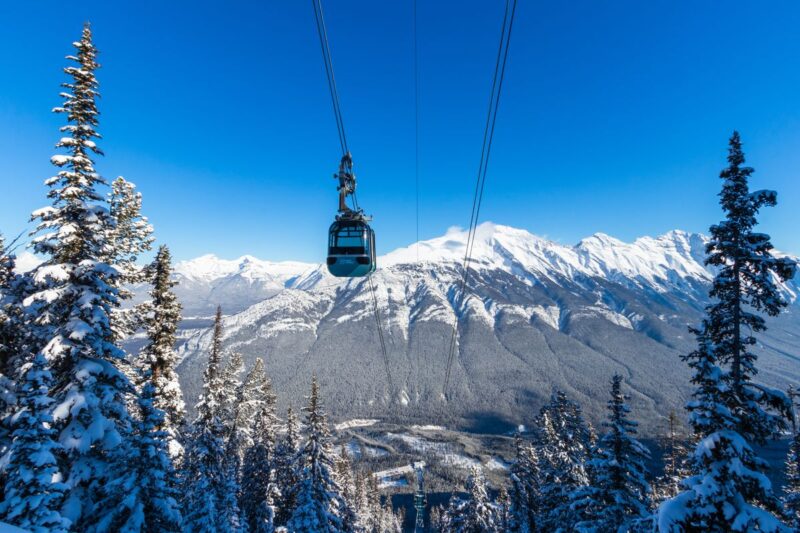
You can either choose to take the gondola up or hike up the Sulphur Mountain yourself. It’s one of the best hikes in Banff, but if it’s not your thing, the gondola takes 8 minutes and costs about $60/adult.
Of course, the hike is free, and I’ve seen people of all ages hiking up the switchbacks to the mountain top. It’s a 5.5 km long hike (one-way) and takes around 2 hours with breaks on average.
Important tip: always check trail conditions before hiking if the trail is open and carry bear spray anywhere in the Canadian Rockies. Parks Canada recommends having it within an arm’s reach (you can buy it in any outdoor store in Banff) and learning how to behave around wildlife in advance.
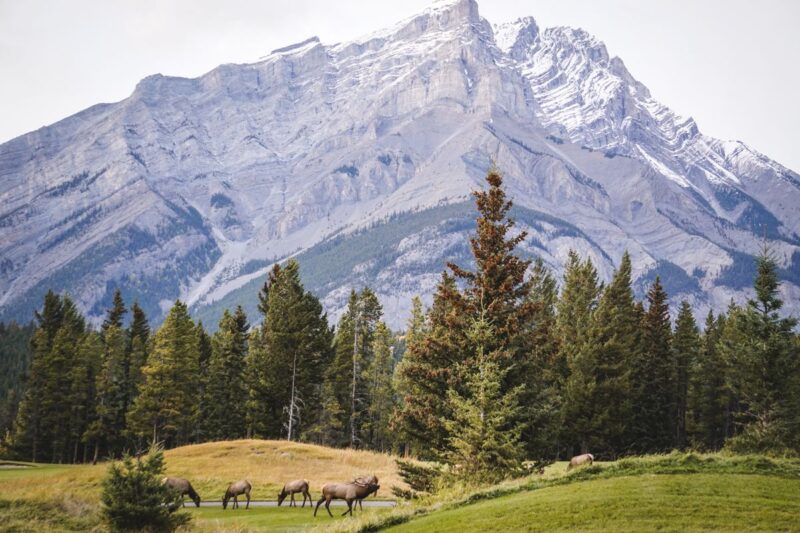
Enjoy the viewing platform, interactive indoor center at the upper terminal, or lunch in the restaurant. Walk the 1 km long boardwalk to Sanson’s Peak, an old weather station for more gorgeous views.
The afternoon is a great time to enjoy a lake cruise. Lake Minnewanka is a 21 km-long glacial lake and the second longest lake in the Rockies. Within a 20-minute drive from Banff, you can cruise, kayak, hike, or bike along the lake.
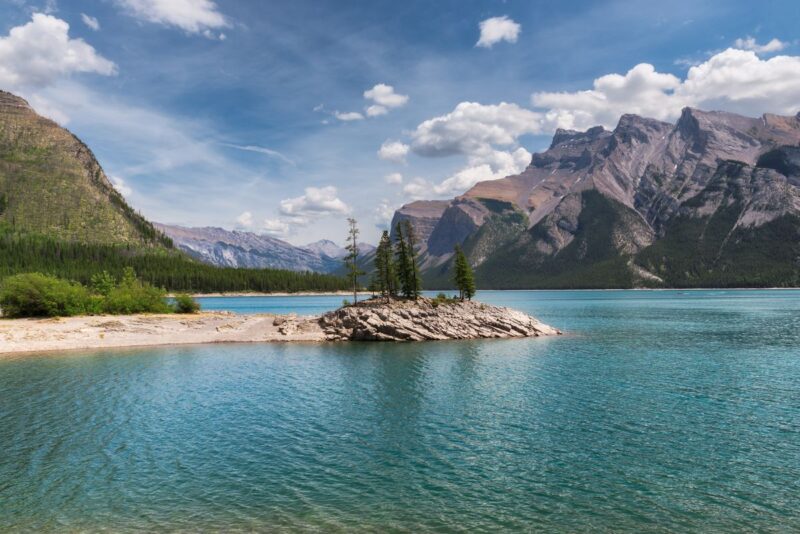
The cruise takes you across the lake, where the guide talks about the history and different wildlife living in the area. Another option is to rent a kayak onshore and explore on your own.
There are several picnic tables where you can relax afterward. A short hike through the forest leads to Stewart Canyon, an excellent viewpoint of Lake Minnewanka.
To end the day, visit Vermilion Lakes that are walking distance from Banff. It’s a favorite spot for photographers, bird watchers, and picnic lovers.
Canadian Rockies Itinerary Day 3: Moraine Lake & Lake Louise
A Canadian Rockies itinerary won’t be complete without seeing the most iconic lakes in the Canadian Rockies – Moraine Lake and Lake Louise. And luckily for all of us, they’re located next to each other.
About a 45-minute drive from Banff, you’ll find Moraine Lake in the Valley of Ten Peaks. When you arrive at the shore, you’ll be stunned! An absolutely gorgeous turquoise lake with snow-capped mountain peaks in the backdrop.
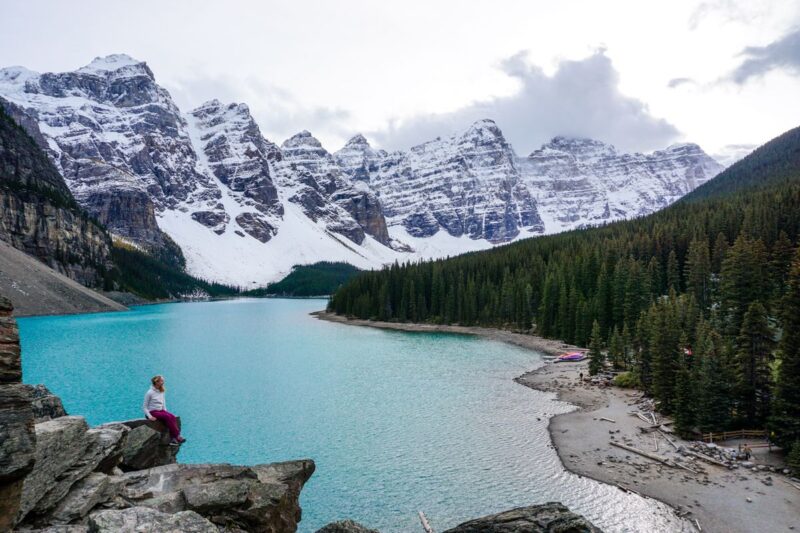
As pretty as Moraine Lake gets right from the shore where Moraine Lake Lodge is located, there are several viewpoints and options for making the most of your visit. First, follow the sign and walk up the Rockpile to see the lake from above; this is the best viewpoint.
To get away from the crowds, walk the trail just past the lodge. There’s a canoe rental on-site or you can bring your own (or rented) kayak or stand up paddleboard to paddle around the lake. It takes you to the end of the lake with several benches along the way to rest and enjoy.
Due to the extreme popularity of Moraine Lake, getting to the lake can be difficult. You need to arrive before sunrise to have a spot on the parking lot; otherwise, Parks Canada closes the road. A hassle-free option would be booking a shuttle. You can read our Moraine Lake guide for more info.
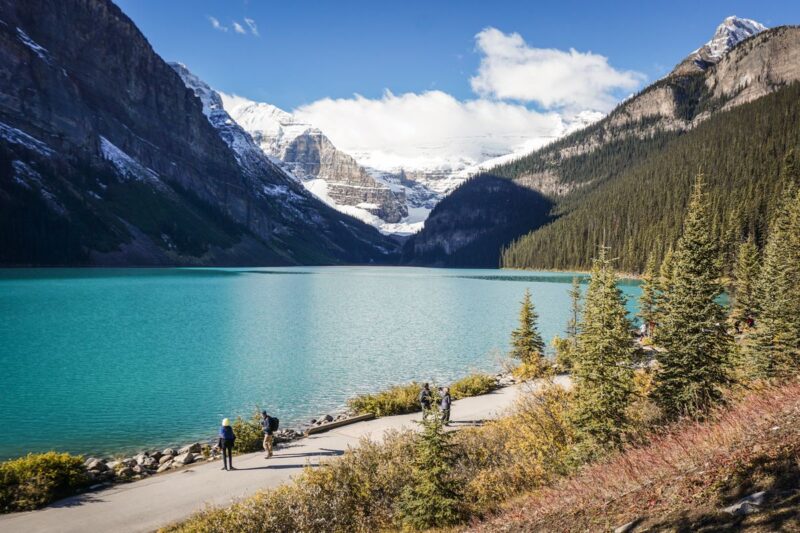
Lake Louise is a short drive away in the next valley. It features a huge parking lot, and generally, it’s easier to get to than Moraine Lake.
The bright turquoise color of Lake Louise with surrounding mountains and Victoria Glacier in the backdrop makes for a breathtaking moment. Canoe rentals are located onshore, and several hikes in the area give you a different viewpoint of Lake Louise from above.
My favorite hike is Mount Saint Piran which is 13 km long and lesser-known, so no crowds on the trail. You see Lake Louise from a bird’s eye view, the Bow Valley, and even peaks and lakes on the other side of the mountain along the Icefields Parkway (which you will drive on Day 5 of your Canadian Rockies road trip).
Canadian Rockies Itinerary Day 4: Yoho National Park
Yoho National Park might be small, but it’s an essential part of any Canadian Rockies itinerary.
It takes only 30 minutes to drive from Lake Louise to Takakkaw Falls in Yoho National Park. At 373 meters high, they’re the second-highest waterfall in Canada, and you can get right under them.
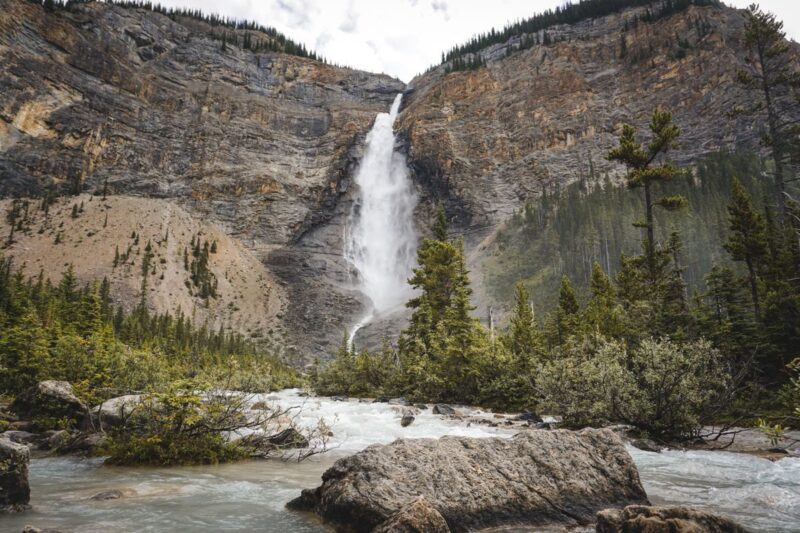
A short paved trail leads from the parking lot right under the magnificent Takakkaw Falls. Takakkaw means “magnificent” in Cree language and you’ll understand why they were named like this as soon as you arrive. They also provide an excellent way to cool off in summer.
There are plenty of picnic tables and also the famous red chairs. Red chairs are scattered around the most iconic viewpoints in the Canadian Rockies. Taking a photo in the chair is almost a must on your Canadian road trip.
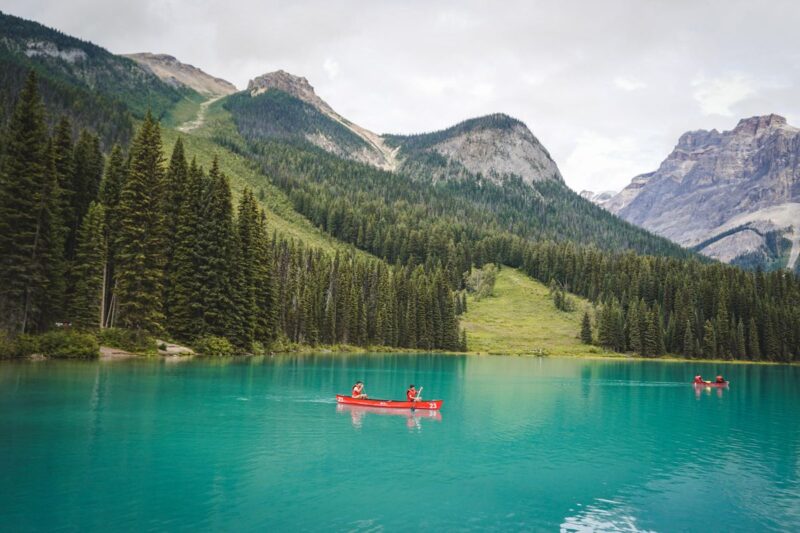
After the Takakkaw Falls, visit the Natural Bridge with a bustling waterfall under your feet. The same road also takes you to Emerald Lake. Emerald Lake has a different shade of green depending on how the sun’s rays reflect on the water.
Canoe rentals are provided onshore, and they’re the most budget-friendly in the Rockies, with an hour rental under $100. You can walk around the lake, spot wildlife, or relax at the patio with a view of Emerald Lake and surrounding glaciers.
Canadian Rockies Itinerary Day 5: Icefields Parkway to Jasper
The Icefields Parkway is often called “one of the most beautiful drives in the world” by many publications, including National Geographic.
It takes you from Lake Louise in Banff National Park to Jasper in Jasper National Park, and it’s hard to predict how long 230 km would take you. You can rush and get to Jasper in two hours or take your time and drive for two days.
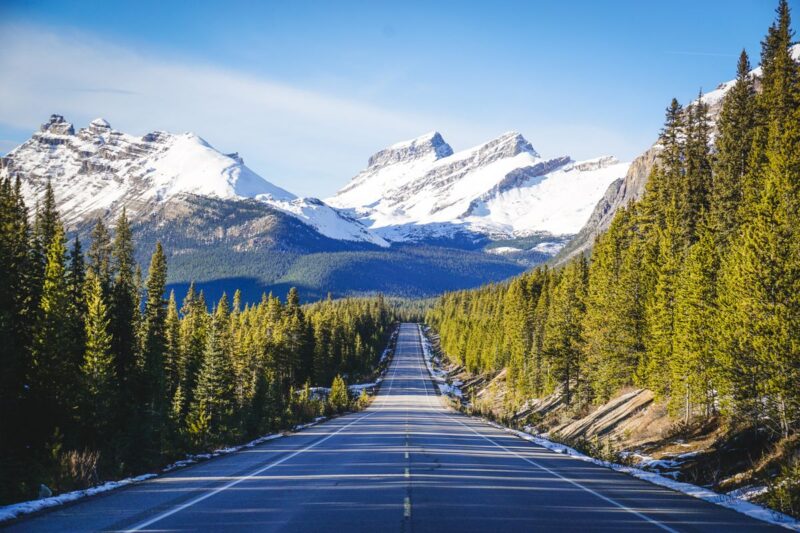
Icefields Parkway is famous for its rugged beauty, glacial lakes, waterfalls, wildlife, and endless glacier views. The road offers a lot of stops for hiking, camping, and viewpoints. If you want to take your time with this leg of the trip, an RV is a great option. You can book your van at Outdoorsy .
My recommendations are Bow Lake, (newly opened) Peyto Lake, Waterfowl Lakes, Mistaya Canyon, Columbia Icefield, Sunwapta Falls, Athabasca Falls, and Horseshoe Lake.
The longest stop is at Columbia Icefield. You can book an Ice Explorer bus which would take you directly to the glacier. It’s an amazing experience if you’ve never walked on a glacier. If you bring your water bottle (with filter), you can also drink the glacier water.
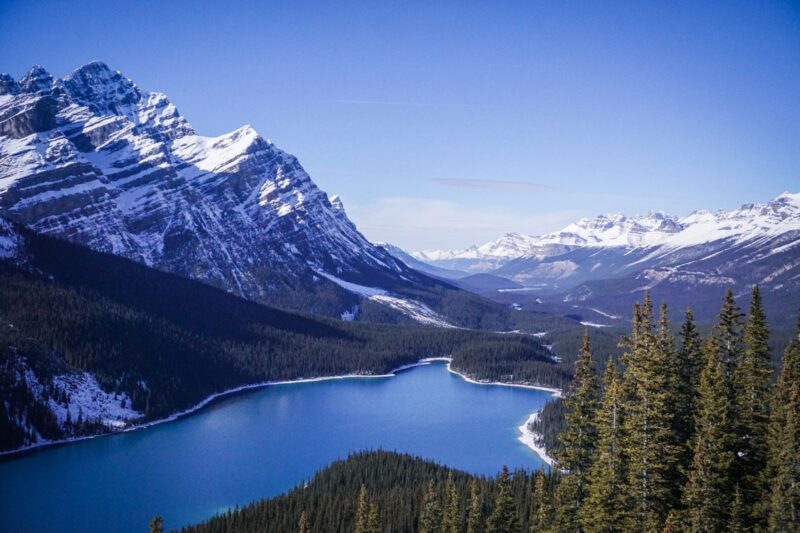
You’ll want to stop often, enjoy the views and take pictures, so spending a full day on Icefields Parkway is a must. And you’ll also drive the road back from Jasper to Calgary on Day 7, where I’m suggesting hikes with the most stunning views.
Canadian Rockies Itinerary Day 6: Jasper
Once you reach the Columbia Icefield on the Icefields Parkway, you are already in Jasper National Park. Take in the beauty along the road until you reach the small mountain town of Jasper.
A little-known neighbor of Banff is Jasper, located in the Athabasca River Valley. The activities and hikes are more spread out, so you don’t feel like meeting crowds, which is rarely the case in Banff.
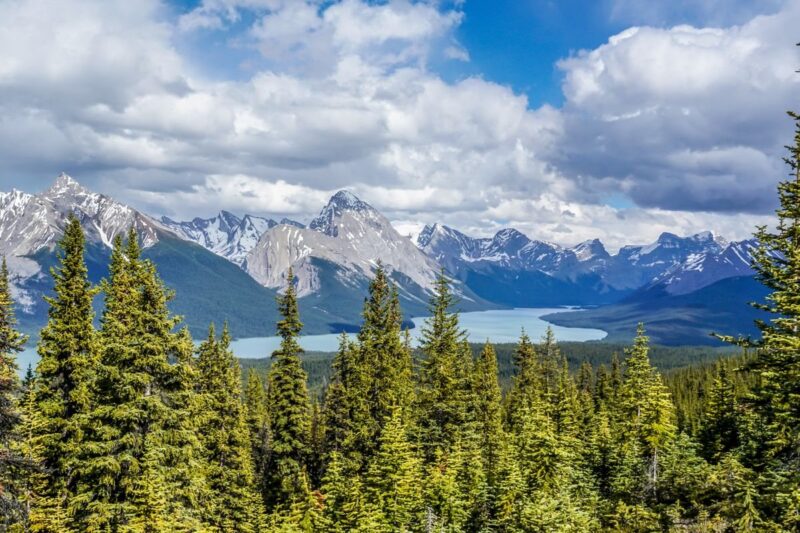
Jasper National Park is the largest national park in the Rockies and offers countless options for outdoor fun. My personal favorite is stand-up paddleboarding on Edith Lake (with SUP rental on-site) and biking the trails along the Athabasca River to see wildlife.
If there are only two things that I would recommend to you, it’s visiting Maligne Lake and hiking in the Valley of the Five Lakes.
When driving to Maligne Lake, stop at Maligne Canyon for a short stroll and at Medicine Lake, where bears like to hang out.
Maligne Lake is a long azure lake surrounded by mountains and glaciers. You can take a cruise across the lake to see the famous Spirit Island, a popular spot for photographers, rent a kayak to paddle on your own, or hike up the Bald Hills to see the lake from above. Several short hikes are starting at Maligne Lake that take you to small mountain lakes.
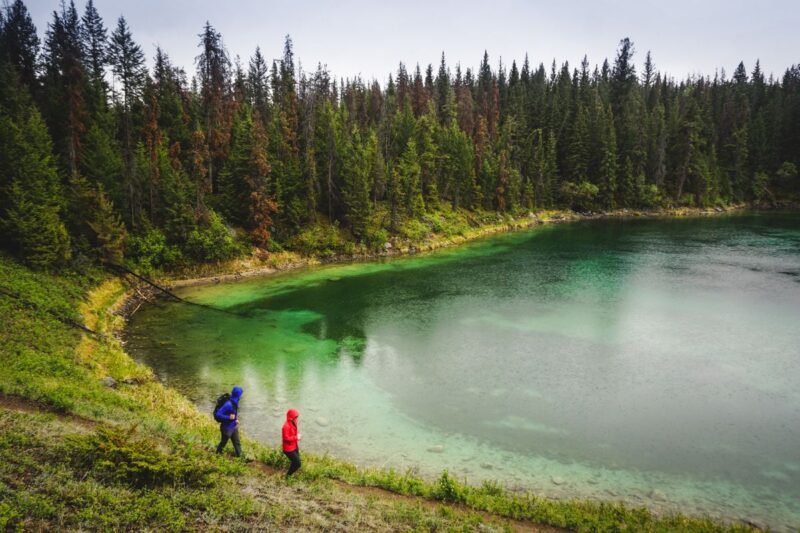
You can access the Valley of the Five Lakes from the Icefields Parkway when driving or leaving Jasper. It’s the most stunning hike in Jasper featuring emerald lakes in different shades, viewpoints with red chairs, and often wildlife. The 5.5 km loop around the lakes is family-friendly and accessible for all fitness levels.
Canadian Rockies Itinerary Day 7: Jasper to Calgary
On the last day, when you drive through the Icefields Parkway back to Calgary, you’ll surely realize how much there is to see and experience in the Canadian Rockies and would want to come back.
Enjoy the viewpoints on the way back, and I highly suggest stopping at either Wilcox Pass or Parker Ridge for a hike. At Wilcox Pass, it only takes a few kilometers of hiking to reach the viewpoint with red chairs to see Athabasca Glacier across the valley.
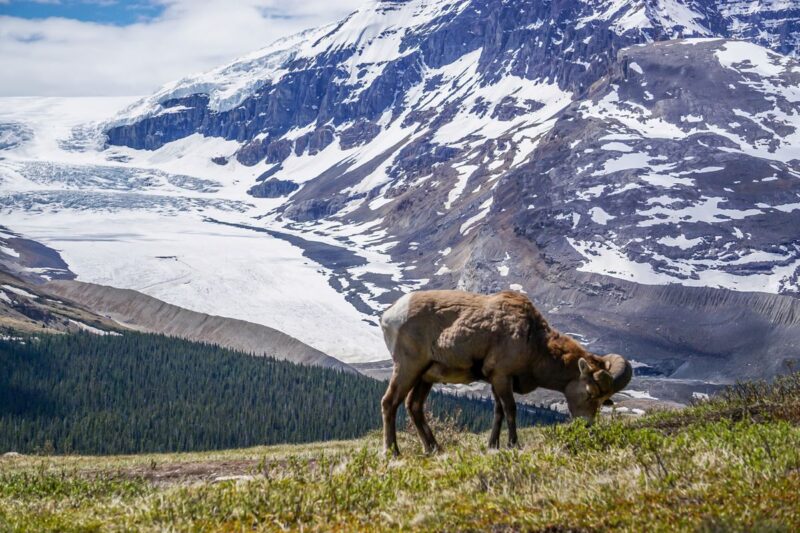
Parker Ridge is a steep 5 km hike but with a huge reward at the end, where you see the massive Saskatchewan Glacier with a turquoise pool underneath.
I hope you find these tips helpful to have an epic Canadian Rockies road trip and enjoy it to the fullest!
More Around Canada
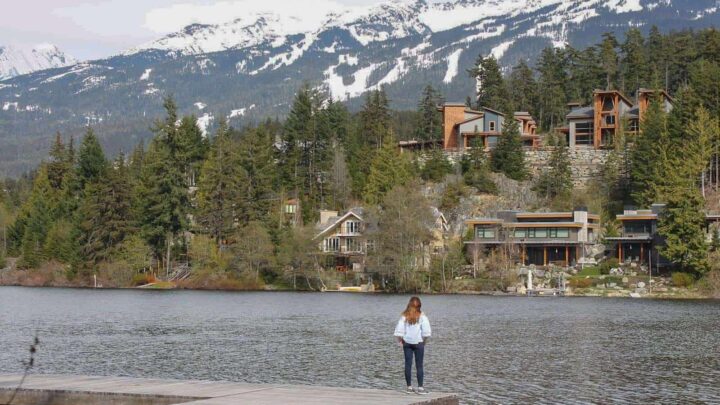
>>> BIO
Maya is an adventure athlete and world traveler. After her trip around the world, she returned to the Canadian Rockies. Apart from adventure sports, she loves traveling to places beyond the beaten path which are not often visited. She shares her travel stories and comprehensive adventure travel guides on her blog Travel with the Smile .
TAKE THE SHORTCUT
Want to know how to live abroad without being rich.
Get my shortcut! It's THE ONLY guide you'll need on how to sustain a life abroad—NO BS!
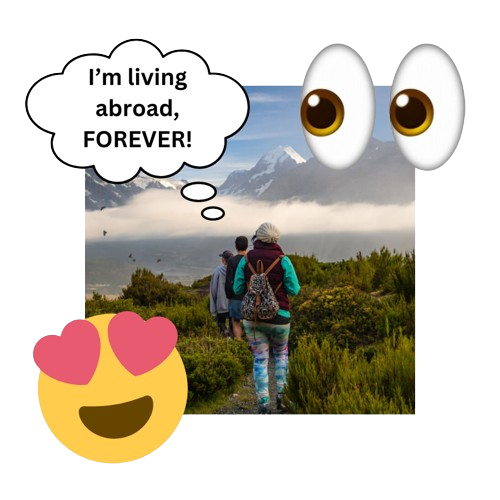
Nina Ragusa is an adventurer, messy bun master, breakfast fan, and full-time travel blogger. She's been abroad since 2011 and blogging on Where in the World is Nina? for nearly as long. Nina helps people like you move around the world while making money. She loves talking about how to work abroad and online to travel longer! Read more about Nina
Leave a Reply Cancel reply
Your email address will not be published. Required fields are marked *

ROAD TRIP IDEAS & HIKING INSPIRATION FOR OUTDOORSY TRAVELERS
Canadian Rockies Road Trip From Vancouver to Banff – 9 Day Itinerary

Sharing is caring!
After spending our weekends hiking around Vancouver , finally, we had a bit more free time, so it was time for new mountains!
We wanted to go hiking, but as I was carrying our first child in my belly, we didn’t want to overdo it, so going on a road trip to the Canadian Rockies seemed like the perfect choice. It was a warm-up before hopping on a plane to Las Vegas and visiting the Death Valley and the Grand Canyon.
The Canadian Rocky Mountains are about 900 km from Vancouver, so getting there and back can be a fun road trip. While being in the mountains, you can hike to different peaks or lakes every day. One option to get there is by train, but we rented a car for our trip to be flexible with transportation as our free time was limited.
Let us show you our Canadian Rockies Road trip itinerary.
Canadian Rockies Road Trip From Vancouver
Canadian rockies road trip map.
This map shows our itinerary from Vancouver to Banff and Jasper.
How to get to the Rockies?
Although we drove from BC, you can easily make a very similar Canadian Rockies Road trip from Calgary (Day 5 and onwards), and you will even save a LOT of hours on driving. Vancouver was crazy far.
By plane & car
The rest of Canada is even further. If you explored Montreal or Toronto and still have a couple of days extra, and you love the mountains as much as we do, you can fit a Rockies trip into your itinerary. We would recommend you to take a plane first and then hire a car closer to the Rockies to maximize your experience and avoid extensive driving.
Travel Resources
There is nothing better than a relaxed holiday. To ensure your rest, make sure you reserve and book your accommodation and transportation in advance of your trip.
- Don’t forget to insure yourself during your travels: SafetyWing . Check out their policies HERE . It also covers several virus-related expenses.
- Look for the best prices on flight tickets, hotels, and car rentals: Expedia
- Car rental: SIXt
- Accommodation: Booking.com , Agoda or Hostelworld if you travel on a budget. Don’t forget that you can search for Apartments also on Booking.
- Activities: GetYourGuide
- Opinions on hotels and restaurants: TripAdvisor
- Was your flight canceled or delayed? Get up to 600€ back with the help of Compansair!
Day 1. Vancouver – Kamloops (430 km driving)
We didn’t drive from Vancouver to Kamloops the shortest way, but definitely on one of the most spectacular, on the Trans Canada Highway. It is one of the world’s longest highway systems with its 8000+ km length across Canada. We drove on the part of it from Vancouver, but it starts on Vancouver island already. When I write a highway , I must note that I don’t picture two multi-lane roads separated by hedges from each other. In Europe, you would simply call this Canadian highway a national road or something like that, but not a highway. It’s only specialty the white-on-green, maple-leaf route markers sign. Every highway has its own boards that depict the symbol of the road that can be animal or plant (at least so far, we’ve seen only such symbols).
The highway leads through the southern part of Fraser Canyon . It gets dryer and dryer as you go more north and have a higher altitude. The granite walls look great, especially if you like railways. The railway tracks run on both sides of the canyon, and you can observe extra-long trains. The shortest one I’ve seen had only 150 railway wagons (and three locomotives), which means the trains are easily 2.5-3 km long .
If you are not that much fun of the railway, you can just have a stop at Hell’s Gate, where the canyon has very steep walls, and according to my colleagues, it is one of the best spots to watch salmon migrating back to the rivers as it is very narrow.
After Cache Creek, the road turns to Thompson Valley . Another, very, very dry valley with the long Kamloops Lake . If the rain is not pouring and you reach this part in brightness, you can enjoy the views for sure.
Check out the accommodation prices in Kamloops!
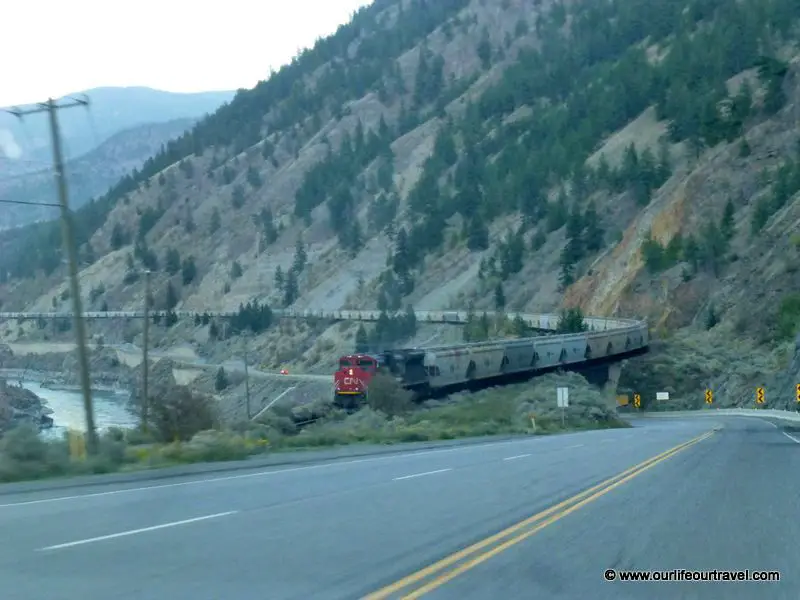
Day 2. Kamloops – Golden (360 km driving) and hiking to the Cinnamon Ridge
After spending the night at a roadside motel, we woke up to sunny weather. By the way, the motel was nothing like in the movies. First, I was afraid that it would be very crappy, with all the bad horror movies’ assets as they even looked like that from outside, but it was a positive surprise. Everything was neat and beautiful. Better motels have a pool and hot tub as well. The room was also well equipped with a fridge, microwave oven, and coffee machine. I was so surprised that I forgot to take pictures of all the motels inside 😀

[sgpx gpx=”/wp-content/uploads/gpx/kamloops.gpx”]
We have visited Cinnamon Ridge, where we planned a short hike. It became a bit longer when Katalin did some unsuccessful shortcuts, and now we also know why not touch a cactus. Ever. And definitely, don’t grab it. Even after many days, it gives you unpleasant aches if you did not (or could not) remove all the needles. Besides the extraordinary adventures, the place is a charming, badland-like , spectacular view of the extra-long trains.
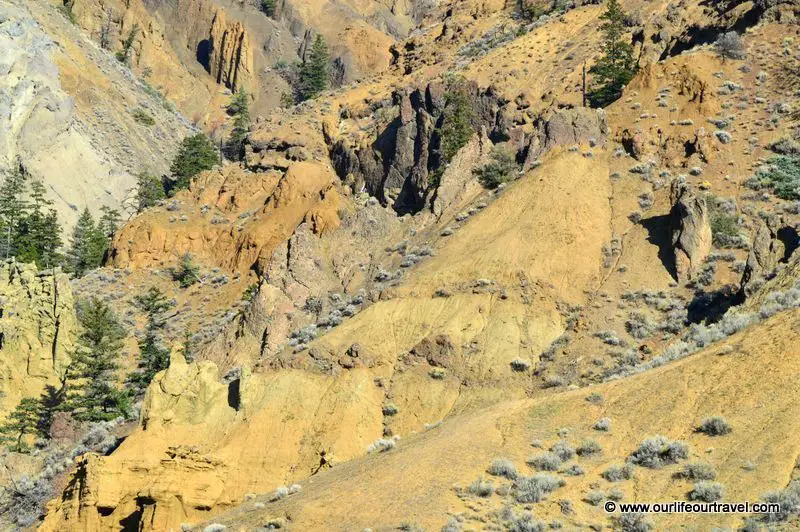
Day 3. Golden and hiking in the Glacier National Park
The Glacier National Park is part of the Selkirk Mountains (Columbia Mountains). The trailhead at Illecillewaet Campground has many information boards about the railway, the railway building history, and artifacts. The national park became a famous elite holiday place when the railway had a luxury stop, a hotel with every kind of service there. The mountains, the glaciers, nature were a perfect getaway from the cities for the rich.
Nowadays, it is only a hiking destination, the railway runs in a tunnel under the mountains, and the once upon a time famous Glacier House had been closed a long time ago. Since the railway went through a tunnel under the bridges, fewer guests were visiting the place. However, it was necessary to build the tunnel, as the avalanches often blocked or even destroyed the tracks. And not only the railway traffic had problems with the snow. This section of the highway has the most avalanches in the whole of Canada.
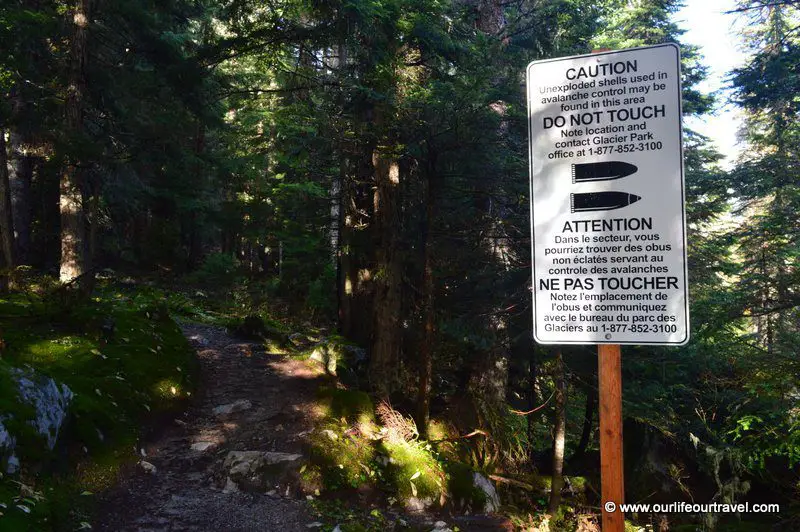
[sgpx gpx=”/wp-content/uploads/gpx/abbottridge.gpx”]
The weather was cloudy, but we still decided to climb to the Abbott Ridge (2274 m a.s. l) . In the first part of the hike, the mountains and glaciers were hiding and sometimes showing themselves for a short moment between the clouds. Fog, clouds, and snow were everywhere. I enjoyed the winter scenery. Later the sky cleared up a bit, and we had a view over almost the whole park from Abbott Ridge. On the way down, we had a bit of sunshine, which melted most of the snow from the trees and the ground. On the trail, we met with four other people. A perfect day in nature!
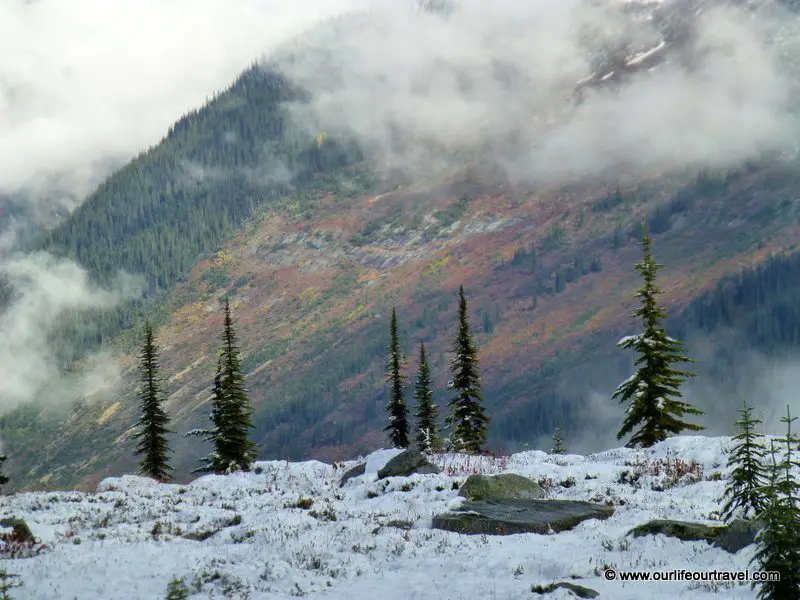
We drove back to Golden, to a small town with significant railway traffic. The motel we stayed in had a hot tub, similar to the one in Kamloops, and this time we even tried it. We arrived hungrily, and we didn’t want to go outside of our warm room. Luckily, we managed to order pizza online, without any working phone number, to enjoy the rest of the evening in the room.
Book your place in Golden now!
Day 4. Golden – Radium Hot Springs – Banff (240 km driving with stops)
We left Golden in the morning and had a short spa visit at Radium Hot Springs , at the Rocky Mountains’ edge. Finally, we started our road trip in the Rockies! The hot spring is not as good as the ones in Hungary. There is a typical swimming pool with slightly warm water, a heated pool, and a hot tub. The pools are real pools, the only advantage for them that they are outside, and you can see the rocks from them. Considering that it was a cloudy October Monday, many people were soaking themselves, and even more came later when we left.

After a short dip, we continued our way to Kootenay National Park through Sinclair Canyon . We took quick photo stops here and there and had short walks. Rivers, glaciers, mountains. The only cultural stop we made was at ’ Paint Pots ’ to check the ochre beds. Already the Indians (called First Nations in Canada) used them as body paint, and during the last centuries, ochre was collected from this area. Nowadays, you can still see the old pools where the iron-rich water flew, the beds they made from the mud to get the coloring, and some machinery as well. The mining was banned totally when the national park was established. Near to this heritage, there is the Marble Canyon, but don’t be mistaken. Not a real canyon, and we haven’t seen any marble either.

What else can you notice immediately in Kootenay? The remains of the forest fires . There was a massive outbreak in 2003, and 17 000 ha forests burned. Nowadays, you can see the burned, fallen, or still standing charred trees. Among them, the new seedlings are growing and making the area green again. The forest is returning. The Marble Canyon trail was meant to show the results of the fires.
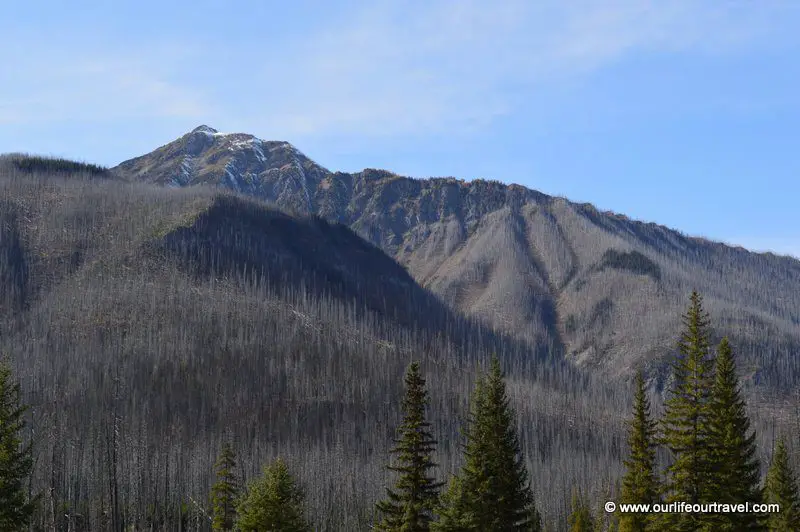
After leaving Kootenay National Park, we entered Banff National Park . As the weather became perfect, we had a few more photo stops before checking in to our hostel in Banff.
Booking.com
Day 5. Banff – Bow Lake – Banff (180 km) and hiking to Dolomite Pass
Our accommodation for the next five nights was in Banff . The hostel was pretty cool: a well-equipped kitchen, laundry place, and social hangout place beside the dorm rooms. There could have been more toilets, but that was my only concern.
Check out the hostel we stayed in.
Banff is like Zakopane of Tatra . The only difference is that high mountains surround it in every direction. The similarities are that every local live from tourism, the city is full of souvenir shops, hotels, inns, restaurants, and tour operators. Luckily we were not in high season so that it could be tolerable. It also means that the weather was unpredictable. One day it was +10°C and sunny, another day freezing and snowing.
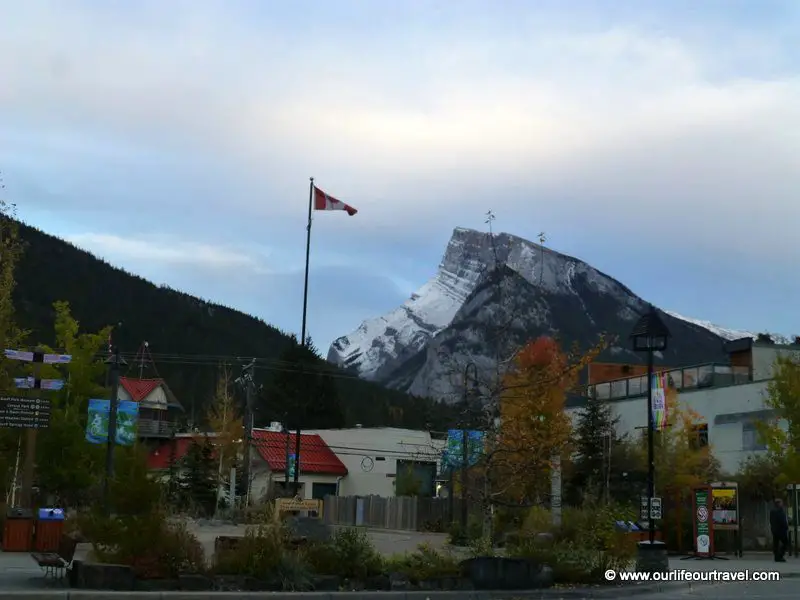
We decided to stay so long in Banff as it is easy to reach every trail we wanted to hike from there, and there are not many other options in the Rocky Mountains. Most of the accommodation places were in Banff and Jasper, and there are no budget options elsewhere.
[sgpx gpx=”/wp-content/uploads/gpx/dolomitepass.gpx”]
The first hike we did lead to the Dolomite Pass ( 1 4.6 km Distance, 5 hours ). We aimed at Cirque Peak beforehand, but due to the snow clouds and low visibility, we changed our route from Helen Lake. The hike is quite easy, but it was very muddy. After the lake, it became very wet as well for a short distance.
When we reached the Dolomite Pass, it started to snow more. The views were pretty spectacular, but for me, the best part of the hike was to see probably spruce grouse/trail chickens (Falcipennis Canadensis) from very close. One of them was just enjoying the snow next to my feet. First, I was afraid that it would fly away that didn’t seem to be bothered by us, so we took millions of shots of it. On our way back, we have seen even more of them around the same spot.
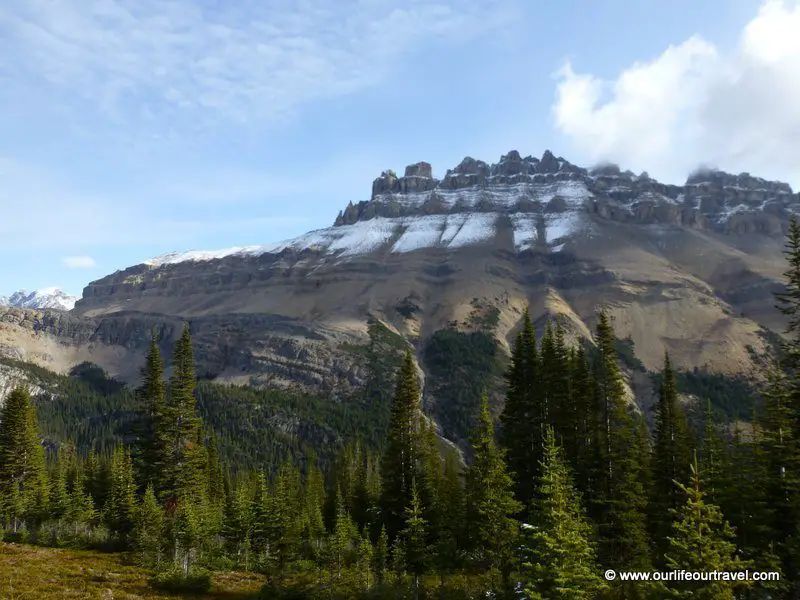
Day 6. Banff – Columbia Icefield – Banff (350 km) + hike to Parker Ridge
What to do on a snowy day? Check out more glaciers! We decided to drive a bit more because the weather was supposed to get better there and check out Athabasca and Saskatchewan, just to name two glaciers from the Columbia Icefield. On a road trip through the Canadian Rockies, you never can be sure about the weather conditions.
Athabasca Glacier is the location of a significant tourism business. If you pay, you are taken up by a bus near the foot of the glacier. It is probably possible to take some fantastic shots from there. As it was not our first or last glacier, we didn’t even consider paying for it. We just had a walk from the parking place up to the river, formed from the melting ice.
The biggest attraction was not even the ice cave entrance we could see, but our first ever seen avalanche . An enormous amount of snow ran off from the top of one of the side glaciers to the central valley. It started small, and at first, we thought it is a waterfall, but soon we realized it isn’t. Luckily (or unfortunately?), we were very far from it, but we could take few pics of the happenings, although not initially.
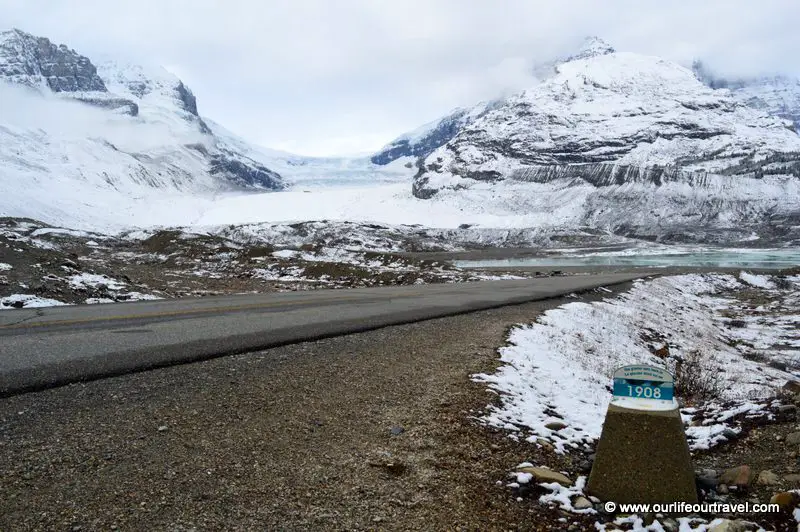
[sgpx gpx=”/wp-content/uploads/gpx/parkerridge.gpx”]
The weather was still very cloudy, but we decided to hike up to Parker Ridge (6 km, 250 m elevation gain) to check out another glacier: Saskatchewan . Unfortunately, we could only see the upper part of it behind the clouds and some km in the valley where it is already melted, and just the debris left. We haven’t seen the edge.
On our drive back to Banff, the clouds were much higher than in the morning to enjoy a bit more views.

Day 7. Banff – hiking the Cory Pass loop
[sgpx gpx=”/wp-content/uploads/gpx/corypass.gpx”]
Another cloudy day. With only a few minutes of driving, we reached the parking lot near Bow River. Today’s goal was to reach the Cory Pass. During the first few kilometers, we had a lovely view of the Bow River, Trans-Canada Highway, railway, and Banff while ascending. The route later zigzags up on the edge of the forest, and in clear weather, you can see the mountain tops as well, but we only saw the valleys and not even the bottoms of them.
Before the Cory Pass, we walked on a very narrow one-person-wide trail, which has steep downhill on our left. That was the point where the trees had excellent snow cover. It looked lovely, but I still think it was the least spectacular hike among all we did during the last days. First, we passed two junctions with trails that head up to Mount Edith. Then we finally reached the Cory Pass, which was above the clouds! Amazing pictures time! Two other guys had similar ideas and took photos of the peaks showing up from the clouds.
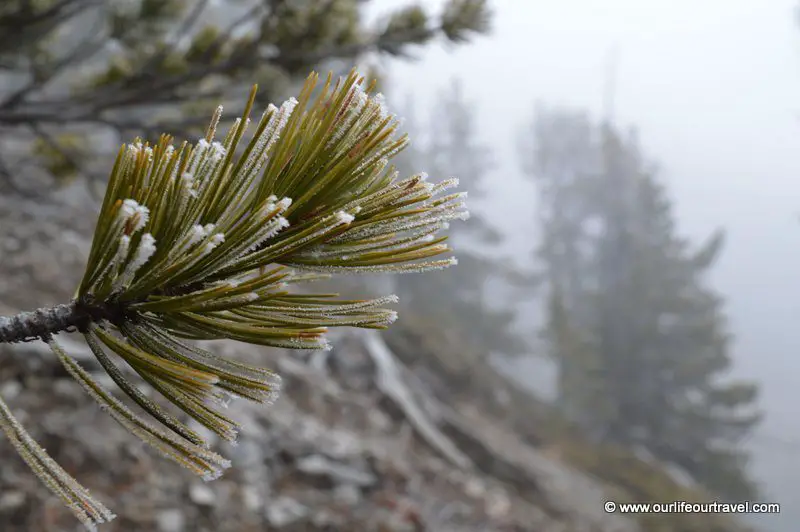
After admiring the view, we continued on the trail down from the pass on the other side. It was very snowy and a bit slippery. In Gargoyles Valley, Stone pillars surrounded the route , but we could only see the closer ones because of the valley’s cloud. We could hear stones and rocks moving and falling. Karol even spotted one flying above me. I got a bit scared, and we sped up.
After a kilometer, we reached a part with big rocks. We followed the footprints in the snow, but we realized they lead in the wrong direction, so after this short detour and about an extra 100 m elevation loss and gain, we found the correct way to Edith Pass. The rest of the trail was rather flat, slowly descending. There were a lot of fallen trees out of the trail. The last kilometers were in the forest without any views. The loop took us about 7 hours and was much more spectacular than I expected. I fell in love with the mountains every day.
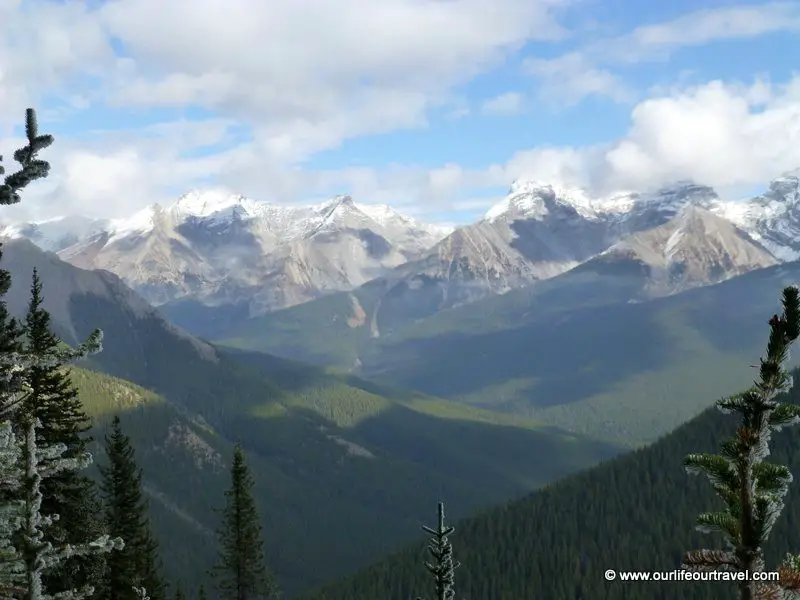
Day 8. Banff – surrounding of Lake Louise – Banff (140 km driving + short walks)
We woke up to snow . A couple of centimeters covered the trees, the roofs, and cars, even in Banff. And it was still falling, reducing the visibility close to zero. The mountains disappeared behind the snow clouds. It was a perfect time to do some lazy, low-altitude walk around a few lakes.
- Work With Me
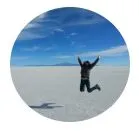
- Central America
- South America
- Solo Travel
- Budget Travel
- Digital Nomad Life
- Work Exchange
- Foodie Experiences
- Responsible Travel
- Winter Travel
- Backpacker Accommodation
- Accommodation In the UK
- Hostel Tips
- Hostel Packing List
- Work as a Hostel Volunteer
- Work in Exchange for Accommodation
- Travel Websites to Book Your Trip
- Travel Planning Checklist
- How to Travel for Free
- How to Save Money While Travelling
- Carry On Packing List
- Long Haul Flight Essentials
- Campervan Packing List
- Flight Tips
- Solo Travel Tips
- Accommodation
- Travel Insurance
- Packing Lists
- Eco-Friendly Travel Products
- Carry On Backpacks
- Backpack Essentials
- Filter Water Bottles
- Camera Gear
- Camping Gear
- Gifts for Travel Lovers
- Backpacking Gifts
- Hiking Gifts
- Campervan Gifts
- Beach Gifts
- Personalised Travel Gifts
- Small Travel Gifts
- World Map Gifts
- Gift Experiences
- Privacy Policy
Backpacking in Canada , Guest Posts , Road Trips
Vancouver to banff road trip through the rocky mountains.
There are several different driving routes from Vancouver to Banff, but for this road trip itinerary, we’ll focus on the Northern Route that passes through a section of the Rocky Mountains and several provincial and national parks in British Columbia and Alberta. This epic Vancouver to Banff road trip is considered to be one of the best road trips on earth, especially if you love nature, wildlife and culture.
This website contains sponsored and affiliate links. If you click through the links on this page and make a purchase, I may earn a small commission. As an Amazon Associate I earn from qualifying purchases. Thank you for your support. [Learn more]
This is a guest post by Jarryd and Alesha from NOMADasaurus and Van Life Theory
How Long Do You Need
It’s recommended you put aside at least 10 days to get the most out of this trip. The best time to visit is between June and September when you can get the best of the weather and driving conditions.
Along this route, you’ll see spectacular scenery consisting of snow-capped mountains, glacial lakes and picture-perfect towns and villages, each with its own set of attractions. You’ll also spot wildlife including elk, bighorn sheep, mountain goats and maybe even a grizzly bear if you’re lucky!
Exploring the Rocky Mountains is certainly one of the top things to do in Canada , so are you ready to embark on the adventure of a lifetime on this Canadian road trip?
Looking to Hire a Car?
- Get a quote for car hire with Discover Cars who compare car rental deals from lots of different companies so that you can choose which is best for your trip. I've used Discover Cars several times on road trips around the world and I love how easy it is to find cheap car hire!
GET A CAR HIRE QUOTE
What to Pack for Your Road Trip
Check out this article for my top road trip essentials complete with a printable road trip checklist.

Vancouver
Your start point.
If you’re getting ready to drive to Banff from Vancouver I assume you’ve already spent several days in Vancouver, British Columbia. If not, you should set aside some time to explore this fabulous city.
It isn’t the cheapest destination – one of the most expensive cities in Canada in fact, but there are plenty of free things to do in Vancouver if you are on a tight budget! Popular attractions include the Vancouver Art Gallery, Gastown, China Town and the excellent hiking trails in parks and forests around the city.
Squamish and Whistler
Visit for amazing views and a world-class mountain resort.
After you’ve spent some time in Vancouver, head north on Highway 99 towards Squamish. This is where you’ll find your first must-visit attraction, The Sea to Sky Gondola. Enjoy stunning views of Howe Sound on the way up and once at the top, make the most of the hiking trails and the amazing Sky Pilot Suspension Bridge.
Whistler is one of the top mountain resorts in Canada. Although known for some of the best downhill skiing around, Whistler also has much to offer roadtrippers passing through during the warmer months including ziplining, kayaking, mountain biking and hiking.
While exploring the town, some of the attractions worth checking out include the Audain Art Museum and the 70-metre waterfall at Brandywine Falls Provincial Park. Lost Lake is a great place to take a refreshing dip and the water is surprisingly warm during the summer months.
After an exciting day exploring the natural beauty of Whistler, you’ll likely be staying here for the night. If you’re camping, Cheakamus Lake Campground is a great spot. Alternatively, Crystal Lodge Hotel provides budget-friendly accommodation.
If you want to really splurge, The Fairmont Chateau Whistler provides a luxurious experience that includes a golf course, spa, several restaurants, indoor and outdoor swimming pools and fully-equipped rooms.

Pemberton and Kamloops
Visit for mountain scenery mixed with urban attractions.
From Whistler, you’ll pass through the pretty mountain village of Pemberton and enjoy scenic mountain views. Kamloops is the next major stop along this route. This small city is a lovely mix of natural wonders and urban delights.
Spend the morning hiking in the many municipal and provincial parks that are in the area. In the afternoon, visit some of the attractions in Kamloops such as the BC Wildlife Park, Secwepemc Museum & Heritage Park (currently only offering online tours) and Privato Vineyard & Winery. After a day of exploring, enjoy a meal at one of the many restaurants that offer a wide variety of local and ethnic foods.
Wells Gray Provincial Park
Visit for hiking adventures with waterfalls and unique landscapes
Since you’ll want to be well-rested to explore the next must-see attraction on this road trip, Wells Gray Provincial Park, you can either stay at one of the many hotels in Kamloops or drive to the national park and camp for the night.
Wells Gray Provincial Park is mostly known for being home to more than 40 waterfalls and many hiking trails. Explore diverse landscapes and fascinating geological features or embark on a white-water rafting adventure down the Clearwater River.

Visit a mountain village and the Rocky Mountain’s highest peak
Valemount is another scenic mountain village on this amazing Vancouver to Banff road trip, and the best way to enjoy the area’s views is to take a drive up 5 Mile Road which overlooks the valley set between the stunning mountain peaks.
Other attractions in the area include the Valemount Museum, Willmore Wilderness Park, Three Ranges Brewing Company and Overlander Falls.
By far, the can’t-miss attraction is Mount Robson Provincial Park. This is where you’ll find the highest peak in the Canadian Rocky Mountains and be able to participate in many adventures including kayaking, canoeing, white-water rafting, hiking and scenic helicopter tours.

Explore the Wonders of Alberta’s Rocky Mountain Parks
Not far from Mount Robson, you’ll cross the border into Alberta where you’ll find the pristine nature of Jasper National Park. Jasper is known for its natural beauty that’s virtually untouched compared to the other great national parks in the Rocky Mountains. It’s less crowded and you have a better chance at seeing wildlife without venturing too far off the beaten track.
Jasper National Park
Enjoy wildlife, pristine wilderness and glacier lakes
The town of Jasper is where you’ll find many restaurants, top-rated hotels, including the Fairmont Jasper Park Lodge, and attractions such as The Jasper Planetarium, Our Native Land Art Gallery, The Den Wildlife Museum and the Yellowhead Museum. The Jasper SkyTram climbs 2,263 metres above sea level where you’ll enjoy amazing views of the mountain peaks and town below.
Deeper into the national park, you’ll find more world-class attractions. This section of highway that connects Jasper and Banff National Parks is known as the Icefields Parkway. While there are many lakes in this region, if you only get to see one, make it Maligne Lake. Known for its stunning blue colour and surrounding mountain scenery, visitors enjoy canoeing and kayaking on the calm waters of this huge lake.
You can also take a guided cruise to Spirit Island on a tour that’s said to be one of the best in the whole country. Other notable attractions along this stretch include Athabasca Glacier, Athabasca Falls and Glacier Skywalk.
Feel like you need some pampering and relaxation between stops? Kick back in the hottest hot springs in the Rockies at Miette Hot Springs and enjoy a soothing soak in mountain-sourced mineral-rich waters.

Lake Louise and Banff National Park
The last leg of your journey
Of all the parks along this route, Banff National Park is the most popular with the most epic activities and attractions . As you drive through this park, you’ll see more stunning Rocky Mountain vistas and be able to participate in every outdoor activity you can think of.
Lake Louise is one of the most visited attractions in the park. The sparkling blue waters of this beautiful lake are perfect for canoeing and kayaking and there are hiking trails around the lake. Don’t forget to visit the grounds and lobby of the lovely Fairmont Chateau Lake Louise. Other must-see attractions include Moraine Lake, Banff Upper Hot Springs and Lake Minnewanka.

Explore a Quintessential Mountain Village
In the village of Banff , one of the top attractions is the Banff Gondola, which climbs to the summit of Sulphur Mountain where you’ll enjoy more spectacular Rocky Mountain views and you’ll find dining options, an interpretive centre and a theatre.
The village of Banff is an exciting place to be with many museums, galleries, pubs, nightclubs, live music venues and restaurants to suit every taste and budget. There’s always something going on but don’t let the adventure stop here!
After a long day exploring this vibrant town, backtrack just a little to the Sunshine Village Resort where there are just as many things to do in the summer as there are in winter. Stay the night in one of their lovely rooms and spend the next day in the great outdoors exploring more of this fabulous Rocky Mountain park.
About the Authors
Alesha and Jarryd are travel writers, photographers and creators from Australia who have been travelling the world together non-stop since 2008. Their passion for adventure travel, sustainable tourism and van life has seen them visit some of the most remote destinations on the planet, seeking out incredible landscapes and unique cultures. You can follow their adventures on NOMADasaurus and Van Life Theory .
Cover image Bow River Sunrise credit | NOMADasaurus
Like this post? Pin it to read later:

Hi! I'm Claire Sturzaker, a 30-something foodie traveller who loves to enjoy the best of a destination without breaking the bank. I'm here to help you and all women backpackers to plan their best budget travel adventure. I am an avid supporter of female solo travel, and took my first solo trip 20 years ago! I love to write about travel, hostels, backpacking and van life.
Leave a Reply
Your email address will not be published. Required fields are marked *
Let's be friends! Sign up receive our monthly newsletter with updates and new in-depth guides.

How to plan an Amazing Canadian Rockies Road Trip Itinerary
The Canadian Rockies are nothing short of spectacular. In many ways, it was our first trip to the Canadian Rockies years ago that set us (mostly Matt, who wasn’t into hiking and the outdoors until relatively recently) onto this path to running this site full time. It seemed like around every bend in the road or trail, there was a somehow more spectacular view awaiting us.
How can one relatively compact place (relatively is doing a lot of work here) contain so much sheer natural beauty? Glacier-fed alpine lakes with that trademark shade of turquoise. Neverending ranges of rocky peaks. Abundant wildlife, including moose and Grizzly bears.
It’s no wonder that so many people – including us – flock to this slice of alpine paradise. And, to be clear, there will be A LOT of people, but we’re going to do our best in this guide to give you specific tips based on our own trips to the Canadian Rockies to help you avoid the worst of the crowds.
In this guide, we’re going to go through ALL the information we think you need to plan an incredible 10 day Canadian Rockies itinerary.
We’ll start with some important logistics – like where to fly in and out of, how to structure your trip to maximize your time, etc. – and then move on to a day-by-day itinerary that you can copy and paste for your own trip (in this case, we’re okay with plagiarism!).
The intention is to put all the information you need to plan your once-in-a-lifetime Canadian Rockies road trip all in one place.
Plus, it’s all based on our own personal experience over multiple trips to the Canadian Rockies, and we’ll give you the lowdown on what’s worth it, what’s not, and what we wish we’d done differently.
Sound good to you? Let’s get into it.
P.S. Strap in with a cup of coffee (or wine, no judgement here), because this guide is LONG and DETAILED. We really tried to shave it down, but a lot of the details we’ve included are essential for planning your trip, so we’re leaving them in!
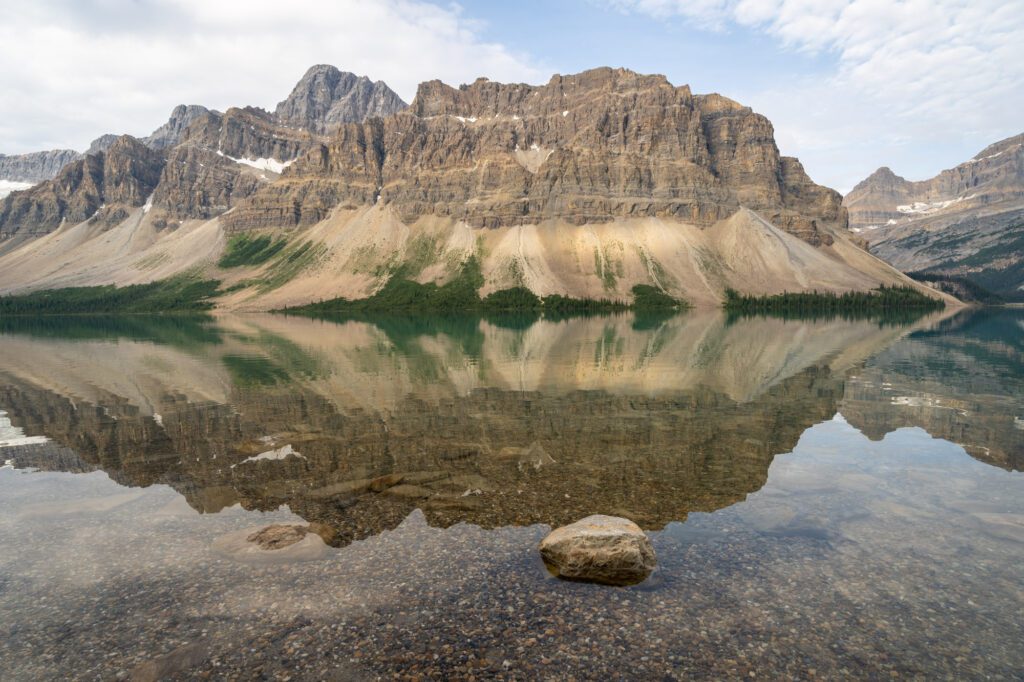
Disclaimer: Some of the links in this post, like hotel links, are affiliate links, meaning at no additional cost to you, we make a little bit of money if you click through and book. That being said, we would never recommend something to you that we don’t stand behind 100%.
How Many Days Do You Need for a Canadian Rockies Road Trip?
To see the best of Banff, Jasper, and Lake Louise (including Moraine Lake), you really need a MINIMUM of 7 days. It’s a lot of driving, and trying to pack it all in just 7 days is going to mean you’re missing key highlights and hikes.
Plus, with only 7 days, you basically have no flexibility when it comes to the weather (I’m currently writing this on a rainy July morning in Jasper).
We’ve written this Canadian Rockies itinerary for 10 days . Those extra few days allow you to get a little off the beaten path (to the extent that even exists in Banff and Jasper) to see some of Yoho National Park, a less-heralded park just west of Banff National Park, and have some flexibility to spend a rainy morning waiting for a break in the weather, if needed.
Plus, it gives you more time to dive deeper into the Icefields Parkway, the incredibly scenic road trip from Banff to Jasper, which deserves more than a couple of hours on your itinerary. We’ve got two half days dedicated to that drive, which is packed with raging waterfalls, epic vistas, and great hikes.
If you have more time (11-14 days) or less time (7-9 days), we have some ideas on how to alter this itinerary at the end.
If you have 7 days, you should also read our guide to planning a 7 day Banff and Jasper itinerary (coming soon-ish!), which packs the highlights into a week.
Where to Start and End Your Canadian Rockies Road Trip
This one is easy! If you’re coming from somewhere out of the area, the answer is going to be Calgary, which is about an hour and a half away from the town of Banff.
You’ll want to fly into Calgary International Airport (YYC) , which has some direct flights, but is likely going to require a connection if you’re not coming from one of the airline’s hubs. Still, it’s by far the most convenient airport to fly into.
If you’re coming from the Pacific Northwest like us, driving to the Canadian Rockies is doable, but you should keep in mind that it’s a long drive. We drove from Portland up to Vancouver, where we spent a couple of days before embarking on a Vancouver to Banff road trip .
Because it adds a significant amount of drive time (9 hours from Vancouver to Banff, one way), we’d only recommend this option for people with 14 days or more .
Do You Need to Rent a Car for This Canadian Rockies Itinerary?
The short answer is yes, we think you definitely need to rent a car to make the most of your trip to the Canadian Rockies .
And you should rent it on arrival at Calgary International Airport , and drop it off at the same location when you’re heading home.
However, I will say that, unlike our trip more than five years ago, Banff has come a long way in terms of public transportation, and it is now possible to piece together an itinerary using a combination of public transportation and guided tours.
There are public buses (via ROAM Transit ) between Banff and Lake Louise, Moraine Lake, Sunshine Meadows, and Johnston Canyon.
However, the thing to know here is that you’re going to be sacrificing A LOT of flexibility. While they exist, the routes don’t always come terribly often, and the first bus of the day is often later than we’d recommend getting the day started.
The other major downside is that you’ll end up missing a bunch of the stops along the Icefields Parkway, which would be a shame. There are tours that tackle it, but they’re not going to make as many stops as we think you should.
So, the long answer is that yes, you should definitely plan on renting a car, but it’s possible to put together an itinerary without driving.
How to Structure Your Canadian Rockies Itinerary
We’re adding this as a separate section up top because we think it’s pretty important to consider how you structure your itinerary to maximize your time.
At a high level, we’d break up your trip into three distinct parts, staying in a different place for each of them to use as a home base for the region.
Those three parts are Banff (and around), Jasper, and Lake Louise.
Here are a few reasons why we strongly believe that’s the best way to structure your itinerary.
The first thing to know is that it’s a 45-60 minute drive from Banff to Lake Louise. To make the most of your time and be able to see the lake multiple times without commiting to 90 minutes of driving each time, we’d strongly recommend trying to stay near the lake for two nights .
It’s worth seeing the lake at both sunrise and sunset, we think, and this will allow for an early start on the very busy trails. There aren’t that many options and they’re kind of pricey, but we think it’s worth it to avoid driving back and forth a bunch of times.
For the record, we did that on our first trip (but not on our second) and wish we had done it on that second trip.
The second thing to consider is that it will take you nearly four and half hours to drive from Jasper National Park to Calgary. For that reason, we’d recommend ordering your trip to start in Banff, head up to Jasper, and then return to Lake Louise at the end so that you’re set up for a more manageable drive back to the airport (2 hours, ish).
This is also true if you’re driving back home, unless you live in Edmonton, which is up near Jasper.
This is what the resulting 10 day trip looks like, at a high level:
- Day 1: Arrive in Calgary (Sleep in Banff)
- Day 2: Banff
- Day 3: Banff
- Day 4: Drive Banff to Jasper (Sleep in Jasper)
- Day 5: Jasper
- Day 6: Jasper
- Day 7: Drive Jasper to Lake Louise (Sleep in Lake Louise)
- Day 8: Lake Louise
- Day 9: Lake Louise / Moraine Lake
- Day 10: Drive Back to Calgary (Yoho in AM if you have time)
Where to Stay for This Itinerary
Now that we’ve covered some of the important logistics and laid out our thoughts on how to structure your Canadian Rockies itinerary, let’s talk about where to stay.
As we’ve covered already, we think you should break up your trip into three chunks – Around Banff, Jasper, and Lake Louise – and choose a home base near each place to use to explore.
This will cut down on driving back and forth, and allow you to get an earlier start on hikes and viewpoints, which is important in the summer when crowds are intense.
In this section, we’ll go through an overview where to stay for each of those regions. For more detail, including more options, you should go read our guides to where to stay in Banff (which includes Lake Louise) and where to stay in Jasper .
Staying Around Banff
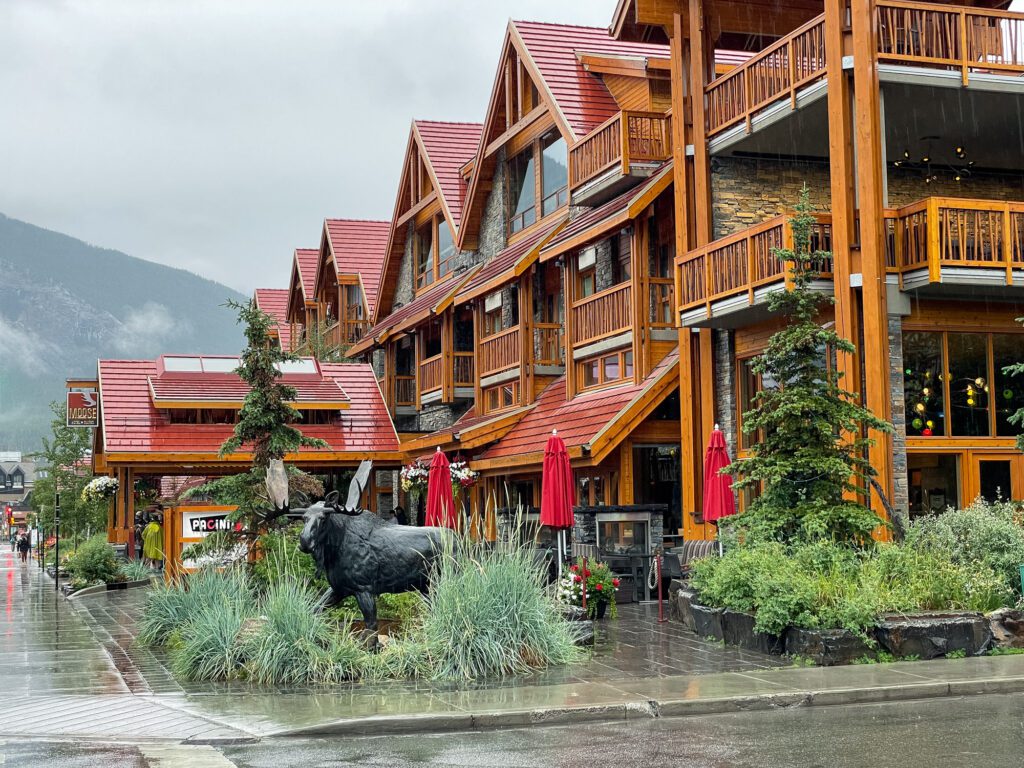
This is your first decision point, because you have two distinct options when it comes to choosing a home base for exploring around the town of Banff.
The two options are staying in the town of Banff, which is right in the middle of all the action, or staying in Canmore, a suburb (ish?) of Banff that is just outside the national park boundary.
In general, Banff is going to be a little more convenient in terms of location because it’s further west, closer to key trailheads like Johnston Canyon.
While Canmore is an extra 15 minutes away from things, it’s far more charming, with a better food and drink scene (we think) and a more laid back vibe.
Plus, it’s more affordable, and the accommodation options are more modern and updated (while some places in Banff feel a little dated because they’ve been constantly full for decades).
For what it’s worth, we’ve stayed in both places and, after this latest trip when we stayed in Banff, we decided we will always stay in Canmore on future trips because we like it better as a town, and it’s generally a better value.
In Banff, we stayed at Tunnel Mountain Resort , which is just up the hill from town on – you guessed it! – Tunnel Mountain. It’s a good location, with free parking and a bus line that runs right into town from right in front of the resort.
Our room was kind of a dim cave situation (which might be because we needed a dog-friendly room), and it probably needed a fresh coat of paint and some new fixtures to justify the price we paid for it. But, it’s Banff, so you’re never REALLY going to get a great value, are you?
We’d cautiously recommend it, especially if you need a dog-friendly place to stay with a kitchen, which is how we ended up there.
If you don’t need those things and you want to be based in Banff itself, look at Basecamp Suites Banff . We stayed at their location in Revelstoke and absolutely loved it – wish we’d stayed at their location in Canmore on this trip!
They have locations all through the Canadian Rockies, and this particular location is a suite hotel, where you have the amenities of a hotel like housekeeping and a front desk, while the units are all apartments.
Basecamp also happens to have multiple locations in Canmore , which is where we’d recommend staying if you’d rather stay in a less hectic town (and, also, is where we’ll be staying on our next trip).
Staying in Jasper

Jasper is a little more straightforward than Banff because you really only have two options here.
Your first option is staying at one of the many hotels right in town, which puts you within walking distance of all the amenities like grocery stores, restaurants and bars, and shopping in downtown Jasper.
Your second option is staying somewhere outside of town, which is going to be a more rustic experience, but is less convenient when it comes to accessing those aforementioned amenities.
For what it’s worth, we stayed at Bear Hill Lodge on our last trip, and absolutely loved both the cabins themselves, and the proximity to downtown Jasper (it’s a 10-15 minute walk).
Our other recommendations here would be either Pine Bungalows Resort , which is right across the river from downtown (though it’s not walkable), or the Pyramid Lake Lodge , which (as you might guess) is right on the shores of Pyramid Lake just outside of downtown Jasper.
Staying Near Lake Louise

As we’ve already covered, we really think the best way to experience Lake Louise is to stay nearby, which is what we’ve done on our trips, and we haven’t regretted it one bit.
There are very, very few options near Lake Louise when it comes to hotels, and there are two that stand out to us as a good value (we’re not counting the Fairmont Lake Louise here, which is far out of our budget).
The two options we’d recommend are Paradise Lodge and Bungalows , which is where we stayed on our first trip and it has since been renovated and expanded, and Basecamp Baker Creek , which is a little further out, but looks like a lovely place to stay operated by our favorite hotel company in the Canadian Rockies.
The other great option is Lake Louise Campground , which you’ll need to reserve basically when the window opens in the spring (that’s what we did).
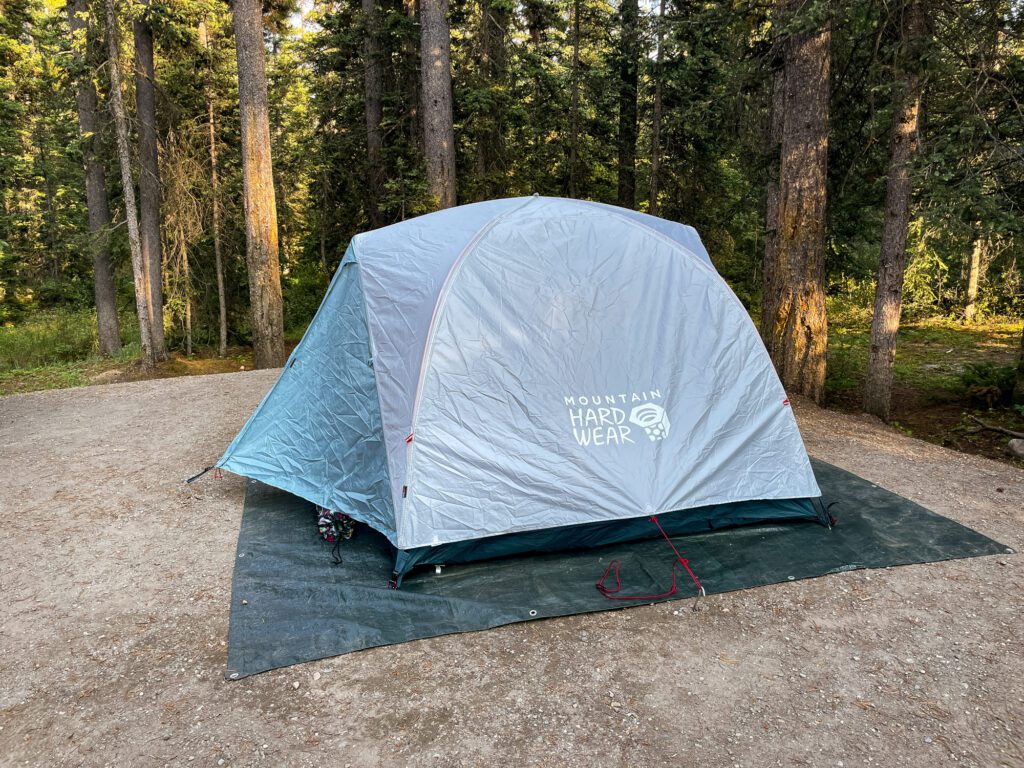
You can read more about the reservation procedures here , which are far more structured and relaxed than the US National Park processes. Obviously, that only works if you have camping gear with you.
The Best Time to Do This Canadian Rockies Road Trip
Summer and early fall, between July and mid-October, is going to be the best time to do the road trip we’re going through in this guide .
You’ll have the best weather, snow-free trails and roads, and longgggg days (we’re here in July, and sunrise is at 5:30am, sunset is at 10pm) to explore.
The big downsides of summer are crowds and prices , and they’re somewhat related. Summer is, by far, the most popular time to visit, which means trails are packed, and prices in Banff and Jasper are at an all-time high.
If you’re visiting in the summer, you’re going to want to book your accommodations as early as possible, too. Same with campsites – book them on the day they go on sale (which you can find here ).
Banff is a good winter destination, too, but that trip is going to look very, very different, with more skiing and snowshoeing, and less driving around and hiking. Keep in mind that winter driving is serious business in the mountains, and many roads require winter tires from October/November to April.
This is particularly important for the Icefields Parkway, which closes intermittently in the winter due to storms. Once you drive it yourself, you’ll understand why it wouldn’t be ideal to drive it during a winter storm.
Things to Know Before Your Canadian Rockies Road Trip
We’re going to use this section to cover important logistics – like shuttles, permits, and safety tips – that you should know before you hit the road.
Park entry fees and passes . You’ll need to pay a fee when you’re in any of the national parks on this itinerary. You have two options – buying a pass for the number of days you need it for, or buying a Discovery Pass, which gives you access to all national parks in Canada for a full year. At a high level, the math on the Discovery Pass works out if you’re spending 7 days or more in the parks ($10.50 per day, $72.25 for an annual pass) though there are some permutations around family passes that might make the math change in your particular instance. You can buy both versions at the park entrance stations, or online in advance .
Remember that you’re at elevation . The town of Banff sits at 4,500 feet above sea level, and Lake Louise is at 5,250 feet above sea level (Jasper is slightly lower). Two things to know here – stay hydrated, and give yourself a day or two to acclimate if, like us, you’re coming from around sea level. This is the reason we have you starting off with a lower intensity hike on the first day of the itinerary below.
Expect it to be busy busy busy . If you’re in the Canadian Rockies in the summer, don’t expect to find a whole lot of solitude unless you head into the backcountry (and even then…). The best way to avoid crowds is to get a very, very early start. We arrived before 8am to trailheads (before 7am at Lake Louise), and found that we were often one of the first few groups on the trail, with far more people coming up the trail as we headed down.
Book your Lake Louise and Moraine Lake shuttles ASAP . Especially if you want to get on one of the early morning departures, which you should. We’ll cover getting to Lake Louise below (if you choose to drive, get there before 7am to secure parking and be ready to pay $21 for the day), but Moraine Lake is only accessible via shuttle, and it’s SUPER competitive. You need to book it in advance, which means you’re unfortunately going to have less flexibility when it comes to weather. More information on the shuttles here .
Know where to find gas stations . You’ll want to have a full tank of gas as you start your drive on the Icefields Parkway, because there’s exactly one gas station between Lake Louise and Jasper at the Saskatchewan River Crossing, and it’s more expensive than getting gas elsewhere. There are plenty of gas options in Canmore, Banff, Lake Louise, and Jasper.
Wildlife is…wild . Banff and Jasper are amazing places to see wildlife. On this last trip, we saw Grizzly bears, black bears, elk, moose, bighorn sheep, mountain goats, tons of marmots, among other things. However, it is very very important that you remember that these are wild animals we’re talking about, and your actions impact their lives. Give them plenty of space, and avoid stopping in the middle of the road to gawk at them (though this inevitably happens – make sure to pull off the road and stay in your vehicle). Read this Parks Canada guide to responsible wildlife viewing before your trip.
Planning a Picture Perfect 10 Day Canadian Rockies Road Trip Itinerary: A Complete Guide
And now, on to the actual itinerary!
We’ve written this as a day-by-day itinerary, with suggestions on exactly how to spend each day.
Obviously, as you’re planning your own trip, things are going to come up like shuttle availability and weather.
So, while you could just copy and paste this itinerary, you’re probably going to have to shift some things around.
That being said, we’d strongly recommend keeping the Banff-Jasper-Lake Louise structure intact, if you can.
Remember that structure as you’re reading through the itinerary, because it means that the highlights of Lake Louise and Moraine Lake are at the end of this itinerary (days 8-10), where you’ll find some useful tips on accessing the lakes, hiking, and more.
Day 1: Arrive in Calgary, Drive to Banff, Two Jack Lake for Sunset
Your first day is going to be at least half travel time, depending on when your flight lands in Calgary. We’d strongly recommend booking the earliest possible flight in (and the latest one on the way out) to maximize your time in the Canadian Rockies.
You’ll land in Calgary (assuming you’re flying in) and head over to the rental car agency to pick up your car.
It takes about two hours to go from the airport to Banff, depending on traffic and where exactly you’re going. Head to your accommodations, check in, drop your bags, and set out for an afternoon of exploring nearby.
If you’re not flying into Calgary to start your trip, you’ll want to make your way to Banff (and you’ll likely have an extra half day or so in and around Banff to hang out).
Lake Minnewanka & Scenic Drive
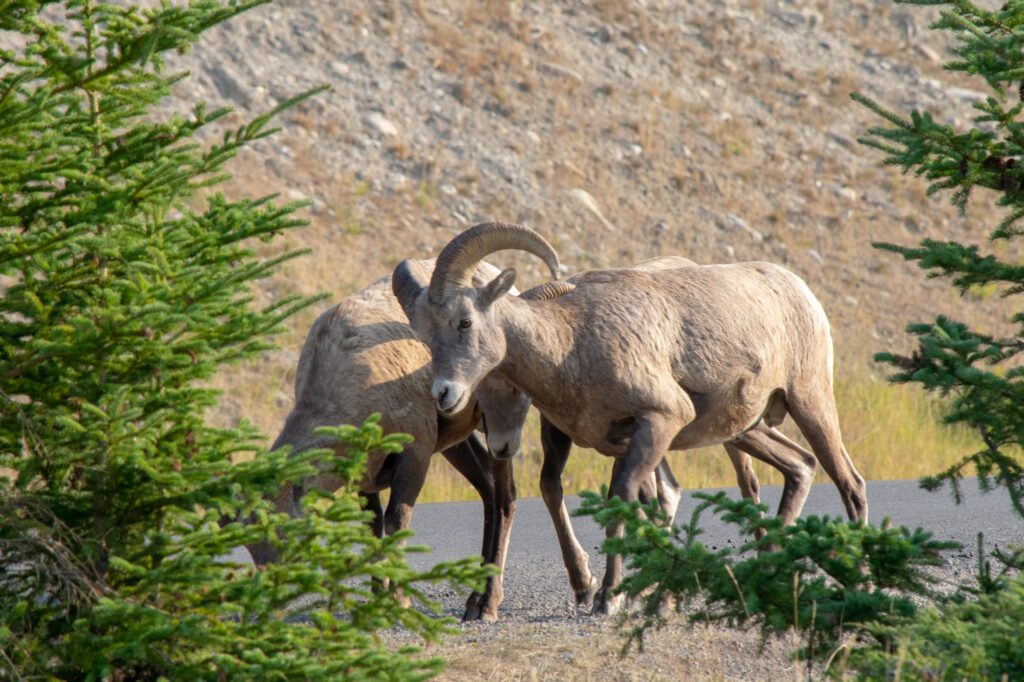
Your first stop is going to be Lake Minnewanka, which is a massive lake out to the east of Banff. It’s only about 15 minutes away, but by the time you’re on the lake, you might as well be in the middle of nowhere.
The drive out to the lake (and between this lake and Two Jack Lake, which is SPOILER ALERT your next stop) are particularly good places to see wildlife like bighorn sheep and elk. We’ve seen both, multiple times, along this road.
There are a couple of things to do at Lake Minnewanka, and the first is definitely the boat cruise (which we skipped because of the dog, but we absolutely would have done it if we were sans Lupine).
The cruise takes you out to Devil’s Gap at the far end of the lake, and brings you back. More information here .
The second thing we want to call out is renting a canoe or kayak . The lake is huge – it’s 13 miles long! – and it’s impossible to get very far on foot (more on that in a second). Getting out on the water in your own watercraft will allow you to get out to different parts of the lake that most people never make it to.
The third and final thing is hiking around Lake Minnewanka . There are two trails in particular that we’d consider.
The first is the simple lakeshore trail , which isn’t totally flat, but also isn’t a huge climb and would make a good first hike as your body gets acclimated to the elevation in the Rockies. This is a nice option because you can easily customize it to how you’re feeling, going for a mile or two and then turning around, or going the entire way to the end of the maintained trail.
The second is C-Level Cirque , which is a short but intense hike up to a rocky bowl with great views back towards the lake. It does involve some scrambling near the top, but it’s relatively easy compared to some of the other scramble trails in the area.
Two Jack Lake at Sunset

Spend your first sunset in Banff at nearby Two Jack Lake, which is a smaller (but arguably equally picturesque) lake near Lake Minnewanka.
Park in the lower parking lot and grab one of the picnic benches, either on the beach right there, or on the little spit out to the right, and watch the golden glow of the setting sun over the silhouette of Mount Rundle in the distance.
Day 2: Vermillion Lakes, Johnston Canyon, & the Town of Banff
On your first full day in Banff, start with an early morning (ideally, sunrise) trip out to Vermillion Lakes to admire the reflection of the curved peak of Mount Rundle in the still water of the lake (and look for elk and moose along the shoreline).
Then, tackle your first hike of the trip into Johnston Canyon (with an optional extension to the colorful ink pots) before spending the afternoon and evening in the town of Banff.
Vermillion Lakes
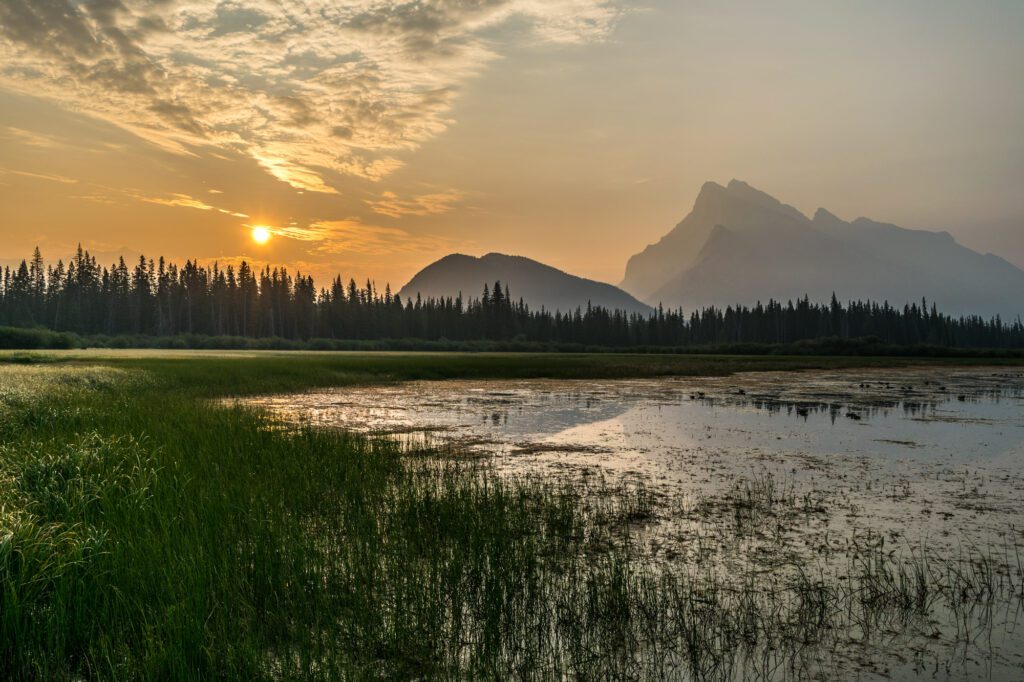
We love Vermillion Lakes at any time of day, but it’s particularly special in the early morning and late evening hours when the water of the lake is calm and you have the chance to get a perfect reflection of Mount Rundle in the still water.
This is a very popular spot for photographers for obvious reasons, and our favorite photo spots are along the stretch of shore just outside of town ( here on Google Maps).
This also happens to be a great place to see wildlife – we have seen elk along the road, and a variety of birds out on the lake (plus, muskrats).
Johnston Canyon (and the Ink Pots?)

From Vermillion Lakes, head over to the Bow Valley Parkway to start the drive to your hike for the day, Johnston Canyon (with an optional extension for the Ink Pots).
Johnston Canyon is a unique experience, but it’s one that you really need to have before the crowds show up. We would arrive NO LATER than 8am or so for this hike, but the earlier the better .
At about 10am, the narrow boardwalk is packed with people. We know, because we came back down the trail and spent two miles trying to keep Lupine on one side of the narrow boardwalk when there were just SO MANY PEOPLE to get pets from.
The hike is worth it, though. You’ll follow a boardwalk through a canyon with high walls and a river running through it, and the crown jewels of the hike are the upper and lower falls.
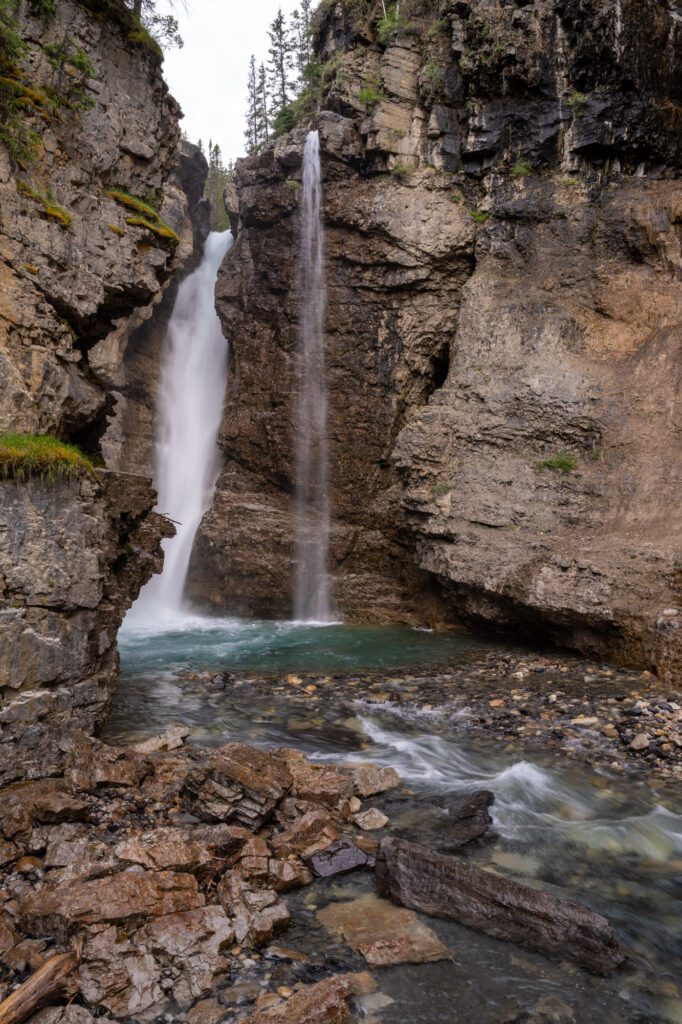
Looking for another reason to get an early start? The lineup to see the falls at 11am or so was wild.
Here’s a picture.

Looking to escape the crowds? We have some good news. The vast majority of people only go to one or both of the falls, which means you’ll have the continuation of this hike out to the Ink Pots – colorful pools in a beautiful valley – largely to yourself.
To get to the Ink Pots, it’s about a 2 mile hike in the woods, climbing the entire way. It’s a bit of a slog – there are no views or redeeming features of that stretch of trail to speak of – but the end point is worth it, we thought.
The Ink Pots are cool because they’re formed by thermal activity, but they’re not hot like thermal pools in Yellowstone, for example.
If you look closely at the bottom of the pools, which is made easy by the fact that they’re completely clear, you’ll see little swirls at the bottom which is where the water is coming up from below.
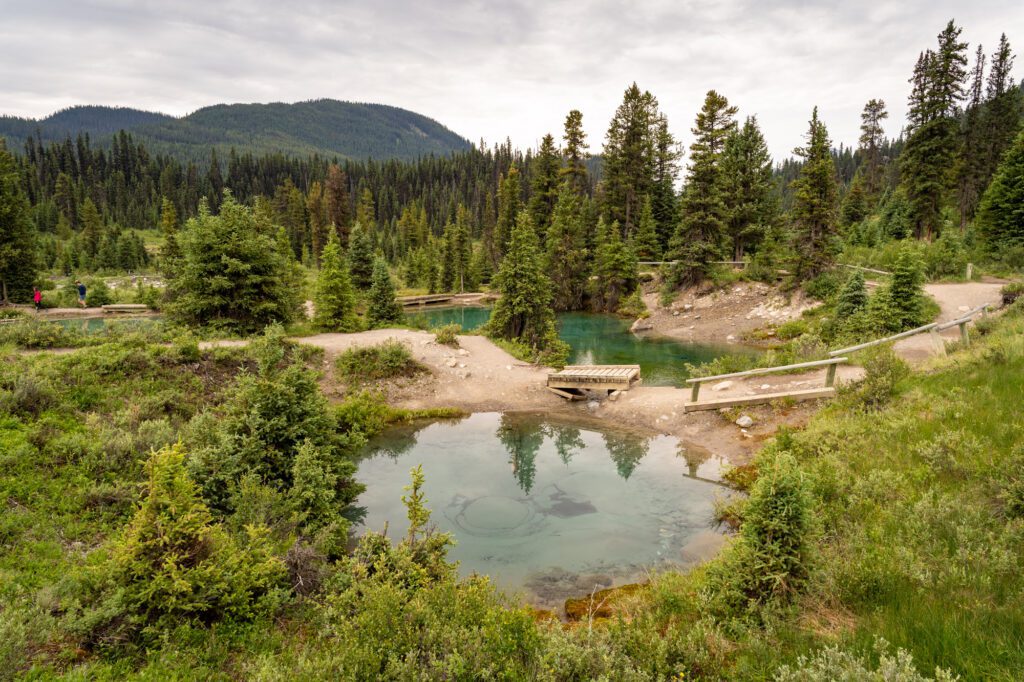
They’re particularly stunning on a sunny day, when the rays of the sun make them vibrant and bright, but we were there on a cloudy day and still thought it was worth the journey.
Exploring the Town of Banff
Spend your afternoon in and around the town of Banff, which is on the one hand very “touristy” in the sense that nearly everyone you’ll encounter outside of service workers is a tourist, but also has some pretty cool spots to check out.

The main drag in town is (unsurprisingly) called Banff Avenue, and it’s where you’ll find the vast majority of restaurants, shops, and other places of interest in that vein. However, there are also a couple of walkable/driveable places with nice views that are worth seeking out.
Here are a few of our favorites.
- Surprise Viewpoint: This is the classic view of the Fairmont Banff Springs Hotel backed by the mountains. You can walk there from town, but it is uphill along a busy road. However, that’s probably preferable to navigating the parking situation, which is usually full of tour buses.
- Bow Falls: Probably not the most impressive waterfall you’ll see on this trip (especially if you make it over to Yoho National Park), but definitely the most accessible from downtown Banff thanks to the short flat riverside trail. Arguably the best views are actually not of the falls, but of the mountains towering over town (Norquay and Rundle).
- Cascade of Time Garden: This was Alysha’s discovery, and it’s worth walking through on your way back to town. It’s a little oasis with nice views of downtown Banff and some fun landscaping.
If you’re up for a little more walking, you can do all three of them as a fun little loop from town. Here’s a map of what that looks like.
There are also plenty of bars and restaurants in town for dinner and drinks.
Here’s the Eater guide for the Canadian Rockies for some inspiration. Special shout outs for the Balkan (where we’ve eaten and enjoyed) and to the Bistro at the Juniper Hotel for the views (we haven’t eaten there, but have admired the views and considered it).
Day 3: Choose Your Own Hiking Adventure & Canmore
On your second full day in and around the town of Banff, enjoy a morning hike before heading down the road to Canmore, a charming little mountain town that quickly became our favorite place to go to eat, drink, and shop.
Choose Your Own Hiking Adventure

While we like to hike a bunch of miles a day when we’re in the Canadian Rockies (less so as we get older and recovery becomes harder!), we also recognize that not everyone is up for 10 miles a day.
For your hike today, you have a few options depending on what you’re up for.
If you are up for some mileage, we highly recommend Healy Pass . It’s a long hike, but it’s relatively easy in terms of elevation gain and intensity.
And the views from the pass are downright magical, especially in the early summer when the meadows are blanketed in wildflowers and fall when the larches are golden.
- Healy Pass (11.1 miles / 2,814 feet elevation gain): We loved this hike. It’s a must-do if you’re in the Rockies in early summer (call it mid-July?) for the stunning wildflowers or mid-October when the larches are lighting up. From the pass, you have a nice view of the Ramparts and the Monarch in one direction, and the peaks backing Egypt Lake in the other. It also leaves from the Sunshine Meadows parking lot, which is giant, which means there’s no parking nightmare.
- C-Level Cirque (5.8 miles / 2,490 feet elevation gain): We mentioned this earlier as an option around Lake Minnewanka, and we’re mentioning it here again as a moderate option that’s an easy drive from Banff. You climb up through the forest for the first few miles before emerging into a rocky bowl, at which point it’s a quick scramble up to a viewpoint back towards the lake.
- Tunnel Mountain (2.7 miles / 879 feet elevation gain): If you’re looking to take it easy for the day, we really enjoyed Tunnel Mountain. It’s a quick drive (or walk, depending on where you’re staying) from Banff, and the trail is the kind that gets you sweating a little bit, but not so much that you can’t wear those same clothes later. There are some nice views out in both directions from along the trail, with the final view looking out over Banff and the valley beyond.
Exploring Canmore
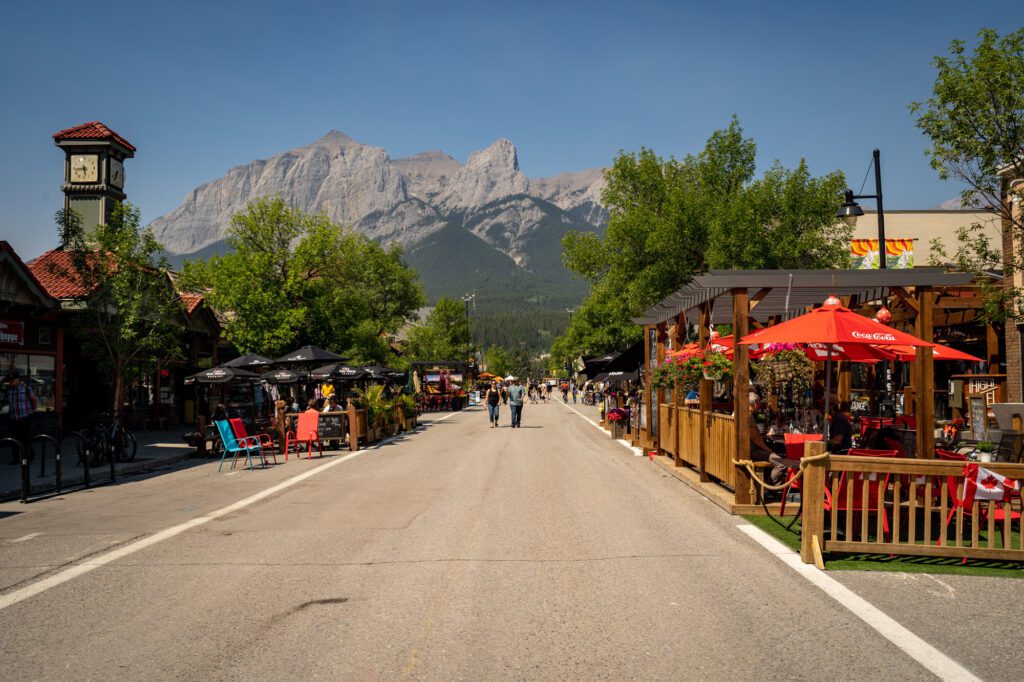
For the afternoon, head 15 minutes east from Banff over to what turned out (again) to be our favorite town in the Rockies, Canmore.
We liked Canmore so much that, while we will definitely be back to the Canadian Rockies and Banff National Park, we will likely never ever stay in the town of Banff again. It’s all Canmore for our future selves!
Canmore is our ideal version of a small-ish mountain town, because while it is very clearly on the tourist track (it’s 15 minutes from Banff, though it is technically outside of Banff National Park), it also feels like people actually live there. Which is not something we’d ever say about Banff.

The fact that people actually live in Canmore (the population has been increasing, especially since the events of 2020 and the rise of remote work) means that, unlike Banff where, for example, there is not one single good coffee shop, there are a bunch of businesses catering to both tourists and locals.
And it’s truly just as beautiful as Banff, with downtown Canmore sitting along the Bow River, backed by the Three Sisters – which you’ll see and hear a lot about in the brief time you spend in Canmore.
Similar to Banff, there’s one main drag in Canmore – 8 Street – and that’s where we’d recommend you start with your explorations.
Here are a few of our favorite spots in Canmore.
- Eclipse Coffee : This was a recommendation from the barista at Prototype Coffee , one of the best coffee shops in Vancouver , and I’m so glad I mentioned that the Banff area doesn’t have any good coffee because I was SO wrong. They have two locations – one right on the main drag, and one over near the Safeway in a strip mall – and they roast their own beans. If you’re looking for good coffee in Canmore, head straight to Eclipse – do not pass go, do not collect $200.
- Mixed Culture : For the best selection of craft beer, cider, and wine in Canmore, go here. This is another one we stumbled upon, and the owner was extremely helpful in helping us choose some ciders AND gave us a great tip on finding wineries in the Okanagan Valley by connecting us with his natural wine distributor’s online guide. Highly recommend if you’re looking for some cans or bottles to enjoy at camp, or at a lake, or basically anywhere.
- Core Values Cider : On the recommendation of the owner at Mixed Culture, we moseyed over here to find them working hard on their new taproom, which should be open now (late summer 2023). I was definitely not expecting to find a cidery in Canmore, but here it is! They specialize in dry, wild-fermented cider too, which is very much in our wheelhouse.
- Communitea : We’ve now eaten here four or five times over a few trips, and are deeply in love with this little corner cafe in Canmore with a great food and tea menu. We like the Pad Thai (even though it’s not REALLY pad thai, if we’re being honest) and basically all of the salads and bowls. Good gluten free options, too).
- Stonewaters : We stumbled upon this cool store, which is a fun place to pop into for locally made (mostly, anyway) gifts, cards, and other fun stuff.
- Lovely Ice Cream : Right outside of Stonewaters is a little cart slinging cups of ice cream and ice cream sandwiches, all gluten free! We went here multiple times, and would recommend it for a nice sweet treat.
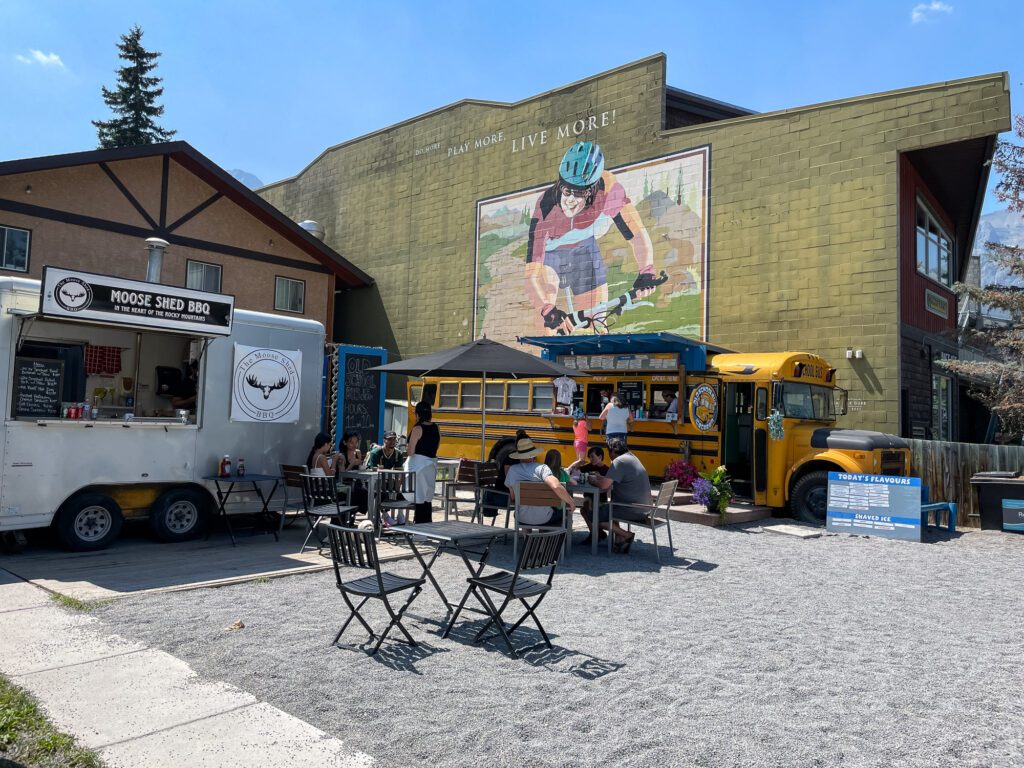
Aside from the food and drink (and shopping) scene, there are a few other spots in Canmore that are worth your time.
- Bow River Trail: We don’t have a specific route, but we do think you should walk along the river out to the Canmore Engine Bridge ( here on Google Maps), which is a cool view with the bridge in the foreground over the river, with the Three Sisters in the background.
- Three Sisters Viewpoint: This is a drive from downtown, but it’s the best view of the Three Sisters. It requires some navigation (park here and walk under the railroad tracks), but there’s a little pond with a nice reflection of the peaks. If you’re into photography, it’s worth coming back at sunrise, when the alpenglow lights up the Sisters just before the sun crests the horizon.
- Grassi Lakes & Quarry Lake: Some short hikes near Canmore, also with nice views of the Three Sisters. Quarry Lake is in a nice park with an easy, flat trail along the lakeshore. Grassi Lakes is a little more involved, and takes you out to a couple of bright greenish-blue lakes.
Mount Norquay for Sunset

End your day up at Mount Norquay, which is across the Trans-Canada Highway from the town of Banff.
This was, perhaps, our favorite discovery of our time in Banff itself, because it’s hard to beat the view of Rundle towering over the city from the grassy slopes just below the parking area for the ski resort (which is what Mount Norquay is really famous for in the winter).
The lookout is almost the entire way up the mountain ( here on Google Maps), and this would be an excellent place to watch the sunset with one of those beers, ciders, or wines that you got at Mixed Cultures in Canmore earlier in the day.
Plus, this is one of the better places in Banff to see Bighorn Sheep – we saw a family (including babies) on the road on the way up, and got out the telephoto lens to watch them frolic a little bit.
Day 4: Driving the Icefields Parkway from Banff to Jasper
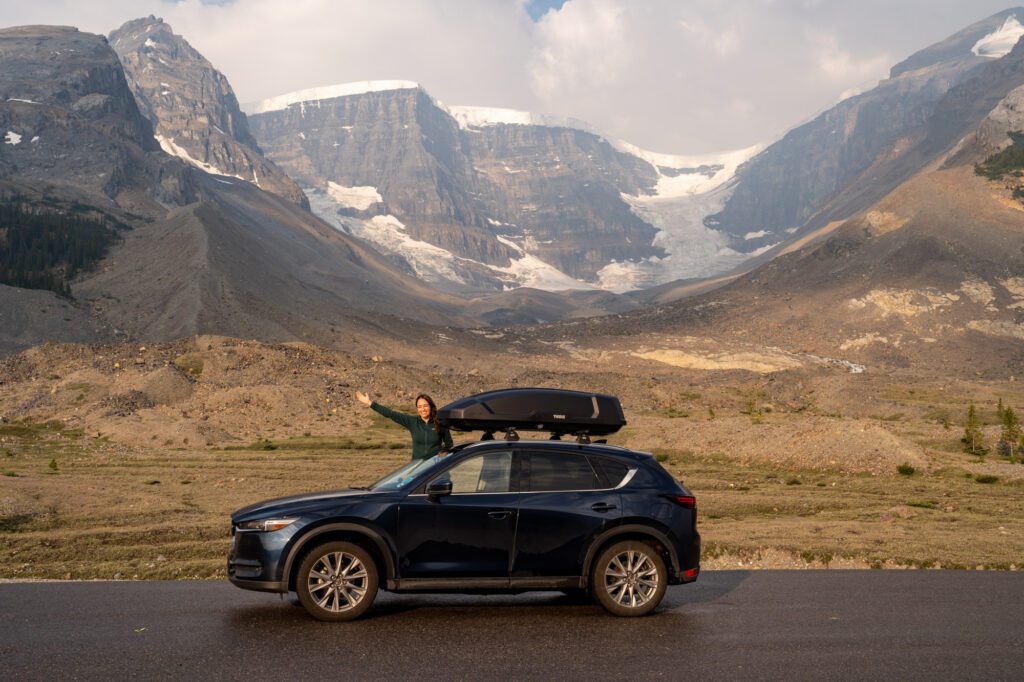
Today, the star of the show is the Icefields Parkway, which is the incredibly scenic drive from Banff to Jasper that will leave your jaw on the floor of the car at every bend in the road.
The first time we ever did this drive, it was so smoky that you could not see 50 feet in front of you, so we truly had no idea what we were missing until we came back down from Jasper on a clear day, and were flabbergasted at the sheer natural beauty on display along this two and a half hour drive.
We’ve allocated basically a day and a half of this itinerary to this drive, and we’d definitely plan on taking your time here, stopping often for short walks out to viewpoints.
We have an entire guide to driving the Icefields Parkway , which you should read for a full list of all the stops we’d recommend along the way. Here is a selection of our favorites, including a great hike to do along the way.
If you miss a stop on the way up, you have to make the drive back down in a couple of days anyway, so you can hit it then!
The Helen Lake Trail
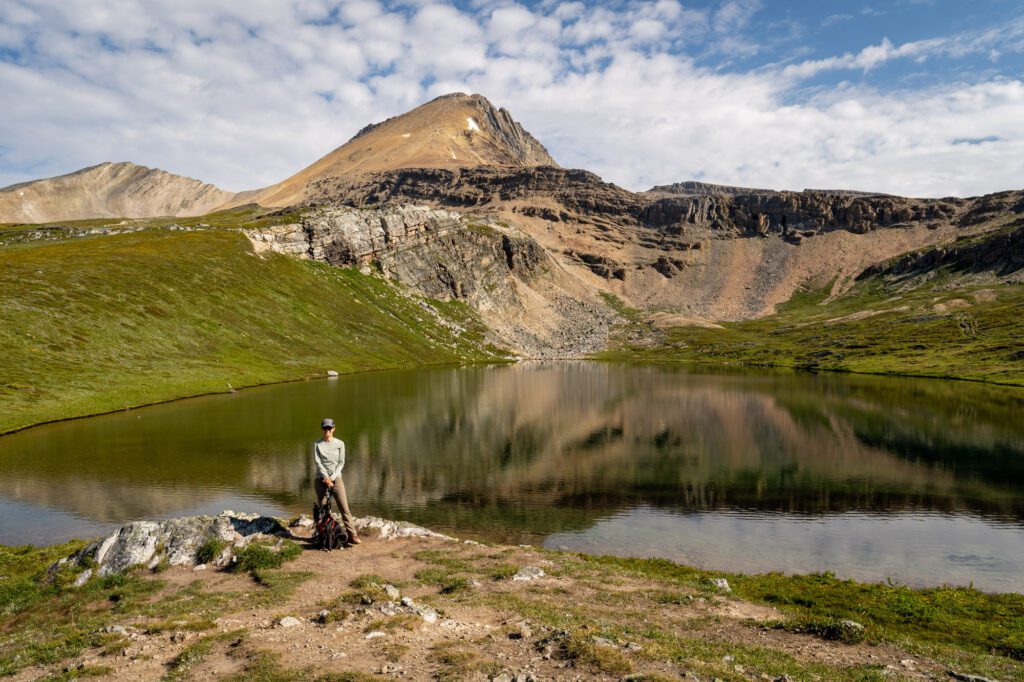
The trailhead for Helen Lake is just across the Icefields Parkway from the first Bow Lake viewpoint, and it fills up in the morning on most summer days.
The trail climbs through the forest for the first mile and a half or so, oscillating between mostly flat sections and sections that are surprisingly steep and rocky, making it seem harder than it is.
As you climb, you’ll start to get some nice views of Bow Lake behind you, so make sure to turn around and admire it when gaps in the trees appear.
The real show starts when you get above the treeline into a vast alpine meadow, full of flowers and marmots galore (at least in the early summer).
This stretch of trail is excellent, and it’s a slight uphill grade all the way up to the lake.
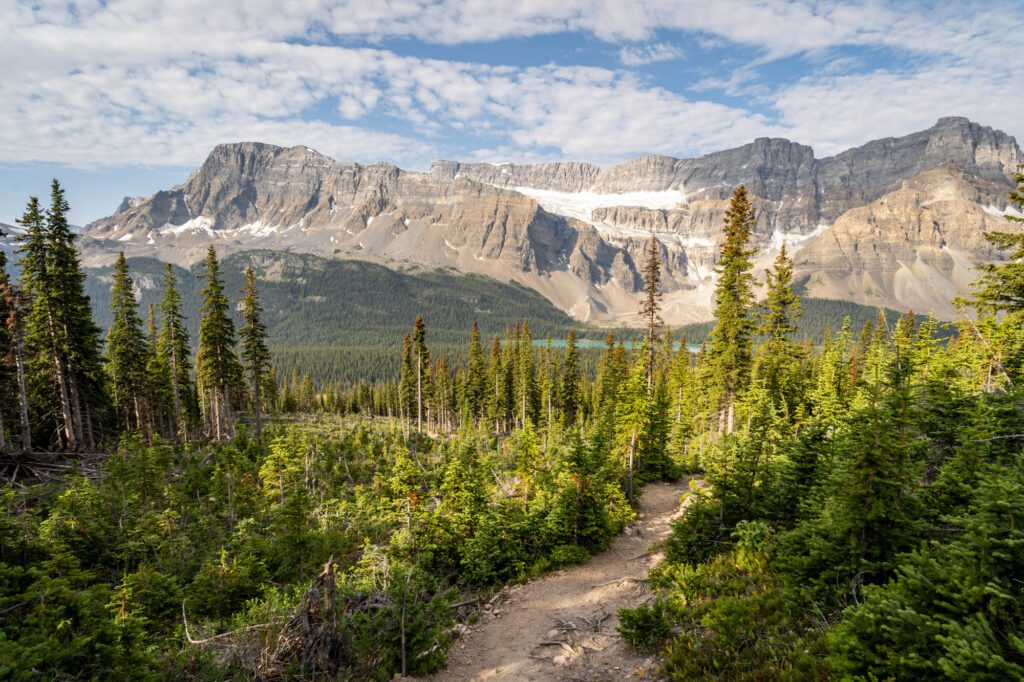
From the lake, you can continue on to the top of Cirque Peak, the mountain you see on the far side of Helen Lake. It’s another few miles (round trip), and double the elevation gain (including scrambling and route finding), so it’s not for the faint of heart.
We skipped it, but we did go around the lake and climbed the switchbacks on the far side to get a view back over the lake, which we’d recommend.
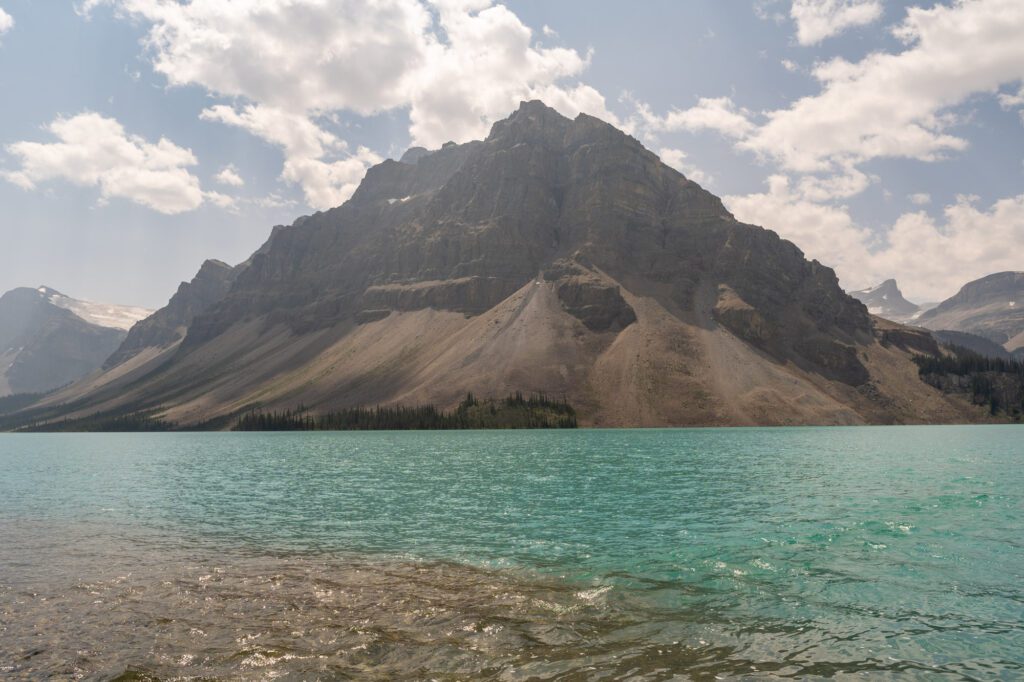
Bow Lake is one of the many majestic glacial lakes on the Icefields Parkway that features that brilliant turquoise water thanks to the glacial sediment in the water. It’s backed by Crowfoot Mountain (and the glacier of the same name).
There are two things to do at Bow Lake.
The first is to stop at the Bow Lake viewpoint , which is basically right across the road from the Helen Lake trailhead ( here on Google Maps). From there, if you get down to the water level, you have a great view of Crowfoot Mountain across the cloudy blue water of the lake.
The second is to park at the historic Num-Ti-Jah Lodge on the northern shore of the lake and explore that area.
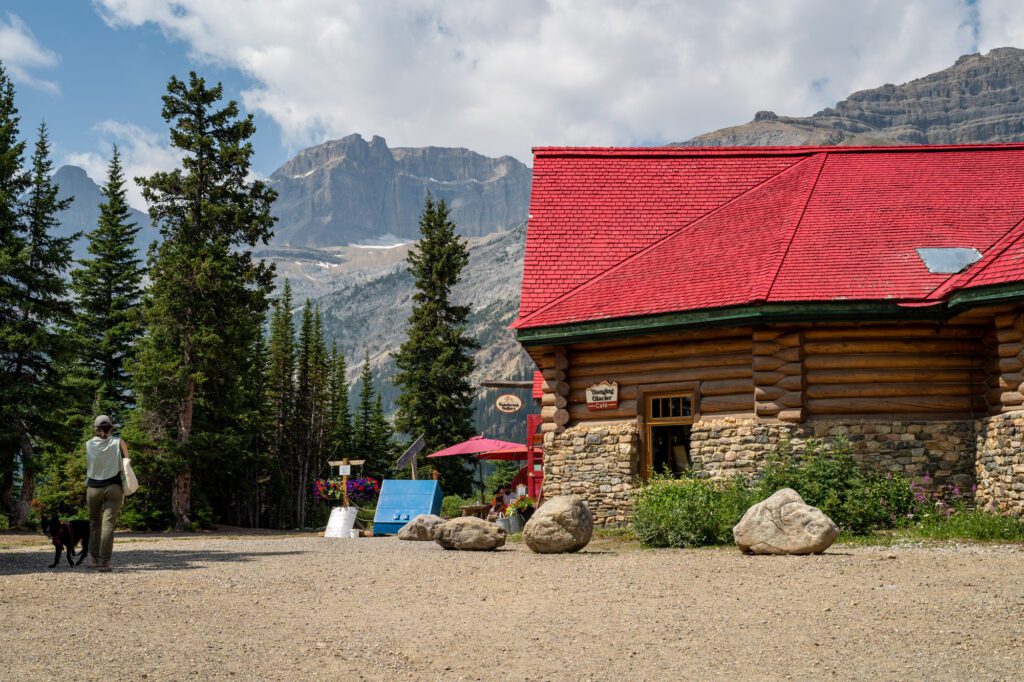
The cafe at the lodge, which has a nice little outdoor patio, is a good place to grab a snack and a cup of tea or coffee (or in our case, a well-earned cider from Core Values in Canmore).
Just a few steps from the cafe is the lakeshore, which has some pretty spectacular views.
We definitely think you should leave the crowds behind and walk out along the northern shore of the lake for a bit, where you’ll get a nice view of Crowfoot and a distant view of Bow Glacier falls in the distance.
If you’re up for it, there’s also a hike around the lake up to Bow Glacier Falls .
We skipped it, opting to do Helen Lake, Wilcox Pass, and Parker Ridge instead. However, all three of those hikes are fairly intense, while Bow Glacier Falls is in the easy/moderate category. It’s a good option if you’re looking for something a little more low-key.
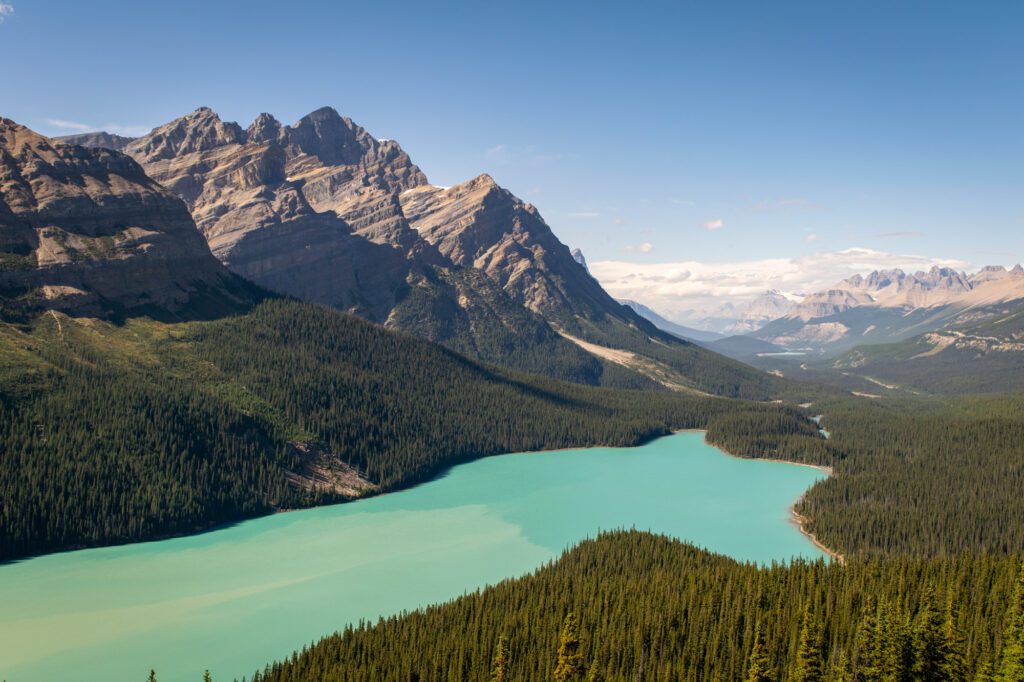
If you’ve seen pictures of Banff, you’ve probably seen at least one picture of Peyto Lake.
It’s that vibrant turquoise glacier-fed lake. Oh, there are tons of those in the Canadian Rockies? Right. Peyto Lake is special because you view it from above, and have the mountains backing it.
The timing here is a little unfortunate – if you follow this itinerary, you’ll be hitting the lake in the afternoon sometime, and that happens to be the busiest time to be there.
But there’s no real way to fix that (unless you skip the hike to Helen Lake, in which case we’d probably go here first then double back to the other stops), so it is what it is!
It’s a short half mile walk to the upper viewpoint, which you’ll certainly be sharing with hundreds of your new closest friends.
The Columbia Icefields Discovery Center
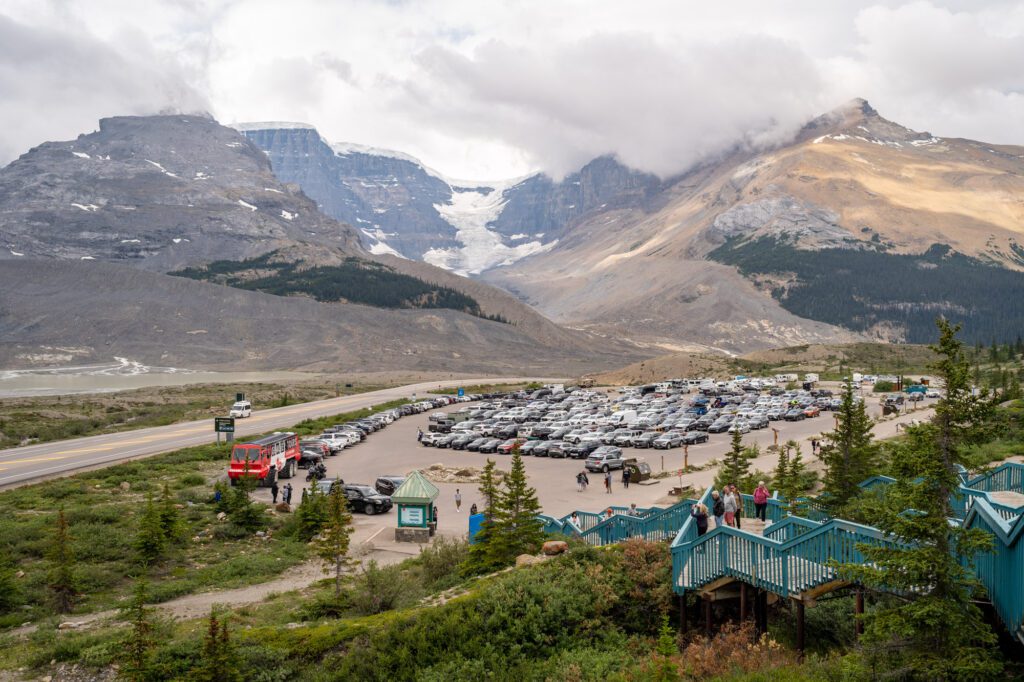
After another hour or so of driving (there are a couple of stops along the way that are worth making, like Waterfowl Lakes and Mistaya Canyon), you’ll cross over the border into Jasper National Park (saving our favorite hike, Wilcox Pass , for the trip back down to Banff) and arrive at one of the most impressive parts of the drive: the Columbia Icefield.
Which, by the way, is the largest icefield in North America (though it is shrinking at an alarming rate). There is 125 square miles of ice here, and from the roadside pullouts and Discovery Center, you’re only seeing an impossibly miniscule fraction.
If your vision for your trip includes walking on a glacier, this is the place to do it. You can’t go by yourself, though. You can book an Ice Walk to get out with a guide and all the equipment you need.
It’s worth stepping inside the Discovery Center and going to the lower level, where there is a cool interactive display that talks all about the ecosystems here.
Athabasca & Sunwapta Falls
This pair of waterfalls will be among your last stops as you roll into Jasper at the end of the day. They’re fifteen minutes apart, and they are both worth stopping for.
Athabasca is the first one you’ll encounter as you’re driving north. To be honest, it’s hard to take a picture of this waterfall that really does it justice because it comes through a little gorge, which obstructs the view of the falls from straight on.

From the side, you can see the top of the falls, but you don’t get the view of the 80 foot drop.
Follow the trail from the parking lot to see the falls from multiple views, including the two we just mentioned.
Aside from, you know, the beautiful waterfall, the best part about Athabasca Falls is the short hike down into the canyon, which a tiny fraction of the people at the falls actually do. From there, you get a more bottoms-up view of the canyons formed by this impressively powerful waterfall.
Sunwapta Falls is a little further up the road, and is arguably more impressive, with the island of trees in the middle of the river just before it tumbles over the falls.

The drop here is shorter than Athabasca at just 61 feet, but we prefer the views of Sunwapta.
From Sunwapta Falls, it’s a nice short drive into the town of Jasper, which will be your home base for the next few days.
Day 5: Wildlife Drive, Maligne Lake, & Maligne Canyon
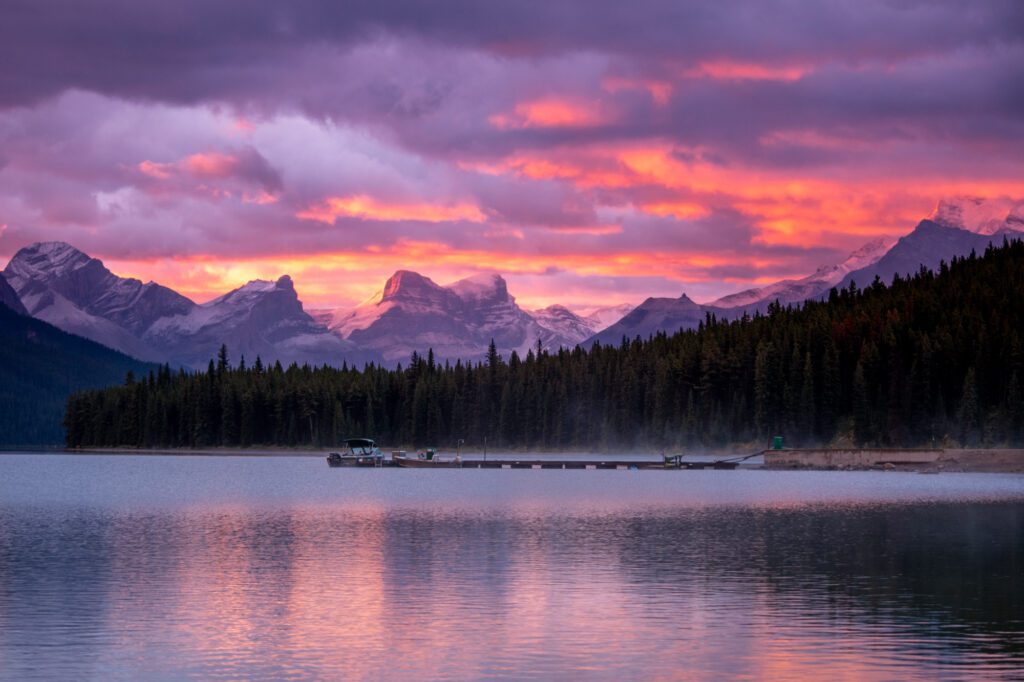
Jasper is more “wild”, for lack of a better word, than Banff, which probably has to do with its more remote location.
While Banff is an easy two hour drive along the Trans-Canada Highway from Calgary, Jasper takes around four hours to get to from nearby big cities like Calgary or Edmonton.
For that reason, along with the fact that many people who visit Banff just never make it up to Jasper because they have limited time, it feels more rugged and out there than most places in Banff.
However, with 7-10 days, we definitely think it’s worth visiting, and two days is a good amount of time to spend in and around Jasper.
One thing we will say about Jasper is that it just doesn’t have the amenities that Banff has. We found Nesters to be the best grocery store in town, and loved both Sunhouse Cafe (coffee and tea) and Neighborhood (wine and small plates), but that’s about all we got excited about.
On your first full day in Jasper, you’ll tackle what we think is the main attraction – Maligne Lake – and the surrounding area. It’s an hour-long drive from the town of Jasper out to Maligne Lake, but there are two nice stops along the way in Medicine Lake and Maligne Canyon that are worth your time.
We’re organizing the day as Medicine, Maligne Lake, Maligne Canyon to optimize for wildlife viewing in the early morning at both Medicine Lake and Maligne Lake, which does mean you won’t have Maligne Canyon all to yourself. But that’s the order we’d recommend.
Medicine Lake
While this entire stretch of land is a great place to see some wildlife – we saw a mama moose and her baby completely by accident in the parking lot of the Bald Mountain trailhead before sunrise – Medicine Lake is renowned as a hotspot for seeing moose, elk, bighorn sheep, and more.
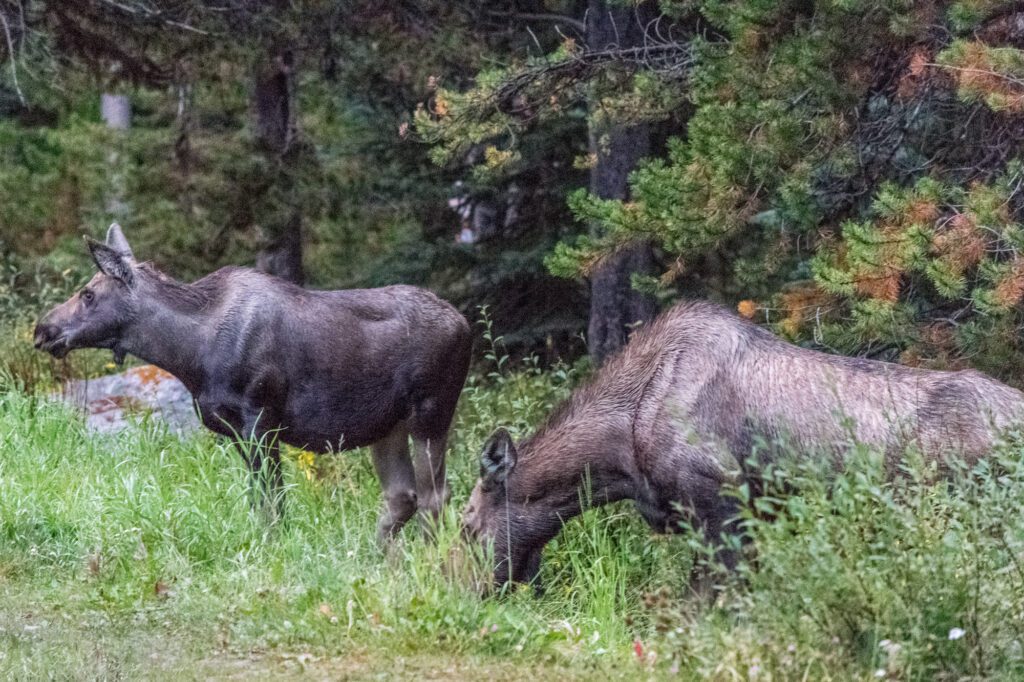
As we’ve already mentioned in some of the Banff sections, the best time to see wildlife is going to be dawn and dusk, so if you’re serious about it, you’ll want to be out at Medicine Lake around sunrise (an early wake up call, we know).
For what it’s worth, we’ve always had our best luck seeing wildlife within an hour of sunrise or sunset.
Aside from the wildlife, there’s not much to do at Medicine Lake. It’s worth noting that the lake is actually seasonal, and disappears when the water runs out (which is unusual in the Rockies, which is full of glacier-fed lakes).
You’re about halfway to your destination here, so you’ll continue your drive onwards to Maligne Lake once you feel like you’ve seen enough.
Maligne Lake (+optional boat cruise)
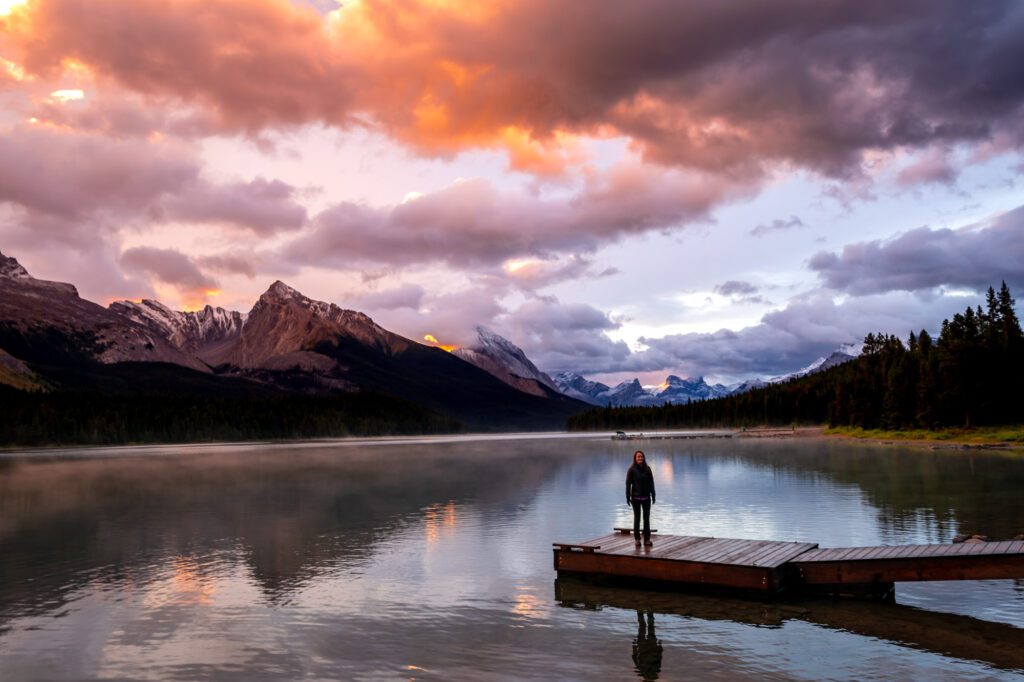
Maligne Lake is the crown jewel of this corner of the world. You’ve undoubtedly seen at least one picture of it on Instagram (probably of Spirit Island, a little tree-covered island miles and miles south from the parking area that’s only accessible by boat).
There are ample opportunities for hiking and other outdoor recreation at Maligne Lake. We’ll give you three ideas in terms of how to spend a half day at the lake.
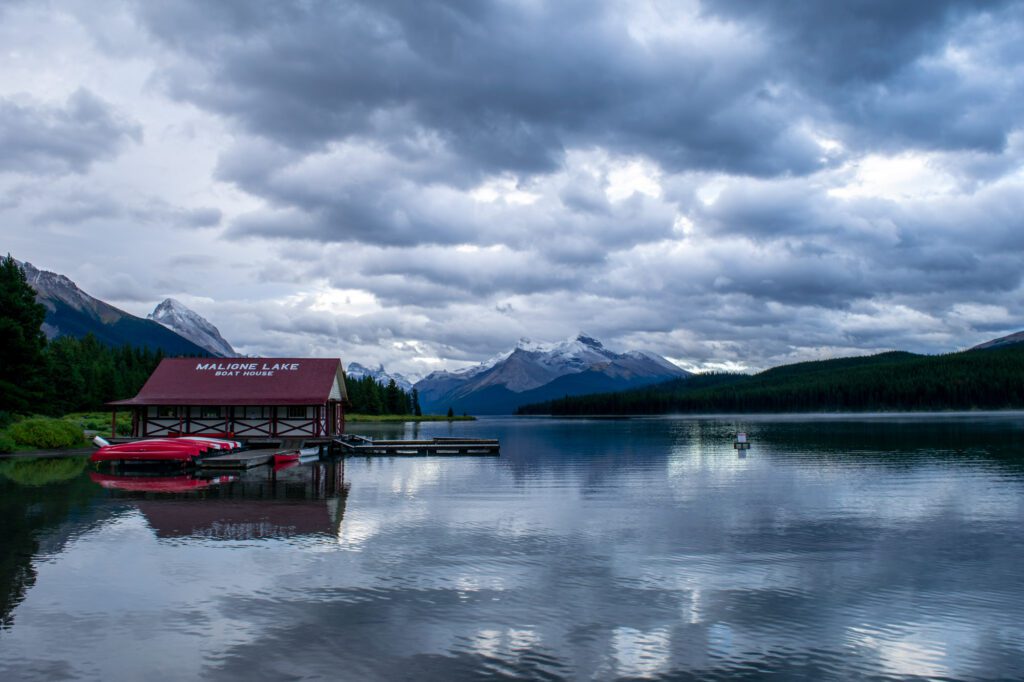
First is the boat cruise out to Spirit Island , which is one of the only ways to get that far out into the lake and see pieces of wilderness that only a tiny fraction of visitors get to see.
However, you will likely be crammed into a motorized boat (which, honestly, isn’t great for the lake) with other visitors, so don’t expect to find solitude out there. It’s a 90 minute cruise.
Second is a self-guided tour out to Spirit Island which, if you’re up for it, is the best way to do it from both an environmental and experiential perspective.
You can either rent a canoe or kayak from Maligne Lake Boathouse ($160 a day for a canoe), which is both the most convenient and also the most expensive option (funny how that works), or you can rent from Wild Current Outfitters in Jasper ($125 a day for a 1-2 person canoe).
With Wild Current, you book in advance and then pick up the canoe at Maligne Lake, so you don’t need to worry about transporting the boat to and from the lake.
From the boat dock out to Spirit Island is a hair under nine miles, which is no joke.
We’d suggest booking either an early morning or late afternoon rental (the latter would change your itinerary a bit) so that you avoid the bulk of the crowds and boat cruises heading out there. Bring lots of water, snacks, and sun protection!
Third is hiking near Maligne Lake . There are several trail options nearby, from easy flat loops to tough climbs.
Here are a couple of hiking options near Maligne Lake, some of which we’ve done personally (Bald Hills is great, but be prepared for wind at the top) and others that were on our list for our latest trip, but either got smoked out or didn’t allow dogs.
- Moose Lake (1.7 miles / 472 feet elevation gain): Super easy hike that takes you southwest from the boat house and parking lot to a nice lake. There’s a reason they call it Moose Lake, and if you can get to the lake early in the morning (or around dusk) there’s a nonzero chance you’ll get to see a moose frolicking in the lake.
- Mary Schaeffer Trail (2 miles / 275 feet elevation gain): Another easy loop, this time along the lakeshore and then back through the forest. Less about the moose and more about the views of Maligne Lake.
- Opal Hills (5 miles / 1,696 feet elevation gain): This one is more in the moderate category, and it’s a good way to get a sense for how the landscape changes as you gain elevation. As you climb, there’s an abrupt shift from green, lush forests to a barren rocky landscape. It’s a distinct line that you can see from afar, which is odd. If you’re feeling spicy, continue on to Opal Peak .
- Bald Hills (9.3 miles / 2,559 feet elevation gain): This is the hike we’ve done, and while we enjoyed it and the view from the top is spectacular, the wind and cold up there made it so miserable that I legitimately have only one or two pictures of the entire hike (rather than the hundreds I have from other hikes).
Maligne Canyon
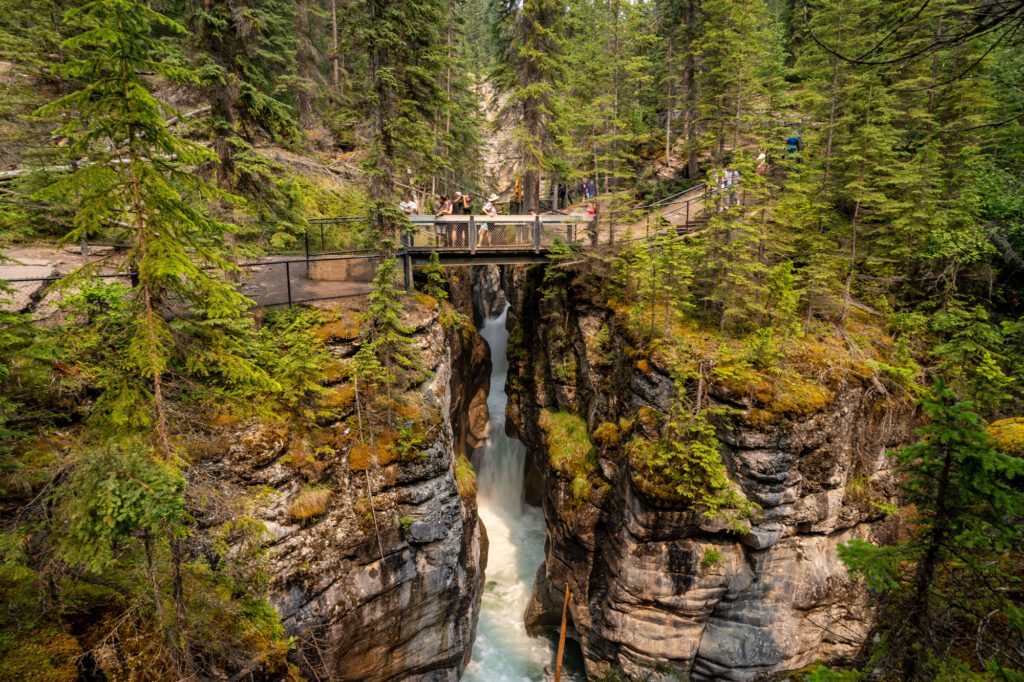
On your way back to Jasper, it’s worth stopping at Maligne Canyon for a short hike down into the canyon, where you’ll have a bottom-up (sometimes top-down) view of the tall limestone walls and the rushing river.
This is another popular spot, but it’s a big parking lot, so parking isn’t as much of an issue as it is at some of the other stops on this itinerary.
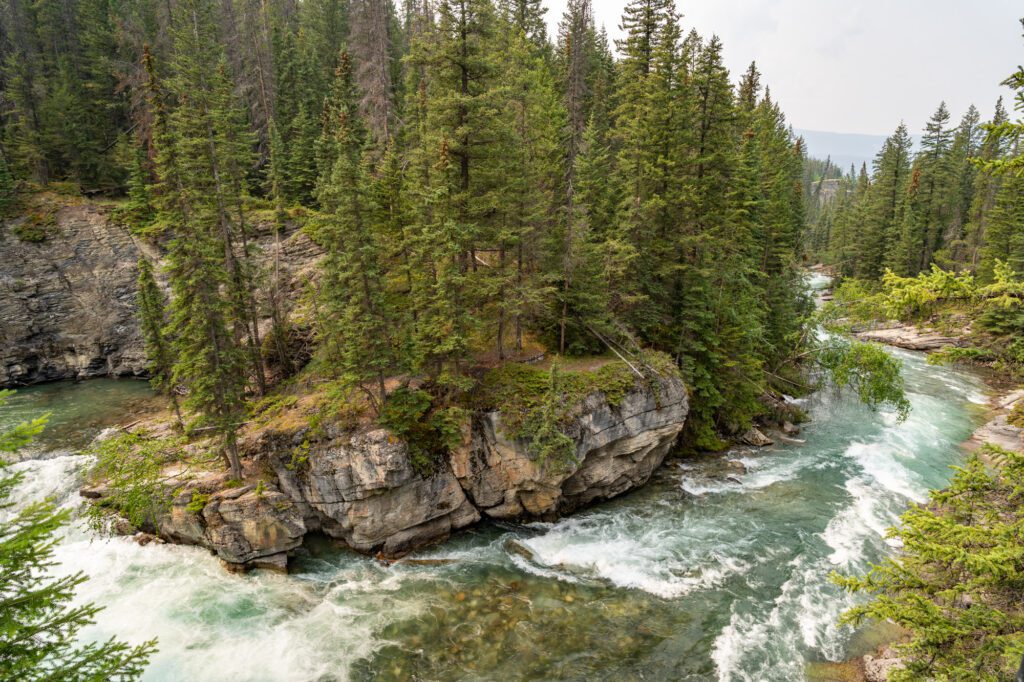
One tip here : we’d strongly recommend this version of the hike , which is an out-and-back that follows the river the entire way, rather than doing a loop that takes you away from the canyon. We did the loop, and the part of the hike that’s not in the canyon is pretty “meh.”
Day 6: Valley of Five Lakes OR Edith Cavell Meadows & Pyramid Lake
On your second full day in Jasper, pick from three of Jasper’s most iconic trails for your morning hike, and then head up to Pyramid Lake for the afternoon before ending in downtown Jasper.
A Morning Hike: Choose Your Own Adventure
Can you tell we’re big fans of giving you a few hike options to choose from based on how you happen to be feeling that particular day?
That theme continues here, where we have a couple of good hikes within an hour of Jasper that offer different experiences and intensities.
Edith Cavell Meadows (5.1 miles / 1,879 feet elevation gain): We did this one on our first trip, and we’re glad we did because it’s not dog-friendly and wouldn’t have been nearly as pleasant with the smoke we encountered on our second trip. It starts with a short hike to the base of the Angel Glacier (and the glacial pond at its base) before continuing up into the alpine meadows beyond. Then, it quickly turns into a barren, rocky alpine landscape, and the views open up to include the rocky ridge that towers over the parking lot and first section of trail.
Valley of the Five Lakes (3 miles / 534 feet elevation gain): We did this hike on our latest trip, and it’s a lovely, mostly easy stroll that takes you past – you guessed it! – five lakes. It’s a good hike, though we’d caution you that the longer loop takes you through a very poorly maintained stretch of trail on the northwestern end of First Lake. If you want a longer hike, we’d go along the north shore of First Lake, then come back along that same route to head back to the parking lot (rather than going around the lake, which doesn’t actually follow the lakeshore).
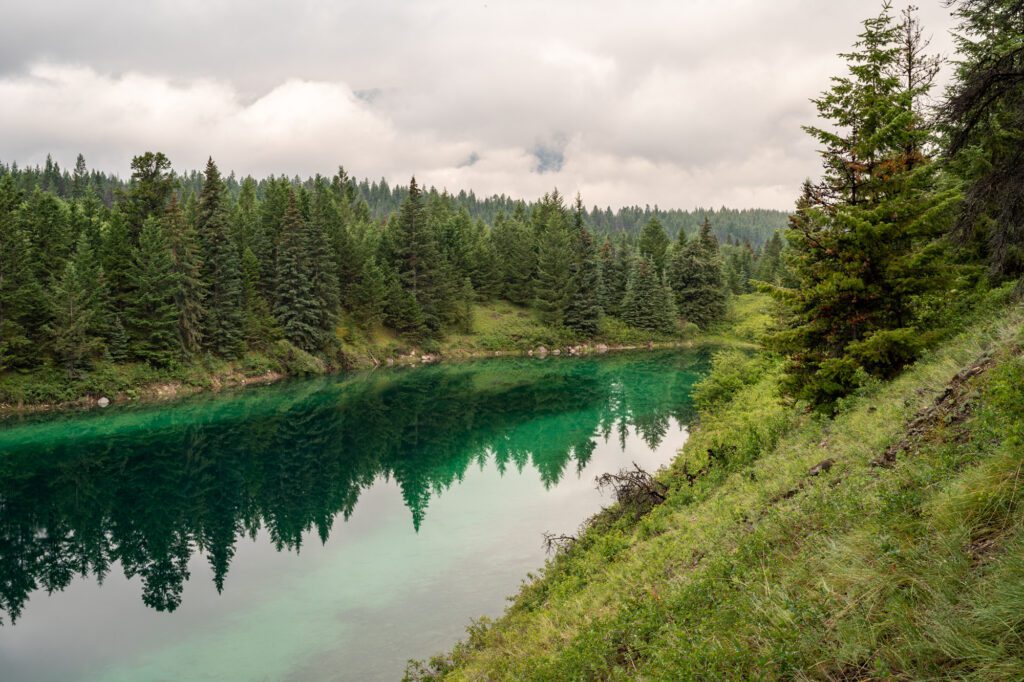
Sulphur Skyline (4.9 miles / 2,142 feet elevation gain): One of the premier hikes in Jasper National Park, this is a tough hike that starts about an hour away from the town of Jasper (to the northeast). The climb isn’t going to be easy, but the views from the top are equal parts expansive, with 360 degree views, and spectacular, with rocky mountain spines and winding rivers.
Pyramid Lake

After a break for lunch and a little siesta, head up to Pyramid Lake, which is about 15 minutes north of Jasper.
For what it’s worth, we saw TONS of elk on this stretch of road, and got a kick out of the fact that Lupine saw them out the back window of our car and, after driving for another 10 minutes or so up to the lake, immediately leaped out of the car and scoured behind it for said elk. Guess dogs don’t necessarily comprehend distance traveled in a car.
You’ll pass Patricia Lake on the way up, and aside from the nice Patricia Lake Bungalows along the lakeshore, there’s not much to do or see there (though it is, unsurprisingly, beautiful).
There are three destinations up at Pyramid Lake that are worth your time, and the first is the dock outside of the Pyramid Lake Lodge, which is THE place to rent a boat of some kind to paddle the lake.

The second destination, and the arguably most famous of the three, is Pyramid Island. Accessed by a picturesque wooden footbridge, this little island is worth walking out on, especially for the views across to the other shore with Pyramid Mountain’s hulk looming over the lake.
The last destination is the beaches on the the south end of the lake, which you’d access by heading left when the road forks as you approach the lake. We were here on a very drizzly morning, and despite the drizzle loved the view of the lake and surrounding mountains from here.
Downtown Jasper

We don’t have too much to say about exploring Downtown Jasper since we spent most of our time cooking at home while we were in town (the Jasper farmers market is fun, and we found it interesting that most of the produce seems to come from British Columbia).
However, there were a few places that stood out to us in Jasper.
First is the duo, owned by the same group, of Neighbourhood Food and Drink (for wine and small bites) and Sunhouse (for coffee and brunch with an Australian flair).

We got great coffee at Sunhouse on a smoky morning, and had a blast chatting with the barista. We then had a similar experience at Neighbourhood a few nights later, which is a natural wine focused bar where we discovered Daydreamer wines , a favorite stop of ours in the Okanagan Valley.
Jasper Brewing Company and the Raven Bistro were also recommended to us by various people we encountered.
Day 7: Icefields Parkway (Round 2) & Lake Louise at Sunset
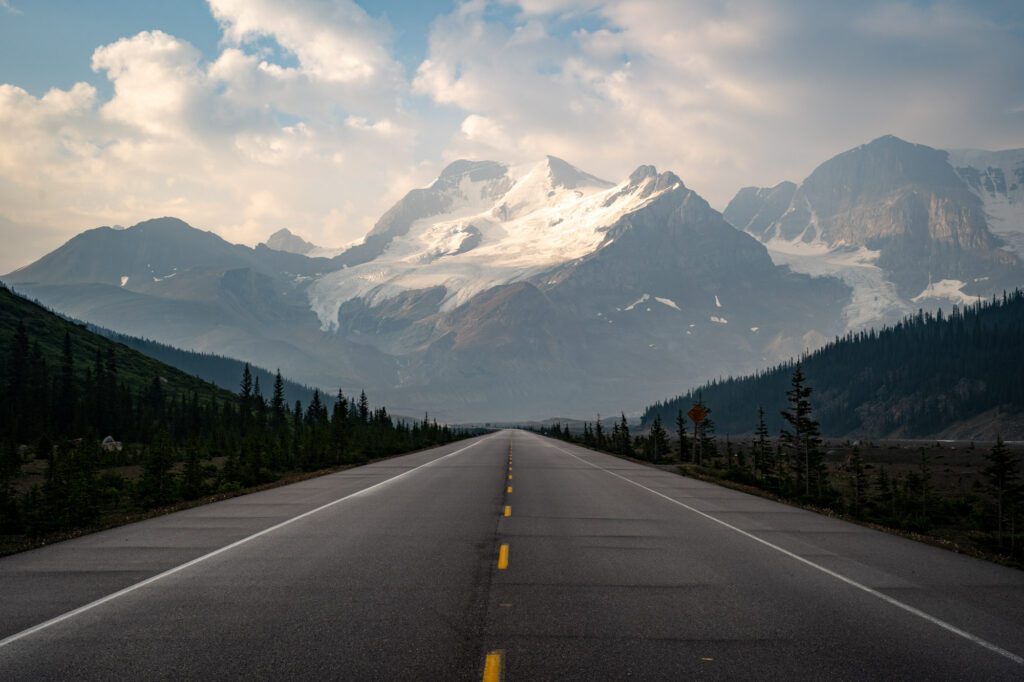
This day is about hitting the stops along the Icefields Parkway – including our favorite hike along the Icefields Parkway – that you missed on the way up a few days ago en route to Lake Louise, where you’ll head for sunset.
Your first stop is the border of Jasper National Park and Banff National Park, which is a little over an hour from Jasper.
If you skipped any of the Icefields Parkway stops that we recommended on the way up to Jasper, like Athabasca Falls or Sunwapta Falls, now is the time to do them!
Wilcox Pass

We’ve saved the best for last, we think, because Wilcox Pass is our favorite hike along the Icefields Parkway.
It’s a 5.8 mile hike with 1,700 feet of elevation gain, and the only hard part is the last mile or so, which is a steep rocky ascent to the Wilcox viewpoint.
After the first mile or so, the views on this hike are bangers all the way through, starting with the red Parks Canada chairs, morphing into stunning views of the valley you’re hiking through, and ending with a nice view out over the Icefields Parkway and the glaciers beyond.
The name is a bit of a misnomer, because you’re going to reach the sign for Wilcox Pass, look around, and feel underwhelmed. Fear not! Follow the trail left for another mile or so as it climbs to the final viewpoint, which is well worth the effort it takes to get there.
Not only are the views excellent, we also saw multiple groups of bighorn sheep on this trail, along with a huge family of mountain goats (with a bunch of babies) along the way.
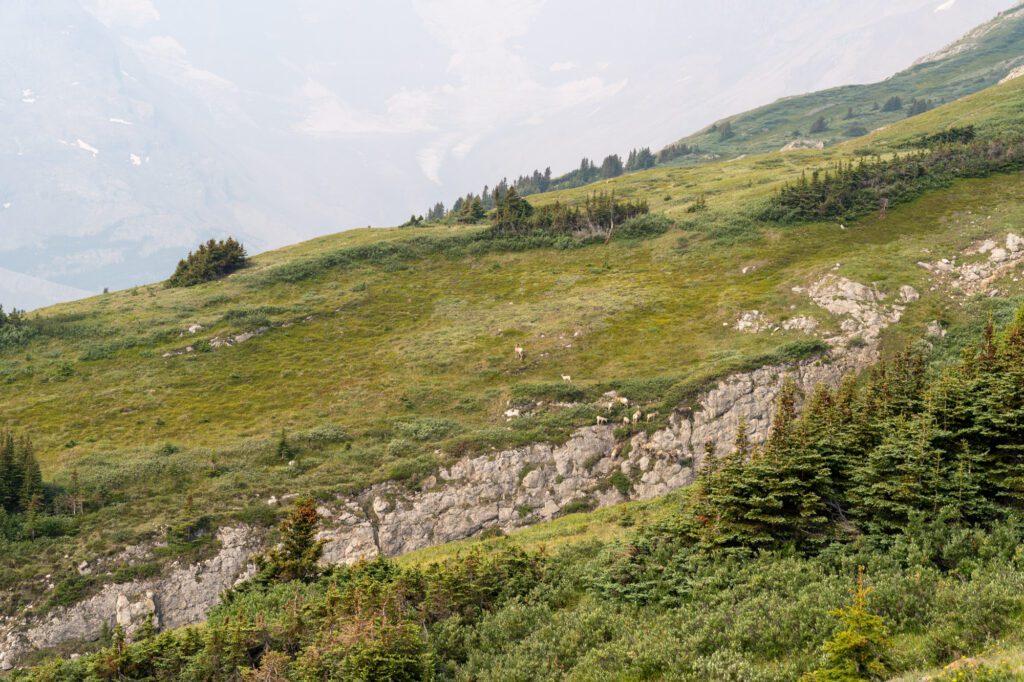
Remember to give them plenty of space – just because they’re herbivores doesn’t mean they’re not dangerous, especially when their babies are involved.
There is a pit toilet at the trailhead, which is just off of the Icefields Parkway.
Parker Ridge is another good hike that is about 10 minutes further south on the Icefields Parkway. It’s slightly easier (but slightly less spectacular), and would be a good option if 6 miles seems too aggressive for your tastes.
Lake Louise
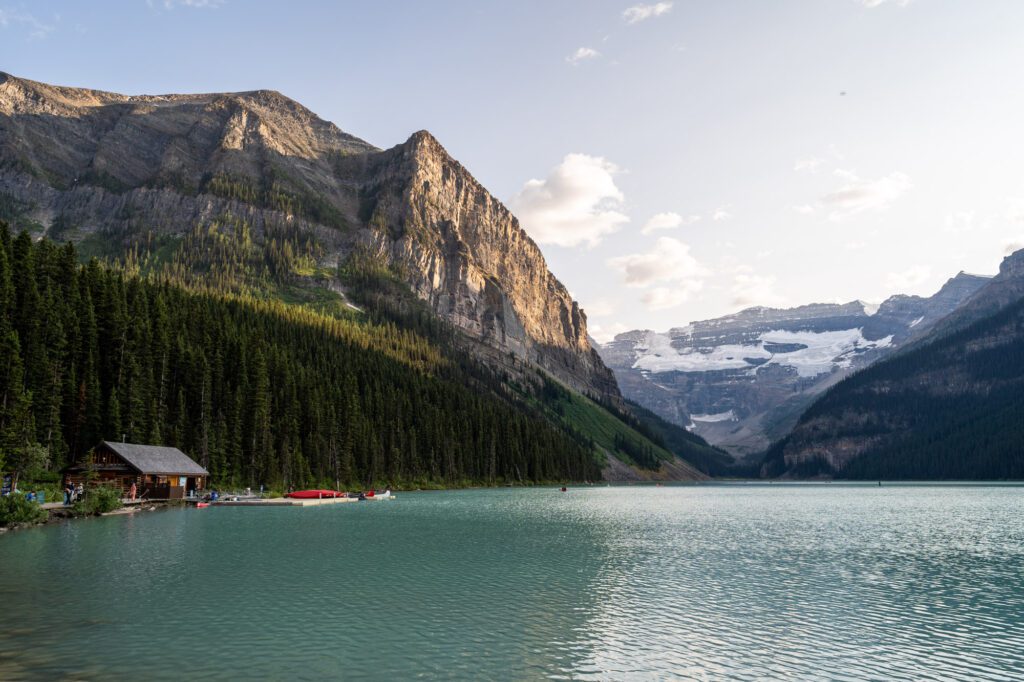
Finish your day with a sunset at Lake Louise.
Now, we think Lake Louise is worth seeing twice – in the early morning (before a hike), and in the late evening. The light does different things at each time of day, and it’s well worth seeing both.
Check into your hotel or campground, drop your stuff, and head out to the lake. Make sure to arrive after 7pm. Why after 7pm? Parking at Lake Louise, which normally costs $21 (no matter how long you’re parked there), is free after 7pm.
Day 8: Lake Louise & Hiking Nearby

For the two days you’ll spend near Lake Louise, split your time between Lake Louise and Moraine Lake.
This is going to be, by far, the most complicated piece of your trip because of the logistics involved in getting to the two most popular spots in Banff National Park, but it’s 100% worth it.
While some people opt to do both lakes on the same day, we’d strongly recommend that, if you’re interested in hiking, you do them on separate days because some of our favorite hikes leave from both lakes, and it would be impossible to do them on the same day.
This does mean you’ll need two days of shuttle reservations (more on that in a second), but we think it’s more than worth it.
On your first full day in the area, tackle Lake Louise, which is one of the most popular places in all of Canada and is home to some of our favorite hikes in Banff .
Getting to Lake Louise
Of the two lakes here, Lake Louise is slightly easier to get to. But only slightly.
As of 2023, you can still drive to the parking lot at Lake Louise , while the parking lot at Moraine Lake is only accessible via shuttle or bus (more on that in the section on Moraine Lake).
You have three options when it comes to getting to Lake Louise: drive yourself and arrive super early, or take the shuttle or bus to the lake.
Each of the three options has its own pros and cons, which we’ll go through here.
Option 1: Driving Yourself to Lake Louise
The first option is to drive yourself , which gives you more flexibility and allows for an earlier start on the trail (unless you’re on the first shuttle). However, the cons arguably outweigh the pros here.
The first con is that you need to arrive super early, which is partially why we recommend staying nearby so that it’s a 10 minute drive, not an hour. There are two big lots at Lake Louise, and by 7am or so on summer days, they are both full. You need to arrive by 7am at the latest to get a spot. From our own personal experience, we were there at 6:15ish, and they were almost full by the time we had strapped on our hiking boots and headed to the trail.
The second con is that it costs $21 to park for the day , between 7am and 7pm. However, this might actually work out to be cheaper than the shuttle if you have a full car of people, so this is probably less of a con and more something to know going in.
Option 2: Taking the Parks Canada Shuttle
Your second option is taking the Parks Canada Shuttle , which starts and ends at Lake Louise Ski Resort, just across the highway from Lake Louise ( here on Google Maps).
This is a good option if you don’t want to get up super early to deal with the nightmarish parking situation at the lake, or if you want to do both Lake Louise and Moraine Lake in the same day using the Connector shuttle that runs between Lake Louise and Moraine Lake.
However, there are two downsides to this option. First is less flexibility – you’re beholden to shuttles on the way there and back, and the tickets are very competitive, so you might not be able to snag an early morning seat unless you book months in advance…when you won’t know what the weather is going to look like that day.
The second is that it’s not super convenient if you’re staying in Banff or Canmore. Keep in mind that this option does mean that you have to drive out to Lake Louise, which is 45-60 minutes from the town of Banff. If you’re staying in Banff, we have a better option next.
Shuttles run every 20 minutes from 6:30am to 7:30pm, and you should make advance reservations as soon as possible. More information here .
Roam Transit Bus 8x from Banff
The third option is to take Roam Transit bus 8x – the Lake Louise Express – from Banff High School in downtown Banff out to Lake Louise.
This is the best option if you’re coming from Banff because it means you don’t have to drive 45-60 minutes just to catch the Parks Canada shuttles.
There is an option here to connect with the Parks Canada Moraine Lake Shuttle, and you’ll need to buy the “Superpass” to do that (for the record, we recommend doing the two lakes on separate days).
This is the most convenient option if you’re coming from Banff, but it’s also the most expensive, costing $10 each way per adult (seniors are $8 each way, kids 17 and under are free).
Reservations should, again, be made as far in advance as you can. More information here .
Hiking Options Around Lake Louise
There are two main hiking routes from Lake Louise, and both are excellent, and both feature backcountry tea houses that this part of the world is famous for.
They are the Plain of Six Glaciers , which takes you out into the glacial valley at the far end of Lake Louise, and Lake Agnes and the Beehives, which takes you up to a ridge high above the lake.
We slightly prefer the Plain of Six Glaciers because it’s a more unique landscape, but that’s just us.
Here’s a brief description of each of those hikes (including two versions of the Beehives), along with a route that combines them into one long all-day affair, which is what we did on our latest trip.
The Plain of Six Glaciers (9.1 miles, 1,929 feet elevation gain): Of the hikes at Lake Louise, this is our favorite (we’ve done it twice now, and it was breathtaking boh times). It takes you out and back to a magnificent view of Abbot Pass and the glaciers up there, with a fun teahouse stop along the way. Great views all the way through! Read our trail guide: Hiking the Plain of Six Glaciers .
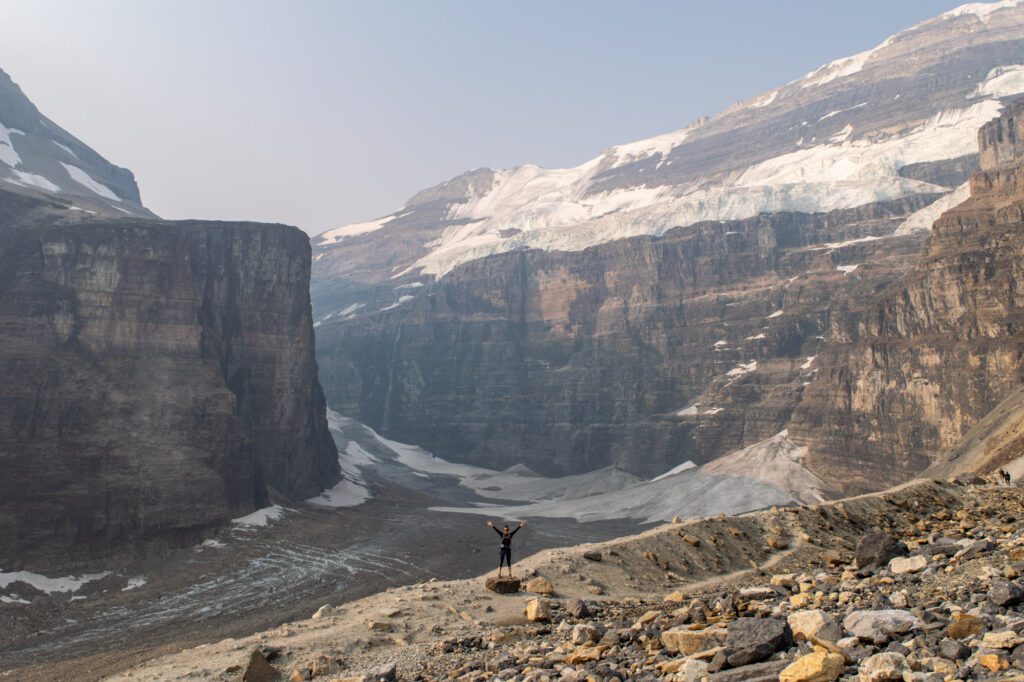
The Big Beehive Loop (6.7 miles, 2,552 feet elevation gain): A close second, this hike takes you up past picturesque Lake Agnes (and the teahouse of the same name) to the top of the Big Beehive, which has a commanding view out over Lake Louise and the Bow River Valley. It’s a great hike, especially in the fall when the Larches along Lake Agnes turn bright gold.
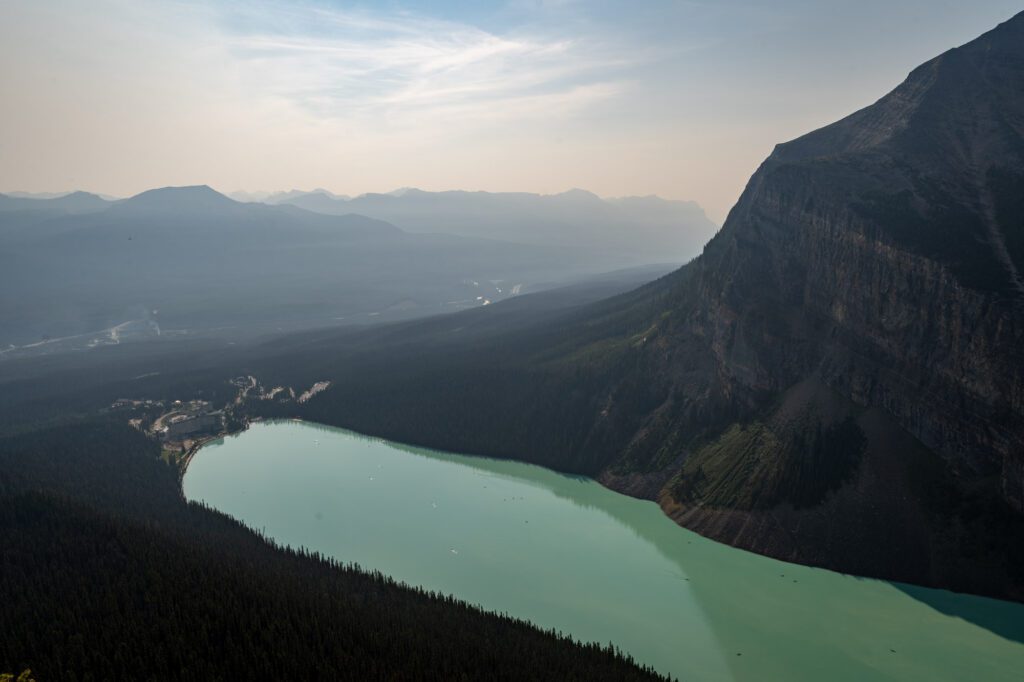
The Little Beehive and Lake Agnes (5.7miles, 1,955 feet elevation gain): A stripped back version of the Big Beehive hike, this takes you up to the Little Beehive (which has a slightly worse view) and then ends at Lake Agnes Teahouse before returning back to the shore of Lake Louise. It’s slightly easier, but we’d really urge you to try for the Big Beehive if you can because it really is much better.

Now, if you’re an experienced hiker, you’re mentally and physically prepared, and you absolutely MUST experience both, you can combine the two hikes into one big loop, which is what we did. Here is the Alltrails guide for that hike.
For what it’s worth, we use Alltrails+ to download maps and track distance and elevation and we clocked 12 miles and 3,500 feet of elevation gain.
It’s a tough hike, but it’s doable if you’re prepared with plenty of snacks, water, and a reasonable fitness level. It will take you all day, especially if (like us) you linger for a bit at each of the two teahouses to catch your breath.
If you are going to do the full loop, we’d advocate for two things.
First is skipping Little Beehive, because it’s not worth the effort given you’ve already done the Big Beehive.
Second is going clockwise, out to the Plain of Six Glaciers first (which is very exposed and is tough in the beating sun) then looping back to Lake Agnes and the Big Beehive.
Basically all of these hikes are going to take the better part of a day, and you’re going to want to spend the rest of it recovering and replenishing, because there’s another big day coming tomorrow!
Day 9: Moraine Lake & Hiking Nearby
Moraine Lake might just be the most popular lake on Instagram. And we’re not saying that’s necessarily a bad thing.
It’s pretty clear why that is, with the spectacular blue water of the lake with the Valley of the Ten Peaks rising above it.
To this day, out of the tens of thousands of photos I’ve captured around the world, the picture above is one of my favorite pictures that I’ve ever taken.
Experiencing the beauty of Moraine Lake is absolutely one of the quintessential Canadian Rockies experiences that you definitely shouldn’t miss, but over the past few years it has become more complicated as the park has done its best to grapple with overwhelming visitor numbers.
As of 20233, they’ve completely closed the road to Moraine Lake to passenger vehicles year round, and introduced a reservation-based shuttle system in an effort to mitigate some of the negative impacts of thousands of visitors per day.
Don’t worry, we have a whole section on how to navigate those systems to get your tickets in this section.
You might be tempted to visit Moraine Lake on the same day that you visit Lake Louise, but if you’re an avid hiker, we’d recommend doing them on separate days, because each lake has a couple of the best hikes in Banff that leave from its shore.
For us, a perfect day at Moraine Lake starts with the famous rockpile viewpoint, followed by a stroll along the lakeshore, and ending with one of the many hikes nearby. Including the shuttle rides to and from the lake, it’s really an all-day affair.
Getting to Moraine Lake
The first thing we need to cover here is getting to Moraine Lake, which has changed over the past few years as record traffic numbers overwhelmed the infrastructure at the most popular lake on Instagram and necessitated some limitations on visitation.
As of 2023, Moraine Lake Road – the only road into the lake – is closed to private vehicles .
That means that the only way to access Moraine Lake is by shuttle or bus, and there are both public transportation options and private options. It’s also worth noting that the lake is only accessible by vehicle from May to October.
We’ll talk about both public and private offerings, but we’re going to focus more on the public transportation options.
The first option is the Parks Canada Shuttle . This option leaves from Lake Louise Ski Resort, which is just across the highway from Lake Louise Village.
That does mean that, if you’re coming from Banff or Canmore, you will need to drive about an hour to catch the shuttle (the next option might be better, depending on what you’re looking for).
This option connects you to the Lake Louise Lakeshore, Moraine Lake (via a connector shuttle that leaves from Lake Louise lakeshore), and the Lake Louise Campground. It runs frequently – every 20 minutes between 6:30am and 7:30pm – but it still fills up in the summer.
Book well in advance. More information here .
The second option is combining the Roam Transit Lake Louise route (route 8x) with the Moraine Lake Connector shuttle (operated by Parks Canada) .
This is a great option if you’re staying in Banff, because it means you don’t have to make the 45-60 minute drive out to Lake Louise Ski Resort to connect with the Parks Canada Shuttle.
Instead, you take the 8x from downtown Banff to the shore of Lake Louise, and then hop on the Parks Canada connector that takes you to Moraine Lake.
This requires you to purchase the “Roam Superpass” when you book your ticket, which gives you access to the connector shuttle. More information here .
The third option is the Moraine Lake Express through Roam Transit (route 10 ).
The most important thing to know is that this option is only available in the fall , September through mid-October.
This route leaves from the town of Banff (in front of Banff High School) and makes a beeline to Moraine Lake, which makes it a really nice option if you’re staying in Banff and don’t want to drive out to Lake Louise. More information here .
All three options are very competitive, and you should book your tickets well in advance, especially if you want the coveted early morning slots.
Keep in mind that even if you want to just use the connector to Moraine Lake, you need to check in at Lake Louise Ski Resort and take the shuttle from there to Lake Louise.
There are two private transportation options we want to highlight for different reasons.
- The first is the Sunrise Shuttle , which is the only option for photographers who want to see Moraine Lake at sunrise (aside from spending $$$ to stay at Moraine Lake Lodge). It takes you from Banff to the lake, arriving around 45 minutes before sunrise, where you’ll stay for two hours before being whisked back to Banff. It’s pricey, and we wish there was an option to stay at the lake to get an early start on a hike, but it’s the only way to have the lake to yourself at sunrise.
- The second is the open top buses operated by Wow Banff , because it’s the only way to bring a dog to Moraine Lake (their route goes from Lake Louise Ski Resort, to Lake Louise, to Moraine Lake). Dogs are only allowed on the upper deck, and we seriously considered doing this to get to Moraine Lake with our dog, Lupine.
The Rockpile Viewpoint and Lakeshore
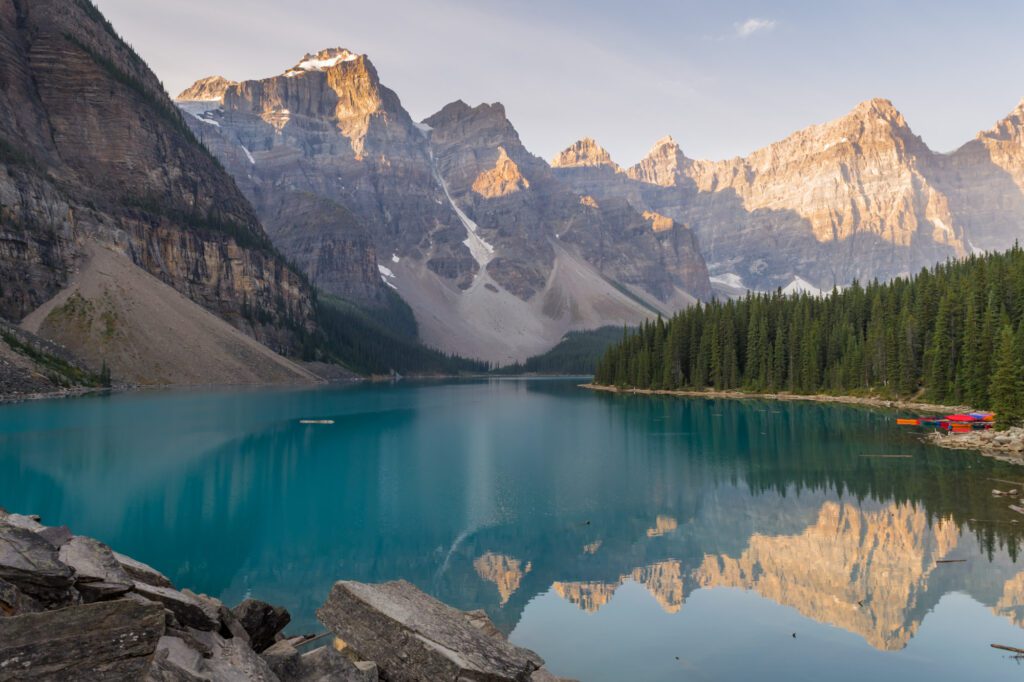
Your first stop off of the shuttle should be the famous rockpile viewpoint, which is a short walk off to your left. From here, you’ll have an excellent view of the lake, backed by the mesmerizing Valley of the Ten Peaks.
Early in the morning, the water is a bright shade of blue, and as the sun rises and interacts with the fine rock particles in the water, it becomes a unique shade of turquoise.
Both are beautiful in their own right, and if you’re on an early shuttle you might have the opportunity to see both versions.
After the rockpile, we would also recommend strolling the lakeshore for some more excellent views.
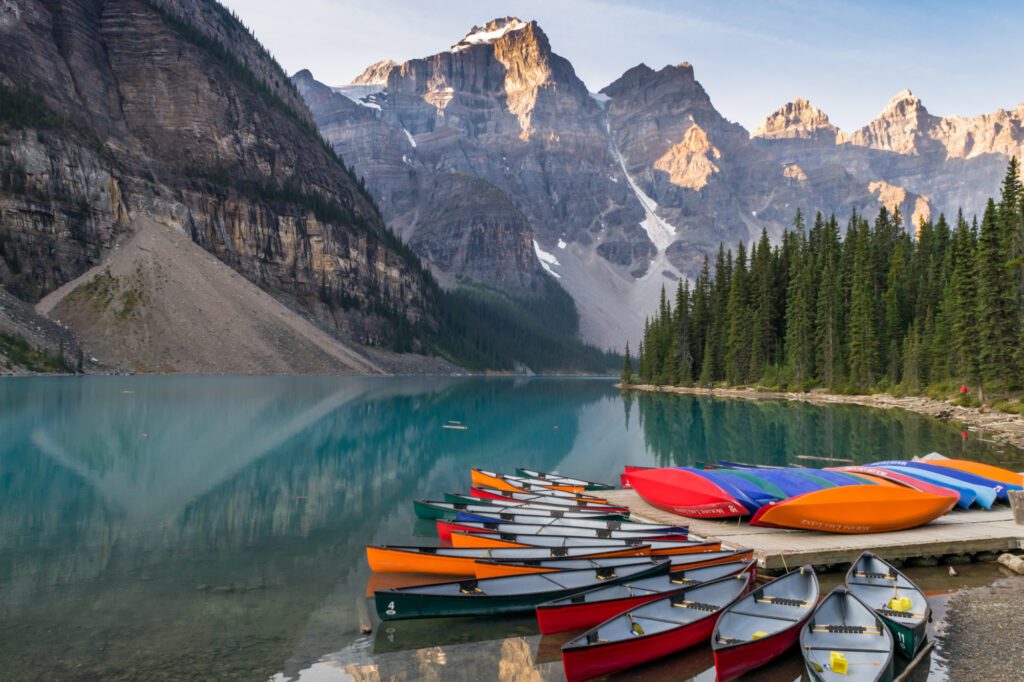
Head back to the parking lot and walk the other way, passing the Moraine Lake Lodge and canoe rentals. You could walk all the way to the end of the lake, but we’d probably go half way or so and turn back, because you’ve got a hike ahead of you!
Choose Your Moraine Lake Hiking Adventure
After poking around the lakeshore and taking some photos, it’s time to embark on your daily hike. As usual, we have a few options for you to choose from based on your own comfort and fitness levels.
However, we should say that we highly recommend the hike to Sentinel Pass. It is our favorite hike in the park, though it’s not an easy one. The views out over Larch Valley and back towards the Valley of Ten Peaks are nothing short of spectacular.
Here are the three hikes, in order of difficulty (easier to harder).
- Consolation Lakes (4.6 miles, 1,000 feet elevation gain): This hike continues past the rockpile to a string of two lakes. It’s the easiest of the three, and is a very gradual grade.
- Eiffel Lake (7.6 miles, 2,000 feet elevation gain): Another alpine lake, surprise! This hike is longer with more elevation gain, but it’s still in the moderate category. The first mile and a half climb the same switchbacks as Sentinel Pass, which aren’t easy, but then it’s a mostly level walk out to Eiffel Lake, another turquoise lake with a tiny fraction of the crowds at Moraine.
- Sentinel Pass and Larch Valley (7 miles, 2,600 feet elevation gain): The switchbacks at the beginning and end of this hike are the hardest parts, with a nice stroll through beautiful Larch Valley in the middle as a break. The views from Sentinel Pass back over Larch Valley and Minnestimma Lake are breathtaking, as is the final ascent to the pass.
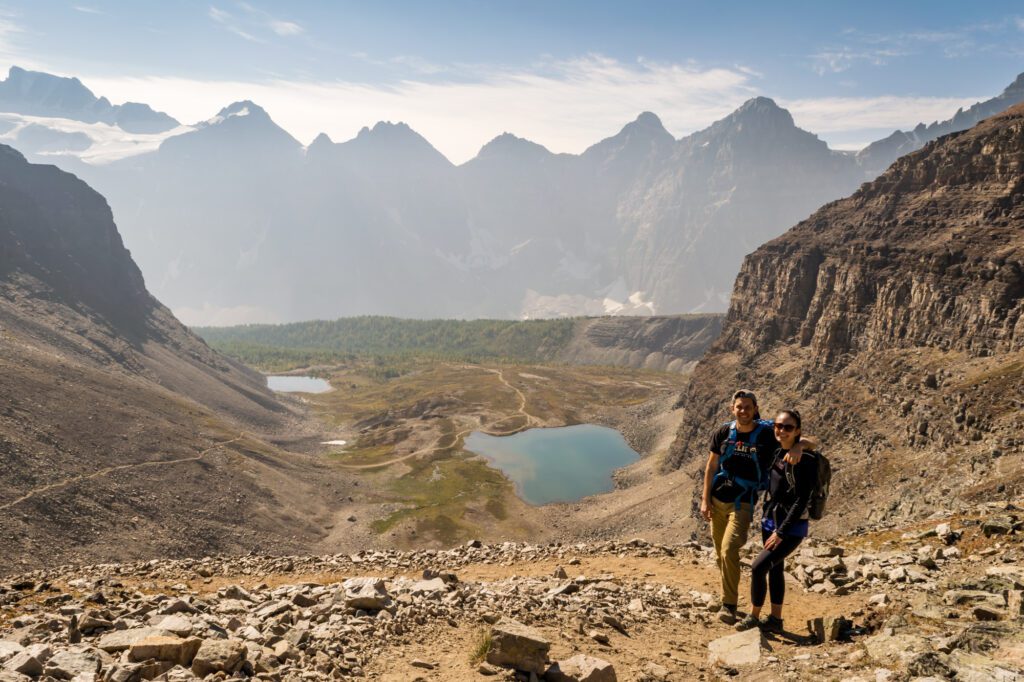
Day 10: Emerald Lake, Takakkaw Falls, & Drive Back to Calgary
On your last day, spend the morning skimming the surface of Yoho National Park, which is immediately west of Lake Louise, and then finish your trip by driving back to Calgary, tears streaming down your face because you can’t believe that every day isn’t filled with rocky peaks, alpine lakes, and 10+ mile hikes (what, just us?).
For logistical purposes, we’d go out to Emerald Lake – the furthest point from Calgary – and stop at Takakkaw Falls as you head back towards Calgary.
Emerald Lake
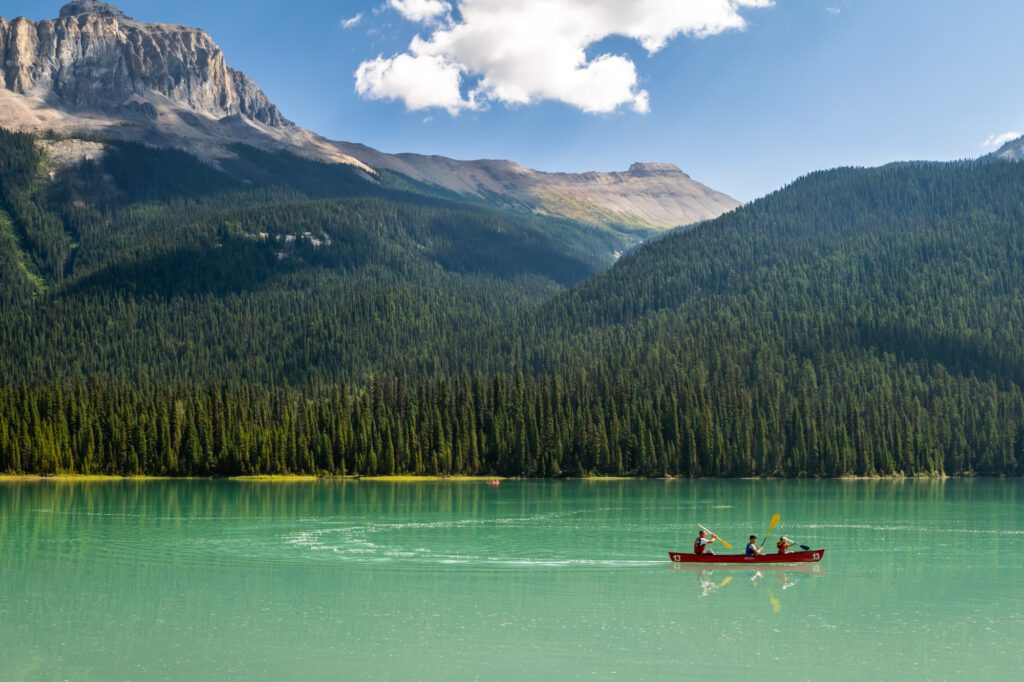
Moraine Lake is the Instagram darling, but Emerald Lake isn’t far behind. And, again, it’s easy to see why. Emerald Lake, as you might imagine based on the name, skews more green than blue when the sun hits the water and interacts with all that glacier dust floating in it.
It’s a very popular spot, and tour buses start rolling in at 9am or so. We’d recommend getting out there as early as you can (we were there at sunrise, which was magical).
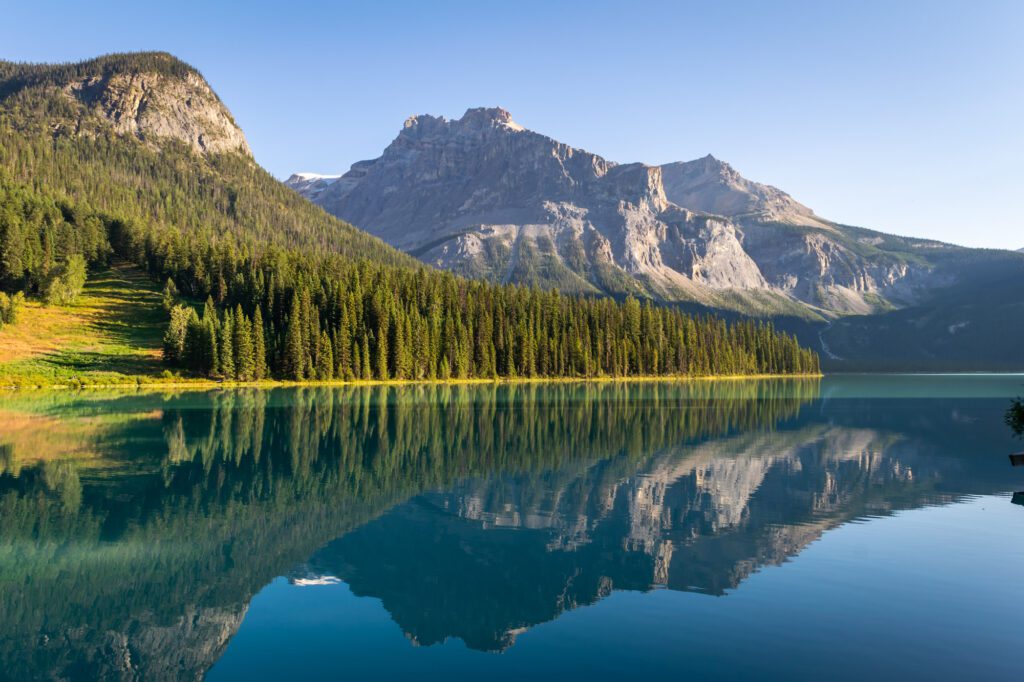
If you have the time, there are two things worth considering here.
First is a walk along the lakeshore, particularly on the left side of the lake (if you’re coming from the parking lot). There’s a loop all the way to the other side of the lake, and the views from the far side back towards Emerald Lake Lodge are stunning.
Second is renting a canoe and exploring the lake from a different vantage point. They’re not particularly cheap, but they ARE cheaper than Lake Louise or Moraine Lake.
There are also some hikes here, but if you want a good hike, we’d save it for your next stop.
Takakkaw Falls

Your second stop in Yoho National Park is Takakkaw Falls, which is one of the tallest waterfalls in Canada and is well worth the drive on the narrow road to reach. It’s a short one mile round trip walk from the parking lot to the base of the falls.
If you’ve got the time for a hike (we have this in the “more time” section below), there are two here that are worth your time.
The first is the hike to Laughing Falls , which involves two more waterfalls and a mostly flat hike out into the Little Yoho Valley.
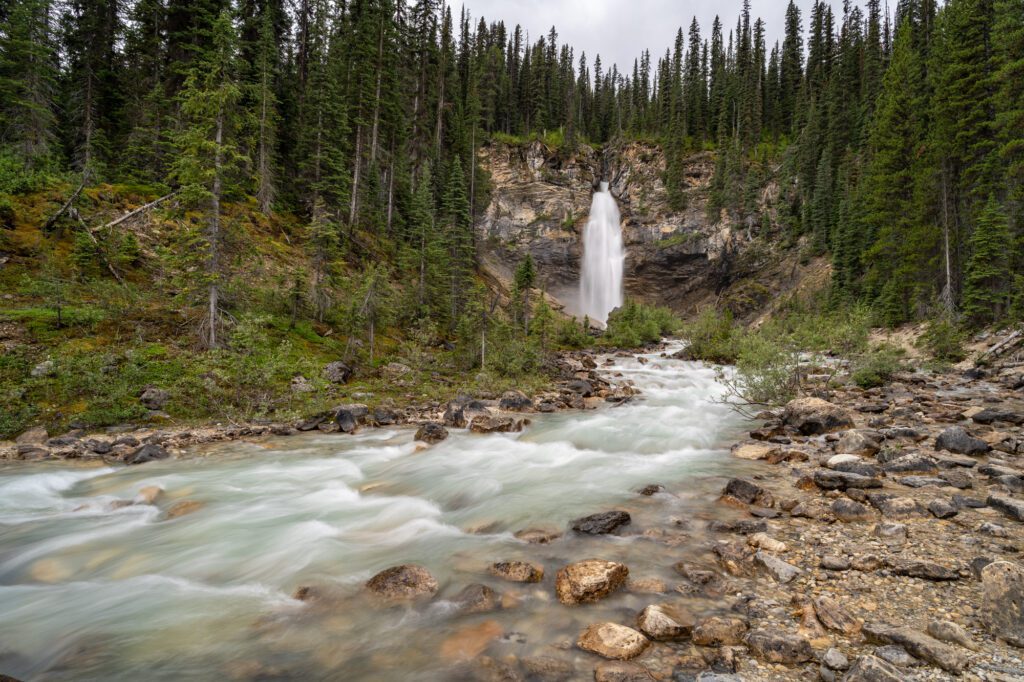
If you have the energy, you can continue on to Twin Falls , which is a full day excursion, but takes you deep into the Little Yoho Valley out to the Twin Falls Chalet and the waterfall of the same name.
The second hike to consider is the Iceline Trail loop , which is the one we’d choose with unlimited time (we’ve done it, and it’s amazing). This one aggressively climbs to get above the treeline up on the ridge, where you’ll have great views out over the valley and, in our opinion, one of the best views of Takakkaw Falls from across the valley.
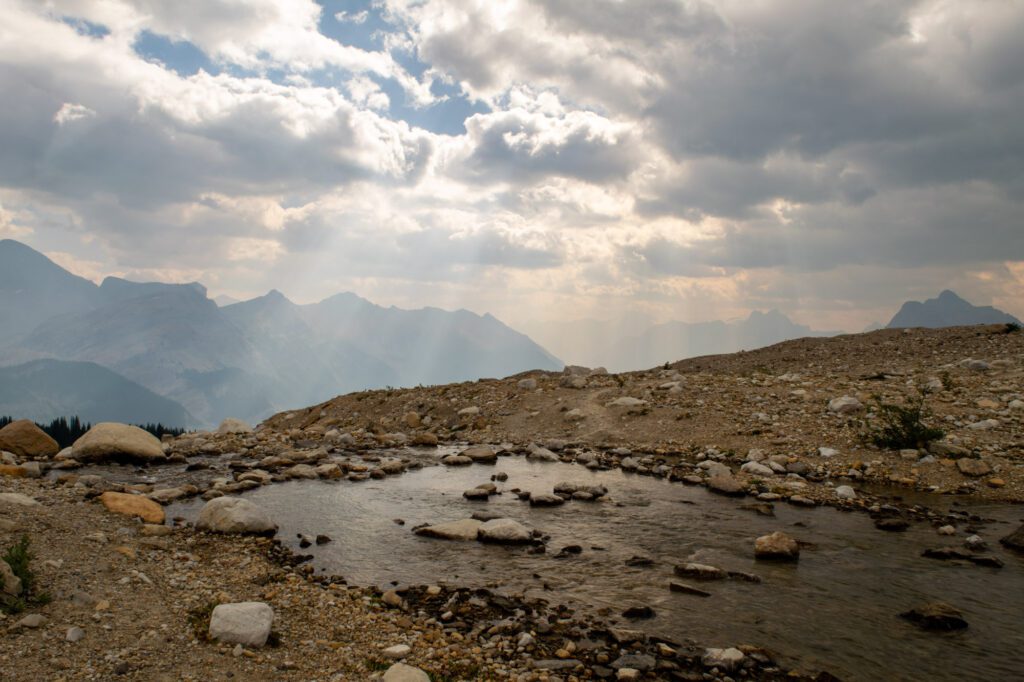
Instead of doing the out and back, loop down past Celeste Lake and Laughing Falls to vary the terrain. It’s a long hike, and spends a big chunk of time above the treeline, so watch for thunderstorms and get an early start.

Drive Back to Calgary
The drive from Yoho back to Calgary will take you about 2.5 hours, and we’d suggest giving yourself plenty of time to get back to the airport to catch your flight.
What to Add With More Time (11-14 Days)?
If you have more time in the Canadian Rockies, congratulations! There is PLENTY to do and see to fill two weeks (a lifetime, really), so you will never feel like you’re running out of things to do if you have two weeks or more.
Here are some things we love, and think are worth adding to your Canadian Rockies itinerary with extra time.
More Hikes! (1-2 Days)
There are plenty of other hikes in Banff and Jasper to add to your itinerary, and we’d recommend adding an extra day for each long hike that you’re interested in.
One option is to add another of the “choose your own adventure” hikes in the itinerary above. For example, if you only did the Big Beehive at Lake Louise, you could add a day and do the Plain of Six Glaciers too.
The other option is to refer to our guide to the best hikes in Banff and choose from there. Here are a few that aren’t included in the main itinerary above, but that we think are worth your time.
- Bald Hills (Jasper): This hike leaves from the shores of Maligne Lake and takes you up to the top of a ridge with great views. Lots of wildlife possibilities, too – we saw a mama and baby moose in the parking lot early in the morning before our hike. It was incredibly windy at the top of the mountain and, as the name suggests, there’s not a whole lot of tree cover up there to protect you.
- Paradise Valley and Lake Annette (Lake Louise): We actually didn’t get to do this hike because it’s on Moraine Lake Road and requires the shuttle (no dogs allowed!), but it was high on our list. You can do it as a shorter out and back hike, or you can do it as a through hike to Moraine Lake up and over Sentinel Pass, which would be one (long) epic day.
- Healy Pass (Banff): Of all the hikes we did that were not at Lake Louise or Moraine Lake, this was our favorite. It’s also the least crowded, and the gigantic parking lot means that parking isn’t really an issue either. It’s relatively long, but the elevation gain is very gradual, and we would put this in the moderate category (bring plenty of snacks and water though, because it’s a long walk). The first three miles or so are in the trees, but once you burst out of the treeline and are met with sweeping views from Healy Pass, you’ll understand why we enjoyed this hike so much. We will say that this is a must-do in the early summer (early to mid-July) for wildflowers, and in the fall (mid-October, but it depends on the year) for the golden larches.
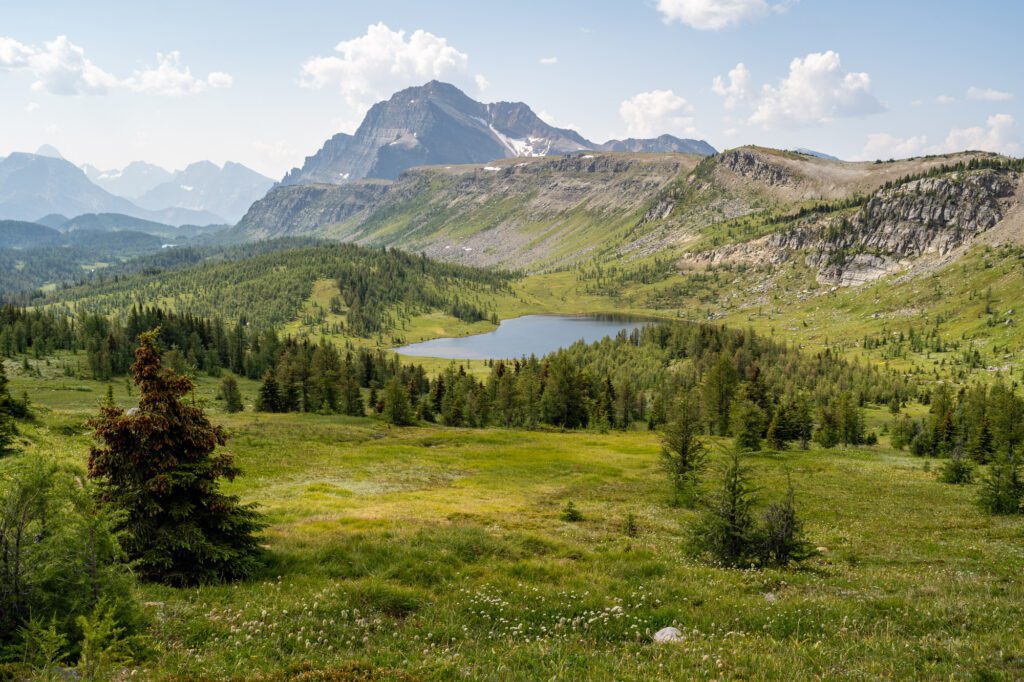
Yoho National Park (1 Day)
Yoho National Park sits on the eastern border of Banff National Park, just a few minutes west of Lake Louise.
However, despite its proximity, relatively few people make it to Yoho, and we think that’s a shame. It’s not like it’s a hidden gem – it’s very much on the beaten path these days with Emerald Lake’s popularity on Instagram – but it’s far less hectic than its neighbor, Banff National Park.
Now, we’ve included a half day or so in Yoho in the itinerary above before driving back to Calgary, but it definitely deserves a full day to itself, if not more.
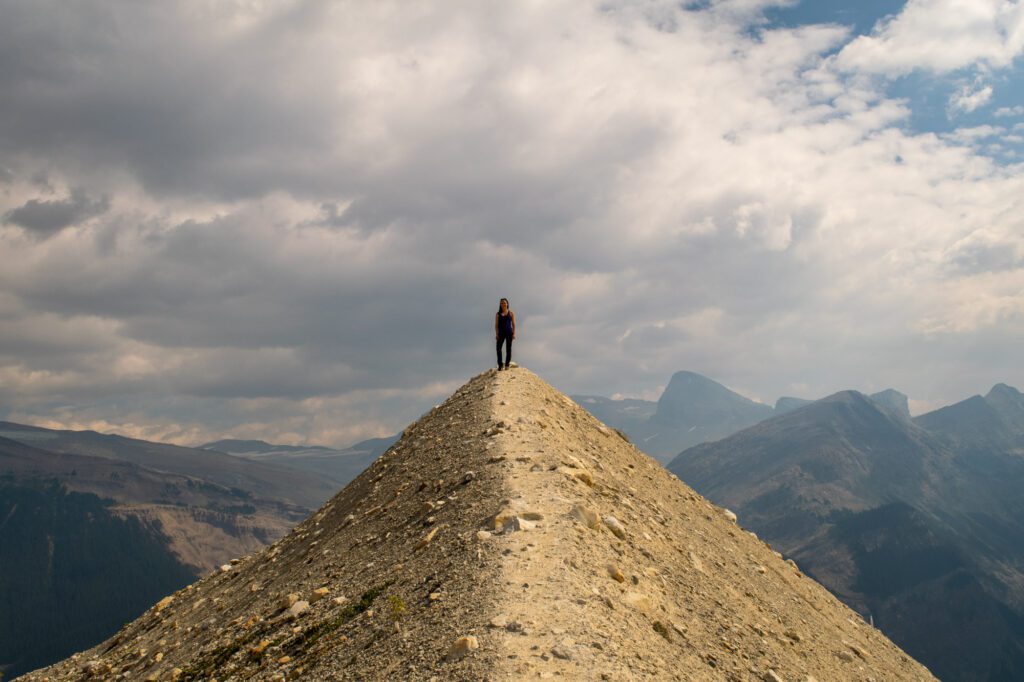
There are several world class hikes – namely, the Iceline Trail (we’d do it as a loop – more on that in a second) – and plenty of other attractions to occupy an extra day.
- The Iceline Trail : If you’re up for a big hike, this is the one you should do. It has two things going for it. One, you get up above the treeline into the rocky alpine landscape high above Takakkaw Falls. Two, you get what is probably the best view of Takakkaw from the ridgeline looking across the valley. The best way to do this – and we wish we had known this before our hike – is as a loop that goes up the Iceline Trail switchbacks and comes back down via Laughing Falls.
- Twin Falls & Laughing Falls: This is an easier hike, heading out from Takakkaw Falls to the Little Yoho Valley, passing three waterfalls along the way. The full lollipop hike is nearly 10 miles and 2,500 feet of elevation gain, but the shorter out-and-back hike to Laughing Falls gets you two of the waterfalls at a much lower effort. More information on the longer hike here.
- Wapta Falls : This is in a different part of the park, a few miles west along the Trans-Canada Highway from the turn offs to Takkakaw and Emerald Lake. It’s an impressive waterfall, though the hike isn’t particularly beautiful. It’s worth a stop if you’re heading west to Glacier (or you’re driving back to Vancouver to finish a Vancouver to Banff road trip ), but probably not worth the detour for most people.
Lake O’Hara (1-2 Days)
You caught us! Technically, Lake O’Hara is in Yoho National Park, but we think it deserves its own line item here because it is both spectacular and hard to access. It’s a paradise of alpine lakes and hanging valleys.
We didn’t get to do it this last trip because the shuttle doesn’t allow dogs (which we totally understand), and Matt is currently contemplating going back on his own JUST to go to Lake O’Hara for a few nights (don’t tell Alysha or Lupine).
Basically, the only ways to access Lake O’Hara – which is a hub for some great hikes and also a gorgeous lake itself – are by shuttle or by walking a long forest road (11km each way).
You can learn about how to secure a shuttle spot here , including when the reservations open, how to get one, and everything else you might want to know.
In terms of staying overnight, there is a campground at the lake, along with a couple of lodges. All of the options are very, very competitive, and if you want to stay overnight out there you’ll have to book early. More information here .
Glacier National Park of Canada (2 Days)
Though it is a little far from Banff and Jasper, we think Glacier National Park (of Canada) is worth the slight detour. If you’re a mountain lover like us, it offers some of the best high alpine hiking in Canada with a TINY fraction of the crowds that you’ll find in Banff and Jasper.
The hiking is the main draw here, and two days and two nights is enough to get in a couple of great hikes.
We’d do Abbott Ridge (we met a search and rescue person at Glacier who said this is her favorite hike in the park, but we had to skip it) and either the Great Glacier Trail (shorter and easier) or Asulkan Valley (longer trek with more Grizzly bears) on your second day.
As you might expect, the best way to experience Glacier National Park is to camp, because there just aren’t very many places to stay near the park.
Stay at Illecillewaet Campground , if you can, which is also the trailhead for most of the best hikes in the park.
However, we originally booked a room at Heather Mountain Lodge , which is the closest lodging option to the park, before we realized they didn’t have a kitchen (which does not work for Matt, who has Celiac Disease and needs to be able to cook) and we had to cancel.
It’s pricey, but the proximity to the park and the sheer beauty of the cabins are worth it, we think.
What to Do With Less Time (7-9 Days)
With less time in the Canadian Rockies, there are a few changes you can make to the itinerary above to maximize your time.
The first thing we’d say is that you should not cut any time in Lake Louise. Don’t try to do Lake Louise and Moraine Lake in a single day – keep those two days as written above.
The two places you can and should cut time are going to be around Banff, which we think you can limit to two days (including the day you arrive) and the Icefields Parkway, which you can spend less time on than the 1.5 days we recommend above.
To make it work in eight days, we’d drive back to Lake Louise from Jasper on the second full day, so you’re only spending two nights in Jasper.
Oh, and you won’t be able to fit in Yoho, we think, so save it for next time.
Here’s what an eight day trip might look like.
- Day 3: Drive Banff to Jasper (Sleep in Jasper)
- Day 4: Jasper National Park
- Day 5: Jasper & Drive to Lake Louise
- Day 6: Lake Louise
- Day 7: Moraine Lake
- Day 8: Drive Back to Calgary
Matt is the founder and main writer behind Wheatless Wanderlust, which he started back in 2018 as a way to share his gluten free travel guides with his fellow Celiac travelers.
Since then, Matt and his wife Alysha have visited 18 national parks, spent three months in Europe and six weeks in Colombia, and have explored every corner of the Pacific Northwest, which is where Matt grew up.
He writes super detailed guides to the places they visit, bringing together personal experience and historical context to help YOU plan an amazing trip.
Hi Matt and Alysha thank you so very much for publishing this Canadian Rockies Tour Guide it is so far the most informative article I’ve ever read . It is very detailed and will surely guide us if ever we will be given a chance to travel . More power to you and GOD be less
You’re so welcome! Hopefully you’ll get to explore the Canadian Rockies at some point soon – it’s an incredible place and we can’t wait to go back! Cheers!
You’re so welcome! Hope you get to make it to the Canadian Rockies at some point in the future 🙂
Hi there, thanks for this brilliant itinerary. I am looking to do something like this but with adding Vancouver on. How much time do you think I would need for this and is there a way you would recommend doing this sort of trip where you fly in/out of Vancouver/Calgary and leave from the other? Thanks
Hey Emma! I’d probably say that you need 10 days or more for that trip, and it’ll probably be pretty rushed. 14+ days would be better. And I would DEFINITELY fly in/out of Vancouver and Calgary to avoid having a long drive to get back to the airport. One way is the way to do it!
Leave a Reply Cancel reply
Your email address will not be published. Required fields are marked *
This site uses Akismet to reduce spam. Learn how your comment data is processed .
10 Days in the Canadian Rockies: The Ultimate Road Trip Itinerary
Discover the beauty of the Canadian Rockies with this in-depth 10-day itinerary.
A few years ago, I spent a blissful 6 months gallivanting around the Canadian Rockies. I was put on a work assignment in nearby Calgary, Canada, and every weekend I’d rent a car and drive out to admire and hike around the majestic peaks and evergreen forests of Canmore, Banff, Jasper, and Waterton Lakes.
And while some of my memories include run-ins with bears or gracefully getting caught in a thunderstorm while hiking above the treeline, the majority of my Canadian Rockies road trip days were pure happiness.
After my travels there, a lot of friends and readers asked me about my travel tips for a Canadian Rockies itinerary. Several readers even went there solely because they’d seen my photos on Instagram.
To be honest, I’m not surprised at all that people see photos of the Canadian Rockies and immediately book a trip.
Yes, it’s actually that beautiful.
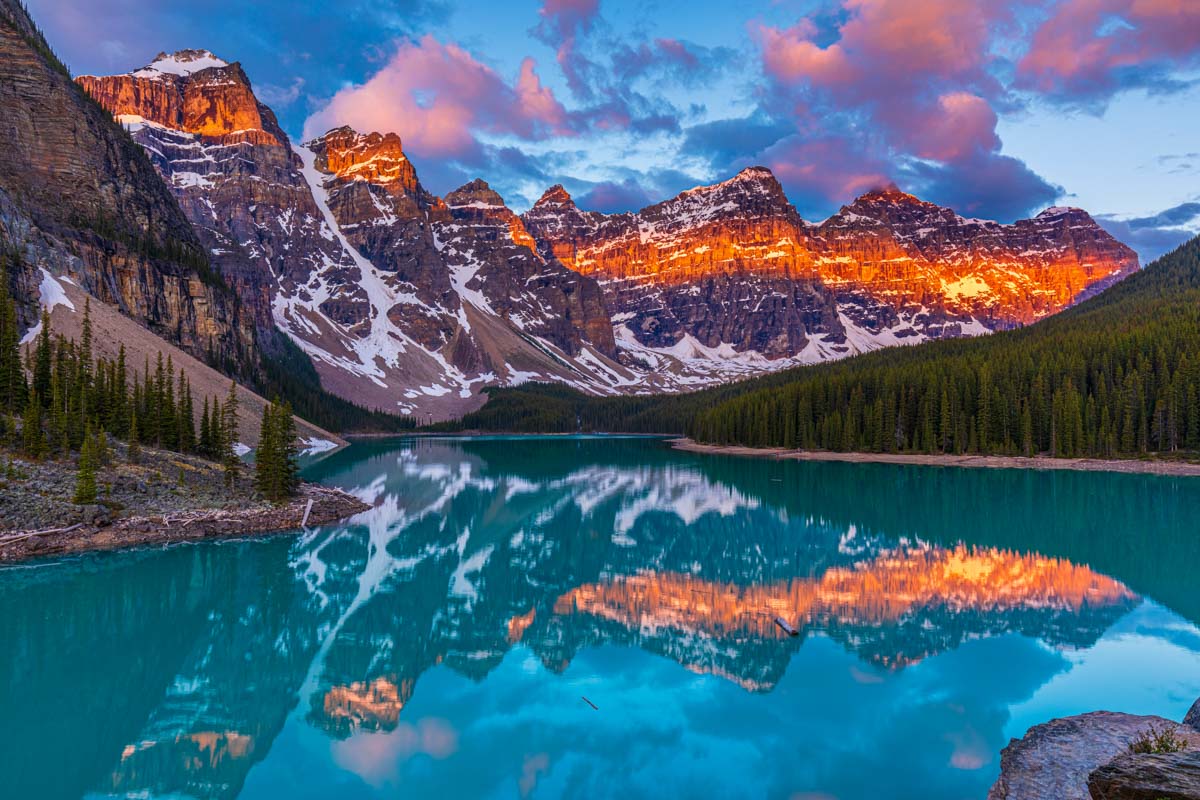
And that’s how this Canadian Rockies itinerary was born.
This itinerary is arguably the most spectacular Canada road trip, and it’s definitely one of the most naturally striking and totally out-of-this-world-beautiful trips you can take in the entire world.
But don’t take my word for it! Read on to learn all of my first-hand tips for planning the ultimate Canadian Rockies road trip.
For your information, this is a SUPER comprehensive guide (read: long and detailed sections to come)! I just wanted to make sure all of our best tips, guides, and resources for the Canadian Rockies were all in one place for you to access easily.
Soooo, grab a glass of your favorite adult beverage, cozy on up, and let’s chat by the crackling fireside about how to plan a kickass Canadian Rockies itinerary!
Travel Tips for Planning Your Canadian Rockies Road Trip
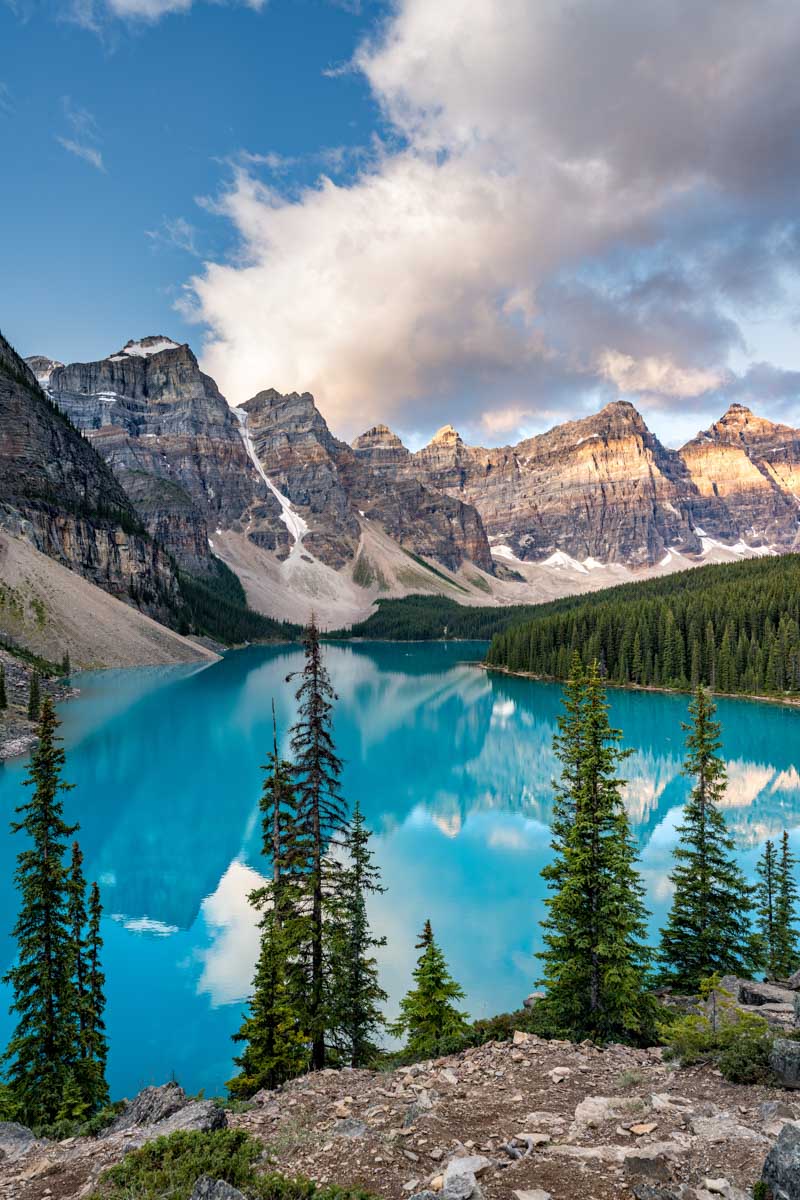
One thing that’s really important to keep in mind is that the Canadian Rockies is becoming a more popular travel destination every. single. year.
That’s why it’s crucial to plan your trip in advance.
If you’re planning on visiting the Canadian Rockies in the highest season (June through August), I’d recommend planning your trip and making all of your bookings AT LEAST 2-3 months in advance.
If you’re going in the shoulder season (May through early June or September through October), you can plan 1-2 months in advance.
From my own personal experience, here’s everything you need to know as you plan your Canadian Rockies road trip:
Important Tips to Know Before Traveling in the Canadian Rockies
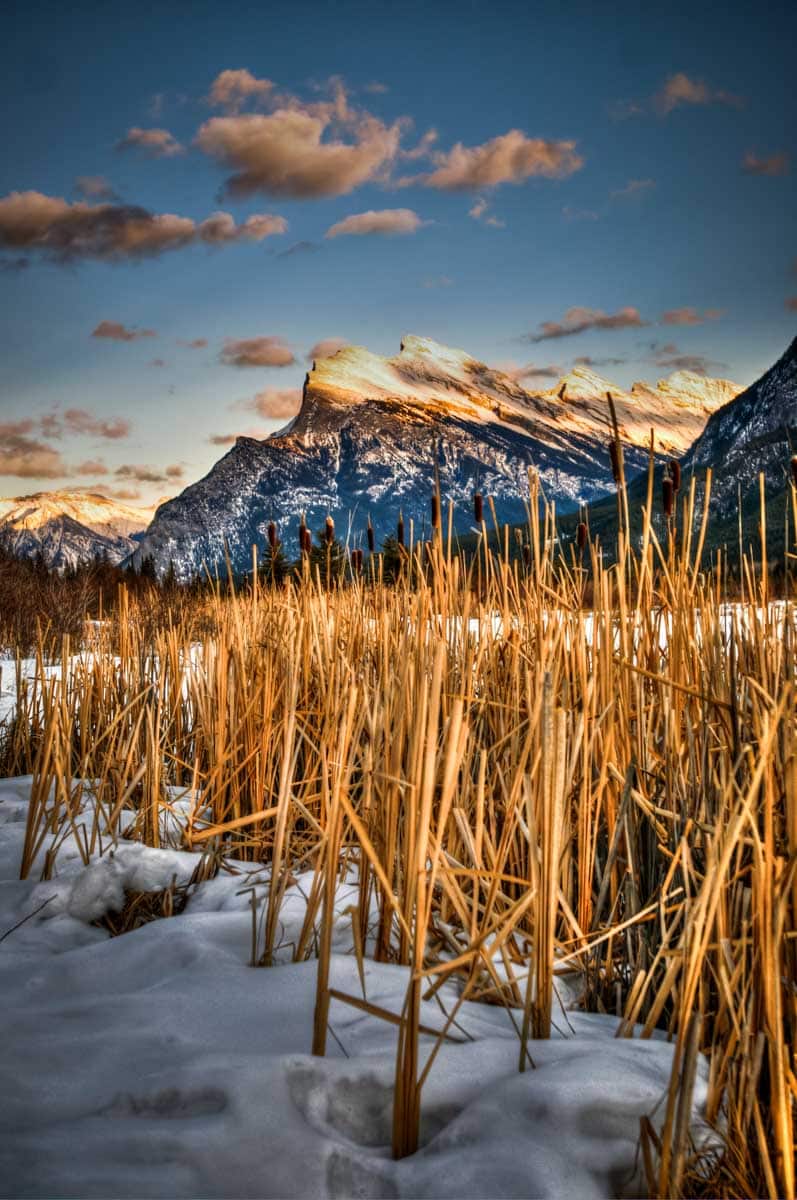
Weather conditions can be very unpredictable. One minute it’s blue skies and sunny and the next, it’s sleeting. This is normal life in the Canadian Rockies, and it’s something you’ll have to get used to if you’re traveling in from a more temperate climate.
Be sure to bring gear for both cold and warm weather (we’ve provided our favorite recommendations a little later in this post), and have waterproof shells for when the weather turns sour.
Accommodation books up very, very quickly. When I was planning my most recent trip to the Canadian Rockies, I noticed Banff and Jasper were already booked at over 80% capacity…2 months before my arrival.
As soon as you think you want to go to the Rockies, you should book cancellable accommodation (Booking.com is great for that!) to make sure you can secure something .
There’s wildlife everywhere. Talk to any local in the area and they’ll tell you wildlife is commonplace here. It’s not out of the ordinary to see a bear or an elk grazing on the side of the road.
You can absolutely admire these animals from a distance (and even go on a special tour to see them!). But whatever you do, KEEP A SAFE DISTANCE and DO NOT FEED ANY ANIMALS. This is their home and we need to respect and protect them.
You need to buy a ticket to enter the parks. While Canmore isn’t part of this, in order to enter Banff, Jasper, or Yoho, you need to pay the entrance fee. The fees are per person, per day, so depending on the size of your group, you’ll either want to pay individually or splurge for a family/group pass. You can see all prices and conditions on the Parks Canada page.
If you want to avoid the crowds, wake up early. This itinerary will be taking you to many different locations, some more popular than others. However, if you’re not a morning person, you miiiiight want to become one during this trip, as the early morning is a) the best time to avoid the crowds and b) the best time for photos of the park because of the lighting.
When to Visit the Canadian Rockies
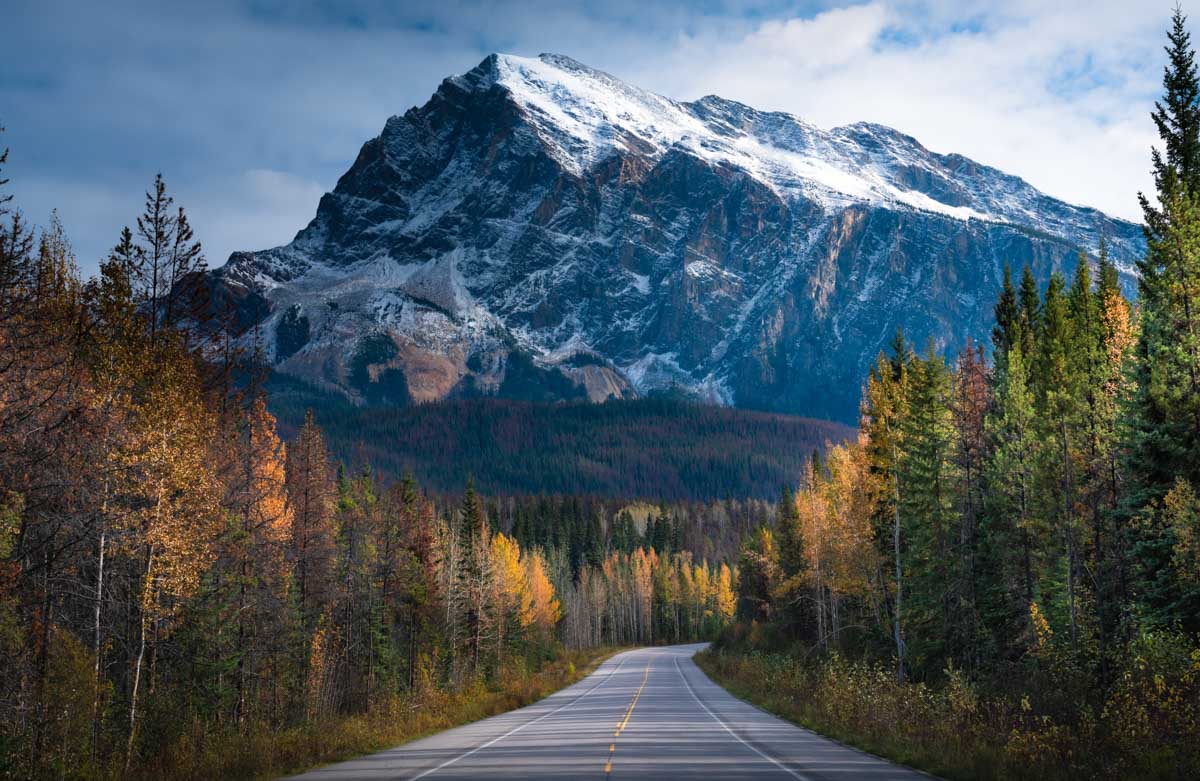
The Canadian Rockies are a year-round travel destination. This means that, yes, you can visit during any month of the year, but what you can do drastically depends on the weather. You’ll need to have the right expectations about weather and available activities.
Visiting in Summer or Fall
Summer and fall usually boast the best hiking and camping weather, but also attract the largest crowds.
Typically, all of the hiking trails and summer adventure activities are open and available during this time of year, meaning that the hotels and lodges are often almost completely sold out and there’s actually traffic.
If you’re planning on visiting the Canadian Rockies during the summer, you’ll need to plan a few months in advance to secure accommodations, car rentals, and tours.
Visiting in the Spring
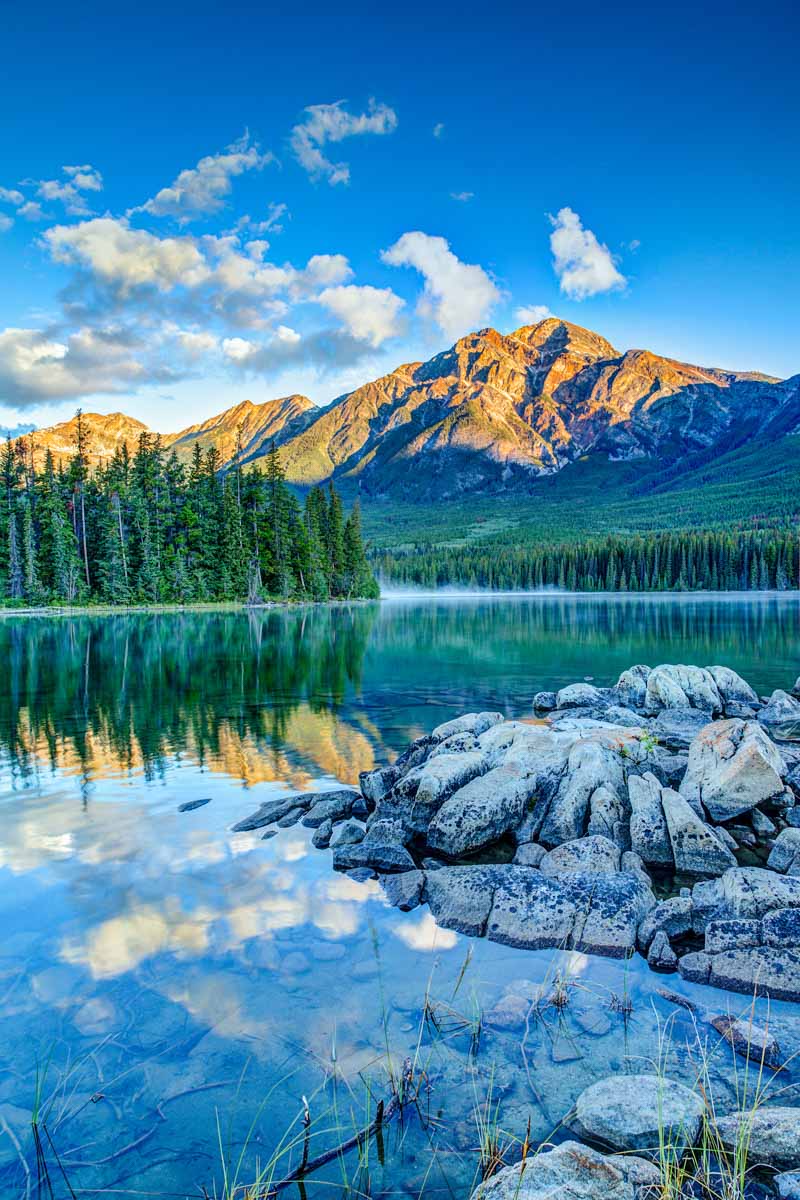
Spring is the shoulder season, especially after the ski slopes begin to melt but the trails are still covered in winter ice. Weather during this time of year can mimic winter or summer, depending on when in the season you visit.
The first time I ever visited the Canadian Rockies, we went in mid-May and, while not all of the hiking trails were open yet, we experienced very few crowds and even had Lake Louise completely to ourselves.
Not a bad trade-off if you’d prefer a more tranquil, quiet experience!
FYI, this Canadian Rockies itinerary is based on a spring, summer, or fall road trip.
Visiting in the Winter
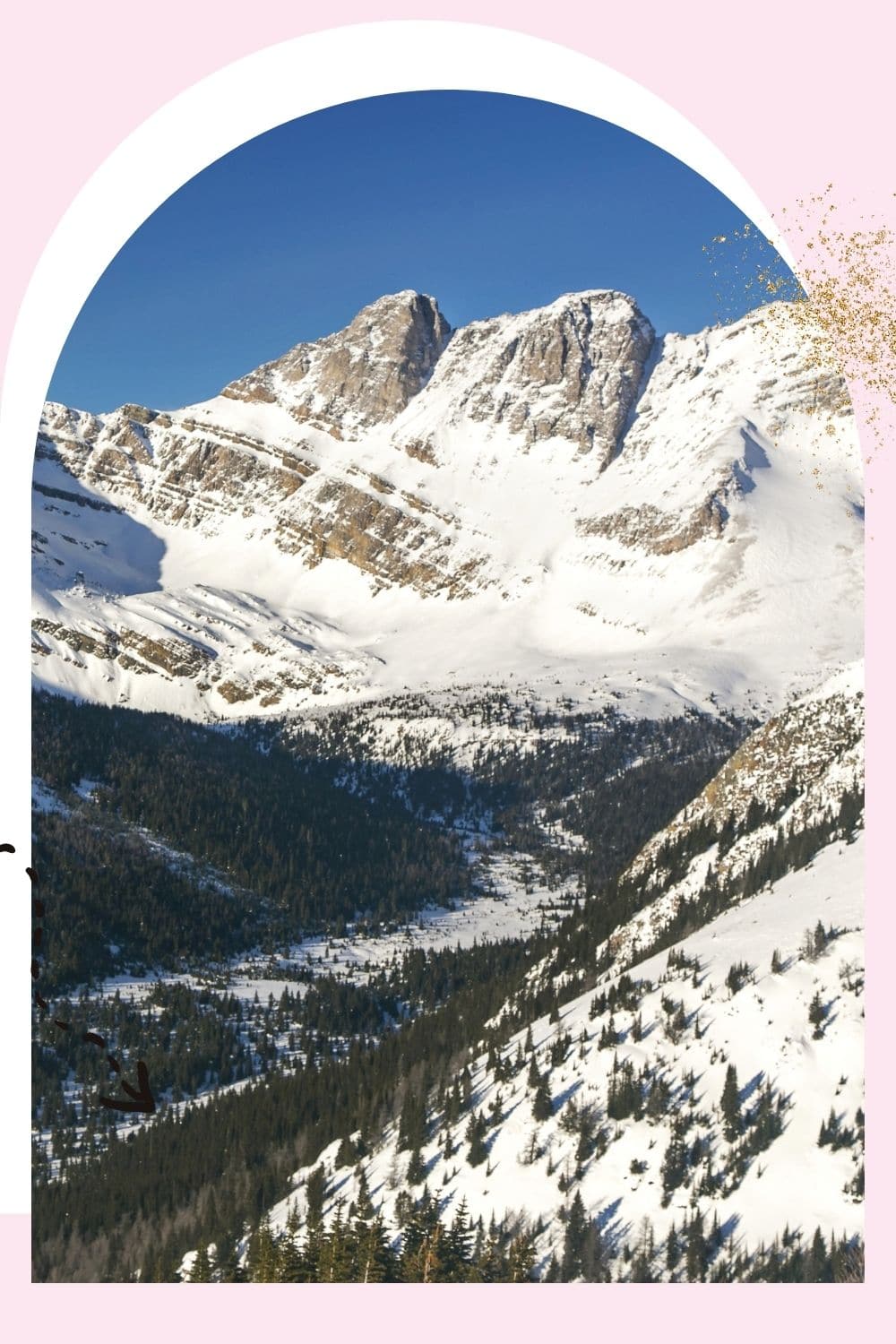
However, that’s not to say you can’t make a Canadian Rockies road trip in the winter. Winter is the least-crowded season in the area, but your activities will be limited to snow sports (e.g., skiing, snowboarding, tubing, etc.) and ice activities (like ice climbing and ice trekking, which are pretty cool, IMO).
If you’re planning on doing any of these outdoor winter sports, I recommend grabbing yourself a pair of crampons, a durable, insulated jacket , and thermal snow pants, as you’ll DEFINITELY need them. Also, make sure that you have all of the most important gear for hiking in winter .
If you’re going to take a road trip during the winter season, I’d strongly recommend having experience driving in snowy/icy conditions, and please make sure to have the right gear, like snow chains, ice scrapers, etc.
How to Get to & Around the Canadian Rockies
If you haven’t already guessed by the fact that this is a “road trip” itinerary, I strongly recommend driving yourself or renting a car to get to and around the Canadian Rockies. Why? Because having your own car gives you the most flexibility for where you can go in the park and what time.
How to Rent a Car in Calgary
Luckily, it’s pretty easy to rent a car at an affordable price from the nearby cities of Calgary, Edmonton, and even Vancouver. You can even rent a car in Banff town. If you’re not from the area, I strongly recommend flying into Calgary International Airport (YYC), as it’s the closest airport to this itinerary’s starting point.
You can rent a car from Avis, Hertz, and Enterprise directly from the airport. However, if you want to save some moolah, I’d recommend checking the prices at Calgary’s downtown car rental locations as well. I’ve found rental cars downtown tend to be cheaper, costing sometimes 20-40% less per day than renting at the airport. Plus, the taxi downtown from the airport only costs ~$15 USD one way.
Getting Around the Canadian Rockies
Once you’ve got a car, there are gas stations all over the Trans-Canada Highway and the Icefields Parkway (the two primary roadways you’ll be using in this itinerary). Before heading anywhere, I strongly recommend checking the Parks Canada road reports, so you know if there are any road closures or bad weather conditions ahead of time.
Where to Stay in the Canadian Rockies
There are places to stay in the Canadian Rockies for any budget level, from penny-pinching backpackers to luxury lovers.
To make planning your accommodations suuuper easy, for each day of this Canadian Rockies itinerary, I’ll be providing two recommendations for places to stay, one budget option and one mid-range option.
I’ll also suggest the most convenient campsite for each day of the itinerary.
However, if you’d like more suggestions or information on where to stay in the Canadian Rockies, we’ve got you covered with 2 complete accommodation guides (Banff and Jasper):
- Where to Stay in & around Banff National Park
- Where to Stay in Jasper National Park
And, for those of you interested in camping in the Canadian Rockies, we’ve got 3 complete and detailed guides on that as well:
- The Ultimate Guide to Camping in Banff National Park
- The Ultimate Guide to Camping in Jasper National Park
- What to Pack for a Camping Trip: The Ultimate Camping Packing List
What to Pack for the Canadian Rockies
Clothing to pack for the canadian rockies.
- Waterproof hiking boots – While on a Canadian Rockies road trip, there’s a good chance you’ll be caught walking in mud, snow, and stream crossings. To keep my feet warm and dry during day hikes, I have a cozy pair of Ahnu waterproof hiking boots that always do the trick! My boots have been with me to Patagonia, Peru, Slovenia, and more, and they’re still kicking ( haha, get it?! ).
- Wool socks – You’ll want to bring some warm wool socks to pair with your hiking boots. Not only will these help keep your feet cozy and dry, but they can also help prevent blisters from your boots. We love our Darn Tough hiking socks for all of our outdoor adventures and literally bring them everywhere with us.
- Merino wool layers – It’s a really good idea to bring a merino wool baselayer , which will keep you cool in the summer and warm in colder weather. Merino is soft, sturdy, stink-free, and sweat-wicking, AKA the best fabric ever for staying warm and dry in the Canadian Rockies’ unpredictable climate.
- A waterproof rain shell – No matter what time of year it is, there’s a decent chance of a sudden downpour in the Canadian Rockies. Yes, it literally happens even when the skies are clear and blue minutes before. Bring a sturdy, waterproof rain jacket to stay warm and dry at all times.
- A compressible down jacket – Temperatures in the Canadian Rockies can be chilly even in the summer, especially as you gain altitude. For this reason, I always make sure to pack my thermal puffer, all rolled up into a tiny ball that I can shove into my day pack or clip onto the outside of my bag with a carabiner.
Toiletries & Personal Items
- Mosquito repellent, sunscreen, and sunglasses – Don’t forget these! Just like most other outdoor areas, the Canadian Rockies get lots of sunshine and mosquitoes in the summer, so plan ahead.
- Snacks – Whether you’re hiking, rafting, or driving, you’ll definitely want some snacks to carry with you. I strongly recommend purchasing packaged or resealable snacks as the food scents can be an issue with wildlife in the area.
- Good road trip playlists – You’ll be driving a LOT in the Canadian Rockies, so having a good car playlist downloaded to your phone is a must!
Other Helpful Things to Pack for the Canadian Rockies
- Bear spray – Like I mentioned before, there is a LOT of wildlife in the Canadian Rockies. Be sure to purchase a canister of bear spray if you plan on doing lots of hiking or camping. You most likely won’t have to use it (I never did in 6 months!), but it’s smart to have on you in the event of a chance run-in with a bear or a wolf.
- Head lamp – If you want to catch a stunning sunrise, a colorful sunset, or some epic stargazing, a good, comfortable head lamp is a MUST. Luckily, they’re not too expensive and once you buy one, you can just replace the batteries forever and ever (until the bulbs physically burn out). I like my Black Diamond head lamp for exploring in less-than-optimal lighting.
- Reusable water bottle & filter – We always bring our trusty reusable water bottle (Rafael and I both have Hydro Flask bottles that we LOVE) on our adventures to cut down on plastic waste and keep our water cold. Most of the time you should have plenty of access to clean, filtered tap water, but on long hikes you may need to refill at a stream or cascade. In this case, you’ll also want a water filter or purification system to ensure your water is always potable. We recommend the rechargeable SteriPen, which purifies your water using a portable UV light.
- Carabiners – These are always super useful to have while hiking or exploring. I use them to hang my water bottles, hats, shoes, wet clothes, etc. on the outside of my bag, and they work fantastically. You can literally just buy a pack of 20 carabiners and throw them in your hiking bag when you’re ready for an adventure.
Gear for Camping & Sleeping
- Durable camping gear – If you’re planning on camping, you’ll definitely want some high-quality camping gear to bring with you.
- Hammock – While definitely not a requirement, it’s really nice to have a hammock for relaxing after a long hike or at a riverside campsite. We have an ENO Double Nest (of course, in the brightest, most psychedelic colors they sell) and we basically live it in when we’re not in the car or the tent. It’s perfect for sharing between two people or snuggling up by yourself.
The Ultimate 10-Day Canadian Rockies Itinerary
Day 1: calgary to canmore.
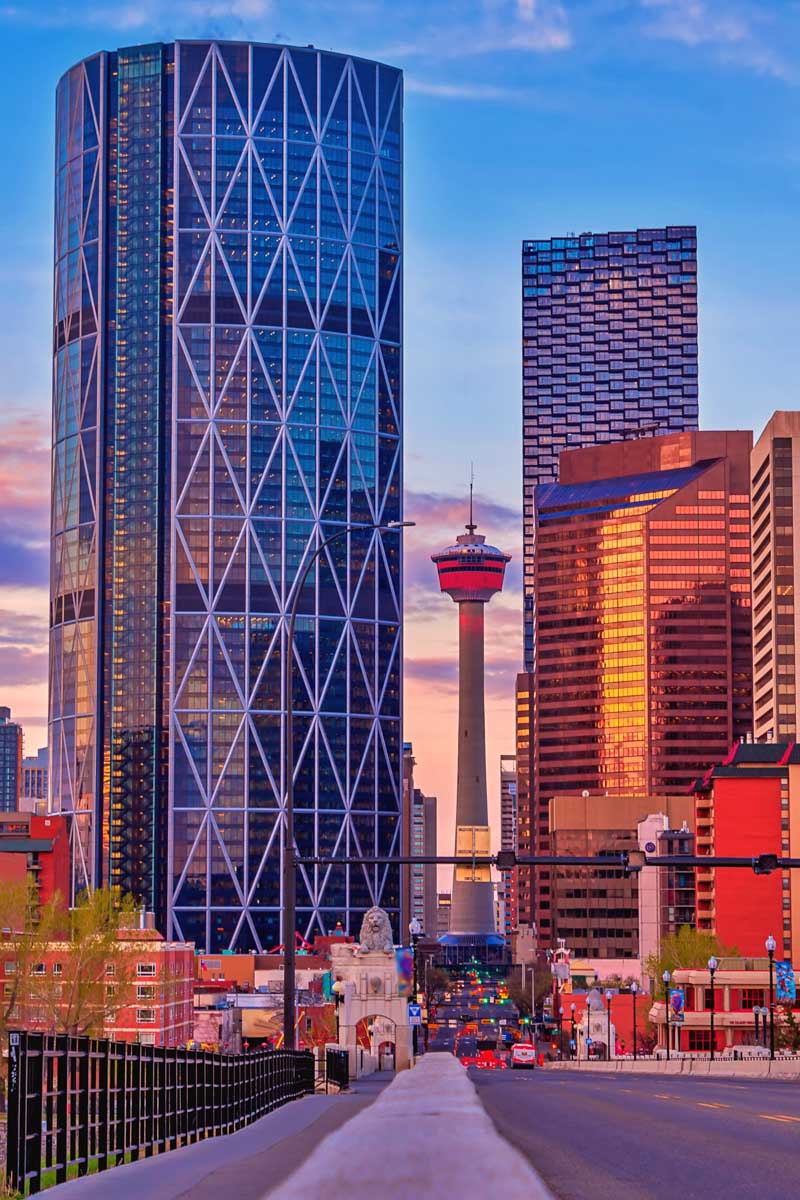
On this day, we recommend arriving in Calgary and driving to Canmore, which is the first stop of our Canadian Rockies itinerary.
You do have the option of staying in the for a day and doing some hikes (which could be a really cool option, especially if the Calgary Stampede is going on).
While many people opt to go directly from Calgary to Banff, I chose to include Canmore because it’s often overlooked by tourists, but it actually is home to some of my favorite hikes and viewpoints in all of the Canadian Rockies.
While often overshadowed by their northern neighbors (Banff and Jasper), Canmore and the Kananaskis area are, in my opinion, some of the most underrated adventure destinations in all of Alberta.
Striking mountaintops, amazing hiking trails, and beautiful alpine lakes will greet you as you explore Canmore, but you can expect smaller crowds here, even during the high season.
Morning: Arrival in Calgary
If you opt for a direct morning flight from anywhere in the USA or Canada, chances are you’ll most likely be arriving in Calgary Airport in the late morning or early afternoon. Once you’ve arrived, proceed through customs (if necessary) and grab your bags.
- For car rentals at the airport: From the arrivals area, follow signs to the main rental car area to pick up your car from your designated agency.
- For car rentals from downtown: Exit after baggage claim and grab a taxi (NOT a black car, these are 2-3x the price!). Make sure you have the address of your rental agency on hand and let the driver know where you’re going. If you’ve decided to rent from Avis (which we usually recommend), their shop is right next to the Calgary Tower.
Lunch in Calgary
After you leave the airport, I recommend grabbing some lunch in nearby Calgary before heading to Canmore.
Known for its ranching industry, Calgary is known around Canada for its meats. For some of the most delicious steaks in the city, Vintage Chophouse is a fantastic place to try. Since I’m not actually a steak person myself, my favorite dish there is the lobster mac and cheese , which is exactly the heavenly deliciousness it sounds like: large lobster chunks mixed in with a perfect blend of pasta and melted cheeses.
For a cheaper, vegetarian-friendly lunch option, The Coup is a fantastic choice. Their bright, open space and delicious, healthy lunch options are AMAZING. Share a Vegan Char”coup”terie board or order the Satay Bowl for lunch… you won’t be disappointed.
After lunch, if you have extra time to check out the city, explore some of the many things to do in Calgary !
Afternoon: Driving In & Exploring Canmore
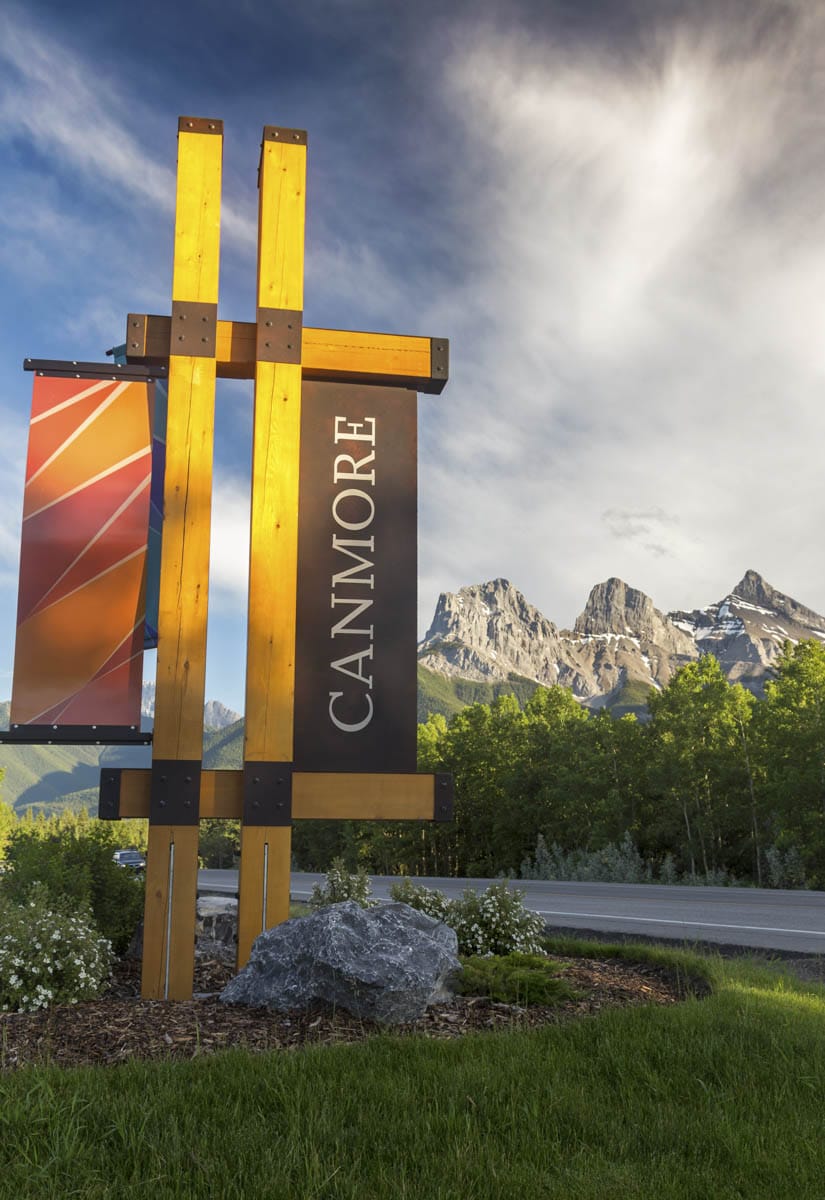
After lunch, you’ll drive ~1 hour down the Trans-Canada Highway (Highway 1) to Canmore. At first, you might think you’re in the wrong place, with flat farmlands for miles.
The plains eventually turn into rolling hills, and then…BAM… you’ll see it: the beautiful, majestic Canadian Rockies. At first just a faint outline on the horizon, they’ll eventually grow larger and bluer right before your eyes.
It’s, like, ridiculously magical.
For outdoor lovers, seeing the Canadian Rockies for the first time is kind of like the feeling you get when you see the Disney Castle. It’s magical, heart-wrenching, glorious. You might cry (I definitely did). Seeing the mountains and knowing that you’ll be spending the next 10 days there? Priceless.
Depending on how much time you have in Canmore before dinner, you can take a drive around the area and even hop on a short hiking trail (see the next section on Day 2 for some recommendations). You can also check into your accommodations (see below for our recommendations) and wander around the town center for a while.
Evening: Dinner at PD3 Blake Canmore
Full disclosure: I’ve never eaten at Blake Canmore . BUT I have a good excuse — the TWO times I tried to go, it was either full with a wait (and I was hangry from hiking) or it was closed. You can choose to dine at Blake Canmore’s more traditional dining hall, but I’d recommend going for the more casual PD3, which is a double decker bus converted into a local dining institution (and the food smelled absolutely heavenly ).
Whatever you choose, don’t be like me: plan ahead and eat your first Canadian Rockies dinner at Blake.
Not only does the food look super drool-worthy (I think I could literally inhale their “crack fries” in approximately 2 seconds), but it’s also reasonably priced and the atmosphere is among the most unique in the region. They also have homemade ice cream flavors and signature drinks/cocktails in case you want to end your day 1 with a sweet treat!
Overnight in Canmore
You’ll spend (at least) the first two nights in Canmore, where hotels and hostels tend to be significantly cheaper than staying in nearby Banff. Here are some of our top recommendations for places to stay in the Canmore area:
- Mid-Range Hotel: The Georgetown Inn – Imagine an old-time pub and inn that magically plopped down in the middle of Canmore and you’ve got The Georgetown Inn. This adorable home-style inn is the perfect landing place for you after long days of hiking, since they boast large, comfy rooms and there’s an attached restaurant.
- Budget Hostel: HI-Canmore – Currently Canmore’s only hostel, HI-Canmore is a fantastic place to stay for budget travelers, solo travelers, and backpackers. With dorms and private rooms, HI-Canmore caters to a wide variety of travel preferences and budgets, while offering typical amenities like laundry, kitchen, and cooking supplies.
- Campsite: Bow Valley Campground – Situated right next to the Bow River and the nearby hiking trails, the Bow Valley Campground is the perfect base in Canmore. The campsites are spacious, the rangers are attentive, there are all of the necessary amenities, and the views are totally epic.
Check Additional Accommodation in Canmore
Day 2: Hiking in Canmore
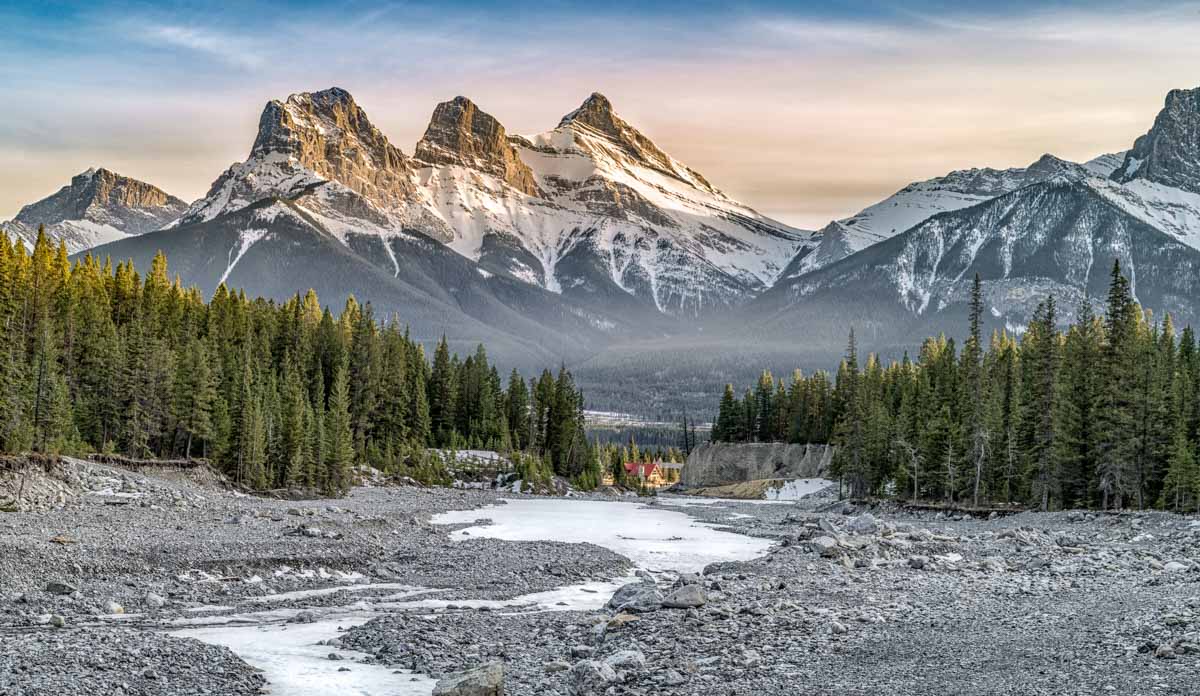
As I say whenever anyone asks me, hiking is the best way to experience the Canadian Rockies , even if you’ve never hiked before or get serious anxiety when you think about climbing uphill (*raises hand and blushes*).
Whether you’ve been hiking since your childhood years or are hitting the trails for the first time ever, there are tons of picturesque hikes in Canmore (and ALL of the Canadian Rockies) suitable for your skill level and preferences.
On day 2 of your Canadian Rockies itinerary, you have a few options: choose 1-2 short hikes in Canmore, or embark on a longer half- or full-day hiking excursion in the area. I’ve listed several hikes, ranging from easy to challenging, in each of the categories below so you have LOTS of options to choose from!
Pro tip: Get started with hiking EARLY. While it will definitely be a little colder outside in the mornings, the most beautiful views of the Rockies happen when the sun is low in the sky, and you definitely won’t want to miss those ideal morning mountain photo opportunities.
Short Hikes in Canmore
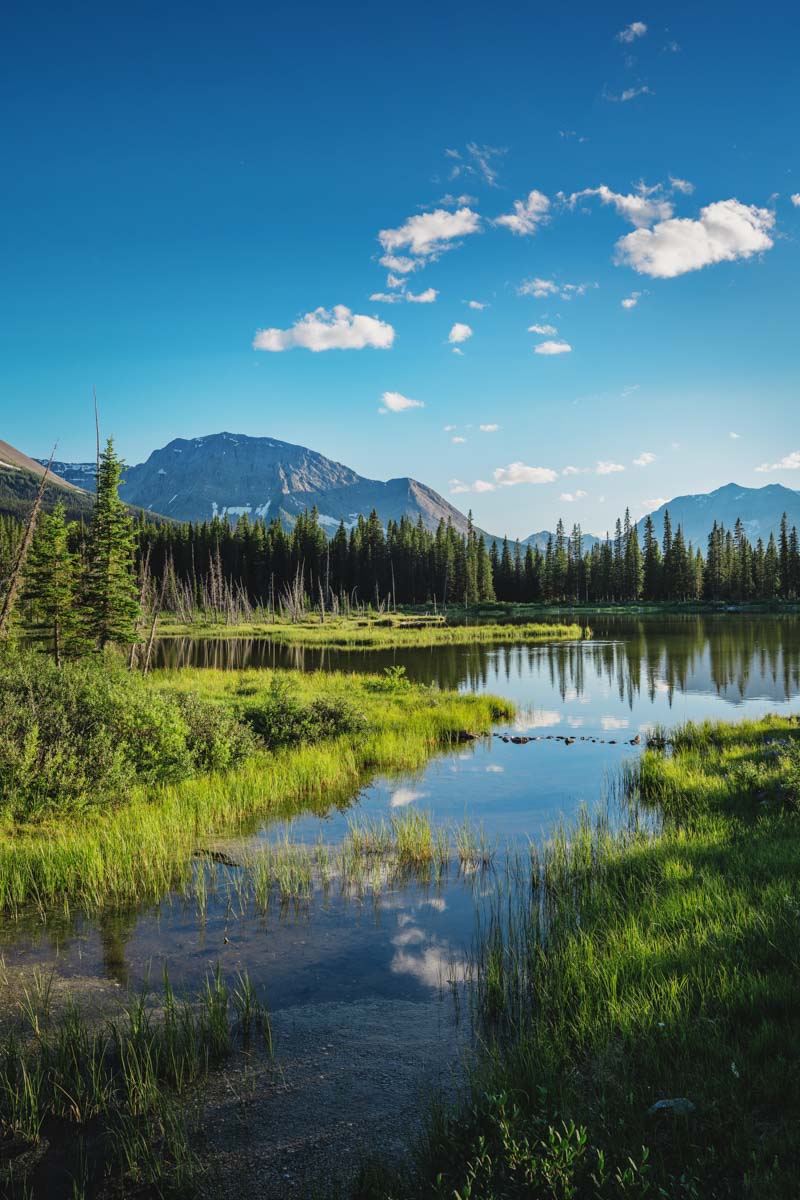
Bow River Loop – (3.5 kilometers, 1-1.5 hours) This is a nice little trail that starts in Canmore town center and loops around to the Bow River. If you’ve arrived in Canmore early enough on Day 1 for a short hike, this is a perfect one to try. Stunning views of the river, evergreen forests, and the surrounding mountains will greet you.
Grotto Canyon – (4.4 kilometers, 1.5-3 hours) One of the most unique hikes in Canmore, the Grotto Canyon trail takes you through huge rock structures where local climbers can often be found scaling the vertical rock faces. The trail is surrounded by large rocks and ends at a waterfall.
Grassi Lakes – (4 kilometers, 1-2 hours) Grassi Lakes is one of Canmore’s iconic hikes and is a local favorite that’s perfect for hikers of all levels. The trail takes you to two deep turquoise alpine lakes surrounded by evergreen trees, and it’s a super tranquil place to go for a short morning hike.
Quarry Lake – (3 kilometers, < 1 hour) This family-friendly loop trail winds around the banks of Quarry Lake, offering beautiful views across the water toward the mountains. You can also swim in the lake if the weather is warm enough!
Half-Day Hikes in Canmore
Ha Ling Peak ( CLOSED UNTIL FURTHER NOTICE ) – (5.3 kilometers, ~4 hours) This is arguably one of the coolest and most picturesque summits in Canmore. But don’t let Ha Ling Peak’s short trail distance fool you: the hike is actually quite difficult, as you’ll ascend well over 800 meters in less than 3 kilometers. The peak itself rewards you with breathtaking panoramic views of the Bow Valley below.
Lady MacDonald Tea House – (9 kilometers, 4-6 hours) This hike, named after a tea house that was never actually built, is a gorgeous trail that has beautiful views start to finish. One of the more popular hikes in Canmore, this moderately difficult hike is a perfect half-day adventure for hikers looking for a bit of a challenge and the reward of stunning photogenic viewpoints.
Full-Day Hikes in Canmore

Mount Yamnuska – (11 kilometers, 6+ hours) By far, Mount Yamnuska is one of my favorite adrenaline-pumping, muscle-throbbing hikes in ALL of Canada! This 11-kilometer trail takes you through an evergreen forest, up a steep rocky scramble, around a chain cliffhanger (seriously), and up to the summit of this iconic Canmore peak. It’s a whopping 900+ meters of elevation gain, so be ready for some SERIOUS uphills and downhills if you choose to tackle this one.
Heart Mountain Horseshoe – (11 kilometers, 6+ hours) I haven’t actually hiked this one, but I’ve heard awesome things about it from friends back in Calgary. This is a moderate to difficult trail that involves a bit of rock scrambling towards the top. The views from the trail and the summit are said to be absolutely incredible.
When You Get Hungry: Breakfast or Lunch at Communitea
Depending on your schedule, you’ll be hungry eventually, and if you need a great stop for breakfast or lunch, I strongly recommend Communitea . It’s a little coffeeshop/cafe hybrid with delicious, healthy dishes and a cute, colorful atmosphere.
Head there for breakfast for a caffeine fix before a big hike, or pick up one of their hot drinks and a delicious, filling savory bowl for lunch after hitting the trails in the morning.
Evening: Dinner at Rocky Mountain Flatbread Co
A Western Canada chain, Rocky Mountain Flatbread Co is literally the perfect post-hiking meal. They’ve got a HUGE oven they use to bake their flatbreads, which come out nice and piping hot to your table. If you’re planning on going during the height of dinner time, I’d strongly recommend making a reservation.
When you check out the menu, you’ll see they have DOZENS of pizza and pasta options to choose from (I may be biased, but you should definitely try the sundried tomato pizza ). You can also grab a Canadian craft beer or a signature cocktail with your dinner.
You’ll spend the night in the same Canmore accommodation you chose on Day 1.
Day 3: Banff Town & Iconic Sights
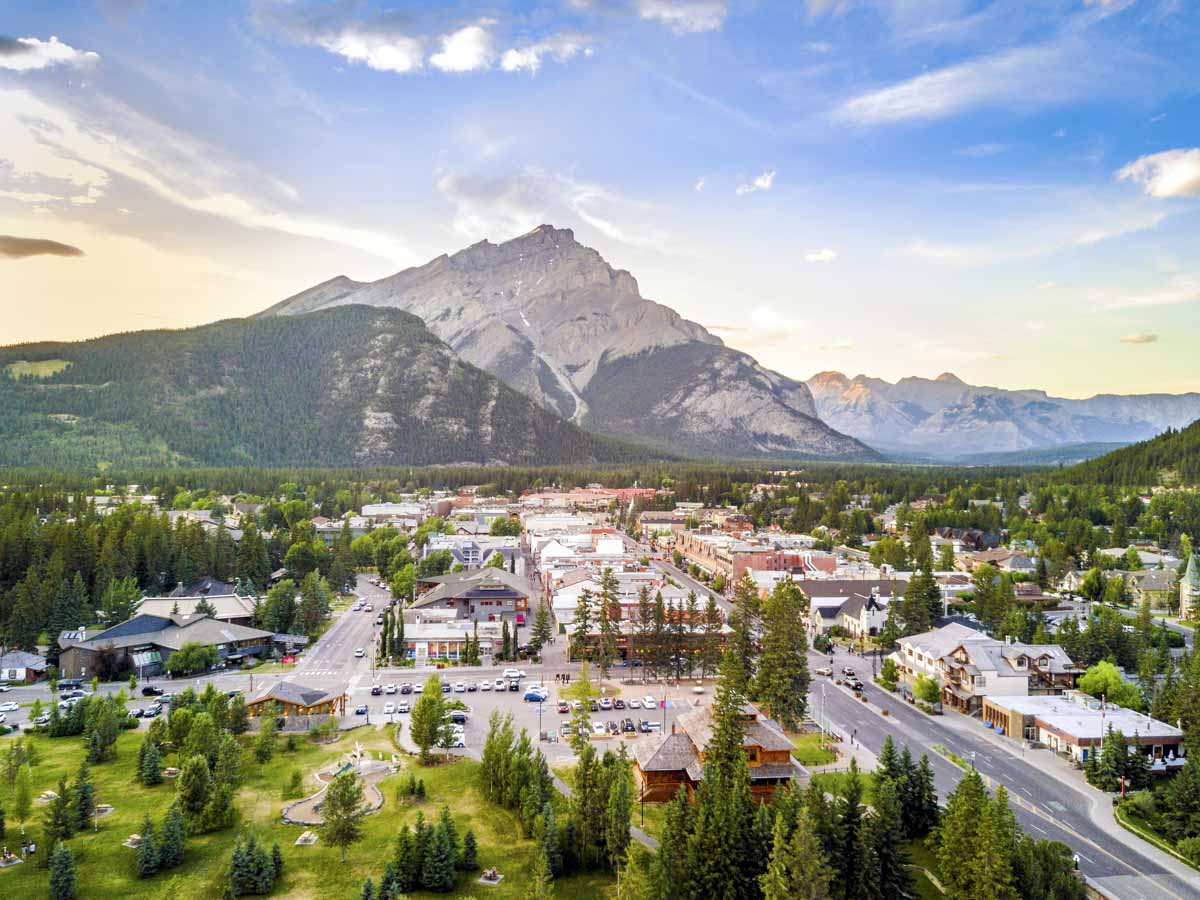
I know I gave you a day full of hiking yesterday, so today, you’ll be taking it a bit more easy on the legs. You’ll drive the short distance to Banff National Park, explore the Banff Town area, eat a delightful dinner at one of my favorite restaurants in Banff, and end the night with some stargazing if it’s clear outside!
Morning: Drive to Banff & Breakfast at Tooloulou’s
Since you’ll be exploring the area near Banff Town today, you can choose what time you’ll want to head out. ( Banff is about a 30 minute drive from Canmore, so make sure you are in the car driving before you get struck with the iron fist of breakfast hanger. )
You’ll continue down the Trans-Canada Highway until you reach the Banff Entrance (which consists of small huts on each lane of the highway where you pay your entrance fee). Pay the fee, which is $9.80 CAD per adult, then continue driving alllll the way to Banff town.
Along the way, you’ll catch a glimpse of Canmore’s stunning Three Sisters and Banff’s Mount Rundle.
Once you arrive in Banff, head to Tooloulou’s , arguably the best traditional breakfast place in town. It’s a Louisiana-style Cajun restaurant with a Canadian flair. Here, you can get french toast, omelettes, and hashbrowns in HUGE (shareable) portions. It’s delicious, especially since I know you’ll be hungry by the time you arrive in Banff.
Late Morning/Afternoon: Explore Banff Town & Surrounding Areas
After you’ve wrapped up breakfast, you’ll hop back in the car and explore the Banff town area. You might be thinking, Kay, I didn’t come to the Canadian Rockies to spend time in a town. But actually, Banff town is pretty small and picturesque, and it’s the town’s immediate surroundings that you’ll be getting to know on this day.
Depending on your energy levels and the amount of time you have, there are several options you can try. Here are a few of the main highlights in and around Banff Town:
Banff Gondola – One of the most fun and picturesque non-hiking activities in Banff is a ride on the Banff Gondola. While the ride is only ~8 minutes each way, the Gondola takes you up to a complex with an incredible panoramic observation deck, a cafe and restaurant, and amazing views for days. ( Pro tip: Head up on the Gondola later in the day when the sun is low in the sky for extra special views!)
Surprise Corner – The Surprise Corner is Banff’s worst kept secret, an unofficial viewpoint that has never *officially* been recognized as a landmark. As a roadside viewpoint just outside the city, the Surprise Corner is actually a popular place to stop off and admire views of the Bow Valley and the Banff Springs Hotel sticking up out of the trees. There are also several trails leading from the parking area around and into the valley below.
Fairmont Banff Springs Hotel – You’ve probably seen photos of the Fairmont Banff Springs all over the internet. If you’re looking for luxury and history all in one place, the Banff Springs Hotel is a fantastic landing spot for you. Situated in the scenic Bow Valley, the hotel boasts several restaurants, a spa, and several amenities for actual guests. However, if you just want to take a look, head there for a leisurely lunch in one of their dining spots.
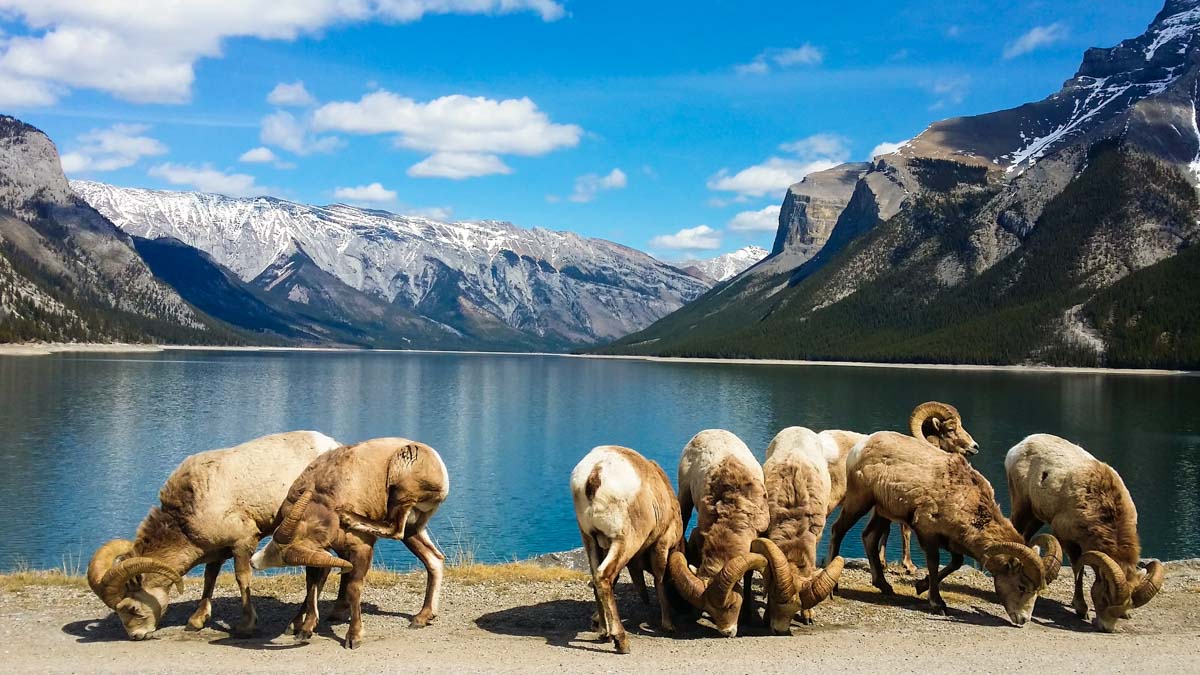
Lake Minnewanka – Lake Minnewanka is one of my favorite places in Banff, if not for the sheer fact that there is SO much to do there. You can rent a kayak or take a boat cruise, wander the lakeside trails or sit down for a picnic. In the night time, you can even stargaze here! I’d recommend heading over there and seeing where the day takes you…but beware: you might end up spending your ENTIRE day here!
Bow River Falls – This is a short, easy hike down to a wide waterfall on the Bow River. It’s a nice, scenic, paved trail that is family-friendly and will take you near Banff town down the river.
Banff town center – If the weather is bad or you’re just too dang tired to do anything, sticking around in Banff town center is NOT a bad option. There are scenic mountain views from the streets, as well as a handful of restaurants, shops, and museums that you can check out to learn more about Banff’s history, including the Whyte Museum of the Canadian Rockies.
If you have more than just 2 days to spend in Banff, here’s our complete guide to the park with a list of 23 amazing adventure activities to try:
Read our complete guide on the best activities & things to do in Banff
Evening: Dinner at Park Distillery & Stargazing
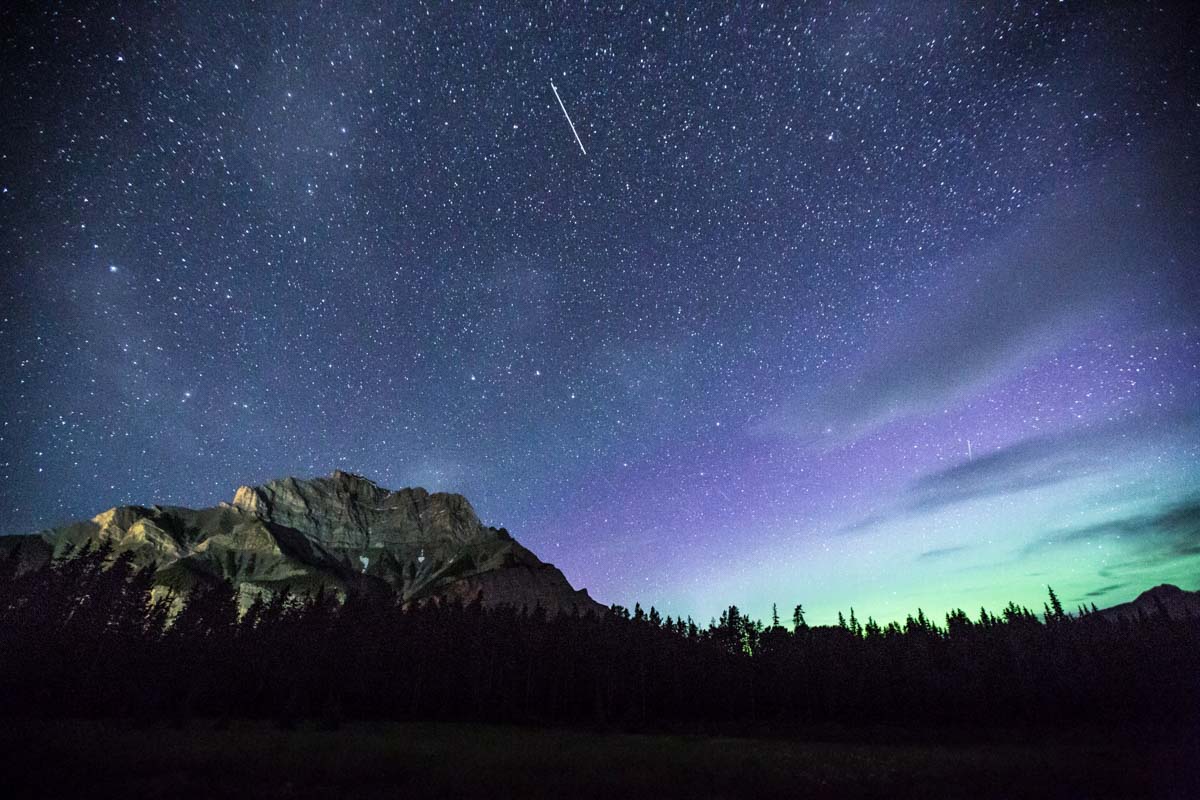
By the evening, you’ll probably be REALLY hungry and ready for a hearty, delicious meal in a relaxed place. I’ve got the perfect place to you: Park Distillery . Their mission is “campfire-inspired meals” and they really do play the part well, from char-grilled meats and steaks to the amazing smell of campfire inside and around the restaurant.
After your dinner, if you’re still a liiiiittle hungry, stop by Beaver Tails nearby for an amazing Canadian dessert: baked (fried?) dough topped with delicious sweet condiments like Nutella, M&Ms, cinnamon, and more.
If the sky is clear while you’re heading out from the restaurant, you can hop in the car and head to a nearby lake for some amazing stargazing opportunities. Outside of the town center, you can see a lot of stars and constellations in areas with little tree cover.
Here are a few beautiful spots in Banff I’d recommend for stargazing:
- Lake Minnewanka
- Vermilion Lakes
- Two Jack Lake
If it’s cloudy or rainy, just head back to your hotel/hostel and cozy up in your blankets. Tomorrow is a day of hiking so you can definitely use a good night’s sleep!
Overnight in Banff National Park
The blessing and the curse of Banff is that there are SO many places you can stay. And making a decision on where to stay in Banff can be a little overwhelming. So, here are my recommendations for a few popular places to stay (or you can read this post for the full list, from luxury lodges to budget hostels):
- Mid-Range Hotel: Moose Hotel & Suites – This is possibly the cutest lodge in Banff, with a big wood fireplace in the lobby and stunning views of the Rockies. If you’re looking for an affordable full-service hotel option in Banff, this one is arguably the best.
- Budget Hostel: Samesun Banff – A cozy hostel located in Banff’s downtown area, Samesun come highly recommend by budget travelers. People really love their laid-back atmosphere, low prices, and kitchen facilities (because, ya know, those restaurants can really add up!).
- Camping: Two Jack Lakeside – This is my #1 favorite campsite in the Canadian Rockies. Located right next to Two Jack Lake, the campsites offer stunning sunrise views of Mount Rundle, as well as amazing stargazing options. Campsites come with access to showers and running water, as well as fire pits (extra fee) and spacious areas to pitch your tent/hammock/whatever.
Click here to check reviews and prices for accommodations in Banff
Day 4: Hiking in Banff National Park
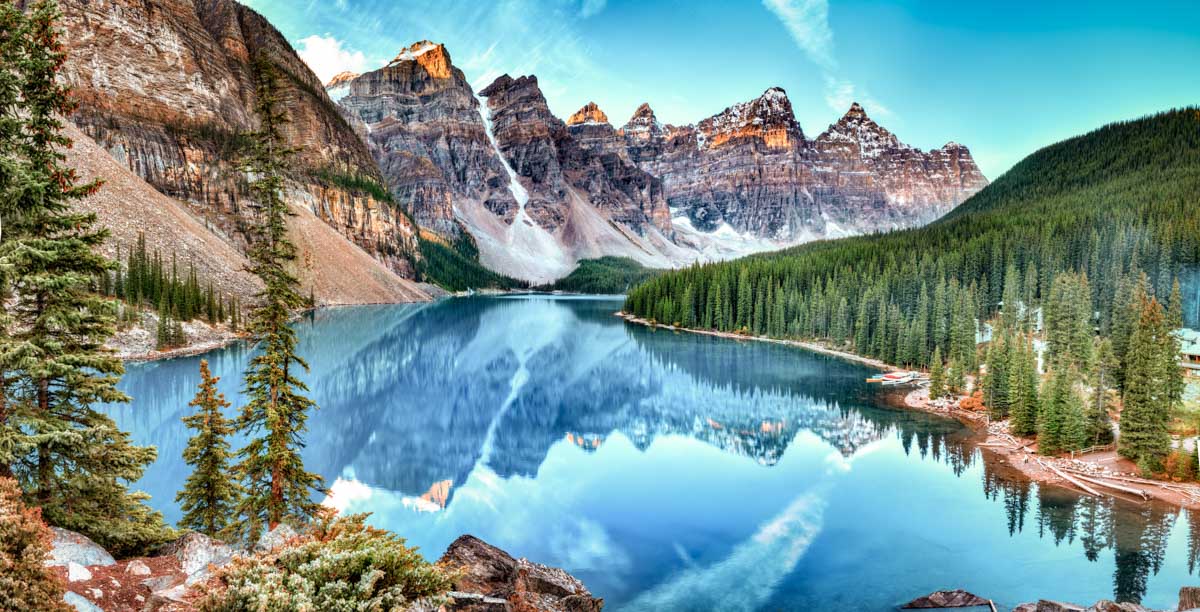
Yup, you guessed it: today is a full day dedicated to hiking! There are SO many fantastic trails in Banff, and it’s worth trying at least 1 or 2 of them before you leave. Before beginning any hike in Banff, it’s wise to check the Parks Canada website for updates on trail conditions and weather forecasts.
Morning & Afternoon: Go Hiking in Banff
Since we’ve got Moraine Lake, Lake Louise, and Johnston Canyon on the agenda for tomorrow, I’d recommend not choosing those for your hiking day today. Here are 3 other wonderful options for hikes in Banff that you can try on today’s itinerary:
Lake Minnewanka Loop Trail (Easy): An easy loop around one of the most beautiful lakes in the area, the Lake Minnewanka Loop is a fabulous day hike for beginner hikers or families. If you didn’t get over to Lake Minnewanka yesterday, I’d definitely recommend this option!
Cascade Amphitheatre (Moderate): Cutting through a valley with rocky mountaintop views, forested trails, and bubbling streams, this hike is a tranquil adventure into the woods. The Amphitheatre itself is a green valley surrounded by vertical rock faces and almost 360-degree views of the surrounding mountains.
Mount Rundle (Difficult): One of the most iconic mountains in Banff National Park, Mount Rundle is an amazing and challenging summit hike to the peak of this beast. If you’re planning to tackle this hike, be sure you’re fully prepared by reading this post and bringing all of the necessary day hiking items you’ll need.
For even more hiking recommendations, check out our complete guide to Banff’s most incredible hikes (for all levels of hikers!):
When you’re not hiking and need some food/refreshments, I recommend heading to Good Earth Coffeehouse in Banff’s town center. It’s a cute, cozy coffee shop that serves warm drinks and food all morning and afternoon.
Evening: Soak in the Upper Hot Springs & Grab Dinner at Banff Ave Brewing Co
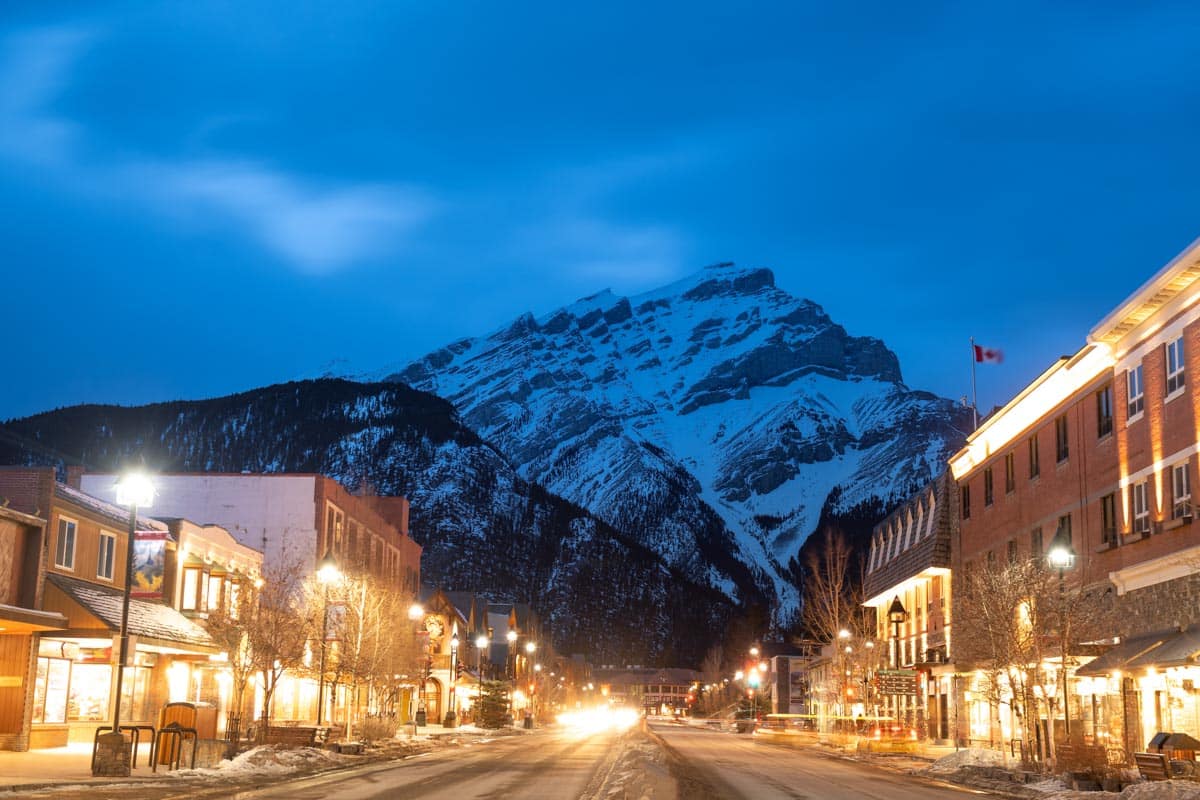
Once you’re done hiking for the day, head to the Banff Upper Hot Springs , which is just outside of Banff town. Here, you can kick back in the steaming hot pool and relax your muscles after a long day of hiking. The pool is clean and spacious, perfect for relaxing for an hour or two before heading off to dinner.
The Banff Upper Hot Springs costs $8.30 CAD for adults and you can rent a towel and/or swimsuit for $1.90 CAD each.
After your soak in the springs, grab some light eats and a beer at Banff’s craft brewery, Banff Ave Brewing Co . They serve up a delicious, affordable, vegetarian-friendly menu and a sizeable variety of beers, ranging from chocolatey darks (my style) to light, sour IPAs (Raf’s style). Get the crunchy fried broccoli and house nachos, or go for a heavier option like the Alberta Beef Burger or the Mushroom Gnocchi.
You’ll spend the night in the same Banff accommodation you chose on Day 3.
Day 5: Lake Louise, Moraine Lake, & Johnston Canyon
This is one of the most iconic days in the itinerary, where you’ll be headed to the famous Moraine Lake (yup, the one you see in all those Instagram photos of Banff), Lake Louise, and Johnston Canyon.
But here’s the catch: this day starts EARLY.
If you can be out of the house by 5:30 AM or before sunrise, that’s ideal.
This way, you’ll avoid the treacherous crowds at Moraine Lake and Lake Louise, and you can spend the afternoon strolling through Johnston Canyon (Or, like, napping in a tree from waking up so early. Both are acceptable.).
Early Morning: Moraine Lake

Set that alarm for 5 AM and grab a Clif bar to go for your breakfast as you leave your Banff hotel to drive ~40 minutes to the Lake Louise area.
You’ll see the iconic Lake Louise a bit later in the morning, but you’ll first want to drive up to nearby Moraine Lake to catch that epic sunrise view that EVERYONE AND THEIR MOTHER wants to see.
The parking lot for Moraine Lake is pretty small, which is why I’m recommending getting up so early. When Rafael and I went there for the first time, we arrived around 6 AM and, while we weren’t the only people there, we had the place largely to ourselves.
Park in the parking lot and go for a stroll around the lake, or up onto the famed Rock Pile to get that incredible view that everyone raves about (there’s a reason why this is one of the most Instagrammed places in Banff ).
Morning: Breakfast & Hiking at Lake Louise
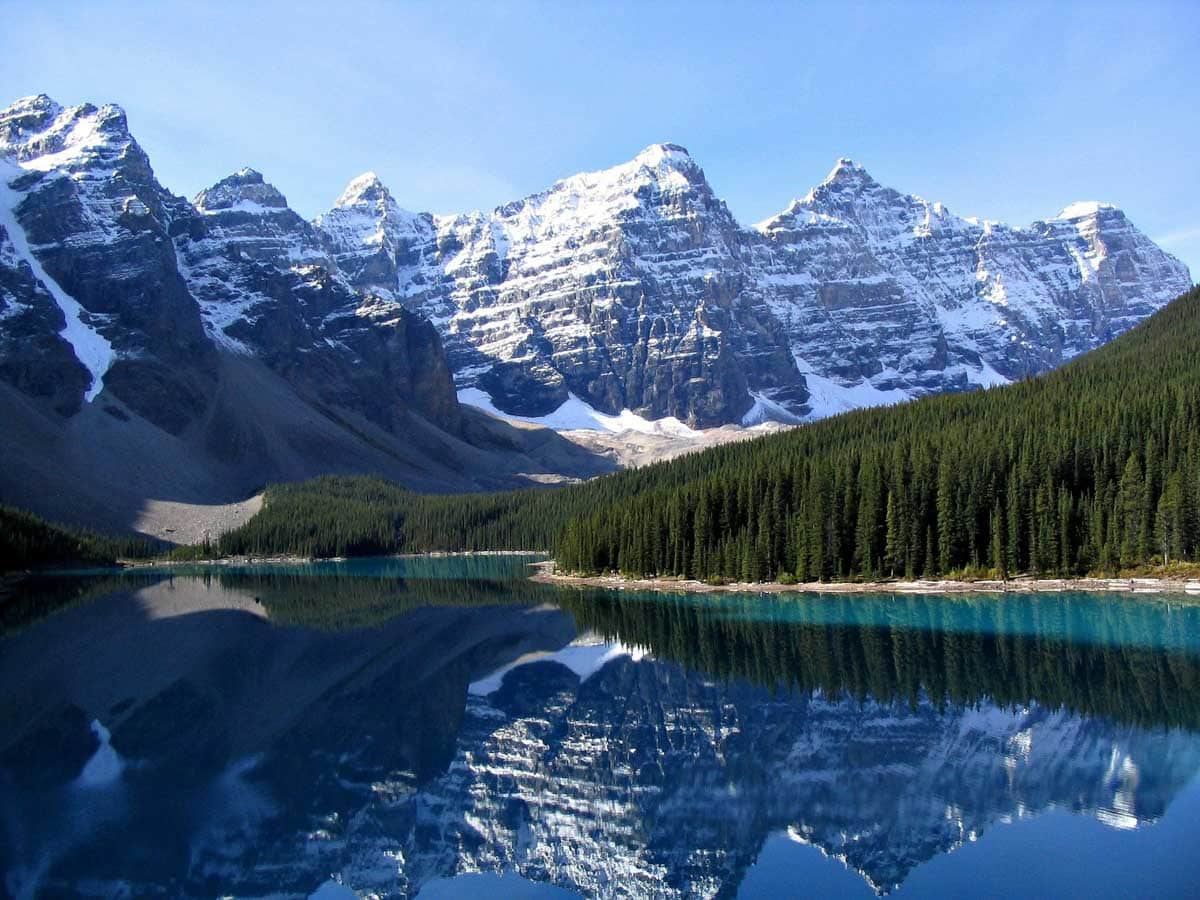
Once you’re finished at Moraine Lake, you can either head straight to Lake Louise or stop at Trailhead Cafe for a coffee and a bite to eat. Their “The Cure” sandwich is amazing to start (continue?) your day.
When you’re ready, head to Lake Louise and try to snag a parking spot as close to the entrance as possible. During the high season, the parking lot fills up and you have to park at a different one a few miles away and then shuttle in (which sucks, don’t do it).
If you get to Lake Louise early enough, you won’t have this problem. Instead, you can park right in front of the hotel and stroll right into the main lake area. Once you arrive at the lake, you’ll see the otherworldly turquoise water, the famous Fairmont Chateau Lake Louise, the amazing glacier, and striking mountains around you.
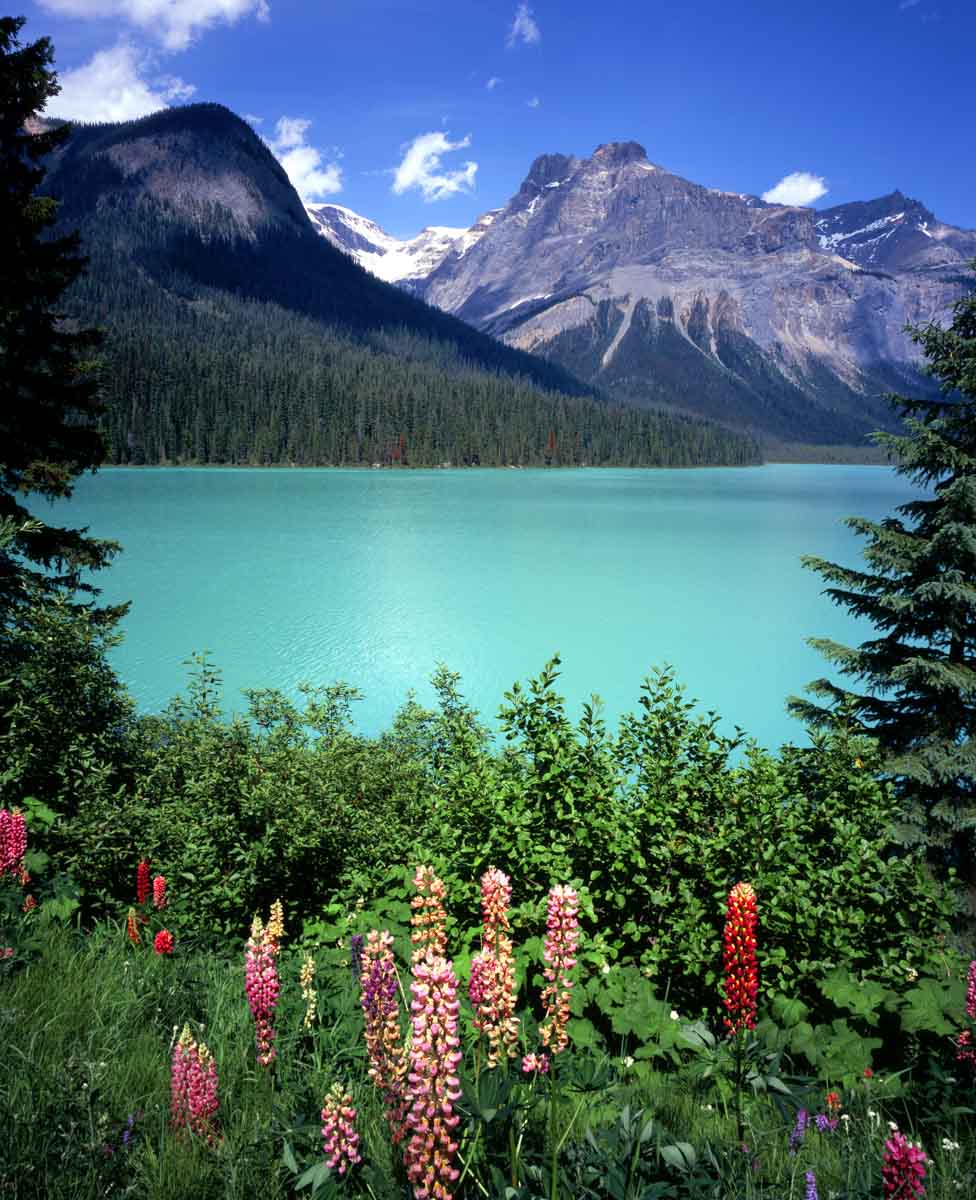
At Lake Louise, you have a few options. You can simply hang out around the hotel and the waterfront, or you can:
- Rent a kayak and explore the lake on the water
- Have brunch at Poppy Brasserie , the Fairmont’s breakfast restaurant which boasts table-side views of the lake and the surrounding mountains
- Do the Lake Agnes Tea House hike , which takes you up to a hidden alpine lake and a cozy tea house that serves warm drinks and snacks in the summer
- Embark on the Plain of Six Glaciers hike , which is a half-day hike that takes you to some pretty epic glaciers and landscapes around and above Lake Louise
If you’re planning on just stopping by Lake Louise, you won’t need more than an hour in the area. However, if you plan on doing any of the above activities, plan for 3-4 hours (5+ hours for the Plain of Six Glaciers hike).
Afternoon: Hiking at Johnston Canyon
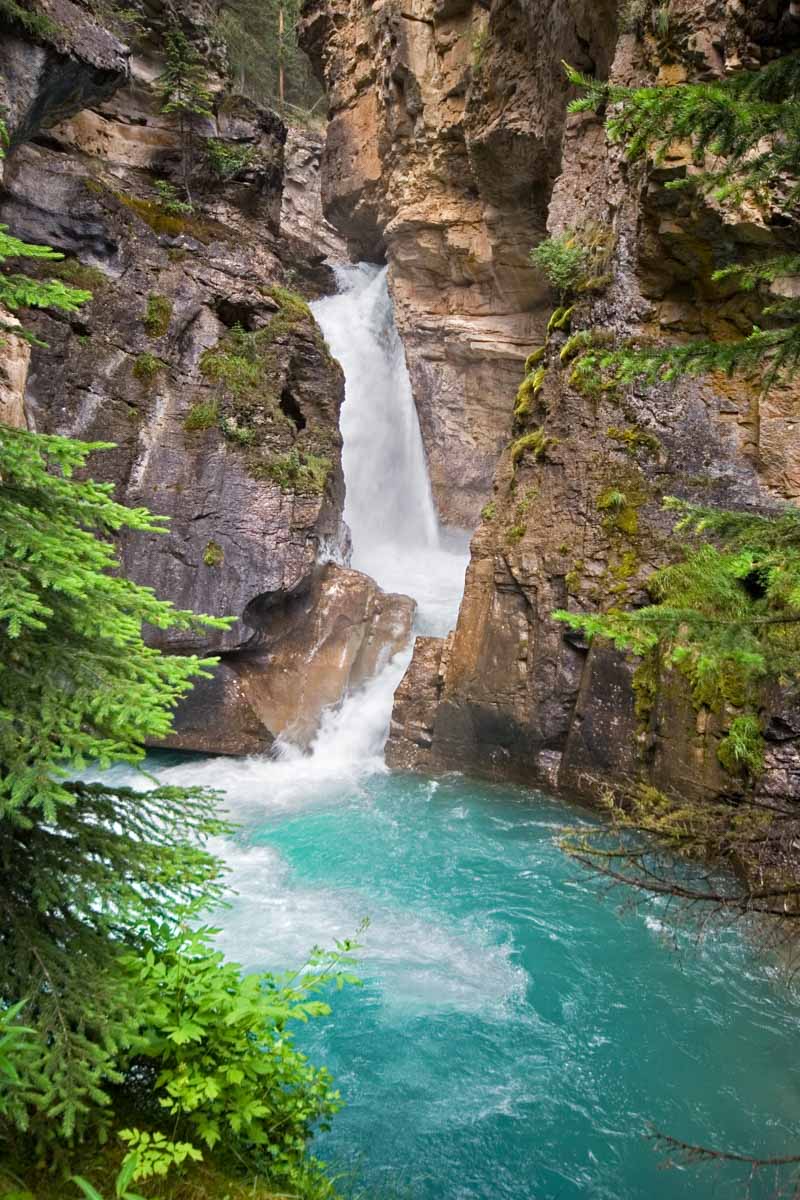
After you’ve wrapped up at Lake Louise, you can head towards Johnston Canyon, which is a nearby trail system that travels through a beautiful, stark canyon with teal rivers and waterfalls running through it. If you’re hungry, at the entrance is a small gift shop and cafe where you can buy soups and sandwiches.
On the trails, there are a series of catwalks that take you through the canyon to two sets of waterfalls – the Upper and Lower Falls – and a lake area called the Ink Pots. At the Ink Pots, you can see multicolored pools of water that look really unique and cool for pictures.
You can choose to only visit one or both of the falls, but keep in mind that the total Johnston Canyon trail from the start to the Ink Pots is ~11.7 kilometers round trip.
Evening: Dinner at Bill Peyto’s Cafe
After your busy, busy day in the northern part of Banff, there’s nothing better than sitting down for a big, warm dinner. Bill Peyto’s Cafe is an affordable and popular choice in the Lake Louise area for exactly that.
Full disclosure: I’ve actually never eaten here , but I’ve heard raving reviews about this place, which is actually attached to the HI-Lake Louise Hostel . After a long day (which this one definitely was), it’s a great place to enjoy hearty, affordable Canadian food and drinks.
Try the elk burger with a side of Canadian craft beer , and don’t forget to try their famous hot sticky toffee pudding cake .
Overnight near Lake Louise
On this night, you can choose to stay in your same Banff accommodation as the last two days, OR you can relocate closer to Lake Louise. I tend to prefer the latter because tomorrow, you’ll be heading north toward the Icefields Parkway, and it will eliminate over half an hour of driving for you the next day. Gotta make up for the sleep you lost last night!
Here are a few options for places to stay near Lake Louise:
- Splurge Resort: Fairmont Chateau Lake Louise – I know I haven’t been giving many “splurge” recommendations for this itinerary, but if you’re going to splurge for ONE NIGHT on your trip, this is it. I’ve been dreaming of spending a night or two in the Fairmont Chateau Lake Louise since the first time I visited, and I’ll be saving those pennies until I can do so one day. Anyway, if you’ve got the cash, there’s no better place to spend a night than this iconic hotel, which rests on the banks of Lake Louise itself.
- Mid-Range Hotel: Paradise Lodge & Bungalows – Perfect for larger groups, this family-friendly set of bungalows is located on the road to Lake Louise and offers large full kitchens in-unit. There’s no on-site restaurant, but the Lake Louise Visitor’s Centre isn’t far.
- Budget Hostel: HI-Lake Louise Alpine Centre – HI-Lake Louise Alpine Centre is located just outside of Lake Louise near the Visitor’s Centre. As another Hostelling International hostel, you can expect clean, cozy dorms and private rooms, large social areas and a kitchen, and affordable rates.
- Camping: Lake Louise – This tent camping spot is located right near Lake Louise and is the perfect place to spend a night in the area.
Day 6: Icefields Parkway
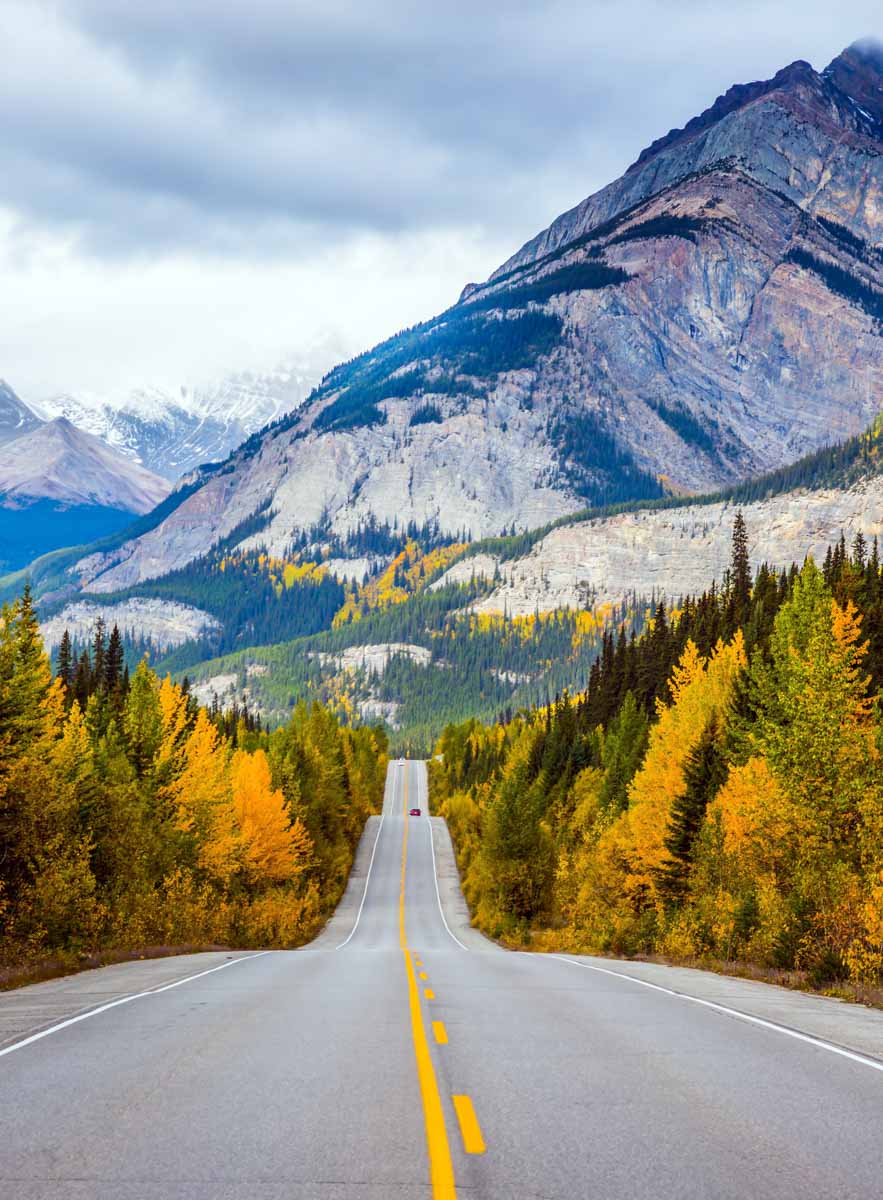
On Day 6, you’ll head up to Jasper via the most beautiful highway in the Canadian Rockies (and maybe in Canada…or the world…).
Nothing screams Canadian Rockies road trip more than driving its most scenic route, and today you’ll have the chance to do that, with a bunch of stops in between.
While the drive itself only takes ~3 hours, you’ll definitely want to stop for some photos, fresh air, hiking, and more. In this part of the itinerary, we’ve laid out all of your options for places to stop and things to do along the Icefields Parkway.
Morning: Alpine Lake Viewpoints
Grab an early breakfast to go at Trailhead Cafe in Lake Louise. I’d also recommend grabbing some extra sandwiches to go for lunch later, as you may not want to stop for food during your road trip.
Then, head out north on the Icefields Parkway towards Jasper. There are tons of amazing places to stop as you leave the Banff National Park area and turn into the Columbia Icefield.
First, stop at Peyto Lake, which is about 40 minutes from Lake Louise. Peyto Lake is a stunning turquoise lake that you can admire from its highway upper viewpoint, and it’s definitely worth at least a short photo stop before continuing onward.
Late Morning & Afternoon: Choose Your Own Adventure
After you’ve stopped at Peyto Lake, you have a TON of options for things to do along the way. Here are just a few of the many hikes, activities, and viewpoints you can stop at along the Icefields Parkway:
Columbia Icefield Discovery Centre – The discovery centre sits off of the icefields parkway about an hour and a half away from the Jasper Information Centre. Here you can get some scenic views from the top of the centre and you can book excursions out into the icefields. If you are feeling hungry, grab a bite in the attached Altitude restaurant. If you are just passing by on the way to Jasper, plan to spend 30 minutes here for a quick pit stop.
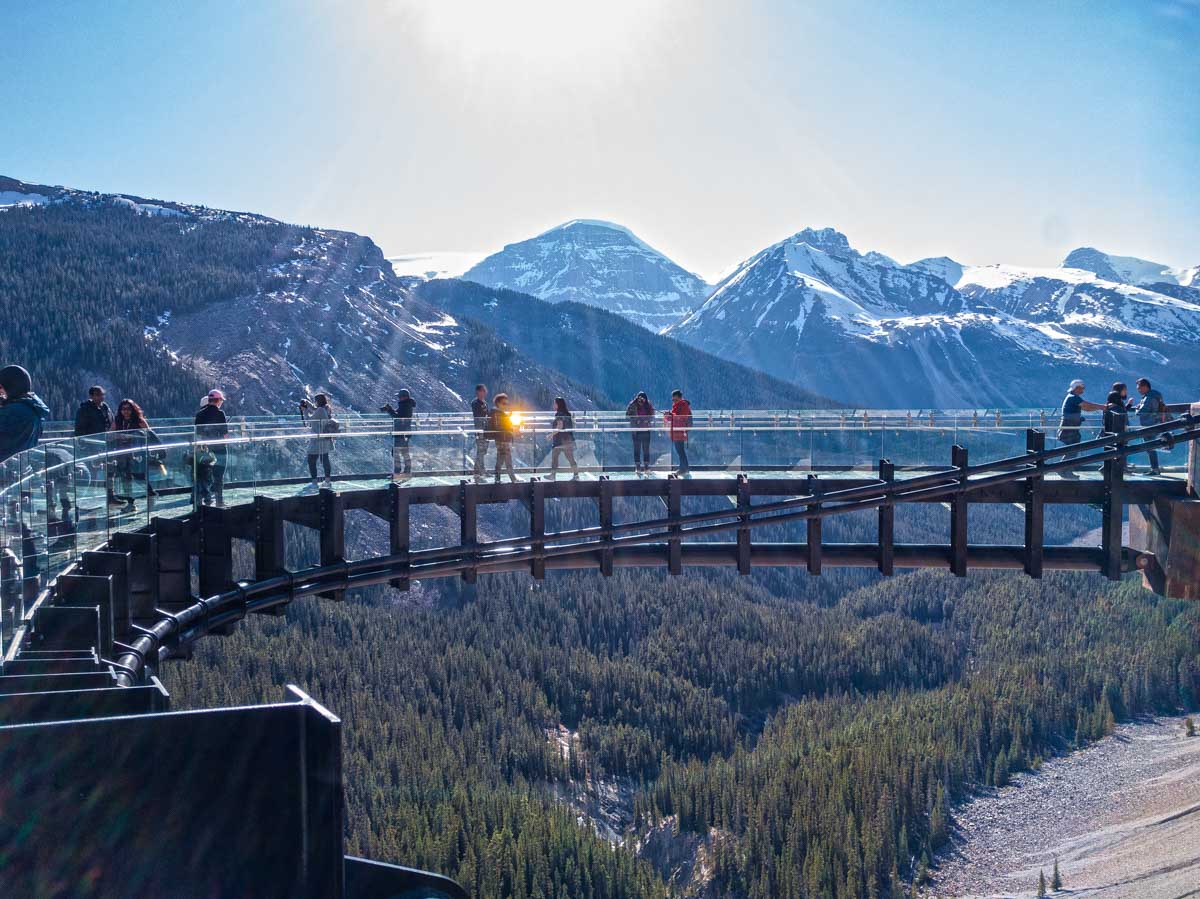
Glacier Skywalk – Take a 400 m walk along a glass-bottomed walkway that overlooks the gorgeous Sunwapta Valley 280 meters below. Tickets for the attraction can be purchased at the nearby Columbia Icefield Discovery Centre, which is about 6 km away towards Banff on the Icefields Parkway. Tickets cost $35 at the door, but you can pre-purchase them online for a slight discount. Plan to spend 30 minutes to an hour there.
Do a Glacier Walk – Take an Athabasca Glacier Tour where you can walk on and drink from the 10,000 year old sheet of ice. You’ll be taken out to the glacier on a huge all-terrain bus with a knowledgeable guide who will teach you about the area’s history. After arriving on the glacier, you’ll get to walk directly on the ice and explore crevasses and hills. Some tours are all day events (10 am – 5 pm), but you can find shorter trips at the Discovery Centre that are 3 hours in length.
Mistaya Canyon – If you are looking for a short half hour break while driving up to Jasper, consider stopping at Mistaya Canyon. Look for a small parking area about 5 km South from the Saskatchewan Crossing. You’ll take a short 10 minute hike that crosses a wooden bridge where you can see beautiful views of the mountains and waterfalls surrounding Mistaya Canyon. This spot is not as well known to many tourists, so it’s a good peaceful place to stop on your way to Jasper or Banff.
Herbert Lake – Herbert Lake is only 6 km away from Lake Louise along the Icefields parkway. Similarly to Mistaya Canyon, looks for a small pull-out area next to the highway where you can park your car. A short 5 minute trail will take you to a brilliant, scenic view of a tranquil, mirrored lake. You’ll have the option of following the trail around the perimeter of the lake if you choose, or simply enjoy the serenity and tranquility of this secluded area.
Chephren Lake – Stop off at the trailhead for Chephren Lake, one of my favorite lakes on the Icefields Parkway. You have to hike in ~3 hours round trip to get there, but I promise the views are totally worth it. By the time you finish up with Chephren Lake, it should be early afternoon and you’ll be ready to continue on to the rest of the Icefields Parkway.
Parker Ridge – About an hour and half from Lake Louise, Parker Ridge offers unparalleled views of the Icefields and Saskatchewan Glacier. The hike is a short 2.7 km that climbs 250 m. You’ll be above the treeline for the majority of the hike. Set aside about 2 hours for the entire round trip. Parking is limited.
Evening: Dinner at Evil Dave’s Bar & Grill in Jasper
For a cozy dine-in experience, Evil Dave’s Bar & Grill is a local favorite. With eclectic decor and delicious, large dishes, it’s a really awesome choice for a post-road trip dinner in Jasper.
They serve up Western Canadian favorites, like Tenderloin and Grilled Chicken sourced from Alberta, but they’ve also got a whole list of amazing vegetarian and vegan options as well.
Overnight in Jasper
- Mid-Range Hotel: Pyramid Lake Resort – This resort looks like a giant log cabin from the outside and sits right next to a lake. Guests will have scenic views of the mountains and can dip their feet in the water just a couple of feet from the hotel.
- Budget Hostel: Jasper Downtown Hostel – With dorms and private rooms, the Jasper Downtown Hostel is the best place for backpackers in Jasper. It offers all the proper amenities of a hostel, including common areas, a shared kitchen, and laundry machines on-site.
- Campsite: Wapiti Campsite – Wapiti is located next to the Athabasca river and offers gorgeous views of the mountains. The site includes access to hot showers, electricity, and fire pits. It is also close to the main town so you can make quick runs for supplies.
Day 7: Hiking in Jasper
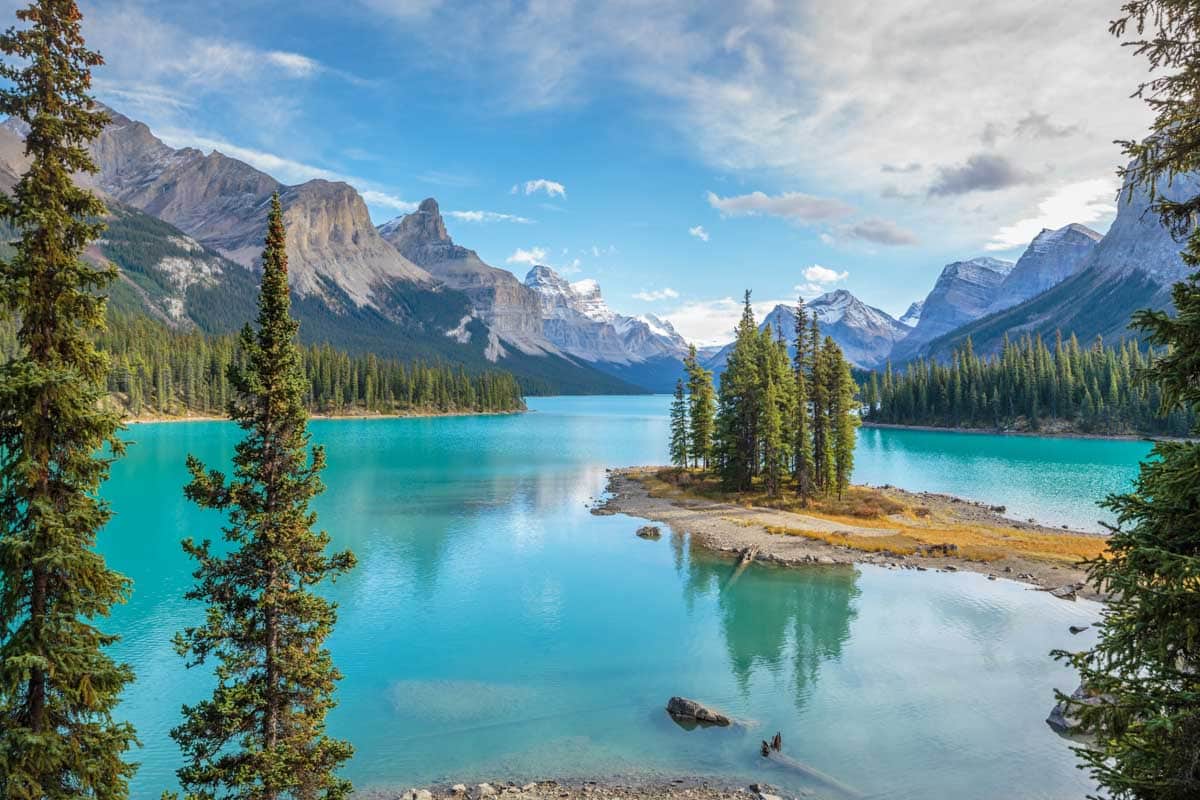
Day 7 is all about exploring Jasper by foot! ( Do you like how I’ve left a whole day in every destination on this itinerary for hiking? Yeah…I kind of like hiking… ) There are several hikes in Jasper for hikers of all levels, from “never hiked before” beginners to experienced mountaineers.
Today, you’ll spend most of the day hiking, then you’ll relax in the hot springs before treating yourself to dinner in one of Jasper’s best restaurants.
Morning & Afternoon: Hiking in Jasper
Like I mentioned, there are dozens of hikes you can try in Jasper ranging from easy, flat trails to rock scrambles. I’ve listed out some of the most popular ones for you here so you can choose 1-2 and plan your day:
Easy Hikes in Jasper
Maligne Canyon: (Easy, 3.9 kilometers) An easy, short hike, Maligne Canyon brings you through a striking canyon, passing by ranging rivers and breathtaking waterfalls in the process. Perfect for families or beginner hikers wanting to see some of the most awesome views in the park!
Valley of the Five Lakes: (Easy, 4.5 kilometers) The magic of the Valley of the Five Lakes trail is exactly what it sounds like: five gorgeous, picturesque lakes with the Canadian Rockies lying majestically in the background. It’s perfect for beginner hikers wanting an easy half-day adventure on one of the most tranquil and iconic Jasper hiking trails.
Moderate/Challenging Hikes in Jasper
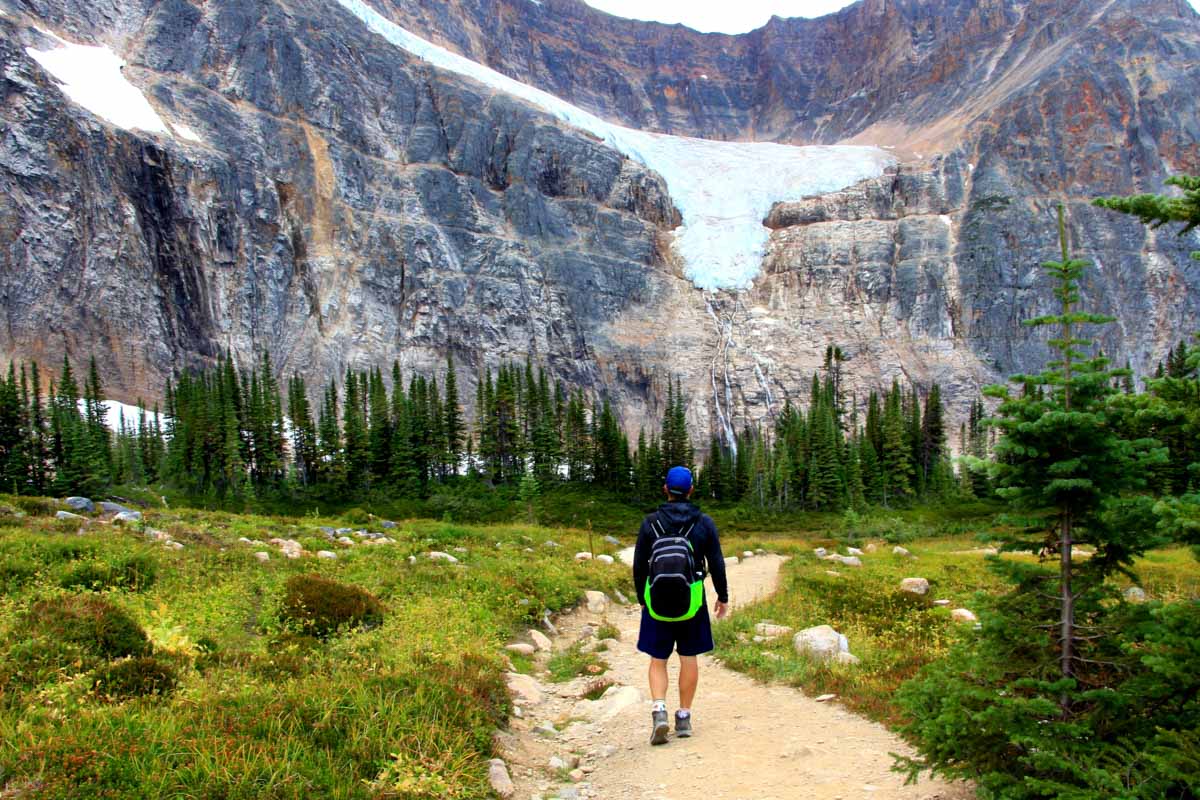
Edith Cavell Meadows: (Moderate, 6 kilometers) Edith Cavell Meadows is one of the most popular trails in Jasper, and for good reason – it’s got a bit of everything, from mountain views to alpine meadows to hanging glaciers and more. The first part of the path is paved, leading you to a lookout point over Angel Glacier. After the lookout point, the trail continues ascending, and the path leads to two more viewpoints – most people (myself included) choose to stop at the second one.
Bald Hills: (Challenging, 13.2 kilometers) As one of the most popular full-day Jasper hikes, Bald Hills is an amazing and challenging trail that will bring you up to some of those drop-dead gorgeous views you see in the postcards. This summit hike is one of the best hikes you can do in the park, and we highly recommend it if you’re up for the challenge.
If you’re in need of some food for fuel or relaxation, head to Coco’s Cafe in downtown Jasper. They serve amazing coffee beverages and snacks for hungry hikers (including some seriously mouth-watering vegetarian and vegan items), and their prices are affordable.
Evening: Dinner at Maligne Canyon Wilderness Kitchen
For the perfect smoky, rich, locally sourced meal, there’s no better place in Jasper to try than the Maligne Canyon Wilderness Kitchen . Located next to the Maligne Canyon trailhead, this small, charming restaurant embodies the spirit of Canadian Rockies gastronomy, with locally sourced meats and produce.
If you’re super tired from the trails, you can also grab their mouth watering dishes to go, but why not stick around and enjoy the fresh smells and flavors in-house?
You’ll spend the night in the same Jasper accommodation you chose on Day 6.
Day 8: Jasper Town & Iconic Sights
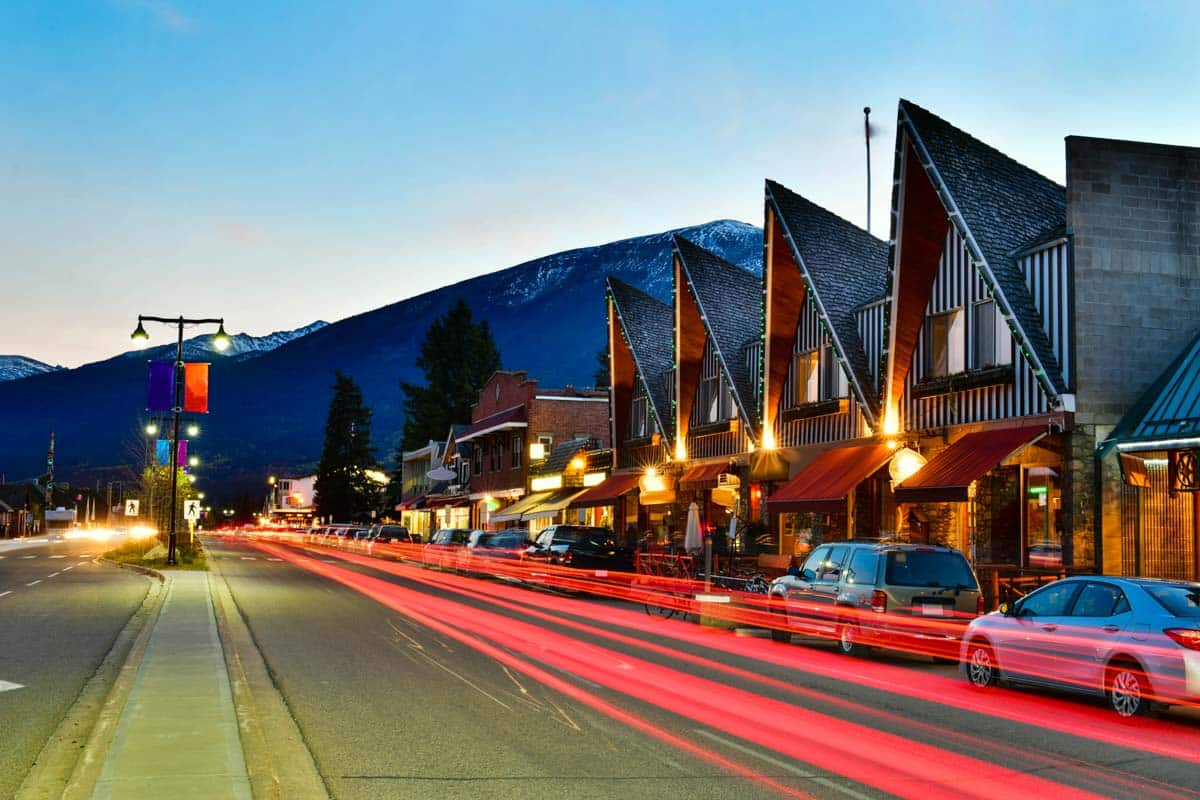
After your big day of hiking yesterday, you’ll take it a little bit easier on Day 8. However, you’ll start your morning super early with a beautiful sunrise view, head to one of the most picturesque lakes in ALL of Jasper, and then explore the area surrounding Jasper town before heading toward Yoho National Park.
Early Morning: Sunrise at Pyramid Lake
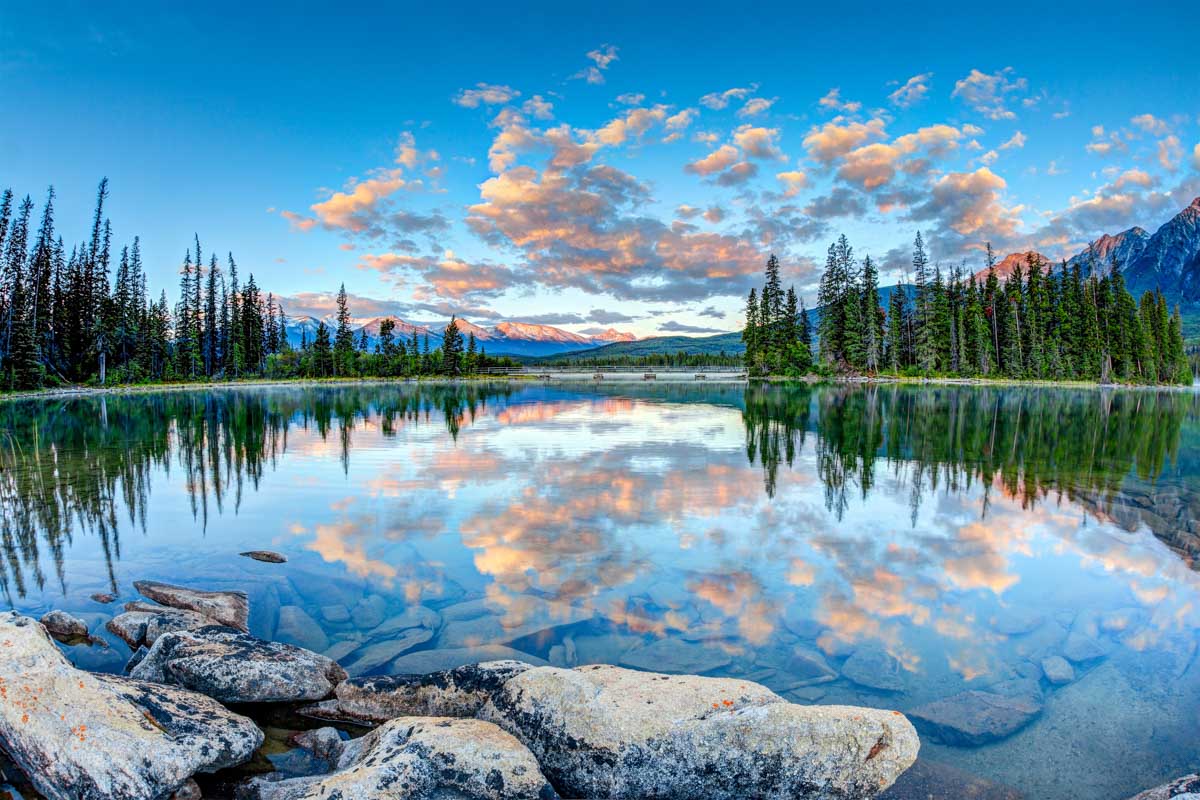
You’ll head out before 6 AM (check the sunrise forecast on your Weather app for a more accurate departure time) to Pyramid Lake.
This dramatic lake is home to a towering mountain peak, a beautiful blue lake, evergreen forests, and a large wooden lodge.
You should get there when the sky is still a deep navy blue, but just bundle up and wait for the sunrise. If it’s clear enough outside, you should start to see the faint hues of pink and red slowly start to paint the mountain face (like the photo I took a few years ago below).
If you’re looking for an alternative view, nearby Patricia Lake is also a really lovely place to watch the sun as it peeks over the horizon. Patricia Lake’s water is a lot more still than the water at Pyramid Lake, creating a gorgeous “mirror lake” effect.
Head back to Jasper town center to grab a quick coffee and breakfast at Coco’s Cafe (or another one of Jasper’s coffeeshops!).
Morning: Maligne Lake
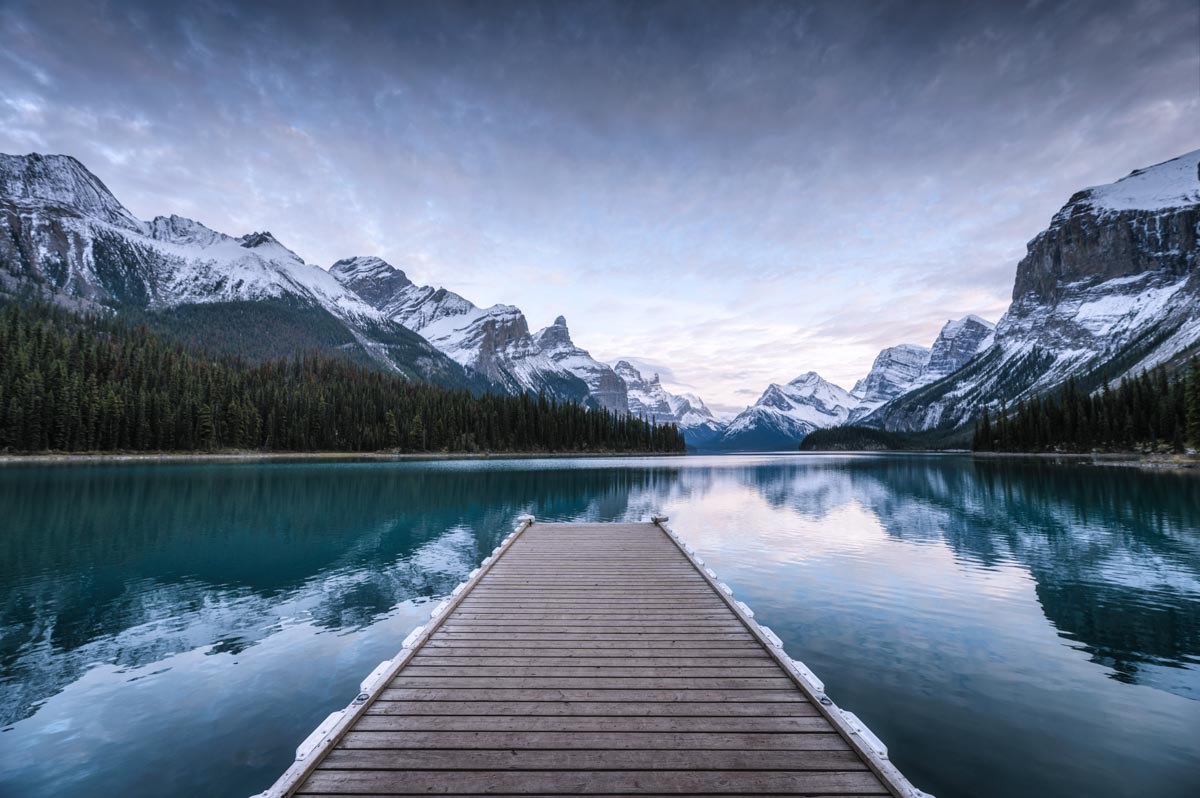
From Jasper town center, it’s a bit of a drive to arrive at Maligne Lake. However, once you’re there, you can spend the rest of the morning simply wandering around the area, doing a nearby hike or getting out on the water.
Here are a few ways to spend your morning in Maligne Lake:
Admire Spirit Island – One of the famous views in Jasper is Spirit Island, a tiny, evergreen-filled island jutting out into the middle of Maligne Lake. It’s super picturesque amidst the backdrop of the clear, turquoise waters of Maligne Lake, and makes for a super picturesque spot to spend the morning.
Take a boat tour – There are a handful of motorized boat tours that travel through the Maligne Lake area, and you can book one very easily. If you’re feeling tired from all of your travel (I understand, this itinerary is SUPER jam-packed!), opt for a relaxing boat cruise around the beauty of the lake.
Kayak around the lake – If you’re looking for an active alternative to the boat cruise, you can rent a kayak and explore around the lake yourself!
Go hiking – There are tons of trails and hiking areas that extend from Maligne Lake up into the nearby mountains.
Early Afternoon: Explore the Jasper Town Area
Now that you’ve spent virtually the entire morning outside, you’ll return to Jasper town center and enjoy some of the more laid-back attractions in the area.
Since you won’t have a TON of time to do things in Jasper town, here are a few suggestions for things you can do with 2-3 hours:
Ride the Jasper Skytram – The Jasper Skytram brings you close to the top of Whistlers Mountain. There’s a sizeable observation deck and an area where you can grab food and drinks. Or, if you’re feeling more adventurous, hop on the hiking trail near the platform to reach the summit of the mountain.
Go cycling on Jasper’s bike paths – Rent a bike at Vicious Cycle Canada and hit the trails! There are plenty of bike trails in and around Jasper’s town center where you can explore on wheels.
Visit the Jasper-Yellowhead Museum – Located in the center of Jasper, the Jasper-Yellowhead Museum discusses how Jasper’s community began, and provides important historical context to the area that’s now largely known for its natural beauty and adventure activities.
For our entire list of things to do in and around Jasper town, check out the complete guide:
Click here to read our complete guide to things to do in Jasper
Late Afternoon & Evening: Drive to Yoho National Park
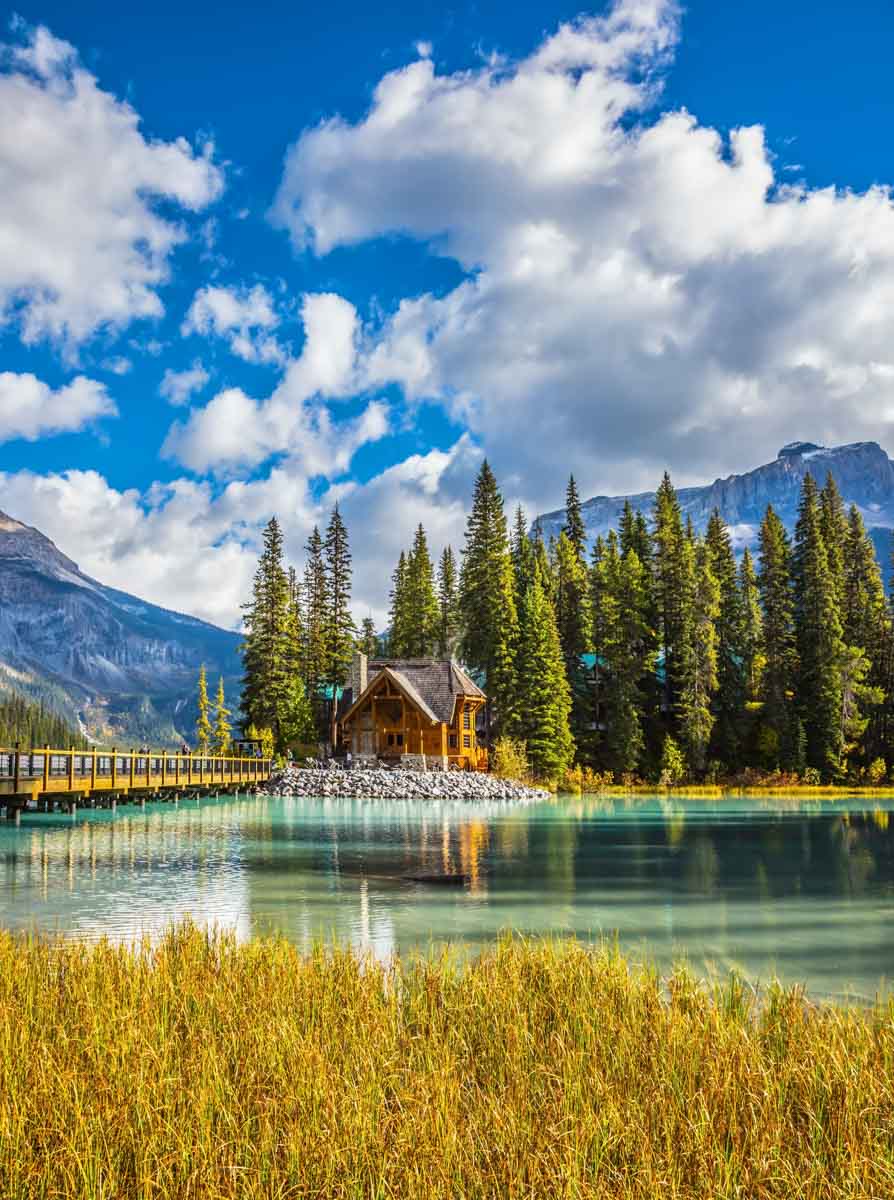
The drive to Yoho, your next stop, takes 3.5-4 hours, and since you’ve already made your stops on the Icefields Parkway, you can drive it straight. However, I’d plan to leave Jasper no later than 2 PM to make sure you have plenty of daylight to drive all the way to Yoho.
Once you’re in Yoho, you’ll actually stay in Field, the town of Yoho. There, you can grab dinner (I recommend Truffle Pigs Bistro & Lodge ) before settling in to your accommodation for the night.
Overnight in Field (Town of Yoho National Park)
- Mid-Range Hotel: Truffle Pigs Lodge – This 12-room inn is a small, comfortable, mid-range hotel option. With private rooms and bathrooms and an attached restaurant, it’s the perfect full-service accommodation option for Yoho. It’s also located in the heart of the tiny town of Field, perfect for access to all of the main park attractions.
- Budget Hostel: Fireweed Hostel – Built into a two-story log cabin, this cozy hostel is the perfect backpacker lodge for budget travelers in Yoho. Located in the town of Field, it’s an easy drive from most of the park’s main attractions, and there are typical hostel amenities like communal hangout space and a kitchen. It’s perfect for backpackers and solo travelers!
- Campsite: Kicking Horse Campground – A well-maintained, quiet campsite in Yoho National Park, Kicking Horse Campground offers campers a place to rest their heads (and shower, and get access to running water) from late June to October.
Day 9: Hiking & Sightseeing in Yoho National Park
Today is your full day in Yoho National Park, which is the smallest Canadian Rockies park and one of the most easily overlooked stops on any Canadian Rockies itinerary.
It’s actually in British Columbia, so it’s often not listed on “places to visit in Alberta” lists. But it’s equally, if not more, beautiful than its neighbors.
In fact, the word “yoho” in Cree, a local indigenous language, means something like “WOW!!!!” When you see it, you’ll probably agree that Yoho National Park is definitely deserving of such a high honor.
On Day 9 of your Canadian Rockies road trip, you’ll take the full day to explore Yoho. Banff is just a short drive (~40 minutes) away, so you can hang out here until about dinner time and then head over to Banff to spend the night.
FYI: Yoho doesn’t actually fully open all of its roads until late June, so you may need to modify your Canadian Rockies road trip plans if you come earlier in the season.
Morning: Takkakaw Falls and Emerald Lake
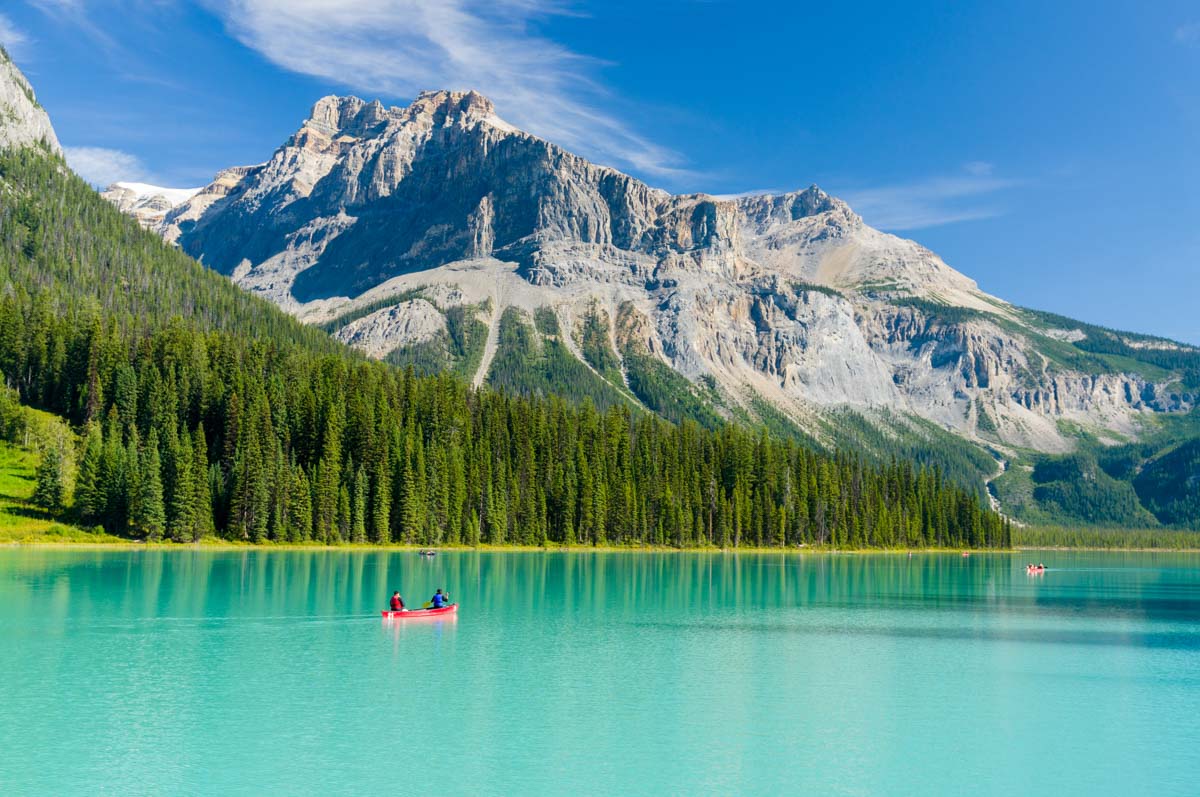
Takkakaw Falls is the second highest waterfall in Western Canada and is a super spectacular spot to head to in the morning. The access road is only open from June through early fall, so unfortunately if you are headed to the Canadian Rockies in the spring, you won’t be able to see the fall at that time.
To get to the end of the falls, you’ll need to take a trail, which is only ~1.5 kilometers. Once you arrive at the base of the falls, you can stand close enough to feel the cool water sprinkle your face. Cool (literally), huh?
Next, head to Emerald Lake, a stunning alpine lake in Yoho not far from Field. Here, the f ine sediment from the glaciers sits in the water and gives it its characteristic emerald color after which it is named. You can rent a kayak here or hike the 5.3 kilometer loop trail around the lake!
Afternoon: Lake O’Hara
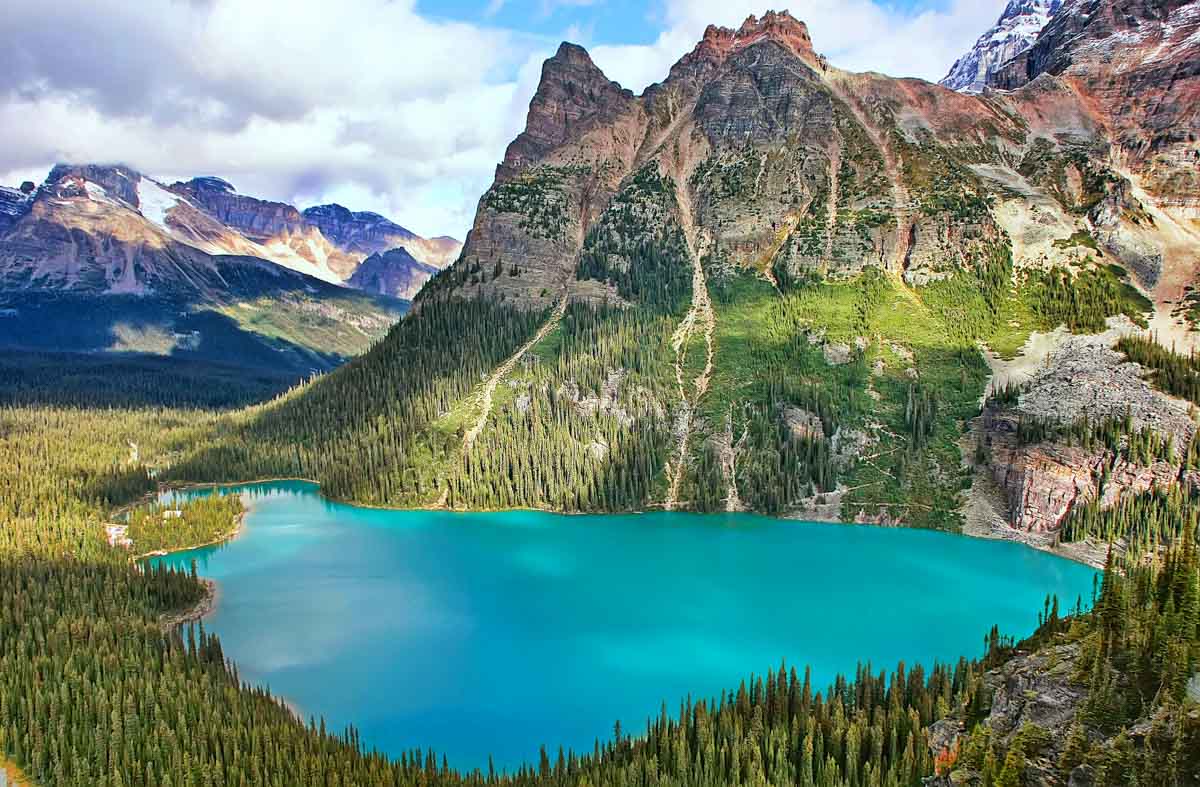
Lake O’Hara is an alpine lake, and is one of the main sights in Yoho National Park. It’s definitely worth the long journey it takes to get there.
Situated at 2000m in elevation, you need to hike up a trail in order to get there (but you may be able to pay to take a shuttle down back to the parking lot during the summer months. Note, however, that this is not a guarantee!)
Advance reservations are required to go up to the lake, however, you are still able to hike the 11 km up to the top even if you weren’t able to get a bus reservation.
If you don’t get a bus reservation, you will have to hike back down the 11 kilometers you came (which means this will easily turn into a full-day excursion!). However, if you are able to take the bus back down, plan to be around Lake O’Hara for 4-5 hours. (If you have to hike both ways, plan for 6-7 hours.)
Evening: Dinner in Banff
For your last dinner, you’ll head back to Banff’s town center. You can eat at one of your favorite restaurants from before, or opt for a bit more of a “fine dining” experience at one of these Banff local restaurants:
Saltlik – Enjoy a nice quality steak dinner at one of Banff’s premier steakhouses. There is a separate bar area for drinks. The restaurant has a great selection of side dishes. Try the mac and cheese!
The Bison – This picturesque dining establishment features wood-fired inspired food, and their dishes are LITERALLY to die for. For meat lovers, choose between ribs, bison, duck, or trout. Vegetarian dishes are also available. And, of course, before you leave Canada, you’ve got to try their poutine!
You’ll be back in Banff for your final night of this Canadian Rockies itinerary, so enjoy it! Again, here are my recommendations – the same ones as before – for a few popular places to stay (or you can read this post for the full list, from luxury lodges to budget hostels):
Day 10: Return to Calgary
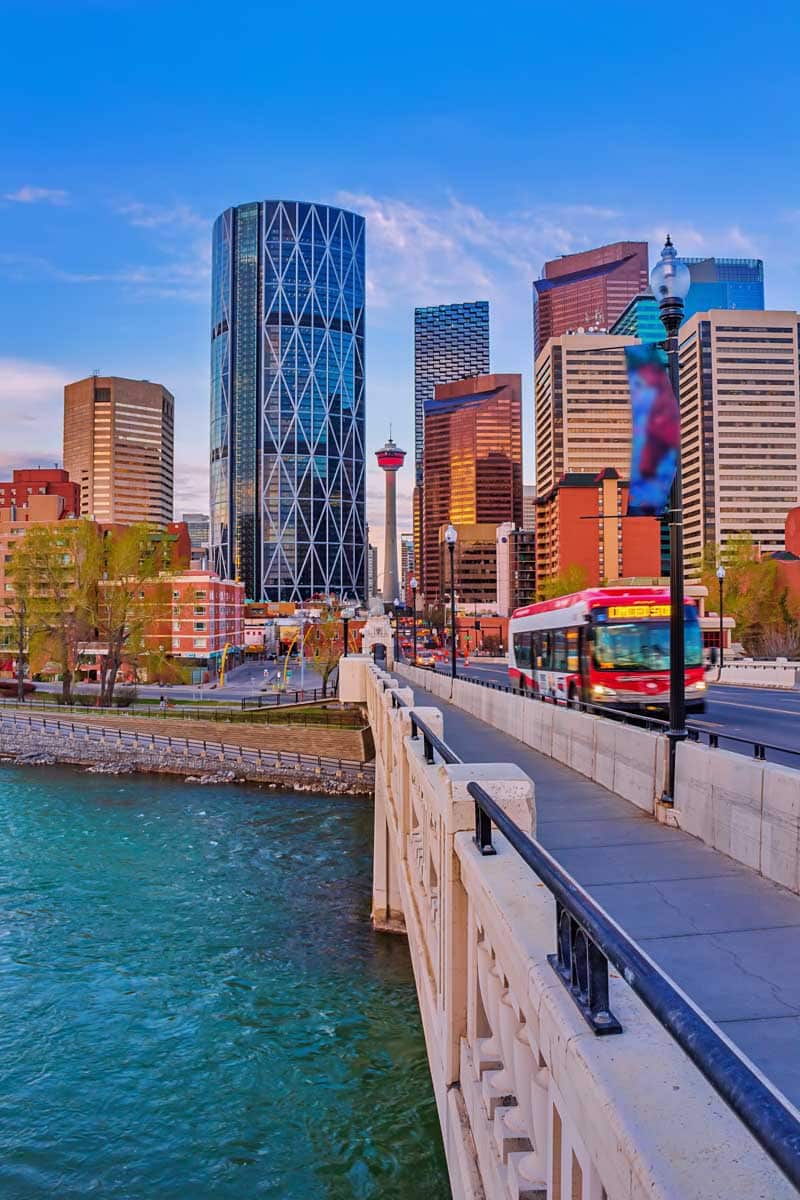
It’s the last day of your Canadian Rockies itinerary, and sadly you’ll have to return back to your normal life soon. But before you go, you’ll spend one last blissful morning amidst the peaks and forests before heading back to Calgary.
Morning: Sunrise at Vermilion Lakes
Wake up early (before 6 AM) and head to Vermilion Lakes for your final morning in the Canadian Rockies. This is THE sunrise spot, and we left this for the last day so that you can enjoy one last morning of tranquil mountain magic before heading back to the real world (*sobs*).
Even on misty mornings, the sunrise here can be quite beautiful, so I’d recommend going even if it looks cloudy outside. Park in the parking lot at Vermilion Lakes and walk into the shore area, where you can sit and enjoy a warm drink or just listen to the sounds of the morning.
It’s here where you’ll bid farewell to Banff and the Canadian Rockies and all of your amazing memories you’ve just made over the last 10 days. From personal experience, I will say that this place really sticks with you, forever. The landscapes of the Canadian Rockies have truly made an impression on me that my heart will always yearn for.
Returning to Calgary
You’re finally reaching the end of your Canadian Rockies road trip. (Sad face emoji!)
Depending on what time your flight is scheduled to depart, you’ll need to make your way back to Calgary. When you’re ready, dry your eyes and hop in the car, taking the Trans-Canada Highway all the way back to the city. Drop off your rental car wherever you picked it up, head back to the airport, and bid those incredible mountain vistas adieu .
Feeling some serious post-Rockies depression already? Well then you’ll just have to plan another trip up here! There are LOADS MORE things to do in the Canadian Rockies than we had time for in this itinerary, and until then, you can drift off to sleep at night with visions of the snow-capped rocky peaks and magical turquoise lakes dancing around in your mind…
Other Places to Visit on a Canadian Rockies Itinerary
If you’re one of the lucky ones who actually has more time in the Canadian Rockies than 10 days, read on for a few more areas you can add to your Canadian Rockies itinerary:
Waterton Lakes National Park
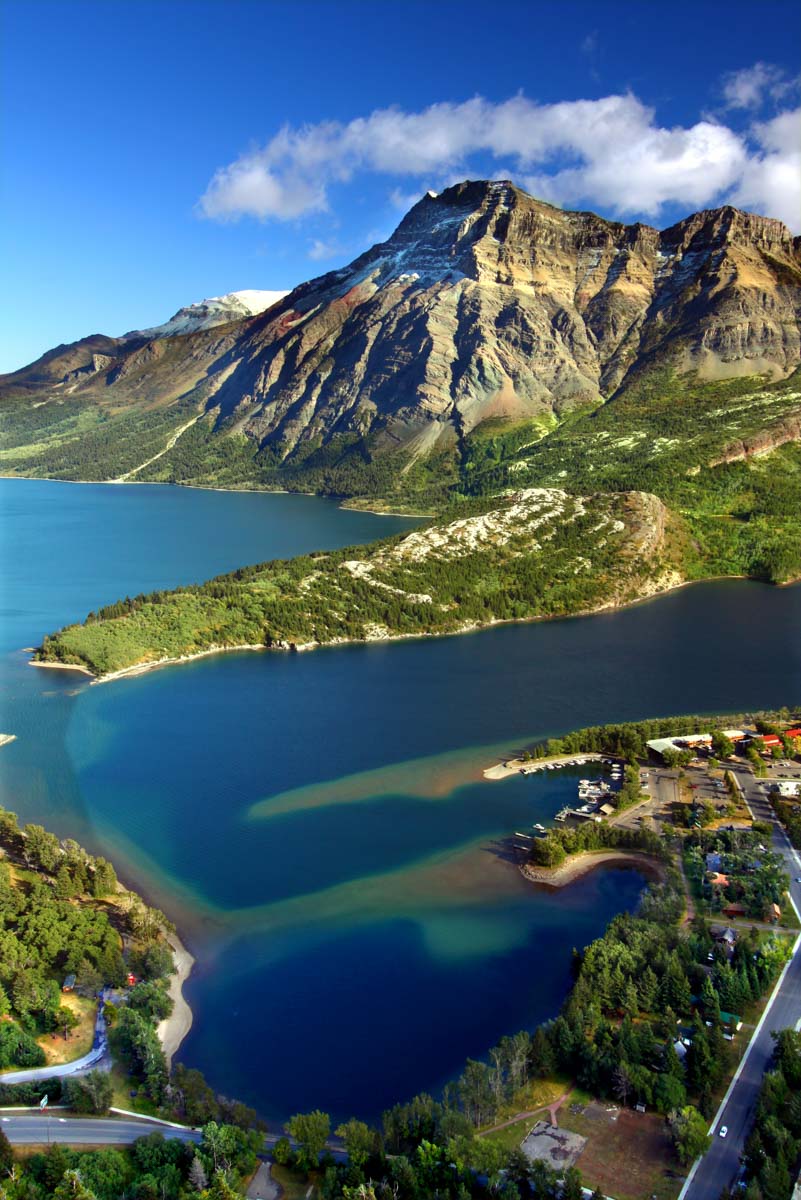
Waterton Lakes National Park (along with its US neighbor, Glacier) is a UNESCO World Heritage Site and International Peace Park. This Alberta national park consists of a giant glacial lake system surrounded by mountains, and it rests on the Canadian border with Montana. Its a bit far from the rest of the parks on our itinerary, but it’s definitely a worthwhile addition to any Canadian Rockies road trip!
Like its northern neighbors, Waterton Lakes is full of amazing, spectacular views and hiking trails, including its famed Triple Crown hiking challenge. To learn more about Waterton Lakes and the hiking trails there, visit our complete guide:
Kootenay National Park
Kootenay National Park , located in British Columbia, is another lesser-known Canadian Rockies national park. Located southwest of Banff National Park, you can experience all kinds of beautiful hiking trails here, with amazing, breathtaking alpine lakes and mountain passes to explore. It’s not far from the rest of the places on this Canadian Rockies itinerary and would be the perfect addition if you have a few extra days to spend in the region.
I haven’t actually personally been to Kootenay National Park, but this guide to 25 things to do in Kootenay is an excellent starting point if you’d like to explore the area.
Additional Canadian Rockies Travel Resources
Phew! If you’ve made it this far, congratulations. You’ve literally gotten your hands on all of the information you need for all of the stops on this itinerary. However, we do have even MORE detailed guides on each of the stops in the Canadian Rockies on our website and beyond.
The below resources (both our guides and the external ones) are all really helpful for learning more about the attractions at each stop on this itinerary, or for adding activities and extending your trip.
Have a look and remember — these are ALL just our recommendations. Doing more research on the area enables you to make your Canadian Rockies itinerary the perfect one for YOU!
Our favorite (external) Canadian Rockies travel resources:
- Lonely Planet: Banff, Jasper, and Glacier National Parks – If you’re into physical guidebooks to take with you when you travel, this is the ultimate companion to our Canadian Rockies itinerary. The Lonely Planet guide to Banff, Jasper, and Glacier has all the information you need to get around, find a nice place to stay, and book tours for the adventures you want to try.
- Moon Canadian Rockies – Another comprehensive print guidebook about Banff, Jasper, and more! It never hurts to have more than one, right?
- Parks Canada Website – This website is the ultimate resource for up-to-date information about the national parks in Canada. Here, you can find out about road and trail closures, construction occurrences, weather warnings, and more.
- To Banff and Beyond – A wonderful Banff-focused travel blog which includes several tips, hikes, and activities to do in the Canadian Rockies area!
10 Days in the Canadian Rockies Itinerary: Read Next
All of our own guides, tips, and misadventures in the Canadian Rockies
- Incredible Hikes in Canmore
- 23 Incredible Things to Do in Banff National Park
- Where to Stay in Banff National Park
- 17 Spectacular Things to Do in Jasper National Park
Love This? Save and Share on Pinterest
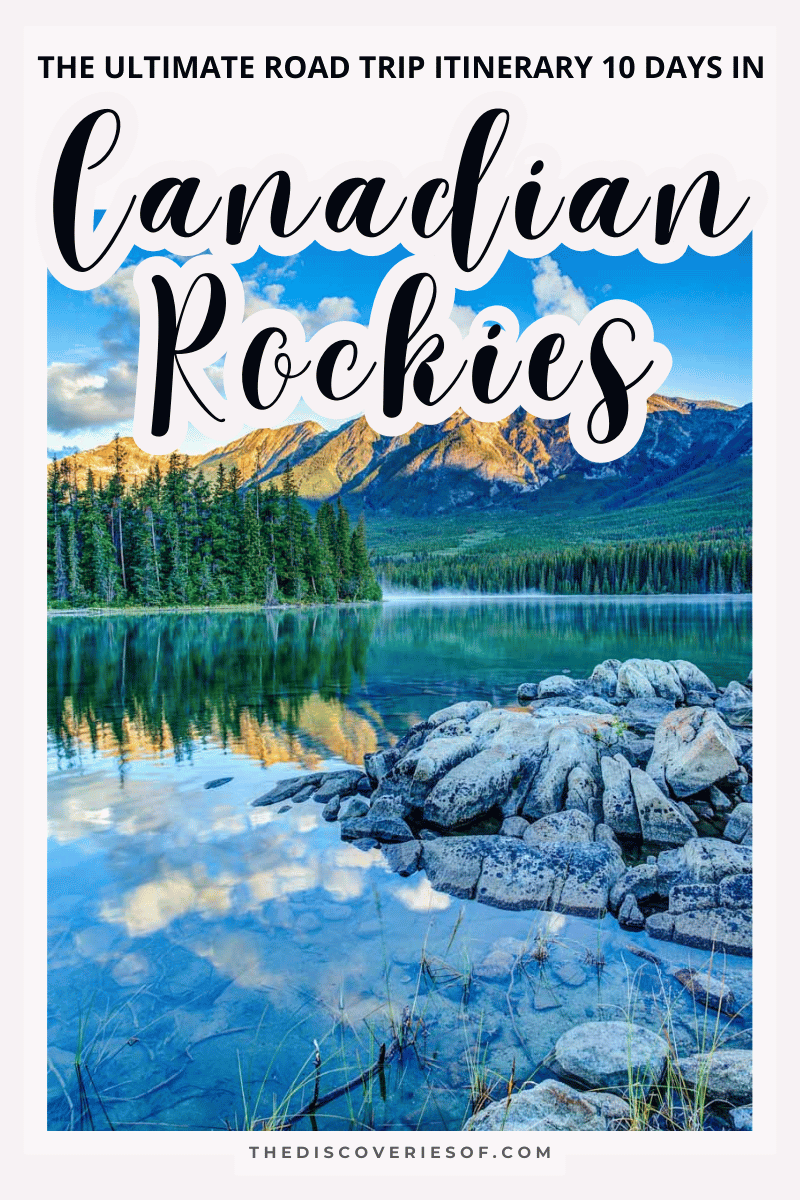
I’m Kay. I’m originally from small town Virginia, but have moved all around the East Coast and the United States for basically my entire life. I spent my childhood days blissfully wandering through the Blue Ridge Mountains, rolling in leaves, playing in creeks…you know, the usual overly adventurous 5-year-old stuff.
But those early years spent outside gave me a real problem: I’m now an adventure addict. Basically, if I’m not at my computer banging out articles or photos, I’m probably out hiking, biking, or camping somewhere beautiful.
Related Posts
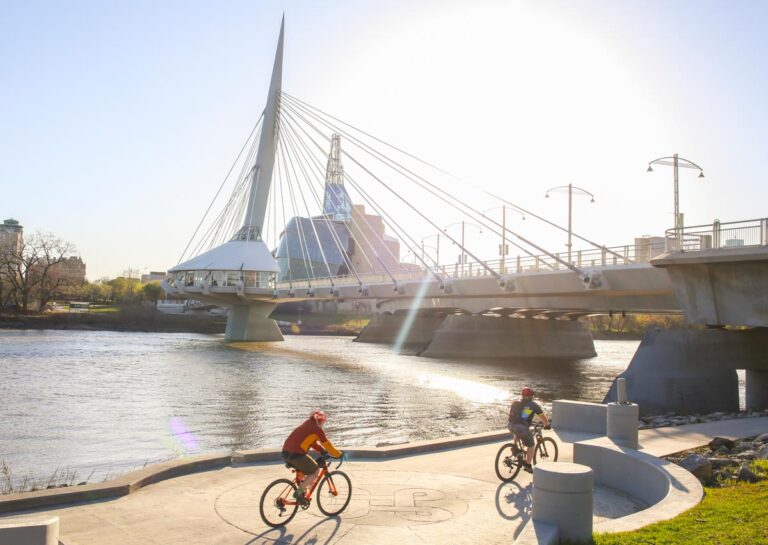
Awesome Outdoors Activities in Winnipeg You Have to Try
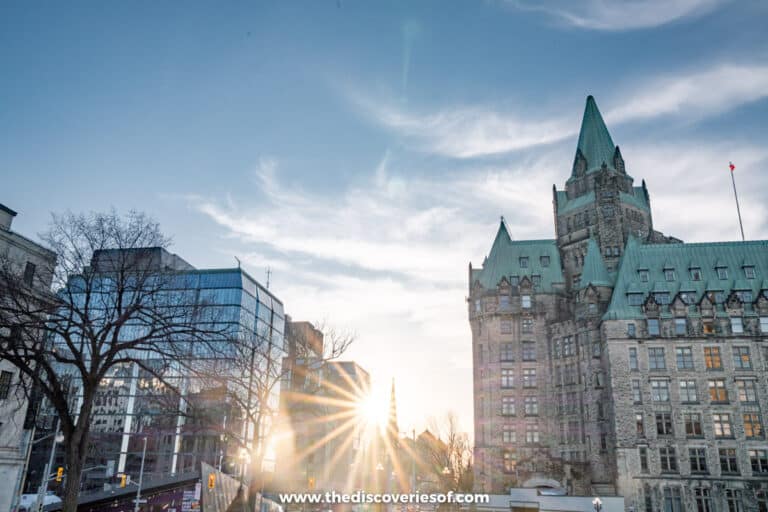
2 Days in Ottawa: The Perfect Ottawa Itinerary
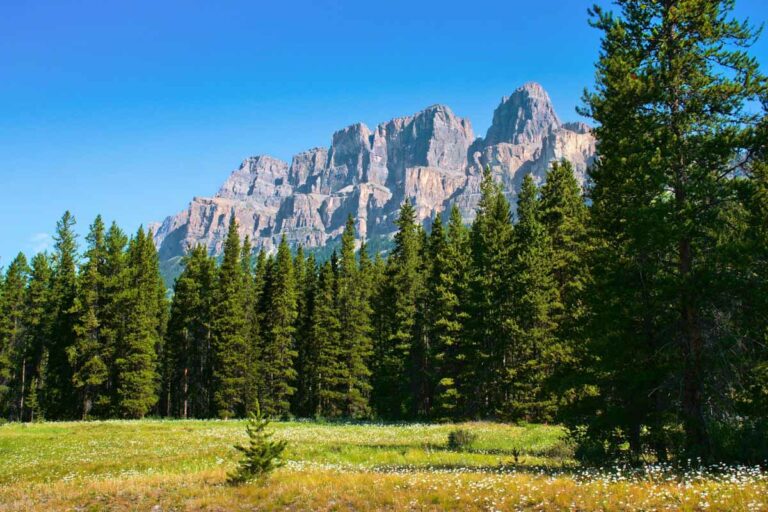
The Best Things to do in Canada: 27 Unique Adventures Up North
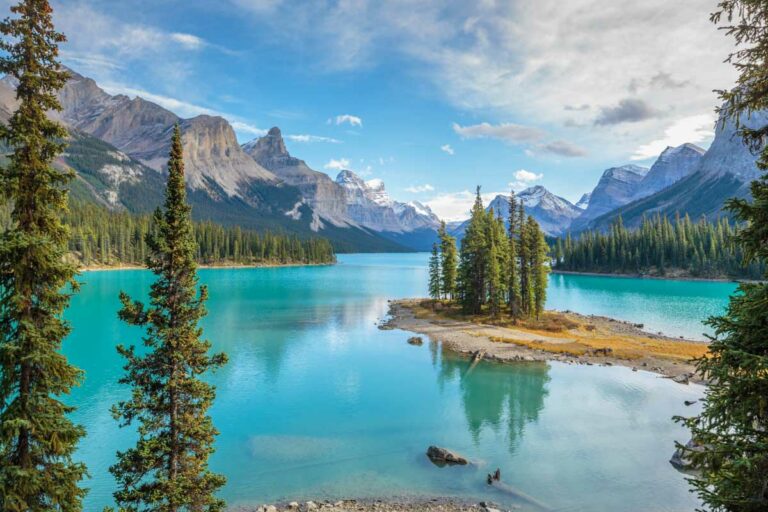
Best Places to Stay in Jasper National Park
Hey – What an amazing blog, thank you so much.
If you had an extra 3-4 days, where would you spend them? Additional destinations or adding more days to places like Banff and Jasper?
Thank you SO MUCH (!) for putting this together. I am planning a canadian rockies road trip with my dad this summer and this is perfect. I honestly dreaded planning a bit because I know how much there is to do / see and to think of but this just made my life so much easier and now I can’t wait!
Leave a Reply Cancel reply
Your email address will not be published. Required fields are marked *
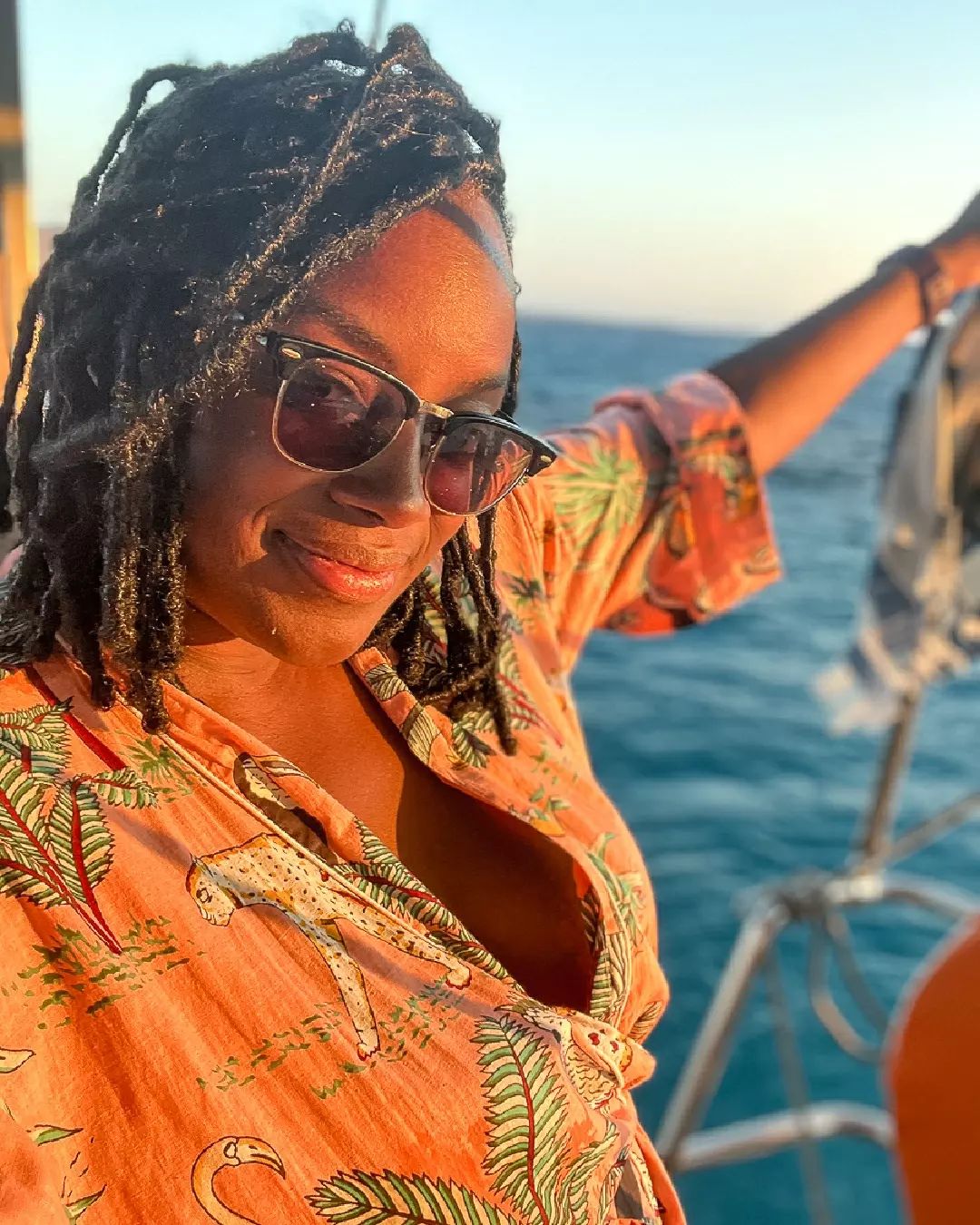
Follow me on Instagram for travel inspiration, tips, and guides.
5 of the Best Canadian Rockies Tours from Vancouver
Paradise on Earth is a big statement, but for sheer scale of unspoilt wonder and sense of freedom, the Canadian Rockies certainly come close. A land of majestic, snow-capped peaks, crystal clear inlets, simply bursting with wildlife, a trip here is like tonic for the soul. And it’s all within striking distance of one of the world’s great cities.
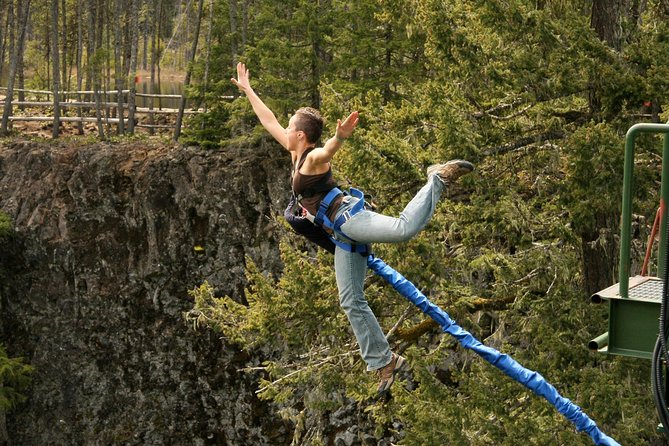
Photo: Moose Travel Network Courtesy Viator
Rocky Mountain tours have been being run out of Vancouver for years, and in that time have been refined into a fine art. So whether you’re interested in trekking into the hills, touring them by coach, or taking part in the main adventure activities you’ll find within them, then look no further. We’ve assembled five of the best, which cater to all tastes, below.
10-day Rocky Mountains Whistler Big West Tour from Vancouver
A trip for the adventurously inclined. This ten day tour takes you by bus through some spectacular scenery, then offers you the chance to leap out into it: if you want literally. There’s ziplining and bungee jumping on the itinerary, as well as white water rafting and kayaking on vast lakes. Accommodation is in mixed-gender dorms with the other people taking the tour, so be prepared to get to know your fellow travellers very well, and perhaps make friends for life.
Book at Viator
Circle West – Canadian Rockies Round Trip Bus Tour From Vancouver
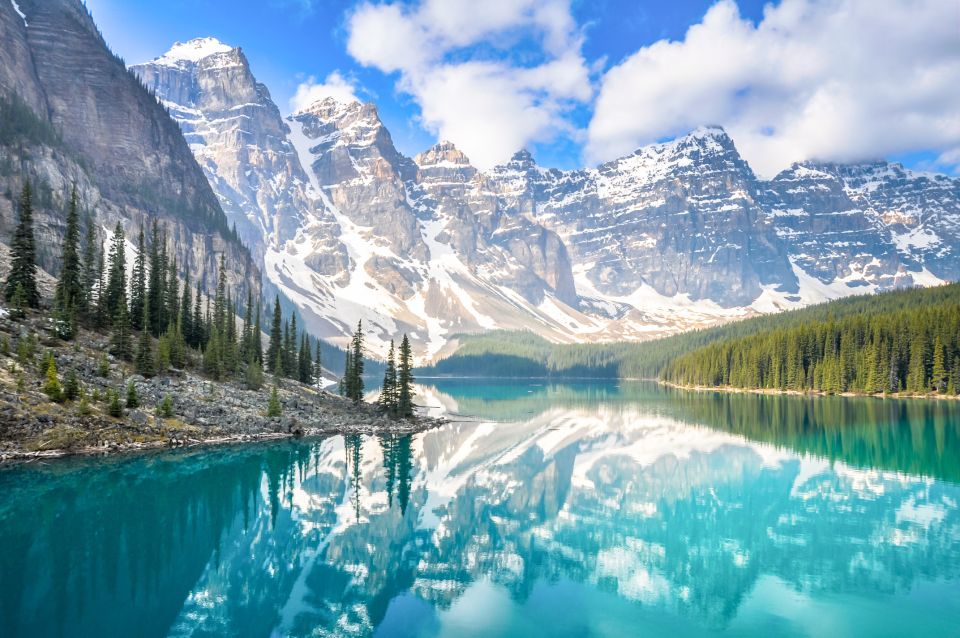
(Photo: Key West Travel & Tours Courtesy Viator )
A shorter more sedate tour, which will nevertheless take your breath away. You’ll be driven out into some of the most spectacular landscapes of the Rockies, and invited to head on short walks out into their vastness. Waterfalls and glaciers await, as do pre-arranged meals and comfortable pre-booked accommodation, meaning there’s no administrative stress getting in the way of your enjoyment of this magnificent environment’s bountiful wonders.
Canadian Rockies 7–Day National Parks Group Tour
Delving deeper into the mountains, this seven day coach tour for wilderness explorers takes you out along the Icefield Parkway – regarded by many as one of the most beautiful roads in the world – and invites you to kayak out on the glacial waters of Moraine Lake, to cycle off into the wilderness, even to strap on a set of crampons to set foot on Athabasca glacier. Accommodation is in pre-booked hotels, though for lunches you’ll have to fend for yourself.
Book at GetYourGuide
Vancouver: Private 6-Day Rocky Mountain Explorer Tour
If you’ve got the cash to spare and want to go private, this is the tour for you. Have all the spectacular landscape of the Rockies introduced and explained to you by your own personal guide as you ascend into the wilderness: complete with a dip in hot springs, a winery tour, and a gondola ride to the top of a mountain. Note that the accommodation and meals for this tour are not included, which on the upside means that if it’s luxury you’re after, there’s nothing holding you back. The tour company will of course help plan these elements of the trip.
Whales & Bears of British Columbia
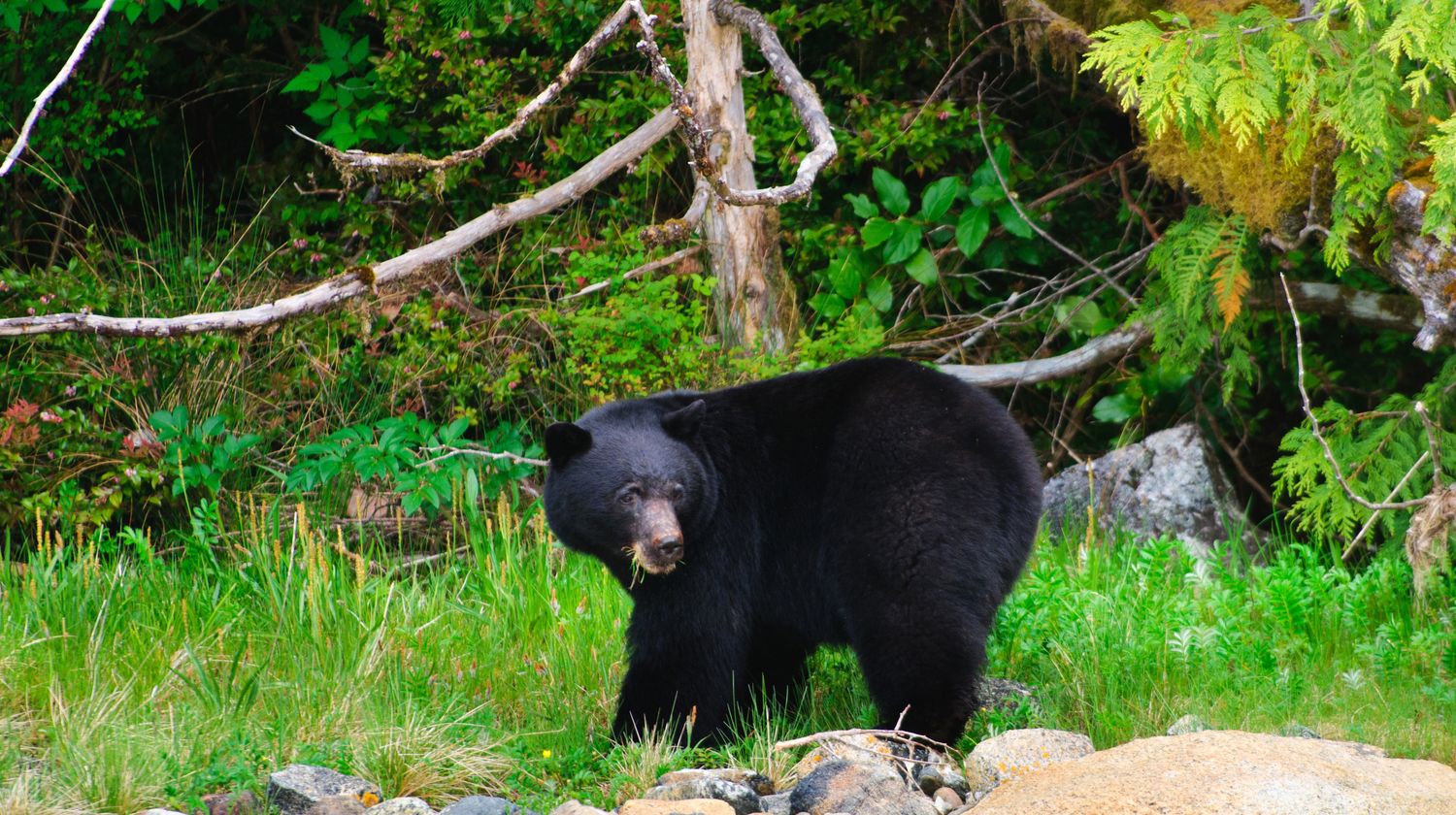
A bear in the woods (Photo: Courtesy Bookmundi )
Because as well as its sumptuous scenery, this part of Canada is also a wildlife spotter’s dream. From salmon hunting grizzly bears to pods of cresting orcas, a trip here can feel like being in the midst of your very own nature documentary, as long as you know where to look. This trip offers exactly that, taking you up the coast from Vancouver and into a wilderness where as well as bears and whales, there are seals, elk, and a vast menagerie of bird life all awaiting the snap of your telephoto lens.
Book at Bookmundi
Latest Articles
- 5 of the Best European Tours for Singles April 14, 2024
- 10 Things to Do with Kids in San Antonio April 14, 2024
- A Comparison of Fort Lauderdale Helicopter Rides April 12, 2024
- 7 Unique Things to do in Villahermosa April 12, 2024
- 5 Unique Juneau Shore Excursions April 12, 2024

Plan the Ultimate Canadian Rockies Road Trip
The Rocky Mountains are one of the most beautiful and awe-inspiring natural wonders in North America.
Stretching from Alberta all the way to New Mexico , these mountains offer something for everyone. Whether you’re a nature lover, an outdoor enthusiast, or just looking for a great vacation spot, a road trip through the Rocky Mountains is definitely something you should consider.
There are a few things to remember when planning a road trip through the Canadian Rockies, one of the most beautiful drives in the world .
First, the mountains are huge and there’s a lot of ground to cover. Second, the weather can be unpredictable, so be sure to pack appropriate clothing and supplies. Third, there are numerous activities and attractions to enjoy along the way, so plan your route accordingly and allow plenty of time.
In this post, we’ll guide you through planning the perfect road trip through the Canadian Rockies:
Preparing For Your Canadian Rockies Road Trip
Choose your canadian rockies destination, main attractions in canada’s rocky mountains, best restaurants in the canadian rockies, best hotels in the canadian rockies, camping in the canadian rockies, pack appropriately, weather in the canadian rocky mountains, more tips for a successful canadian road trip.

Before you hit the road in Canada, there are a few things you should do to prepare.
First, check the weather forecast and plan your route accordingly. If you’re driving through the mountains in winter , be sure to pack snow tires and chains.
Second, make sure your vehicle is in good working condition and that you have all the necessary supplies, such as:
- a map (offline or paper – don’t rely on having any cell signal)
- a first-aid kit
- extra food and water
- We have a detailed guide to everything you should pack for a family road trip.
Next up, check what park fees need to be paid. Over the course of a Canadian Rockies road trip, you are almost certainly going to be better off investing in an annual Discovery Pass .
Finally, be sure to tell someone where you’re going and when you plan to return.
The Canadian Rocky Mountains span a large area, so choosing a destination that suits your interests and needs is important. Each region has its own features and attractions. For example:
- Banff National Park in Alberta is known for its stunning scenery, hiking trails, and wildlife. The area is known for its breathtaking turquoise-blue lakes.
- Jasper National Park in Alberta is perfect for those who want to enjoy the great outdoors with plenty of opportunities for camping, fishing, and canoeing.
- Yoho National Park in British Columbia is a nature lover’s paradise with its waterfalls, glaciers, and mountains.
- Mount Revelstoke National Park , in British Columbia, is ideal for those who want to experience the true Canadian Rockies with its snowy peaks and remote wilderness.

Once you’ve chosen your destination, it’s time to start planning your route.
The Canadian Rockies are huge, so you must decide which parts of the mountains you absolutely want to see and how you’ll get there.
Be sure to map out your route in advance and make sure you have enough time to complete the journey. You will most likely start from one of the major cities and international airports in Calgary, Alberta (YYC) , or Vancouver, BC (YVR) .
To help you plan out your exact itinerary, dive into one of our more detailed Canadian road trip guides:
- 8 Unmissable Stops From Vancouver to Banff
- 13 Sensational Stops From Calgary to Vancouver
- Best of Vancouver With Kids in One Day
- Glacier National Park (USA) to Banff By Road
There are countless attractions to enjoy while driving through the Canadian Rockies and the UNESCO Canadian Rocky Mountain Parks World Heritage Site .
Here are just a few of the many highlights you’ll want to include on a family road trip itinerary through the Canadian Rockies.
- Lake Louise in Banff National Park is one of the most beautiful lakes in the world, with its stunning turquoise waters.

2. The Columbia Icefield in Jasper National Park is the largest ice field in North America and offers a variety of glacier-related activities, such as ice walks and snowmobiling.
3. Mt. Robson in British Columbia is the highest peak in the Canadian Rockies and offers stunning views of the surrounding mountains.
4. The Spiral Tunnels in Revelstoke National Park is a must-see for any train enthusiast. These tunnels were built to help trains navigate the steep grades of the mountains.
5. Athabasca Falls in Jasper National Park is one of the most popular waterfalls in the Rockies and is easily accessible from the road.

6. Canmore in Alberta is a charming mountain town with plenty of shops and restaurants to explore. There are cave tours offered year-round.
Plan Your Meal Stops
One of the best parts about road-tripping is being able to enjoy all the different cuisines along the way, and the Canadian Rockies are certainly no exception.
The Rocky Mountains are home to some of the best restaurants in Canada. Here are a few of our favorites:
Top 10 Things To Do In Moab With Kids
Southern California vs Northern California: Which Is Better…
15 Fun Things To Do With Kids On A Sydney Family Holiday
- Sky Bistro : Located in Banff National Park, Sky Bistro offers stunning views of the Canadian Rockies while you enjoy a gourmet meal. You ride up the gondola to the restaurant, which is located on top of Sulphur Mountain.
- Earls Kitchen + Bar : With several locations throughout the Rocky Mountains, Earls is a great option for those looking for a unique and exciting meal. The menu features a wide variety of global comfort food.
- The Juniper Bistro : Located in Jasper National Park, The Juniper Bistro is the perfect place to go for a romantic dinner or special occasion. The restaurant features an ever-changing menu with locally sourced ingredients.
- Farm & Fire : Farm & Fire is a great option for those who want to experience a true taste of the Rocky Mountains. The Banff restaurant sources all of its ingredients from local farms and offers a variety of wood-fired pizzas.
- BeaverTails : No trip to the Rocky Mountains is complete without trying a BeaverTail! These fried pastries are a Canadian specialty and can be found at numerous locations throughout the mountains.
- Communitea Cafe: This cute Canmore cafe is a great casual option for those looking for healthy food options. The menu features a variety of soups, salads, and sandwiches.

Find Accommodation
There are many different accommodation options available throughout the Rocky Mountains. Whether you’re looking for a hotel, motel, or campsite, be sure to book ahead, as places fill up quickly during peak season.
There are also several Airbnbs and vacation rentals available if you’re looking for something more unique.
If you’re looking for a comfortable stay, the area has a number of wonderful historic luxury hotels.
- Fairmont Banff Spring – This historic luxury hotel is located in the heart of Banff National Park and offers world-class amenities and service.
- Fairmont Jasper Park Lodge – Located in Jasper National Park, this lodge village offers a variety of room options, as well as cottages and cabins.
- Rimrock Resort Hotel – The Rimrock Resort Hotel is located in Banff National Park and offers stunning views of the Canadian Rockies.
- Lake Louise Inn – This inn is located in the beautiful town of Lake Louise and features a variety of room types, including standard rooms and suites. It’s a beautiful mountain resort for all seasons.
Airbnbs and vacation rentals – Many Airbnbs and vacation rentals are available throughout the Rocky Mountains. Be sure to book ahead as places fill up quickly during peak season.
You can start your accommodation search in Banff, although you may find cheaper options if you look to smaller towns like Canmore.
If you’re more interested in camping along the way, there are some great campgrounds to explore during the warmer seasons.
- The Banff National Park Campgrounds – There are several campgrounds located throughout Banff National Park. Most are open from May until September-October but a few, such as Tunnel Mtn Village II, are open year-round.
- The Jasper National Park Campgrounds – There are several campgrounds located throughout Jasper National Park, each with its own unique features. Whistlers Campground is known for Elk sightings, while Wapiti Campground is a large riverside campground.
- The Yoho National Park Campgrounds – The largest campground in Yoho National Park is Kicking Horse Campground, a scenic location with waterfalls and hiking trails.
- The Revelstoke National Park Campgrounds – Revelstoke RV & Cabin resort features mountain views and basic amenities. Williamson Lake Campground is another option in the area.
As mentioned before, the weather in the Rocky Mountains can be unpredictable. Be sure to pack clothing and supplies for warm and cold weather conditions.
Travelling with an infant, make sure they are warm enough in their car seat and pack toys and entertainment for those long stretches.
You’ll also want to bring along any hiking or camping gear you might need if you’re planning on hitting the trails and getting deep into the mountains.
And don’t forget your camera to capture all those amazing views!
The Rocky Mountains experience all four seasons, so the weather can vary greatly depending on when you visit.
In the spring, the temperatures start to warm up, and the snow begins to melt. This is a great time to go hiking or camping as there are fewer crowds and beautiful wildflowers start to bloom- though it can be very wet underfoot.

Summer is the busiest time of year in the Rocky Mountains as people come from all over to enjoy the warm weather and long days. This is also a great time to go hiking, biking, and camping. Advance booking accommodation is essential.
Fall is a beautiful time to visit the Rocky Mountains as the leaves start to change color. The temperatures are cool but not too cold, making it perfect for outdoor activities.
Winter is a popular time to visit the Rocky Mountains as people come to ski and snowboard. The temperatures can be quite cold, so be sure to dress warmly. The main highways are well-cleared but some back roads may be closed.
1. Bring a map : Even if you’re using GPS, it’s always a good idea to bring a physical map of the area (and download an offline backup from Google Maps). This way, you’ll never get lost, and you can always plan your route accordingly.
2. Pack snacks and drinks : Road trips can be long, so it’s important to have plenty of food and drinks to keep you going. Pack some snacks and drinks for the car in a good road trip cooler so you don’t have to make too many stops.
3. Stay hydrated : Drinking plenty of water is crucial, especially if you spend a lot of time outdoors in the heat. Bring a water bottle and fill it up whenever you can.
4. Take regular breaks : Driving for long periods of time can be tiring, so make sure to take plenty of breaks. Find a scenic spot to pull over and take a short walk or just relax for a bit.
5. Have fun : Road trips are all about the journey, so make sure to enjoy every minute of it!

Check back soon as we add more great advice for family road trips in Canada
- Awesome Scenic Drives in Ontario
- Day Trips From Toronto
- Jaw-Dropping Scenic Drives in Nova Scotia
- Toronto to New York Road Trip Itinerary
© Family Road Trip
Southern California vs Northern California: Which Is Better For A Family Vacation?
15 Perfect Things To Do With Kids On A Perth Family Holiday
15+ Fun Things To Do In Las Vegas With Kids in 2024
8 Magical Winter Vacations in Canada For Families
- Skip to primary navigation
- Skip to main content
- Skip to primary sidebar
BanffandBeyond
The Canadian Rockies Through A Local Perspective
A Trip Planning Guide For The Canadian Rocky Mountains
Do you want to plan a trip to the Canadian Rocky Mountains but have no idea where to start? The hardest decision will be narrowing down what you want to see. It will never seem like you have enough time to take in all the beauty the mountains have to offer. We’ve put together this Canadian Rocky Mountain guide to help you plan the perfect trip.
When Is The Best Time Of Year To Visit The Rocky Mountains?
There’s no correct answer to “When is the best time to visit the Canadian Rocky Mountains?” They are a year round destination with spectacular scenery in every season. So how do you decide when to visit? It depends on what you want to see, the activities you’re interested in and what type of budget you have.
Our post on When is the best time to visit Banff National park and the Rocky Mountains will help you narrow down to a time of year that suits you.
You may want to time your trip so that you can attend a specific event such as the Lake Louise Ice Magic Festival or attending the Calgary Stampede .
Keep in mind that winter is a long season in the mountains, especially in higher elevation areas like Lake Louise. Spring time is still skiing season, the summer months pass by quickly to make way for the fall colours and then mother nature will decide how early the snow returns and winter sets in.
Seeing the coloured glacier lakes is on many peoples wish list. If this is your goal make sure your trip accordingly. See our post on when the Rocky Mountain lakes thaw and get their beautiful turquoise colour .
Seasonal Closures, Construction And Maintenance
Occasionally the parks have to do upgrades or maintenance to a popular tourist attraction or site. This could mean limited or no access for a period of time. Areas affected in Banff National Park will be posted here: Banff Maintenance And Construction .
Roads and areas of the parks are closed at various times for wildlife conservation and avalanche risk. For Banff National Park you can see the list of closures here: Banff Seasonal Closures.
Pros And Cons Of Banff And Jasper National Parks In The Shoulder Season Of April And May
Misconceptions and Mistakes Made When Visiting The Canadian Rocky Mountains
How To Pack For A Canadian Rocky Mountain Trip
Weather across Canada varies dramatically. While it may be spring like in Vancouver on the west coast, the mountains are still buried in snow. If you’re visiting between November and March it’s a must to have proper winter clothing including boots, an insulated winter jacket, gloves and a warm hat. During the rest of the year there can be wide variances in conditions and temperatures. Be prepared with several clothing options.
For more information see what to expect for weather and temperatures in the Canadian Rocky Mountains.
What needs to be in your suitcase depends on the time of year, the length of your stay and the activities you plan to participate in.
For information on what to put in your suitcase see our post on How to pack for a visit to the Canadian Rocky Mountains.
What Is An Ideal Length Of Time To Spend In The Rocky Mountains
We recommend a minimum of a week to get a taste of what the mountains have to offer, especially if you are trying to fit in several places such as Banff and Jasper National Parks. Visitors often underestimate how vast these areas are and the driving times involved in getting around. A visit limited to just Banff may be suitable to three or four days. If you plan on doing a lot of sightseeing and adding in activities such as hiking you’ll likely want more time.
Ten days to two weeks is ideal to take in Banff and Jasper National Parks at a leisurely pace. This amount of time might allow you to explore attractions in neighbouring areas Kootenay National Park, Yoho National Park and Kananaskis Country.
When flying make sure you account for the time needed for getting to and from the airport. If your budget and time allows there are more places worth visiting like Drumheller and the Badlands or the small but charming Waterton Lakes National Park . There are several other alternative parks and overlooked areas in the Rocky Mountains that are worth your time.
Driving a circle route that includes the west coast of B.C. warrants at least ten days to two weeks. It’s nearly 850 km’s between Vancouver and Banff and a minimum of 9 hours of driving time each way. It’s best to break up the drive with at least one overnight stay. In addition to exploring Vancouver you may want to add a few extra days to see some of the beauty of Vancouver Island.
For trip options see our post on driving routes between Vancouver to Banff and Jasper .
Getting To The Canadian Rocky Mountains
The flight options available to international visitors may have you accessing the Rocky Mountains through one of several airports. Calgary, Alberta is the closest international airport, followed by Edmonton, Alberta and then Vancouver, British Columbia on the west coast of Canada.
For those coming from other destinations within Canada or North America there are domestic flights as well as train travel, buses, guided coach tours and self driving.
More details are covered in our post on Options For Getting To The Canadian Rocky Mountains.
Navigating The Rocky Mountains Once You Arrive
Self driving in the mountains is the most popular option because it provides the greatest flexibility. The roads are easy to navigate and many people feel comfortable driving in the area. The exception would be the winter season. Driving at this time is not for everyone and shouldn’t be attempted by those without winter driving experience.
If you’re flying into one of the international airports you can conveniently arrange to pick up your rental vehicle there. Banff, Canmore and Jasper also have vehicle rental options. Make sure you understand all the details of your contract including the insurance coverage, whether it has unlimited kilometers and the return policy. There may be restrictions that can void your insurance including driving on unpaved roads or taking the vehicle into the U.S.A. Many companies prohibit using chains for winter driving as they can cause damage to the vehicle.
If you’re thinking of driving one way between the west coast of British Columbia and the Rocky Mountains or vice versa it can be an expensive option. The one way drop of fee between the two destinations can be as high as a thousand dollars. Do your research to see which companies offer the cheapest rate.
If you do not want to self drive you can consider booking a tour as part of a package with your flight or book tours to attractions with local companies. It is possible to get around some areas of the mountains with public transportation and shuttles.
For more information see our post: How to get around the Rocky Mountains without a vehicle .
Canada Driving Road Laws And Safety
Driving and safety tips can be found at the following sites: For the province of B.C. at ICBC Road Safety and for Alberta at Alberta driver and traffic safety . Other provinces may have varying regulations.
Where To Base Yourself In The Rocky Mountains
Whether you base yourself in one spot in the Rocky Mountains or change accommodations depends on what parks you want to see and how much driving you are willing to do. In Banff National Park you can choose between staying in Lake Louise versus the Banff Townsite . There’s usually no need to stay in both places, it’s a 40 minute drive between the two. Day trips to explore the park as well as heading west into Yoho National Park and the southern end of the Icefields Parkway can be done from either location.
There’s an option of using the town of Canmore as a base. It is not in the national parks, but sits just a 15 minute drive east of the Banff town site. One town might appeal to you more than the other depending on your tastes. We’ve covered the differences here in our post on Canmore versus Banff .
If you plan on spending time in Banff and Jasper it’s best to book accommodation in both places. The driving time from the town of Banff to Jasper is approximately 3 to 3.5 hours in each direction. It would be a lot of driving to do as a return day trip between the two and it wouldn’t leave you enough time to see all the incredible attractions along the Icefields Parkway. For more information see our post on Tips For Driving The Icefields Parkway and for comparisons between these two parks check out Jasper National Park versus Banff National Park .
Accommodation And Budgeting Options
The amount of accommodation choices in the Banff and Canmore area can be overwhelming. Jasper is a bit more limited and in Lake Louise the options are very sparse in comparison. There’s times of the year where winging it is simply not an option. During the peak summer demand the lodging in all of these areas may need to be reserved up to six months in advance. If you leave your booking too late it may be difficult to find a room or you can be stuck paying exorbitant prices.
There’s a wide range of accommodation types from high end luxury resort style properties and lodges to mid-range hotels, condo suites, bed and breakfasts and hostels.
No matter how you look at it the Canadian Rocky Mountains are not a cheap place to visit. Restaurants, tourist attractions, car rentals are expensive and you’ll likely find the cost of camping and staying in a hostel more expensive than many other places you have visited.
For more information on seasonal accommodation prices and other costs in the Canadian Rockies see our post on How To Visit Banff On A Budget.
Camping is available for tents and RV’s. If you plan to camp be aware that not all campgrounds are able to be reserved. Some sites operate on a first come first served basis. See Parks Canada Camping Reservations for more information. The main season for camping is from late May to early October, outside of that time frame there are very few camping options.
Canadian And Rocky Mountain Cuisine You May Want To Try During Your Visit
Canada is a multi-cultural country and therefore has a variety of different foods to try as well as some cuisine unique to the country. Many of the same foods can be found in the Rockies along with some dishes specific to the mountains.
See our post on Foods And Drinks To Try During Your Canadian Rocky Mountain Visit .
Required Passes For Visiting Canada’s National Parks
Park passes are required for entry into any national park in Canada. You can buy a day pass at a park gate or at visitor centers within the parks. If you intend to visit several of Canada’s national parks or spend more than a few days in them consider an annual Parks Canada Discovery Pass. With it, you can visit more than 100 national parks, marine conservation areas and historic sites across Canada. Passes are not required for entering our provincial parks or recreation areas.
More information can be found here: Understanding the Parks Canada Entry Fees
What’s The Best Way To Pay For Things On Your Canadian Rocky Mountain Vacation.
If you’re visiting from another country it can be a daunting task to try and figure out the best way to pay for things on your trip. No matter what the method you choose you will incur expenses in the form of currency exchange and transaction fees. It’s just an inevitable part of the cost of traveling.
What many people end up doing is using their credit card for their accommodation, vehicle rental and other major costs and accessing local currency to pay for the lesser daily expenses.
For more information on forms of payment see our post: Tips for currency exchange and using international credit cards in the Canadian Rockies.
Taxes That Tourists Pay In The Rocky Mountains
Whether you are a tourist or a citizen of Canada there are taxes that you will pay on goods you purchase, services used and on our accommodation and other vacation expenses. For detailed tax information see our post taxes you can expect T axes That Tourists Can Expect To Pay In The Canadian Rocky Mountains .
Tipping Etiquette
Throughout the Rocky Mountains and the rest of Canada tipping is practiced. If you’re an international traveling visiting Canada it be confusing knowing who and how much to tip. Our post Canadian Rockies Tipping Etiquette outlines a basic guideline that you can follow.
Required Travel Documents To Visit Canada
Find out what you need to enter Canada long before you book your trip. Most travelers will need a valid entry document such as an Electronic Travel Authorization ( eTA ) or a visa. It will depend on your citizenship. U.S. citizens are an exception. They still need to present acceptable travel documents and identification at the border. A passport is still highly recommended for U.S. citizens traveling into Canada. It may be required by your airline or other transportation authority.
Check the Canada Customs site to find out what items are not allowed to be brought into the country and anything that may have your entry denied. Everything you need to know about the required documentation and entry into Canada can be found here: Government Of Canada/Visit Canada
Medical Insurance And Travel Insurance
Travel with adequate insurance to cover the cost of medical emergencies while you are in Canada. If you do not have insurance the cost of emergency medical treatment could be overwhelming. Trip cancellation insurance can give you some peace of mind knowing you are covered if you have a necessary reason to cancel your trip.
Canada Time Zones
Canada is a large country spread across 6 different time zones from east to west. If your visit is focused on Jasper, Banff, Yoho and Kootenay National Parks you will only have the Mountain Time zone to be concerned with. The entire province of Alberta is on Mountain time and it extends into a small portion of the neighbouring province of B.C.
Most of Canada practices Daylight Savings Time. From late Autumn through to early Spring is Mountain Standard Time (MST), it is UTC-7. From early Spring to late Autumn is Mountain Daylight Time (MDT), it is UTC-6.
West of the Canadian Rocky Mountain Parks it is the Pacific Time zone. It is one hour behind Mountain time. Keep this in mind when traveling. You’ll either lose or gain an hour depending on the direction of travel between the two time zones.
If you’re driving there are signs marking the time change. On the Trans Canada Highway the change occurs at the eastern slope of Rogers Pass. On the Yellowhead Highway the time change is the western boundary of Jasper National Park at the continental divide, signs mark the time zone change in both directions.
A map of Canada time zones with a live clock can be viewed here: Canada Time Zone Map
Legal Drinking Age And Smoking Laws
The legal drinking age is not the same across Canada, it is set by each province. In Alberta it’s 18, but take note if you cross over into nearby B.C. it’s 19. This is for both consuming alcohol and purchasing alcohol. Take note that smoking laws are becoming very restrictive with practically little to no smoking in any indoor spaces and tight restrictions for smoking outdoors in public spaces including cannabis use. More information is available here: Tobacco and cannabis use in Banff.
Cellphone And Wifi In Canada And The Rocky Mountains
Don’t expect that you will be able to get cell phone reception throughout the Canadian Rocky Mountain Parks. It’s not something that can be relied upon outside of the town site areas. For more information on cell phone and WiFi service in the mountains see our post: Cell Phones And WiFi In The Canadian Rockies .
Electrical Plug And Voltage Information For Canada
Depending on the country your electronics are from you may need a socket converter for the plugin and possibly a voltage converter to operate the device in Canada. Many modern digital devices such as laptops and cellphones are now made for world wide voltages, but always check otherwise you could damage the item. For more information on what you may need to operate your electronics see Power And Plugins In Canada .
Deals of the Week European Long Weekends Up to 50% OFF
Canadian Rockies Tours & Trips
Find the right tour package for you through Canadian Rockies. We've got 165 trips going to Canadian Rockies, starting from just 3 days in length, and the longest tour is 24 days. The most popular month to go is August, which has the most tour departures.
Filters applied
165 canadian rocky tours with 4,327 reviews.

- Hiking & Trekking
9 Day Rockies Hiking and Camping Tour
Just returned from the 9 days Rocky Mountain Hiking & Camping Adventure with Alex our guide. From pickup to drop off we were blown away by the level of service. The itinerary is so well thought out to include hiking opportunities for all levels of ability and interests. We had a great mix in our group which included beginner hikers and a few who were a lot more experienced. Alex was able to provide opportunities that met the needs of everyone in the group. This tour would be fantastic for anyone new to camping as well, and who wants to try it in a safer group environment. Camping for 8 days felt so comfortable when we were treated to the most 'gourmet' campsite meals day after day! Before the tour Alex answered all of our questions and any concerns we had about the tour which really put our mind at ease. I would recommend this tour for solo travellers, couples, friends - young and old! Thank you again Fresh Adventures for the trip of a lifetime to an incredible part of the world that is the Rockies!!! :)
- €130 deposit on some dates Some departure dates offer you the chance to book this tour with a lower deposit.
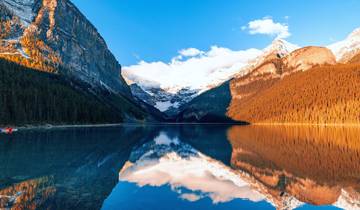
Canadian Rockies: National Parks Westbound
It was the best tour ever and had so much fun the tour guide Matthew Polowyk was this best guide ever so much fun and providing info at every place we went he also cooked great food

- Coach / Bus
Rockies Classic Summer Tour
A very nice tour and very pleasant guide Ryan.
- 10% deposit on some dates Some departure dates offer you the chance to book this tour with a lower deposit.

It was an awesome tour and Lee was doing an amazing Job and was a fun guy! 10/10 did already recommend to others

Fabulous trip encompassing so many beautiful places in a few days. Highly recommended
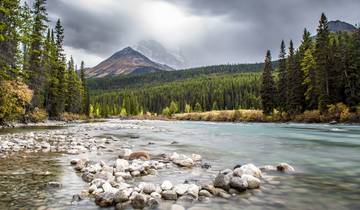
Canadian Rockies
Great guide, literally awesome destinations. Good camp sites (though hot water and WiFi hard to come by) Only downside was that covering such huge distances and team chores meant little free time to enjoy quiet enjoyment of the scenery and wildlife, and little free time in the evenings Would thoroughly recommend this trip
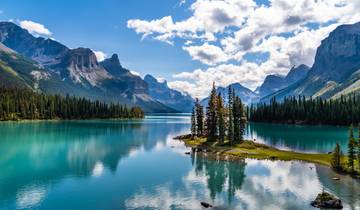
Canada's Rockies (7 Days, Calgary Airport And Post Trip Hotel Transfer)
- €100 deposit on some dates Some departure dates offer you the chance to book this tour with a lower deposit.
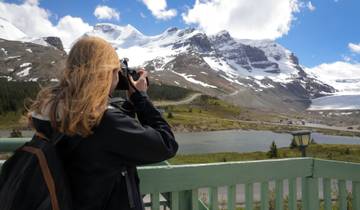
Rockies Premium Tour from Vancouver (34 Seats)
Great tour,better driver and assistant, they were incredible

Hiking in the Canadian Rockies
Excellent trip, definitely recommend it!
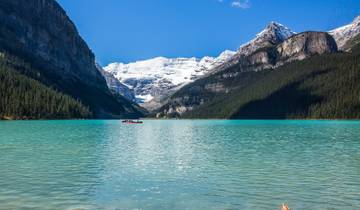
It would be good if you could offer an accommodation package that allowed for private rooms where available, although the experience at Rampart Creek was worth it. We were disappointed with Samesun Banff and horrified at the price they charged for two beds in what was effectively a 12-bed dormitory with one toilet/shower room. If you upgrade your buses at some time, we suggest you make charging points and internet available in them. Overall, we thought the Moose tour was very good and good value for money,
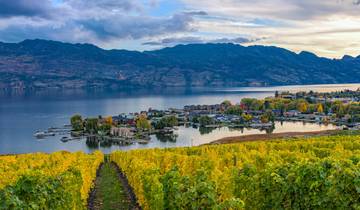
- In-depth Cultural
Canadian Rockies Express
Itinerary was great, scenery was beautiful, and our guide was fun. I was the only male in the group with my wife and 11 other females and it worked out fine. Everyone was very congenial, and the diversity of the group added to the experience. Only thing I would change would be the accommodations in Vancouver. While the hotel was fine it was very far from the downtown and sights, so we spent most of our time the last day in the van in traffic. Overall, it was a fantastic trip.
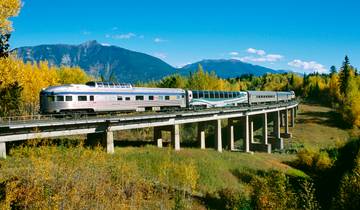
- Train & Rail
Via Railway Experience|5-Day Vancouver to Rockies Railway Full Experience Tour Departure
Good tour overallAll personnel very accommodating
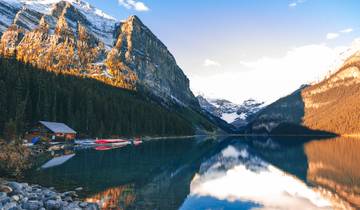
Wonders of the Canadian Rockies (10 Days) (7 destinations)
The lobstick hotel was not as clean as expected. It access bringing the bags was difficult having to carry up suitcases up the stairs needs a ramp.
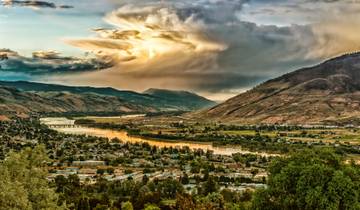
Heart of the Canadian Rockies
We real enjoyed our time away.

7 Day Rocky Mountain Camping Adventure
The trip was well planned and Alex (and Rob) was superb. Food were quickly made but delicious. We had a wonderful group to travel with. Everybody was friendly.
Canadian Rockies Tours and Vacation Packages Reviews
Kevin, Brendon and Alex were amazing in organizing a guided adventure trek in the Rockies! From teaching you to pitch your own tent ? to conquering new mountains, they are with you in every step :) Oh and the delicious meals, haha! We had the luxury of having cinnamon buns for breakfast, campfire and s’mores, endless conversations and meeting people from different backgrounds, it’s a trip of a lifetime! Thank you for making my graduation trip worth it, team! Cheers! Apoorva.
This trip was the best experience of my life so far! My CEO Melanie was so amazing, I felt so at ease and happy throughout every step of the tour. This is the perfect trip to see some of Canada. 100000/10 would recommend to everyone!
I have a great time! Ben is our tour guide, he’s such a great fun, knowledgeable, friendly person. He made sure everyone comfortable, safe, and ready to answer any questions we have during the tour. I did group tour before, I can tell Ben is one of the best.
Canadian Rockies Tours starting in:
- Calgary (57)
- Vancouver (38)
- Group (149)
- Explorer (138)
- Fully Guided (138)
- Family (110)
- Personalized (39)
- Active (36)
- Coach / Bus (24)
- Hiking & Trekking (20)
- In-depth Cultural (16)
- Partially Guided (16)
- Private (12)
- Train & Rail (11)
- Ocean Cruise (7)
- Self-Guided (6)
- Northern Lights (5)
- 7 Day Tours (52)
- 10 Day Tours (36)
- 2 Week Tours (17)
- Spring 2024 (54)
- Summer 2024 (83)
- Fall / Autumn 2024 (65)
- Winter 2024 / 2025 (9)
- Spring 2025 (17)
- Summer 2025 (26)
- Fall / Autumn 2025 (20)
- Winter 2025 / 2026 (3)
- April 2024 (17)
- May 2024 (49)
- June 2024 (67)
- July 2024 (73)
- August 2024 (74)
- September 2024 (65)
- October 2024 (28)
- November 2024 (5)
- December 2024 (7)
- January 2025 (6)
- February 2025 (5)
- March 2025 (5)
- April 2025 (3)
- May 2025 (21)
- June 2025 (23)
- July 2025 (26)
- August 2025 (24)
- September 2025 (20)
- October 2025 (4)
- November 2025 (3)
Other Regions in Canada
- West Coast Canada (292)
- Eastern Canada (143)
- The Prairies (115)
- Alberta (114)
- Icefields Parkway (75)
- Yukon and Northwest Territories (69)
- Banff National Park (49)
- British Columbia (45)
- Jasper National Park (33)
- Canadian Maritimes Provinces (27)
- Canadian Shield (26)
- Nova Scotia (25)
- Quebec (21)
- Newfoundland and Labrador (19)
- Dempster Highway (15)
- Ontario (14)
Travel Styles
- Budget (22)
- Singles and Solo (85)
- For Couples (29)
- Young Adults (8)
- Seniors (48)
9am-7pm Mon-Fri / 9am-5pm Sat-Sun

- Canadian Rockies
- Inspiration
Road tripping Canada’s Rocky Mountains – Self-drive Calgary to Vancouver
Read time: 6 mins
The Canadian Rockies are truly one of the world’s most magnificent places – a destination that offers the experience of a lifetime with dramatic peaks filled with gem-coloured lakes, waterfalls, roaring rivers, abundant wildlife and opportunities for a wealth of recreational activities.
This road trip through the Rockies from Calgary to Vancouver is arguably the very best way to take in these glorious mountains, from hidden treasures to world-renowned attractions.

The Calgary Stampede, and the 1988 Winter Olympics, was what put Calgary in the spotlight, making it one of Canada’s most popular tourist destinations. This is where your journey begins, and you’ll find plenty to keep you busy here before heading to the majestic Canadian Rockies. You might want to begin by whizzing to the top of Calgary Tower, which rises over 625 feet above the city, providing a perspective of its layout and an impressive view. Standing on the glass floor, it feels as if you’re floating over the streets while taking in a magnificent 360-degree vista. You’ll find the SKY 360 restaurant here, a perfect place to dine on appetizers or sip a refreshing drink while enjoying the revolving views.
Calgary has an interesting history that can be explored in a number of ways. Heritage Park is the country’s most extensive living history museum and hosts 200 exhibits bringing to life various periods from the mid-1700s through the mid-20th-century. It includes a turn-of-the-century living historic village, with a blacksmith shop, an historic steam train, working press and even carnival games from the early 1900s. There’s also a First Nations Encampment, a Fur Trading Port and a Pre-Railway settlement. At Fort Calgary History Park, you’ll find the remains of the original mounted police stronghold. It lies buried underneath the city where the Elbow and Bow rivers meet until it was resurrected in the 1970s, and today you can wander through reconstructed barracks for a glimpse of the lives of Mounties in the west as well as indigenous people.
The Calgary Zoo is a great place to visit before getting out on the road, offering the chance to see some of the animals you might witness on this unforgettable drive, including grizzly bears and mountain goats. It also hosts wildlife from across the globe like mountain gorillas, giraffes, hippos and more.

Journey west from Calgary, the craggy peaks of the Rockies are an especially impressive sight and home to your next destination: Banff . This town nestled in Banff National Park in the heart of the Canadian Rockies looks like a Swiss ski village that was stolen and deposited right in Canada. The village boasts a thriving arts and culture scene, with art galleries and museums, concert venues and a wide range of shops and eateries. Enjoy exploring, stopping into the Whyte Museum of the Canadian Rockies with its ever-changing art gallery featuring works from 1800 through today by international, Canadian and regional artists as well as a permanent collection that tells the story of Banff and its early pioneers.
Visitors can also ride the Banff Gondola to summit a peak near the village, with the cars ascending to the top of Sulphur Mountain. Take in epic views along the way, and at the peak, you’ll find a gift shop, eateries, interactive exhibits and a 360-degree observational deck with views of the Bow River Valley and Banff. Afterwards, enjoy a soak in the warm waters of Banff Upper Hot Springs, pools that are fed by natural hot springs known for their healing properties that were popular with First Nations people who considered them to be a sacred place, using them to rest and relax.
Banff National Park itself is filled with some of the most dramatic mountains that have been likened to ‘giant castles in the sky,’ providing endless opportunities for outdoor adventure like hiking, mountain biking and climbing.

Moraine Lake and Lake Louise
Delving further into Banff National Park, visit Moraine Lake and Lake Louise , two of its most popular lakes, and arguably two of the most stunning on the planet. Glacially-fed Moraine Lake is located in the heart of the park, and in early summer the water levels rise, casting an ethereal shade of blue due to rock particles in the water. The shoreline is often visited by deer, and the occasional bear too. It’s a great place to rent a canoe and paddle around, capture photos or enjoy walking the trails.
Lake Louise is another gem that is guaranteed to provide picture-perfect photos while offering a number of fun and scenic things to do. If seeing a grizzly bear in the wild is on your bucket list, you won’t want to miss a visit to this lake as it’s a prime grizzly bear breeding area. Females and their cubs are often spotted feeding in the meadows in the spring. The Plain of Six Glaciers Trail leads from the lake and passes through gorgeous landscapes leading to Victoria Glacier, with bears frequently feeding on grassy slopes in the summer and early fall. If you enjoy a good afternoon tea, the two-mile hike to the Lake Agnes Tea House is another option traveling from Lake Louise and guarantees an especially scenic cup.

Icefields Parkway and Jasper National Park
Heading to Jasper National Park , Canada’s largest national park and the world’s second largest dark sky preserves, you’ll embark on one of the world’s most scenic drives. Icefields Parkway stretches for 143 miles starting just outside Lake Louise. The iconic highway traces the Continental Divide and is surrounded by jagged peaks in every direction and passes countless rushing rivers, mirror-like lakes and glaciers, with opportunities to spot wildlife like caribou, moose and bear. The Athabasca Glacier, the largest of the six ‘toes’ of the Columbia Icefield, is quickly disappearing, having lost over half its volume in in the last 125 years, so you don’t want to miss out before it disappears altogether. It’s still a remarkable mass of ice that’s about as thick as the Empire State Building is tall. You can take a tour of this prehistoric glacier, traveling on the icy surface aboard the giant Ice Explorer. You’ll even be able to walk, feel and drink from the glacier too. Afterward, take a thrilling walk along the glass-floored Skywalk at the edge of a cliff that was designed to blend in with the natural landscape. Massive glaciers will be perched above you while the breath-taking Sunwapta Valley is spread out below.
Athabasca Falls is nearby, just off Icefields Parkway, and is one of the most powerful in the Canadian Rockies. Fed by the Columbia Icefield, the sheer volume of water that flows into the gorge from Athabasca River is a sight to behold. You can walk out onto multiple platforms and pathways to capture a photo and just enjoy its mesmerising beauty. If you want to explore the park on a hike, there are 615 miles of trails that run through valleys, forests, alpine meadows, along rivers and through the mountains. The park protects an abundance of wildlife too, including some of the continent’s healthiest populations of moose, elk and grizzly bears.

Wells Gray Provincial Park and Sun Peaks
From Jasper, travel to the resort town of Sun Peaks, stopping in Wells Gary Provincial Park along the way where you can hike to waterfalls, enjoy the pristine Clearwater River, explore volcanic canyons and caves, or just relax on a riverside beach.
Sun Peaks Resort sits in a valley ringed by three mountains, offering a wide range of outdoor adventure as well as festivals, concerts and other events on summer weekends. You can take a two- or four-hour horseback ride surrounded by gorgeous views, golf the province’s highest-elevated course, or hike one or more of 18 trails, some of which meander through wildflower-filled alpine meadows. If you’re here over the last weekend of July, attend the Alpine Blossom Festival, which honours the peak of the wildflower season with all sorts of activities and entertainment in the village. You’ll find plenty of restaurants and shops to enjoy here too.
Fraser Canyon and Hell’s Gate
Make your way to B.C.’s largest city, Vancouver, but be sure to stop at Fraser Canyon along the way. This major landform of the Fraser River is where it powerfully descends through narrow rock gorges in the Coast Mountains. At Hells Gate, the canyon walls soar nearly 3,300 feet above the rushing rapids where more than 750,000 litres surge through every minute. Hell’s Gate is a scenic attraction – an airtram that carries passengers over the raging Fraser River to the opposite shore. In the lower terminal there are a variety of educational exhibits and displays, and visitors can also test their skills at panning for gold. There’s a café, gift shop and a Fudge Factory that features more than 100 flavours, all made right onsite.

Vancouver is an ideal place to end this magical adventure through the Canadian Rockies. You’ll be in awe at its incredible beauty, surrounded by water and mountains. One of the best views of it all can be had from the Vancouver Lookout at Harbour Centre which towers above the city streets, providing a perspective of the layout as well as hosting the ‘Top of Vancouver’ revolving restaurant for dining with ever-changing spectacular views. This is a true foodies’ haven, with the diverse population resulting in a wide range of cuisine offered here, including fresh local seafood and other regional delights, along with Italian, Indian, French, Greek, Vietnamese and just about everything your heart desires. Sample it in farmers markets – the Granville Market is ideal, as well as everything from quaint cafes to fine dining eateries.
Visiting Stanley Park is a must – before flying home or wherever your travels might take you, stretch your legs with a walk along its nearly 5.5-mile-long seawall that runs along the waterfront. Enjoy the views and look for landmarks like the “Girl in a Wetsuit,” a mermaid sculpture and the Siwash Rock rising out of the water that’s a remarkable 32 million years old. There are inland trails that snake through the forest, a fantastic aquarium, water park, heated outdoor pool and a miniature train too. A harbour cruise is an ideal way to take in the city skyline and mountains from atop the sparkling waters and could make for the perfect grand finale. A sunset dinner cruise sails under the Lions Gate Bridge, passing Stanley Park and the Lookout Tower, allowing passengers to dine on a mouth-watering feast while enjoying the sights.

More Inspiration

Searched destinations
Top Destinations
Recommended holidays

Las Vegas, Canadian Rockies & Alaskan Cruise

Mountains To Sea Rail Passage

Majesty of the Rockies

Self-Drive Mountain Express

Self-Drive Rocky Mountain Journey

Canadian Rockies at Leisure plus Rocky Mountaineer & Alaska Cruise
- Twin & Multi Centres
- Customer Stories
Privacy Settings
We use cookies and similar methods to recognise visitors and remember their preferences. We also use them to measure ad campaign effectiveness, target ads and analyse site traffic. They activate only after you agree by selecting "Accept". Alternatively, you can decline or customise your preferences by choosing "Cookie Settings". Additional details are available on our privacy policy page .
Cookie Settings
Customize your cookie preferences:
Sign up for our exclusive offers and holiday inspiration by email.
Sign up to our newsletter
Be the first to know about our exclusive offers and holiday inspiration by email.

A Memorable 3-week Canadian Rockies Itinerary: An RV roadtrip
A roadtrip to never forget: a 3-week canadian rockies itinerary with an rv.
This trip was one to remember. Thinking back about it, I’m still so pleased I’ve been able to do this trip. An RV road trip through the Rocky Mountains, Canada. How great does that sound? In between assignments for my job, end of September 2018, I’ve been able to go on a 3-week Canadian Rockies trip, a road trip with an RV. Before the trip, I’d done a whole lot of research on the route, the best places to stay, what hikes to do, and what other places to visit to draft up the perfect 3-week Canadian Rockies Itinerary. Visiting the Canadian Rockies was a dream coming through and I did want to get the most out of these 3-weeks in the Canadian Rockies. All my personal experiences and prior research are covered in this extensive travel guide to the Canadian Rockies through British Columbia and Alberta.
Day to Day travel plan (itinerary):
Day 1&2: Vancouver Day 3: RV pick-up and drive to Whistler Day 4: Hike Garibaldi Lake Day 5&6: Drive and Well’s Grey Day 7 t/m 10: Discover Jasper National Park Day 11&12: Driving the Icefields Parkway
Day 13&14: Lake Louise Area Day 15&16: Banff National Park Day 17: Yoho National Park (Emerald Lake) Day 17&18: Kelowna Day 19&20: Vancouver
A travel map to the canadian rockies
|| start your canadian itinerary in vancouver (2 nights)
Vancouver is the starting point of our RV road trip covering the regions of British Columbia and Alberta. Vancouver is a great city with a wonderful food and drink culture. You can enjoy yourself here for a couple of days exploring different parts of the city, visiting Granville Island, exploring Yaletown, discovering Stanley Park, and heading towards Downtown Eastside to explore many craft beer breweries. We stayed here for 2 nights, which meant we had 1 full day to discover Vancouver, as on the 2nd day we had to pick up our RV for the trip.
We stayed in GEC Granville Suites Downtown , which was a perfect and affordable hotel in a central location.

|| Whistler area and garibaldi lake (2 nights)
We picked up our RV from Fraserway. We had a hotel pick-up that brought us to Delta, the area where we could pick up the camper. This took a while, as there was some paperwork to do, using the camper was explained, and of course some waiting time. We loaded our suitcases in the RV and around noon – we were ready to go!
From Delta, we drove towards Whistler where we found a Walmart on the way and decided to do our groceries. We tried to buy as many preservable foods as possible for the 3 weeks (say hello to pancakes in the morning, frozen fruits, crackers, soups, and more). Next to that, as huge craft beer fans, we found a BC Liquor Store and bought some supplies. After this, we continued to our first RV park called Whistler RV Campground.
We stayed two nights at Whistler RV Campground, as we wanted to do the hike towards Garibaldi Lake , which in my opinion was the most beautiful trail near Whistler. You’ll read everything about it in my Garibaldi Lake report.

|| A LEsser known national park: Well's Grey (2 nights)
Well’s Grey is one of the relatively lesser-known National Parks. However, coming from Vancouver and Whistler, you don’t want to drive straight to Jasper National Park. On the one hand, because it is just too far for a single leg, on the other hand, because you have this spot in between and you of course don’t want to get sick of full days of driving too soon.
We decided to spend two nights in Well’s Grey and stayed at the Dutch Lake Resort & RV park , which is located at, surprise surprise, the Dutch Lake. From here, we used one day to discover Well’s Grey and visit the, in my opinion, main highlight, Helmcken Falls. While you are at it, definitely also continue to Dawson Falls. We drove around in the park and actually, this was the only time we saw some black bears! after touring around in Well’s Grey, we went back to the campsite, enjoyed the views of the Dutch Lake, and prepared for the next drive.

|| Travel guide to Jasper national park (3 nights)
On to the next destination! We drove past Mount Robson and continued to Jasper National Park. We’ve stayed 3 nights at Wapiti Campground. Another option nearby is Whistlers Campground and from what I’ve seen and researched, the two don’t differ too much. However, at the beginning of October, the only campground open was Wapiti. From Wapiti it takes about an hour to walk to Jasper Town (Whistlers is slightly closer). As we loved to have a beer in the city center, we went on foot in the evening. During the day, there are some RV parking spots near the city center. Perfect when you want to go for lunch, want to check out the tourist office, or need some groceries. We’ve had some lovely food and drinks at Earl’s Kitchen in town and don’t forget to visit Jasper Brewery when you are into craft beer.
We’ve stayed 2/3 days in Jasper, as there is enough to do! Maligne Lake & Spirit Island were our highlights, but there are also many hikes to take in the park. We did the Valley of the Five Lakes hike. More below!
Maligne Lake & Spirit Island
Maligne Lake is stunning. This is one of the only places where we did a tour, which is also needed to visit Spirit Island. I’ve written a specific guide on what to expect from the Maligne Lake Cruise and all the practicalities you’ll have to know. From the Maligne Lake, you’ll have the opportunity to visit the Maligne Canyon, however, I wouldn’t necessarily recommend this one. After your cruise on Maligne Lake, you can also continue the day with the Bald Hills trail, Opal Hills trail, or any other hike starting from the lake.
Btw, did you know Maligne Lake is the perfect place to spot a Moose?

Hiking in Jasper National Park
Like all the national parks in the Canadian Rockies, Jasper National Park is home to many great hikes. We’ve done the Valley of the Five Lakes trail the day we arrived and headed to Pyramid Lake on the other full day we had. Both were stunning as the pictures show. However, there are more hikes. Read about the top 10 hikes in Jasper here.

|| Driving the icefields parkway (1 to 2 nights)
Now it gets slightly complicated. Well, at least for me to describe the route. The pictures don’t lie, it was VERY snowy when we drove the Icefield Parkway. This was the second day we drove the Icefields Parkway as the first day we couldn’t see anything as a snowstorm was going on and it was very very cloudy. But, what I would normally recommend: take your time for the Icefields Parkway as it is stunning and a new view shows up around every corner.
You can find an overview of all stops worth visiting along the Icefields Parkway here.

|| Exploring the Lake louise area (2 nights)
The Lake Louise Area might be one of the most popular ones of the Canadian Rockies. Lake Louise is home to the famous lake, surprise, Lake Louise but also to Moraine Lake which might even be prettier. The area is also home to some great hikes such as the Lake Agnes hike and Plain of the Six Glaciers. Both do have a nice tea house on the way, which is pretty unique if you ask me. As you might have read by now, the weather wasn’t too good so we weren’t able to do most of the hikes and couldn’t visit Moraine Lake. Good excuse to head back right?
Want to read about the Lake Louise area in more detail? Check out this In and Around Lake Louise Travel Guide.

|| banff national park (2 nights)
Time to head to Banff National Park! It was quite fun to be back in a small city, head to a craft beer bar (it’s a hobby) and enjoy some nice food in a restaurant. As it was snowing like crazy, we used Banff as a place where we were still able to do something, as hiking became impossible. So, now you are wondering, what to do in Banff while still enjoying our 3-week Canadian Rockies itinerary?
We went to the Banff Hotsprings for a relaxing experience in a hot spring while looking over a big layer of snow. Another recommendation about Banff, is the Banff surprise corner, rewarding you with a great view.
We had a lovely Cheese Fondue dinner at The Grizzly House , enjoyed some cocktails at the famous Park Distillery, and enjoyed our beers at Banff Ave Brewing Co.
Looking to spend a little more time outside and around Banff, there are several lakes/hikes to take. Head for example to the Vermillion Lakes, Lake Minnewanka or take some more time to hike the East End of Rundle Trail (6 hours).
We haven’t gone up with the Banff Gondola, however, I’ve heard good stories. The gondola rewards you with beautiful views from the top of Sulphur Mountain. Buy your tickets here.
A great place to spend the night is the Tunnel Mountain Village II Campground, it isn’t the most charming location, even though you have a great view of the mountains around, but it only takes about 20 minutes to walk to the city center, which is quite nice! There is also a resort part of Tunnel V illage if you prefer more luxury as a break.

|| yoho national park (1 or no nights)
I have to admit, Yoho National Park didn’t swipe me off my feet. The only place we did visit was the Emerald Lake , of which I saw stunning images on Instagram, but the weather conditions caused the chalet to be closed and the Lake not to be as beautiful as normally. However, we still took the hike up ( Emerald Lake Basin Trail ) which took around 3 to 4 hours. We went to the Yoho National Park visitor center for more inspiration, however, we decided to leave it with this and continue our journey towards Kelowna. However, Yoho is still a great place on the way when coming from Banff, so if you want to spend the night, I would recommend Kicking Horse Campground. We decided to drive a little bit further and stop around Revelstoke where we relaxed during the afternoon and spend the night at Revelstoke Campground, which is pretty modern and where you also have the opportunity to stay in chalets.
|| Wine Tasting in the Okanagan valley: kelowna + OSOYOOS (2 nights)
It’s time for some wine! An area I wanted to visit was the Okonogan Valley, famous for its wines and to balance out the nature in our 3-week Canadian Rockies Itinerary. We decided to spend 2 nights in the area of which we spend one in Kelowna. We knew someone there and were able to park the RV in front of the house and enjoy a great Thanksgiving dinner! In Kelowna, we spend a good bit of the afternoon at Mission Hill, famous for the Oculus wine, where we did a tour and were able to see the property, discover the wine cellars and of course taste their best wines.
The next morning we drove down south a little bit more (towards Penticton) and did spend some time discovering the area and tasting wines at smaller locations. Unfortunately, I don’t remember the place where we spend the night around here.
The next day, we continued south even further and drove towards Osoyoos to spend another night and discover the wineries close. I would recommend just driving around and the wineries can provide you with a map of other wineries in the area. There are plenty! We went to for example the Burrowing Owl (amazing Cabernet Franc), Nk’mip cellars, Moon Curser Vineyards, La Stella Winery,

|| vancouver (2 nights)
When heading back to Vancouver, we stayed for one night at the Burnaby Cariboo RV park, which we got for free when renting our RV. We decided to do this, so we could hand in our RV at the set time in the morning, but wouldn’t have to risk driving here. on the way, we got some Four Winds craft beers (FAVOURITE!) to spend our last night in front of the RV with.
The next day, we headed to Delta, to hand in our FraserWay RV after which we headed to Vancouver, where we stayed the night in Yaletown. We discovered Yaletown, visited Yaletown Brewing, and head an amazing sushi dinner at Minami, which is sushi I’ll never forget!
We stayed again in GEC Granville Suites Downtown , the perfect place to end this holiday.
Final notes on a 3-week RV itinerary through the canadian rockies
And that was it, the end of our 3-week RV roadtrip through the Canadian Rockies. An amazing and unforgettable experience, if only because of the crazy weather we had and icicles of 1,5 meter hanging on the mirrors of the RV. Unfortunately, we weren’t able to see some locations and do as many hikes as planned, but it was a great experience. I would love to go back once, go camping and discover the area off the beaten tracks.
PIN FOR LATER:

YOu may also like:
- 13 April 2024
Hike the Lagos de Saliencia in Somiedo | Asturias Hiking Guide
Privacy overview.
Warm-Weather Road Trip
The Longest Highway in the US
Car Rental Companies
Best Audio Books
Must-Have Emergency Supplies
Family Road Trip Toys and Games
Car Bike Racks
Getting Your Car Ready
Preparing for the Weather
8 Helpful Apps for a Road Trip
Common Mistakes to Avoid
Taking a Road Trip With Kids
Planning a Solo Road Trip
How to Plan a Camping Road Trip
Planning a Stargazing Road Trip
10 Helpful Budget Tips
Calculating the Cost of Gas
Budget for a 3-Day Road Trip
Best Road Trip Route By Interest
Mississippi River Road Trip
Atlantic Coast Road Trip
Southern US Road Trip
Northern US Road Trip
Pacific Coast Road Trip
US Route 12
Northeastern US Routes
Rocky Mountain Destinations
5 Top Scenic Road Trips in the Rocky Mountains
David Berry / Getty Images
To road trip through the entire length of the Rocky Mountains would be a nearly 2,000-mile trip, starting in the northern-most part of British Columbia, Canada , and traveling all the way down to New Mexico. Whether you plan to traverse the whole range or just make stops in the parts closest to you, you can find breathtaking views and out-of-this-world landscapes in all parts of the Rockies. However, it's best to narrow them down to the places you most want to see and can most realistically get to (if you're driving through Colorado, then getting to Jasper National Park isn't likely to make your itinerary).
The following list of the top destinations to visit in the Rocky Mountains starts north in Canada and moves south, so you can easily plan your trip based on your starting point. And although those road trips are all included with driving in mind, the Rockies are best enjoyed in the outdoors, whether you're hiking, trekking, kayaking, bouldering, camping, or whatever activity you choose. So don't forget to pull over and enjoy the scenery.
Because these roads are in the Rocky Mountains, many of them are closed during bad weather or even all winter and spring. Be sure to check local road conditions for safety before heading out.
Icefields Parkway, Jasper and Banff National Parks
Jon Philpott Photography / Getty Images
One of North America's most stunning drives, the Icefields Parkway traverses Jasper and Banff national parks , the crown jewels of the Canadian Rockies. This scenic road starts in the town of Jasper where Highway 93 begins—also known as the Icefields Parkway—and winds down until Highway 93 merges with the Trans-Canadian Highway near the idyllic Lake Louise. The route is 144 miles long but with so many scenic viewpoints, trailheads, waterfalls, and sweeping valleys that you should factor in at least an entire day for taking it all in, if not longer.
Some highlights along the route include the Jasper Skytram at the very beginning, the glass-floored and heart-racing Skywalk, and the Instagram-famous Peyto Lake. The terminus of the Icefields Parkway will bring travelers right to Lake Louise and the Valley of Ten Peaks in Banff National Park, two remote areas that are perfect for camping, hiking, or just having a picnic underneath their natural splendor.
Waterton-Glacier International Peace Park Loop
Michael Melford / The Image Bank / Getty Images
The Waterton-Glacier International Peace Park is actually a combination of two national parks: Waterton Lakes National Park in Alberta, Canada, and Glacier National Park in Montana. The international park is filled with beautiful mountain peaks, wildflower patches, and alpine meadows, and this year-round getaway has something unique to offer each season of the year. If you can't choose which side of the park you want to visit, the Waterton-Glacier International Peace Park Loop gives visitors the chance to experience the best of both worlds.
There is no officially designated loop, but to circle both parks you'll drive approximately 300–400 miles, depending on exactly which routes you take. One scenic section that shouldn't be missed is the so-called Going-to-the-Sun Road on the U.S. side, the only road that traverses Glacier National Park from east to west. It's a difficult drive with many hairpin turns and it's only open from summer to fall, but the reward is well worth the challenge. If you do plan to drive the entire loop, make sure you have passports for all passengers on hand when crossing the international border .
Beartooth Highway to Yellowstone National Park
Yellowstone National Park is the most visited location in the entire Rocky Mountain range, but getting there can be just as much a part of the experience as actually seeing the park. There are a number of ways to enter America's first national park, but coming in from Montana along the Beartooth Highway is considered by many to be the most scenic.
This famous roadway starts on Highway 212 in the town of Red Lodge, Montana—about an hour south of Billings —and winds through the mountains of southern Montana and northern Wyoming before terminating at the Northeast Entrance to Yellowstone National Park. The entire route from Red Lodge to Yellowstone is only 68 miles, but between the elevation gain, winding roads, and stopping for pictures, you should plan for it to take at least two to three hours. From there, you can continue the drive through the Yellowstone loop and see what else the park has to hold.
Trail Ridge Road in Rocky Mountain National Park
A list of road trips through the Rockies isn't complete without at least one route that goes through Rocky Mountain National Park , and while there are many to choose from , the Trail Ridge Road is one of the most popular—and for good reason. The route starts at the doorstep of the national park in Estes Park , Colorado, traveling west through mountains and across the Continental Divide along U.S. Highway 34 for 48 miles until reaching the city of Grand Lake.
Reaching elevations of over 12,000 feet, it's one of the highest points you can reach in a car in all of North America and provides some of the most exquisite views. But don't enjoy all of them from inside the car. Be sure to pullover in designated areas to take in the views, hike along the nearby trails, and breathe in the fresh alpine air.
Royal Gorge in Cañon City, Colorado
David H. Carriere / Photolibrary / Getty Images
Unlike many of the famous gorges in the United States that are expansive and broad—like the Grand Canyon—the Royal Gorge is deep and narrow, making it a unique one to visit. The Royal Gorge Bridge offers great views down into the gorge itself, though this might not be the best destination for vertigo sufferers. You might also see the excursion train taking visitors along the railroad that runs along the bottom of the gorge. And if you're interested, you can book a trip on the train during your visit, raft through the gorge , or zipline above it , depending on how adventurous you're feeling.
Canada's Most Scenic Drives
Top 8 Things to Do in Rocky Mountain National Park
Banff National Park: The Complete Guide
The Complete Guide to Alberta's Icefields Parkway
Top Things To Do in Banff
The 12 Most Beautiful Places in Colorado
Best Places to See Fall Color in the Pacific Northwest
10 Top Road Trip Routes in the Northeastern US
Money Saving Tips for Visiting Banff National Park
Science Says This Is the Perfect U.S. Road Trip
10 Amazing Virtual Road Trips You Can Take on Google Street View
20 Maps of Canada
Banff, Alberta, Canada: Travel, Weather, and Things to Do
The 10 Most Scenic Road Trips in Colorado
8 Best Places to Go Snowmobiling in North America
Where to Go in 2021: 10 Future Trips You Can Start Planning Now
- Search Please fill out this field.
- Manage Your Subscription
- Give a Gift Subscription
- Sweepstakes
- National Parks
This National Park Is Known for Its High Elevation — and Offers Stunning Hikes, Diverse Wildlife, and More
Here's everything you need to know before visiting Rocky Mountain National Park.
Evie Carrick is a writer and editor who’s lived in five countries and visited well over 50. She now splits her time between Colorado and Paris, ensuring she doesn't have to live without skiing or L'As du Fallafel.
:max_bytes(150000):strip_icc():format(webp)/evie-carrick-df91be43396540c492c4141c56a71a9e.jpg)
- Planning Your Visit
How to Get There
- Best Time to Visit
Best Things to Do
- Places to Stay
Places to Eat
Matt Dirksen/Getty Images
Rocky Mountain National Park is one of the highest national parks in the country, with an elevation that spans from 7,600 feet above sea level to 14,259 feet (or almost three miles) above sea level. Beyond its towering elevation, the mountainous Continental Divide runs through the park, along with the highest continuous paved road in the United States (the Trail Ridge Road), which provides visitors with beautiful high-elevation drives. Those interested in exploring on foot will find over 350 miles of trails, many of which lead to untouched wilderness areas.
“Rocky Mountain National Park provides exceptional access to wild places for visitors to recreate and experience solitude and outstanding scenery,” explained Kyle Patterson, the management specialist and public affairs officer for Rocky Mountain National Park, in an interview with Travel + Leisure.
Meet the Expert
Kyle Patterson is the management specialist and public affairs officer for Rocky Mountain National Park.
Claire Molle is the communications manager of Visit Estes Park.
Planning Your Visit
John Covert/Getty Images
Rocky Mountain National Park is open 24 hours a day, 365 days a year, but some areas may be closed seasonally or due to weather conditions. No matter when you visit, you’ll need to purchase a park pass. A single-day vehicle pass is $30, while a seven-day vehicle pass is $35.
The park is completely cashless, so you’ll need to buy your entrance pass online via Recreation.gov or by using a credit/debit card or digital payment at one of the park’s entrances. If you only have cash, you can purchase a park pass from the Rocky Mountain Conservancy Nature Stores at three of the park’s visitor centers: Beaver Meadows, Fall River, or Kawuneeche.
If you’re visiting during the park’s busy season, late May to mid-October, you’ll also need to arrange a timed-entry permit. There are two types of timed-entry permits: one that provides access to the entire park, and one that allows you to visit everything except the Bear Lake Road Corridor (the most heavily used portion of the park). Both can be reserved on Recreation.gov starting May 1, 2024 and cost only the $2 Recreation.gov processing fee. With a timed-entry permit, you can enter Rocky Mountain National Park within a two-hour window of your entry time with no set departure time. For more, visit the park’s timed-entry information page .
There are four visitor centers in the park: Beaver Meadows, Fall River, Kawuneeche, and Alpine. Beaver Meadows and Fall River are located on the eastern side of the park near the city of Estes Park, Colorado, while Kawunechee is located on the western side of the park near Granby, Colorado. They remain open year-round. Alpine, which is on the northern side of the park and is the highest-elevation visitor center in the National Park System, closes in the winter.
During the busy season, you can also visit the Moraine Park Discovery Center near the eastern entrances.
arinahabich/Getty Images
If you’re staying in or flying into Denver, head west to Estes Park, Colorado, the base for the two eastern park entrances and visitor centers, Beaver Meadows and Fall River. If you’re coming to Rocky Mountain National Park from the western or southwestern part of the state, your closest entrance and visitor center will be Kawuneeche, which is near the town of Grand Lake , north of Granby, Colorado.
There is no public transportation from nearby cities to the park, so you will need a car to explore Rocky Mountain National Park. From late May to mid-October, you can drive the park’s iconic Trail Ridge Road, which connects Grand Lake and Estes Park.
Best Time to Visit
epicurean/Getty Images
The best time to visit Rocky Mountain National Park (RMNP) is typically fall, when everything is still open but the summer crowds have dispersed. According to Claire Molle, the communications manager of Visit Estes Park , “Fall is a terrific time to visit Estes Park and RMNP, with gorgeous fall colors and the chance to witness the fascinating elk rut. Weather seems to also be terrific in September and early October.”
She notes that winter and spring are also fantastic times to visit, noting that even though certain parts of the park are closed (including Trail Ridge Road), “Winters in RMNP evoke serene tranquility, especially during snowshoeing excursions. You can find terrific trails to snowshoe in RMNP starting around late November through early May!”
Patterson calls out the solitude of winter (and frozen waterfalls), and notes that while the summer wildflower season can be stunning, “Late May through mid-October is the busiest part of the year with high visitation.”
Mark C Stevens/Getty Images
Trail Ridge Road
This paved road connects the two main entrances of the park — Grand Lake and Estes Park — showcasing the visual wonder of Rocky Mountain National Park. The road offers sweeping Rocky Mountain views in all directions. Trail Ridge Road takes most people between four and eight hours, depending on how many viewpoints and trails you want to stop at.
Patterson notes that the route “is the highest continuous paved road in the United States with 11 miles above treeline. There are a number of pull-offs and short trails to experience the magic of the alpine tundra and top-of-the-world, 360-degree views.”
Trail Ridge Road is normally open from Memorial Day to mid-October, weather permitting.
Sheep Lakes
Not far from the Fall River entrance is Sheep Lakes, an open area that offers a dramatic view of Horseshoe Park, which was carved by ancient glaciers. According to the Rocky Mountain National Park website, the “beautiful meadow is a great place to view wildlife. The area is named for the bighorn sheep that come down from the mountainside to lick mud for nutrients. Sheep Lakes also sees coyotes, ground squirrels, and elk.”
The parking lot at Sheep Lakes is open 24 hours a day, year-round, but it's best visited in the fall when the annual elk mating season takes place. The adjacent Sheep Lakes Information Station is closed in the winter and spring.
Holzwarth Historic Site
For a glimpse into the park’s human history, visit the Holzwarth Historic Site. The series of buildings provide a peek into what life looked like in the 1920s, when the Holzwarth family homesteaded on 160 acres high in the mountains.
The grounds are open year-round, but entry into the historic buildings is only allowed in the summer (typically Memorial Day to Labor Day).
Best Hikes
MargaretW/Getty Images
If you’re not much of a hiker but you want to stretch your legs and see the views, head to the Bear Lake Trailhead on the east side of the park. The route goes around the lake in a view-packed, half-mile journey. The route is wheelchair accessible, and offers stunning views of Hallett Peak and the Continental Divide from the trail.
It’s worth noting that the trail can be very busy in the summer and that parking is limited. To be safe, park at the Park & Ride lot and hop on the free summer shuttle to the trailhead.
Emerald Lake
The Emerald Lake hike also begins at the Bear Lake Trailhead, but tends to be a little quieter than the Bear Lake loop. (That said, the parking and shuttle advice above still applies.)
Molle says,”It's a great option for families or those who might not know how far they are wanting to hike because it will take you first to Nymph Lake, then to Dream Lake, and finally to Emerald Lake about two miles up. All three lakes are breathtaking, and the trail allows you to pick whichever lake you would like as your destination depending on how ambitious you are feeling.”
For the more adventurous and experienced hiker, Patterson recommends hiking to Chasm Lake on the east side of the park. The lake sits at the base of Longs Peak, the park’s highest point and one of Colorado’s 14,000-foot peaks. The out-and-back trail to Chasm Lake is 8.4 miles and requires a steady climb through a subalpine forest and into the alpine tundra.
Coyote Valley
This easy, out-and-back trail is located on the west side of the park, near Grand Lake and Granby. The hike is one mile, roundtrip and is wheelchair accessible. The route runs along the Colorado River, which draws local wildlife, including elk and moose.
Cascade Falls
This hiking trail is also located on the quieter, western side of Rocky Mountain National Park. The out-and-back trail is almost seven miles long and passes through open meadows, dense pine forest, and along the river, in addition to taking hikers to a beautiful cascade that tumbles onto pure granite rock.
Sparty1711/Getty Images
Wildlife spotting is one of the main reasons people visit Rocky Mountain National Park, which is home to large wild animals, including elk, bighorn sheep, moose, and bears. The park is home to a large elk herd, numbering between 600 to 800 in the winter , and around 350 bighorn sheep. There is also a small population of moose and black bears.
According to the park’s website, “wildlife watching is rated the number-one activity by a vast majority of Rocky's three million annual visitors.”
One of the most interesting times to view the elk herd is in the fall, during the rut, or mating season. Sheeps Lake is a popular viewing spot, as is any place in the park where the meadow and forest meet. According to the national park’s website, “Elk spend much of their time at or above treeline during the summer, moving to lower elevations in the fall, winter, and spring.”
Bighorn Sheep
The best place to see bighorn sheep is at the aptly named Sheep Lakes from May to mid-August.
Moose are more commonly seen on the western side of the park along the Colorado River in the Kawuneeche Valley. They tend to frequent the willow thickets set along the river.
Black Bears
Black bears make a point to avoid humans , so they are rarely seen in the park. The sightings, while rare, take place in the summer once the bears have come out of hibernation. It’s worth noting that contrary to their name, black bears can also be dark brown, cinnamon-colored, or almost blonde.
Places to Stay
Christian Harder
In addition to lots of backcountry, hike-to camping that requires a permit, Rocky Mountain National Park has five campgrounds with sites that can be reserved in advance and accessed by a car.
Patterson notes that “They are very popular, and demand normally exceeds supply.” She also warns that Moraine Park Campground, which is listed below and is the park's largest campground, is currently closed. It will reopen for summer 2024, but the timing is unknown.
All the campgrounds but Longs Peak Campground must be reserved in advance with a rolling six-month window.
Campgrounds
Aspenglen Campground: This campground has 52 RV and tent sites including 13 that are for tents only. There is no water and no RV dump station. This is the only campground open year-round.
Glacier Basin Campground: Glacier Basin has 150 sites, along with lots of amenities — including firewood for sale, potable water, a dump station, and helpful staff on site. It is only open from late May through mid-September, weather dependent.
Moraine Park Campground: This is the largest campground in the park with 244 campsites. The park website notes that it is “closed until early June 2024,” while Patterson said that the exact opening date is still unknown and might be later into the summer than planned. When the campground restoration project is complete, the large campground will have new walkways, parking areas, and amenities, including 15 additional wheelchair-accessible campsites, 90 new food storage boxes, and electrical hook-ups for around 60 campsites. The Moraine Park Campground also has potable water, an RV dump station, and staff on site.
Longs Peak Campground: This is a tent-only campground (no RVs allowed). It typically opens in July and closes in early September. It is also the only first-come, first-served campground in the park.
Timber Creek Campground: Timber Creek is the only campground on the quieter, western side of the park. This campground has 98 RV and tent sites, including 30 that are reserved for tents only. There is potable water, an RV dump station, and staff on site. Timber Creek is only open in the summer season.
Trailborn Rocky Mountains: The buzz around this new hotel is well founded. Trailborn Rocky Mountains , which opened in late 2023 in Estes Park, was specifically designed to serve national park visitors. The well-thought-out basecamp is clean and modern with just enough amenities to make it stand out — including on-site dining, pools, and an outdoor space with fire pits.
“The Trailborn stands out as a modern and well-equipped motel-style lodging, perfect for outdoor enthusiasts,” said Molle.
Grand Lake Lodge: This property is located on the western side of the park in the town of Grand Lake. Most guests stay in the historic cabins, which have been updated with a contemporary look, but there are also four “Jupes,” or tents, with high ceilings and solar-power-generated electricity.
There are no dining options inside Rocky Mountain National Park, so you’ll need to plan ahead by packing a picnic or returning to town for lunch.
The Rock Inn Mountain Tavern
The Rock Inn Mountain Tavern is one of the closest restaurants to the entrance to the national park. It is also much more than a restaurant — it’s a community hub with near-constant live music and delicious food.
Poppy's Pizza & Grill
This eatery is one of Molle’s favorites. It’s got an excellent riverfront location in Estes Park and has an outdoor patio where you can enjoy one of their specialty pies or sandwiches paired with a Colorado-brewed beer.
Claire's Restaurant and Bar
This spot in Estes Park is another of Molle’s top picks. Claire’s has a wide variety of dishes, including BBQ, fish, and burgers. The establishment opened in 1992 and continues to be a favorite — it helps that it has a lovely outdoor patio.

IMAGES
VIDEO
COMMENTS
A visit to British Columbia is not complete without a trip to the Rocky Mountains, one of Canada's most iconic and inspirational destinations. Destination British Columbia. Share Facebook Twitter Pinterest. ... BC Road Trip: Calgary to Vancouver via Highway 1. Tips on some of the best places to stop along Highway 1 between Calgary and Vancouver.
Road trip itinerary at a glance. Before we go any further, here is a look at the entire 9 road trip itinerary from start to finish (there is a 12 day version later in the guide): Day 1: Banff*. Day 2: Banff. Day 3: Banff to Jasper. Day 4: Jasper.
From Vancouver, take Highway 1 (East), and follow the highway to Hope. Then, take Highway 5 (Coquihalla) up to Kamloops, then rejoin Highway 1 (East) & follow all the way to Banff, passing through Revelstoke, Golden, Field on the way. This is the quickest route, but keep in mind that Highway 5 goes over the mountains so is very exposed.
Classic 15-Day Vancouver-Rockies Road Trip Loop. On a two-week drive, you can road trip from Vancouver to the Canadian Rockies and back, taking in many of western Canada's top attractions. See Vancouver's sights, then day-trip by ferry to Victoria, British Columbia's capital. Take another day to get outdoors in the mountains at Whistler.
There are some suggestions towards the end of this post on ways to make the road trip longer to 2 or 3 weeks. Canadian Rockies road trip map to Banff, Jasper and Yoho National Park from Vancouver. Below is a map with the places, hikes and attractions I recommend on this 7-day road trip from Vancouver to the Rocky Mountains.
Stretching from Vancouver to the Rockies, western Canada is tailor-made for a road trip. In Vancouver, an active city bordering the mountains and the sea, begin your trip by strolling or cycling through a 1,000-acre (400-hectare) rainforest park and exploring diverse cultures, from the original aboriginal inhabitants to modern-day communities ...
Sunwapta Falls Rocky Mountain Lodge. What guests loved about it. Friendly and dedicated staff; A rustic place far from the madding crowd; Day 8-10: Jasper National Park ... there are still plenty of spot to see and visit on a road trip from Vancouver to Vancouver. By the way I have a dedicated Vancouver to Vancouver Itinerary which might be ...
Canadian Rockies Itinerary Day 1: Calgary to Banff National Park. Calgary is the closest international airport to the most beautiful national parks in the Rockies. While there are many things you can do in the city, let's not waste precious time. The mountains are waiting.
The Canadian Rocky Mountains are about 900 km from Vancouver, so getting there and back can be a fun road trip. While being in the mountains, you can hike to different peaks or lakes every day. One option to get there is by train, but we rented a car for our trip to be flexible with transportation as our free time was limited.
Vancouver to Banff Road Trip Through the Rocky Mountains Posted on January 5, 2022 June 24, 2023 by Claire There are several different driving routes from Vancouver to Banff, but for this road trip itinerary, we'll focus on the Northern Route that passes through a section of the Rocky Mountains and several provincial and national parks in ...
This is what the resulting 10 day trip looks like, at a high level: Day 1: Arrive in Calgary (Sleep in Banff) Day 2: Banff. Day 3: Banff. Day 4: Drive Banff to Jasper (Sleep in Jasper) Day 5: Jasper. Day 6: Jasper. Day 7: Drive Jasper to Lake Louise (Sleep in Lake Louise) Day 8: Lake Louise.
Duration of itinerary- 2 weeks. Parks Canada Discovery Pass- This allows you entrance to all Parks Canada destinations for the year and is only $145.25 for a family ($72.25 per person). Best time of the year for a Canadian Rockies road trip. When planning your Canadian Rockies road trip, the time of year that you visit is one of the most ...
What to Pack for the Canadian Rockies. The Ultimate 10-Day Canadian Rockies Itinerary. Day 1: Calgary to Canmore. Day 2: Hiking in Canmore. Day 3: Banff Town & Iconic Sights. Day 4: Hiking in Banff National Park. Day 5: Lake Louise, Moraine Lake, & Johnston Canyon. Day 6: Icefields Parkway.
We've assembled five of the best, which cater to all tastes, below. 10-day Rocky Mountains Whistler Big West Tour from Vancouver. A trip for the adventurously inclined. This ten day tour takes you by bus through some spectacular scenery, then offers you the chance to leap out into it: if you want literally. There's ziplining and bungee ...
The hikes, lakes, glaciers, snow-tipped mountains and amazing wildlife on this trip blow you away on a daily basis. Nothing like the Rockies! This is a must do trip! Destinations Vancouver, Kamloops, Lake Louise, Yoho National Park, Banff National Park, Jasper National Park, Wells Gray Provincial Park, Whistler +6 more Age Range 18 to 35 year olds
2. The Columbia Icefield in Jasper National Park is the largest ice field in North America and offers a variety of glacier-related activities, such as ice walks and snowmobiling.. 3. Mt. Robson in British Columbia is the highest peak in the Canadian Rockies and offers stunning views of the surrounding mountains.. 4. The Spiral Tunnels in Revelstoke National Park is a must-see for any train ...
There are several other alternative parks and overlooked areas in the Rocky Mountains that are worth your time. Driving a circle route that includes the west coast of B.C. warrants at least ten days to two weeks. It's nearly 850 km's between Vancouver and Banff and a minimum of 9 hours of driving time each way.
Find the right tour package for you through Canadian Rockies. We've got 165 trips going to Canadian Rockies, starting from just 3 days in length, and the longest tour is 24 days. The most popular month to go is August, which has the most tour departures.
Share this article. Call our travel experts now. 01342 331796 Call us 9am-7pm Mon-Fri / 9am-5pm Sat-Sun. This road trip through the Rockies from Calgary to Vancouver is arguably the very best way to take in these glorious mountains, from hidden treasures to world-renowned attractions.
Day to Day travel plan (itinerary): Day 1&2: Vancouver. Day 3: RV pick-up and drive to Whistler. Day 4: Hike Garibaldi Lake. Day 5&6: Drive and Well's Grey. Day 7 t/m 10: Discover Jasper National Park. Day 11&12: Driving the Icefields Parkway. Day 13&14: Lake Louise Area. Day 15&16: Banff National Park.
Day 2: Moraine Lake and Chateau Lake Louise. If I had to say there was one absolute must-do on this list, this would be it! You simply cannot spend five days in the Rocky Mountains and skip Moraine Lake. This picture doesn't do justice to the vibrant turquoise waters. I can see why it's such a popular destination.
130920 / Getty Images. A list of road trips through the Rockies isn't complete without at least one route that goes through Rocky Mountain National Park, and while there are many to choose from, the Trail Ridge Road is one of the most popular—and for good reason.The route starts at the doorstep of the national park in Estes Park, Colorado, traveling west through mountains and across the ...
🍁The BEST road trip in Canada 🍁This video takes you on a virtual tour through the Canadian Rockies from Calgary, Alberta to Vancouver, British Columbia and...
Planning Your Visit. Rocky Mountain National Park is open 24 hours a day, 365 days a year, but some areas may be closed seasonally or due to weather conditions. No matter when you visit, you'll ...